ZyXEL Communications NBG4604 Wireless N Gigabit Managed Router User Manual User s manual
ZyXEL Communications Corporation Wireless N Gigabit Managed Router User s manual
Contents
- 1. Manual Part 1
- 2. Manual Part 2
Manual Part 2
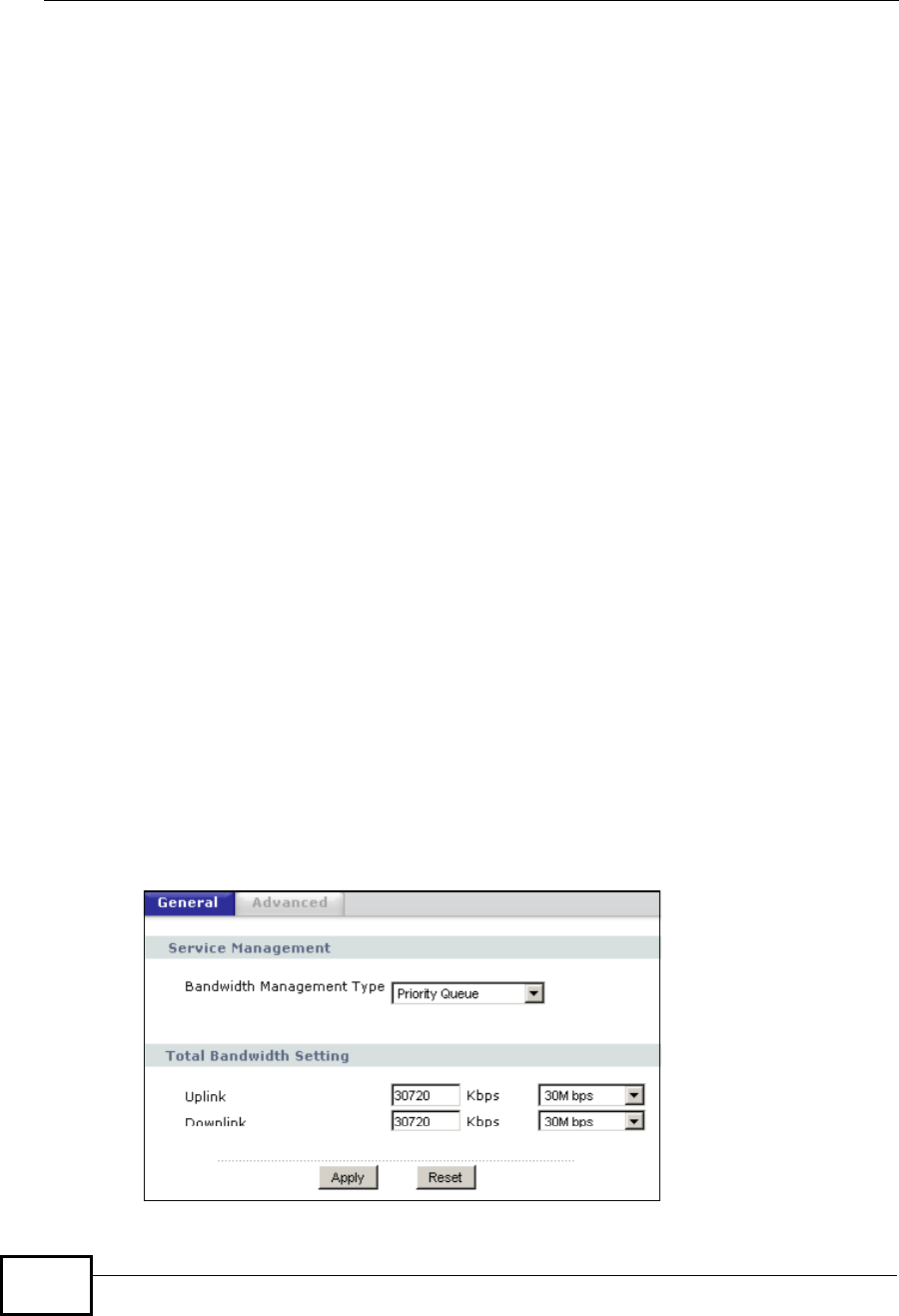
Chapter 16Bandwidth Management
NBG4604 User’s Guide
148
16.3 What You Need To Know
You can limit an application’s uplink or downlink bandwidth. This limit keeps the
traffic from using up too much of the out-going interface’s bandwidth. This way
you can make sure there is bandwidth for other applications. Use the following
guidelines:
•The sum of the bandwidth allotments that apply to the WAN interface (LAN to
WAN, WLAN to WAN) must be less than or equal to the Uplink value that you
configure in the Bandwidth ManagementGeneral screen.
•The sum of the bandwidth allotments that apply to the LAN port (WAN to LAN,
WAN to WLAN) must be less than or equal to the Downlink value that you
configure in the Bandwidth ManagementGeneral screen.
16.4 General Configuration
Use this screen to enable bandwidth management and assign uplink/downlink
limits. You can use either one of the following types:
•Priority Queue. Enable bandwidth management to give uplink traffic that
matches a bandwidth rule priority over traffic that does not match a bandwidth
rule. (This type does not apply to downlink traffic.)
•Bandwidth Allocation. Enabling bandwidth management also allows you to
control the maximum or minimum amounts of bandwidth that can be used by
traffic that matches a bandwidth rule.
Note: You cannot apply both bandwidth management types at the same time.
Click Management> Bandwidth MGMT to open the bandwidth management
General screen.
Figure 82 Management > Bandwidth MGMT > General
Company Confidential
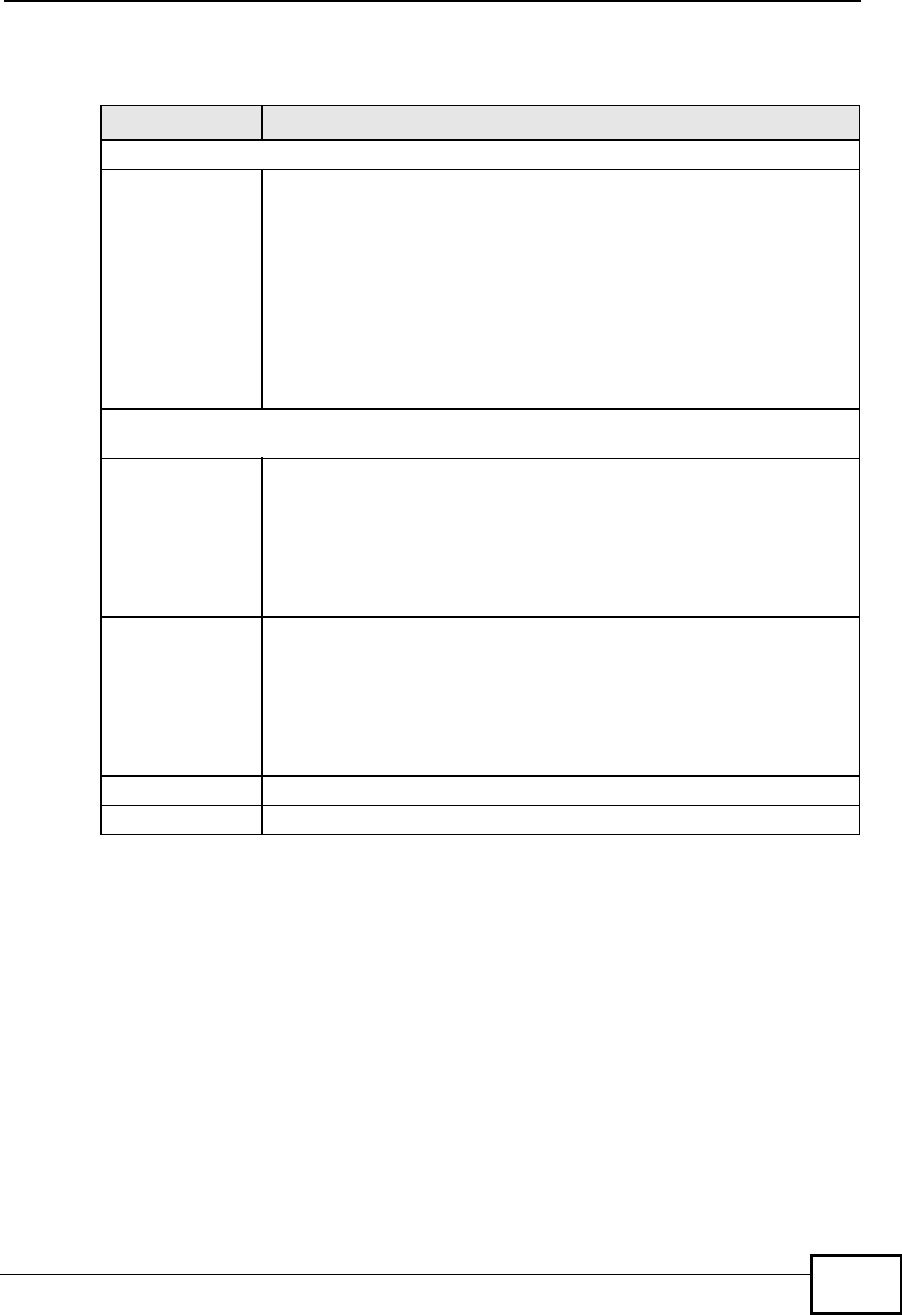
Chapter 16Bandwidth Management
NBG4604 User’s Guide 149
The following table describes the labels in this screen.
16.5 Advanced Configuration
Use this screen to configure bandwidth managements rule for the pre-defined
services or applications.
Use this screen to configure bandwidth managements rule for specific protocols on
an IP or IP range.
Note: This screen contains the Priority Queue and Bandwidth Allocation tables.
Though both tables are described in this section, you can only apply the rules in
one table. Fill out the table of the Bandwidth Management Type you selected
in Section 16.4 on page 148.
Table 55 Management > Bandwidth MGMT > General
LABEL DESCRIPTION
Service Management
Bandwidth
Management
Type
This field allows you to have NBG4604 apply bandwidth management.
Select Priority Queue or Bandwidth Allocation to enable
bandwidth management.
•Select Priority Queue to allocate bandwidth based on the pre-
defined priority assigned to an application. Refer to Section 16.5 on
page 149.
•Select Bandwidth Allocation allocate specific amounts of
bandwidth to specific protocols on an IP or IP range. Refer to
Section 16.5 on page 149.
Select Disable if you do not want to use this feature.
Total Bandwidth Setting. The fields below appear when you enable Bandwidth
Management.
Uplink Type or select the total amount of bandwidth (from 64 Kbps to 30
Mbps) that you want to dedicate to uplink traffic.
If you type the amount of bandwidth, the selection automatically
becomes User Defined. If you select the amount of bandwidth, the
field automatically displays the value in Kbps.
This is traffic from LAN/WLAN to WAN.
Downlink Type or select the total amount of bandwidth (from 64 Kbps to 30
Mbps) that you want to dedicate to downlink traffic.
If you type the amount of bandwidth, the selection automatically
becomes User Defined. If you select the amount of bandwidth, the
field automatically displays the value in Kbps.
This is traffic from WAN to LAN/WLAN.
Apply Click Apply to save your customized settings.
Reset Click Reset to begin configuring this screen afresh.
Company Confidential
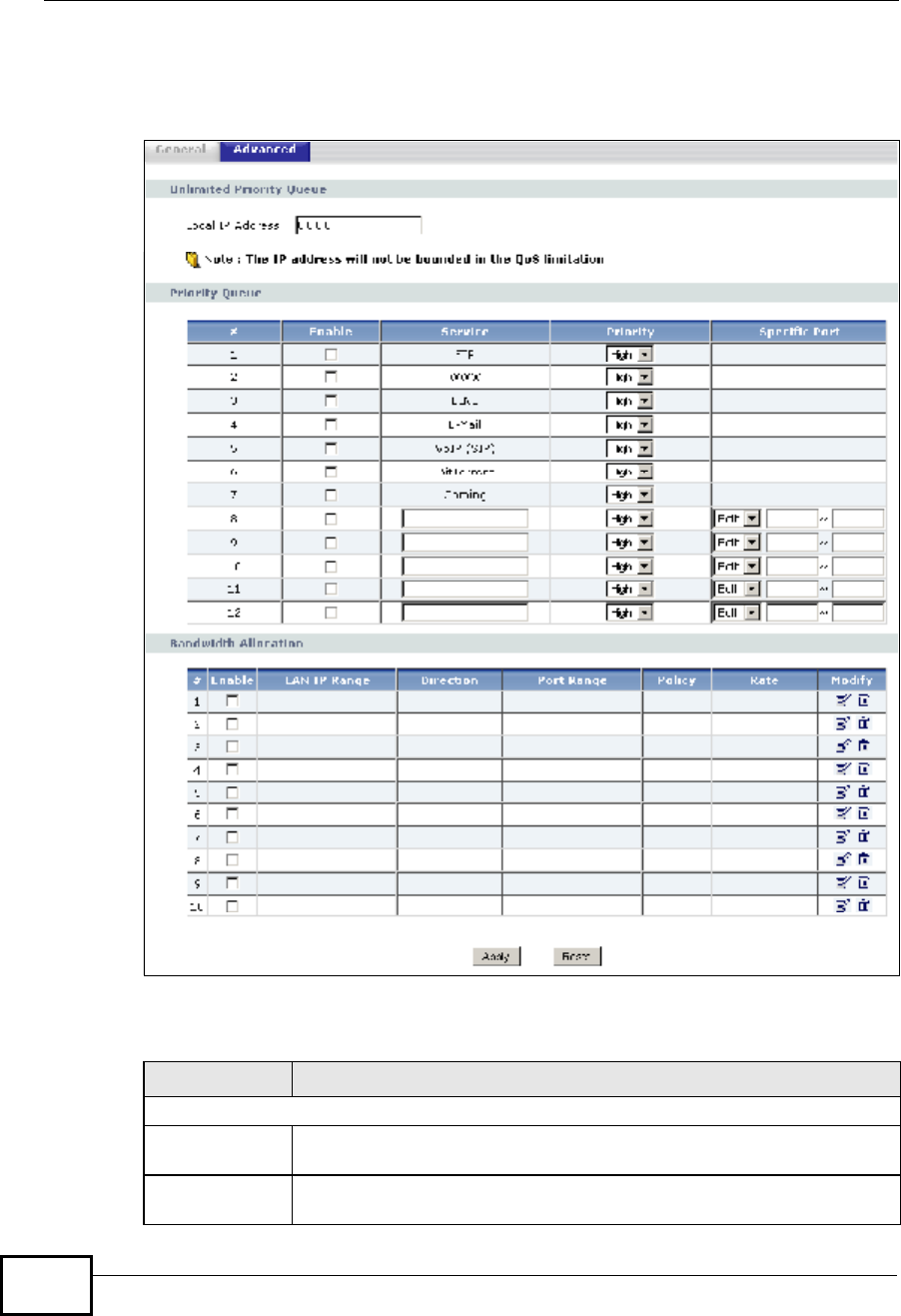
Chapter 16Bandwidth Management
NBG4604 User’s Guide
150
Click Management > Bandwidth MGMT > Advanced to open the bandwidth
management Advanced screen.
Figure 83 Management > Bandwidth MGMT > Advanced
The following table describes the labels in this screen.
Table 56 Management > Bandwidth MGMT > Advanced
LABEL DESCRIPTION
Priority Queue
Local IP
Address Enter the IP address of the computer to which bandwidth management
does not apply.
Priority Queue Use this table to allocate specific amounts of bandwidth based on the
pre-defined service.
Company Confidential
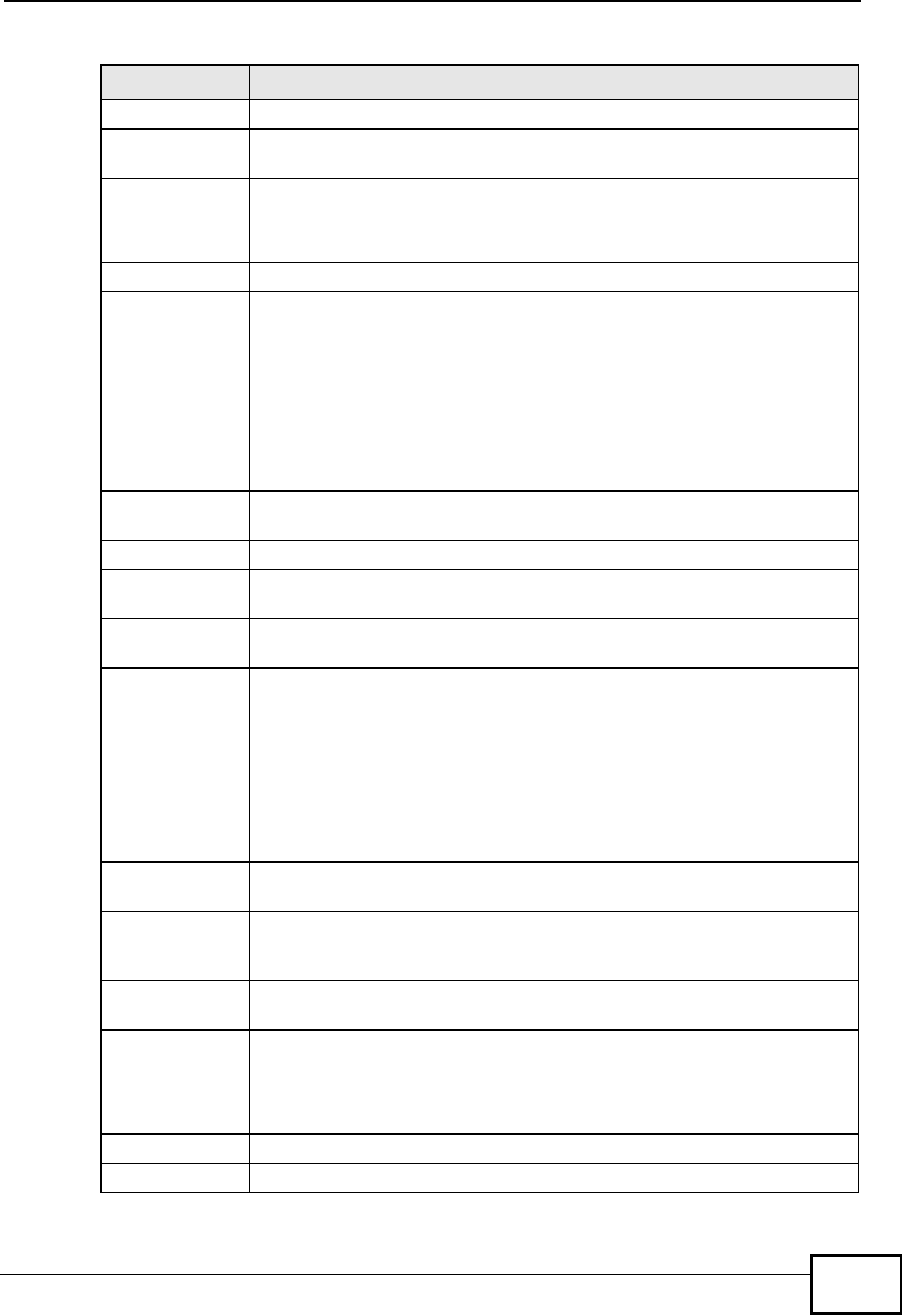
Chapter 16Bandwidth Management
NBG4604 User’s Guide 151
#This is the number of an individual bandwidth management rule.
Enable Select this check box to have the NBG4604 apply this bandwidth
management rule.
Service This is the name of the service.
You can also enter the name (up to 10 keyboard characters) of a service
you want to add in the priority queue (for example, Messenger).
Priority Select a priority from the drop down list box. Choose High or Low.
Specific Port This displays the port/s assigned to the service.
You can also specify the port/s to services to which you want to allocate
bandwidth. Choose either Both,TCP or UDP in the drop-down menu
and enter the port or range of ports in the provided boxes.
Note: If you are entering a specific port and not a range of ports,
you can either leave the second port field blank or enter the
same port number again.
Bandwidth
Allocation Use this table to allocate specific amounts of bandwidth to specific
protocols on an IP or IP range.
#This is the number of an individual bandwidth management rule.
Enable Select this check box to have the NBG4604 apply this bandwidth
management rule.
LAN IP Range This displays the range of IP addresses for which the bandwidth
management rule applies.
Direction These read-only labels represent uplink or downlink traffic.
To LAN applies bandwidth management to traffic from WAN to LAN/
WLAN (i.e., downlink).
To WAN applies bandwidth management to traffic from LAN/WLAN to
WAN (i.e., uplink).
Both applies bandwidth management to traffic that the NBG4604
forwards to both the LAN and the WAN.
Port Range This displays the range of ports for which the bandwidth management
rule applies.
Policy This displays either Max (maximum) or Min (minimum) and refers to
the maximum or minimum bandwidth allowed for the rule in kilobits per
second in the field below.
Rate This is the maximum or minimum bandwidth allowed (refer to the field
above) for the rule in bits per second.
Modify Click the Edit icon to open the Rule Configuration screen. Modify an
existing rule or create a new rule in the Rule Configuration screen.
See Section 16.5.2 on page 152 for more information.
Click the Remove icon to delete a rule.
Apply Click Apply to save your customized settings.
Reset Click Reset to begin configuring this screen afresh.
Table 56 Management > Bandwidth MGMT > Advanced (continued)
LABEL DESCRIPTION
Company Confidential
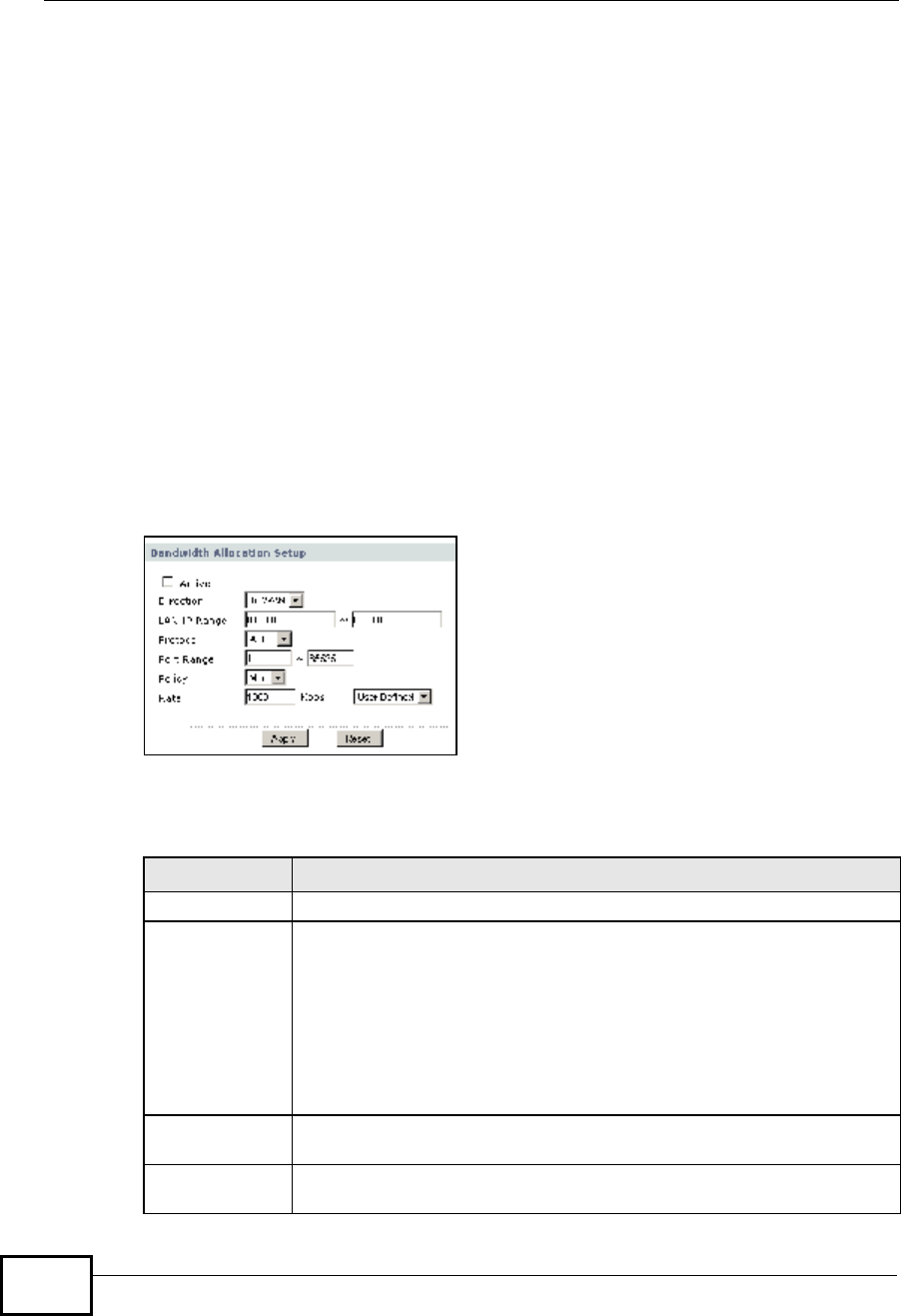
Chapter 16Bandwidth Management
NBG4604 User’s Guide
152
16.5.1 Priority Levels
Traffic with a higher priority gets through faster while traffic with a lower priority is
dropped if the network is congested.
The following describes the priorities that you can apply to traffic that the
NBG4604 forwards out through an interface.
•High - Typically used for voice traffic or video that is especially sensitive to jitter
(jitter is the variations in delay).
•Low - This is typically used for all other traffic that are not time-sensitive.
16.5.2 User Defined Service Rule Configuration
If you want to edit a bandwidth management rule for specific protocols on an IP or
IP range, click the Edit icon in the Bandwidth Allocation table of the Advanced
screen. The following screen displays.
Figure 84 Management > Bandwidth MGMT > Advanced: Allocation Setup
The following table describes the labels in this screen.
Table 57 Management > Bandwidth MGMT > Advanced: Allocation Setup
LABEL DESCRIPTION
Active Select this check box to turn on this bandwidth management rule.
Direction Enter whether you want to apply the rule to uplink or downlink traffic.
To LAN applies bandwidth management to traffic from WAN to LAN/
WLAN (i.e., downlink).
To WAN applies bandwidth management to traffic from LAN/WLAN to
WAN (i.e., uplink).
Select Both applies bandwidth management to traffic that the
NBG4604 forwards to both the LAN and the WAN.
LAN IP Range Specify the range of IP addresses for which the bandwidth management
rule applies.
Protocol Select the protocol (TCP,UDP, SMTP, HTTP, POP3, FTP or ALL) for
which the bandwidth management rule applies.
Company Confidential
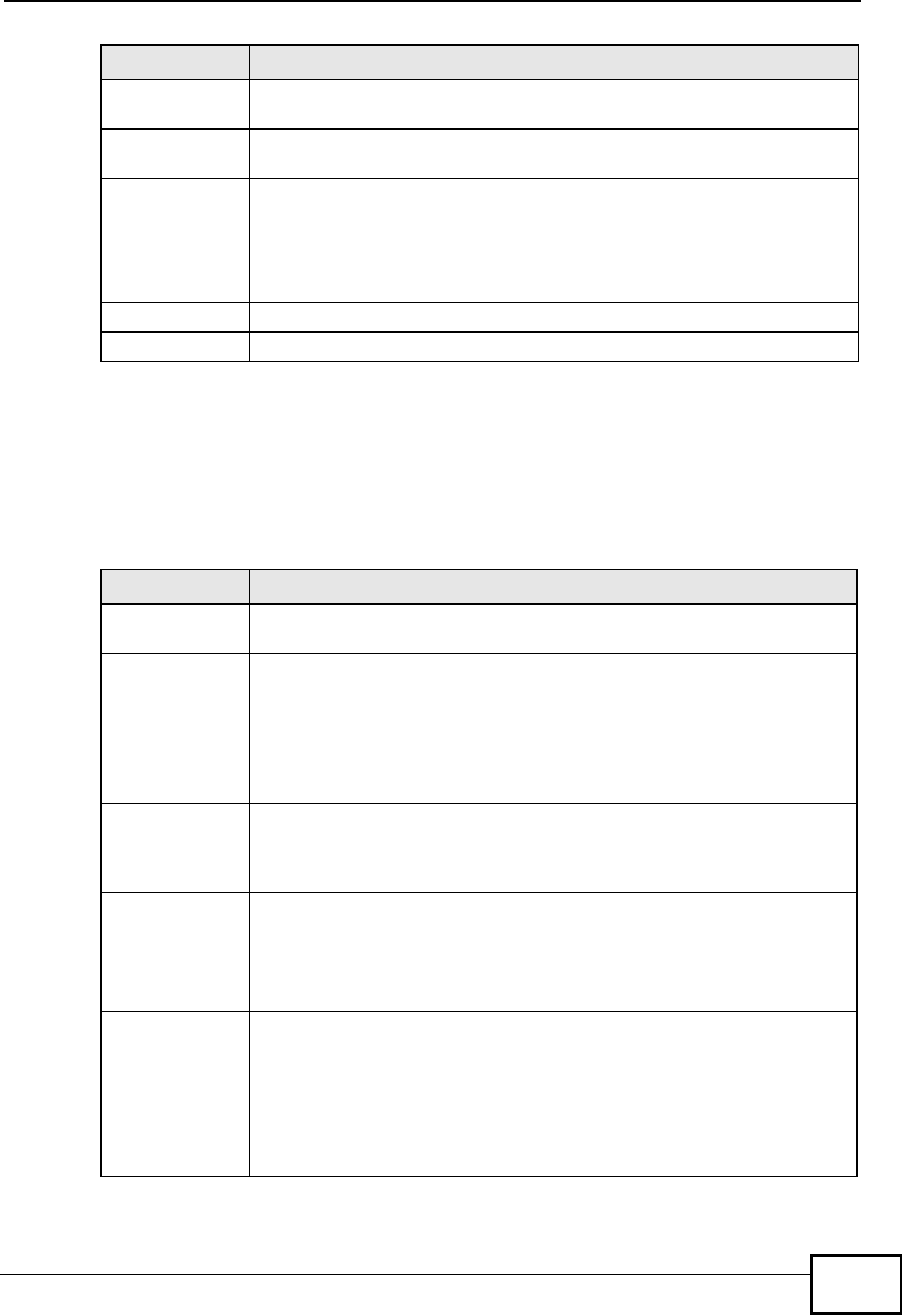
Chapter 16Bandwidth Management
NBG4604 User’s Guide 153
16.5.3 Predefined Bandwidth Management Services
The following is a description of the services that you can select and to which you
can apply media bandwidth management in the Management > Bandwidth
MGMT > Advanced screen.
Port Range Enter the range of ports for which the bandwidth management rule
applies.
Policy Select Max or Min and specify the maximum or minimum bandwidth
allowed for the rule in bits per second in the field below.
Rate (bps) Type or select the maximum or minimum bandwidth allowed (refer to
the field above) for the rule in bits per second.
If you type the amount of bandwidth, the selection automatically
becomes User Defined. If you select the amount of bandwidth, the
field automatically displays the value in Kbps.
Apply Click Apply to save your customized settings.
Reset Click Reset to begin configuring this screen afresh.
LABEL DESCRIPTION
Table 58 Media Bandwidth Management Setup: Services
SERVICE DESCRIPTION
FTPFile Transfer Program enables fast transfer of files, including large files
that may not be possible by e-mail. FTP uses port number 21.
WWWThe World Wide Web (WWW) is an Internet system to distribute
graphical, hyper-linked information, based on Hyper Text Transfer
Protocol (HTTP) - a client/server protocol for the World Wide Web. The
Web is not synonymous with the Internet; rather, it is just one service
on the Internet. Other services on the Internet include Internet Relay
Chat and Newsgroups. The Web is accessed through use of a browser.
WWW uses port 80.
TelnetTelnet is the login and terminal emulation protocol common on the
Internet and in UNIX environments. It operates over TCP/IP networks.
Its primary function is to allow users to log into remote host systems.
Telnet uses port 23.
E-MailElectronic mail consists of messages sent through a computer network
to specific groups or individuals. Here are some default ports for e-mail:
POP3 - port 110
SMTP - port 25
VoIP (SIP)Sending voice signals over the Internet is called Voice over IP or VoIP.
Session Initiated Protocol (SIP) is an internationally recognized
standard for implementing VoIP. SIP is an application-layer control
(signaling) protocol that handles the setting up, altering and tearing
down of voice and multimedia sessions over the Internet.
SIP is transported primarily over UDP but can also be transported over
TCP, using the default port number 5060.
Company Confidential
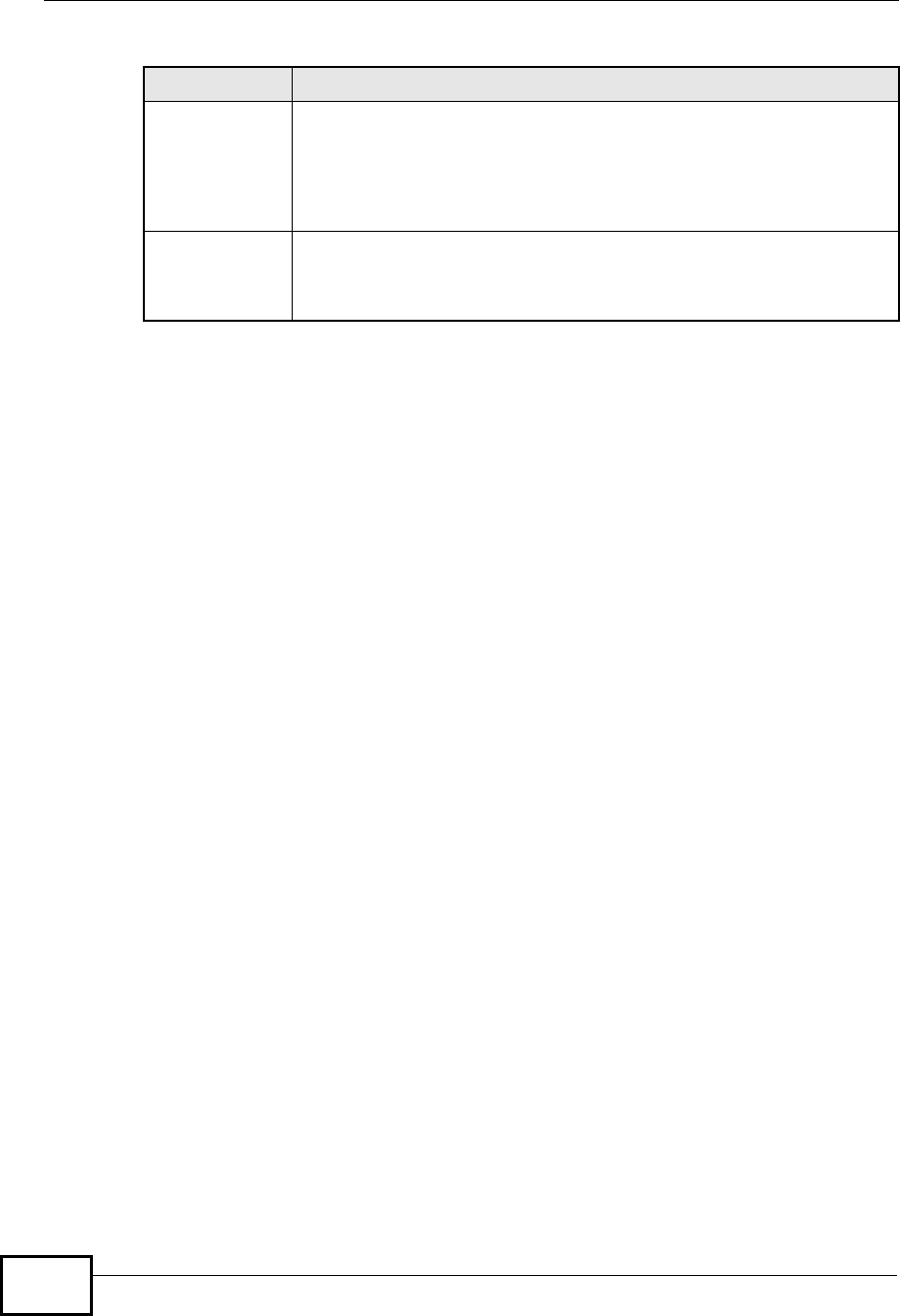
Chapter 16Bandwidth Management
NBG4604 User’s Guide
154
16.5.4 Services and Port Numbers
See Appendix E on page 259 for commonly used services and port numbers.
BitTorrentBitTorrent is a free P2P (peer-to-peer) sharing tool allowing you to
distribute large software and media files using ports 6881 to 6889.
BitTorrent requires you to search for a file with a searching engine
yourself. It distributes files by corporation and trading, that is, the client
downloads the file in small pieces and share the pieces with other peers
to get other half of the file.
GamingOnline gaming services lets you play multiplayer games on the Internet
via broadband technology. One example is Microsoft’s Xbox Live, which
uses port 3074. As of this writing, your NBG4604 supports Xbox,
Playstation, Battlenet and MSN Game Zone.
Table 58 Media Bandwidth Management Setup: Services (continued)
SERVICE DESCRIPTION
Company Confidential

NBG4604 User’s Guide 155
CHAPTER 17
Remote Management
17.1 Overview
This chapter provides information on the Remote Management screens.
Remote management allows you to determine which services/protocols can access
which NBG4604 interface (if any) from which computers.
You may manage your NBG4604 from a remote location via:
Note: When you configure remote management to allow management from the LAN
and WAN in the options above, you still need to configure a firewall rule to allow
access. See the firewall chapters for details on configuring firewall rules.
17.2 What You Can Do
Use the WWW screen (Section 17.4 on page 157) to change your NBG4604’s
World Wide Web settings.
17.3 What You Need To Know
To disable remote management of a service, select Disable in the corresponding
Server Access field. You may only have one remote management session
running at a time.
•LAN only •LAN and WAN
Company Confidential

Chapter 17Remote Management
NBG4604 User’s Guide
156
17.3.1 Remote Management Limitations
Remote management over LAN or WAN will not work when:
1You have disabled that service in one of the remote management screens.
2The IP address in the Secured Client IP Address field does not match the client
IP address. If it does not match, the NBG4604 will disconnect the session
immediately.
3There is already another remote management session with an equal or higher
priority running. You may only have one remote management session running at
one time.
4There is a firewall rule that blocks it.
17.3.2 Remote Management and NAT
When NAT is enabled:
•Use the NBG4604’s WAN IP address when configuring from the WAN.
•Use the NBG4604’s LAN IP address when configuring from the LAN.
17.3.3 System Timeout
There is a default system management idle timeout of five minutes (three
hundred seconds). The NBG4604 automatically logs you out if the management
session remains idle for longer than this timeout period. The management session
does not time out when a statistics screen is polling. You can change the timeout
period in the System screen
Company Confidential
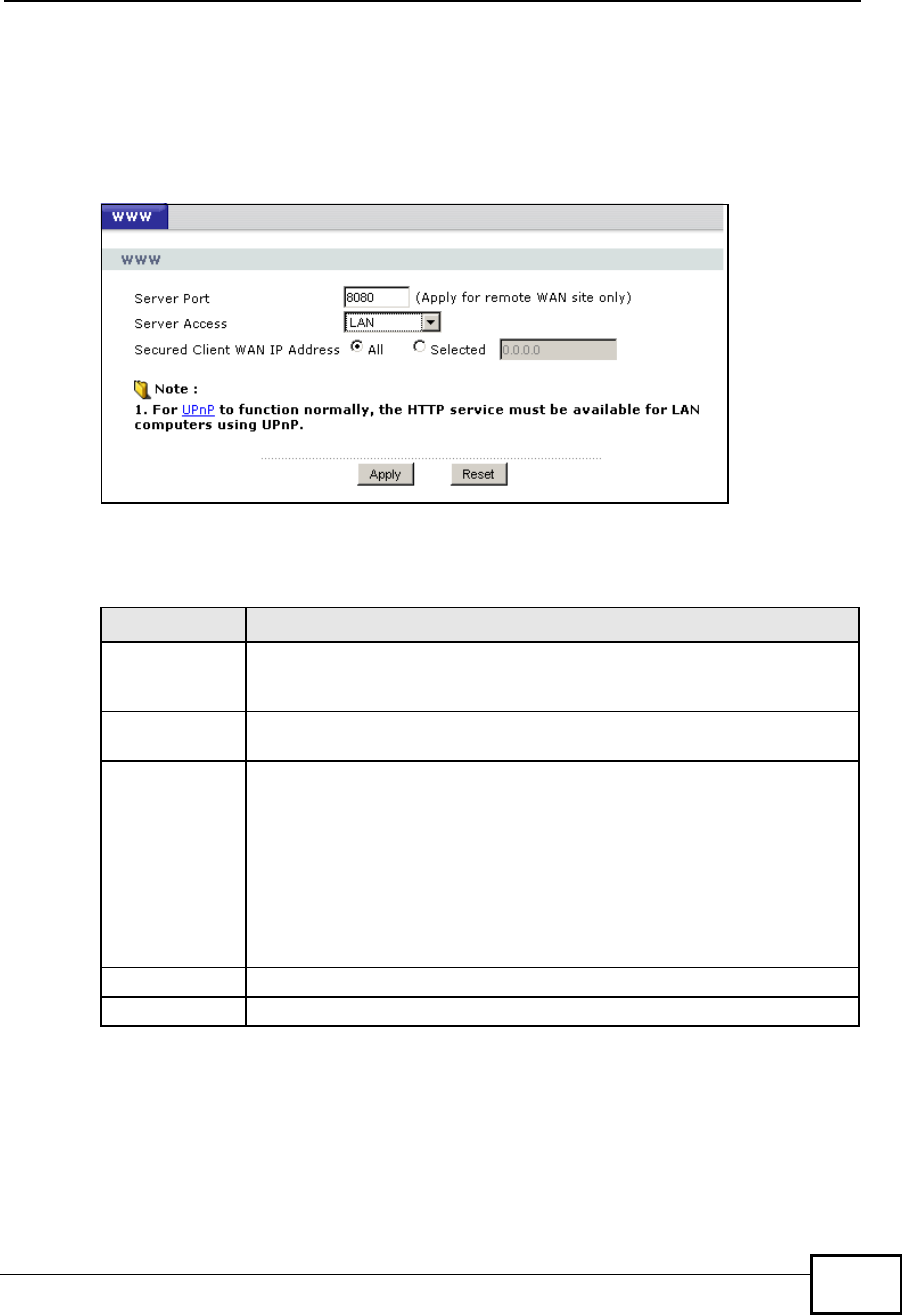
Chapter 17Remote Management
NBG4604 User’s Guide 157
17.4 WWW Screen
To change your NBG4604’s World Wide Web settings, click Management >
Remote MGMT to display the WWW screen.
Figure 85 Management > Remote MGMT > WWW
The following table describes the labels in this screen
Table 59 Management > Remote MGMT > WWW
LABEL DESCRIPTION
Server Port You may change the server port number for a service if needed,
however you must use the same port number in order to use that
service for remote management.
Server Access Select the interface(s) through which a computer may access the
NBG4604 using this service.
Secured Client
IP Address A secured client is a “trusted” computer that is allowed to communicate
with the NBG4604 using this service.
Select All to allow any computer to access the NBG4604 using this
service.
Choose Selected to just allow the computer with the IP address that
you specify to access the NBG4604 using this service.
Note: This only applies on WAN IP.
Apply Click Apply to save your customized settings and exit this screen.
Reset Click Reset to begin configuring this screen afresh.
Company Confidential

Chapter 17Remote Management
NBG4604 User’s Guide
158
Company Confidential

NBG4604 User’s Guide 159
CHAPTER 18
Universal Plug-and-Play (UPnP)
18.1 Overview
This chapter introduces the UPnP feature in the Web Configurator.
Universal Plug and Play (UPnP) is a distributed, open networking standard that
uses TCP/IP for simple peer-to-peer network connectivity between devices. A
UPnP device can dynamically join a network, obtain an IP address, convey its
capabilities and learn about other devices on the network. In turn, a device can
leave a network smoothly and automatically when it is no longer in use.
18.2 What You Can Do
Use the UPnP screen (Section 18.4 on page 160) to enable UPnP on the
NBG4604.
18.3 What You Need to Know
How do I know if I'm using UPnP?
UPnP hardware is identified as an icon in the Network Connections folder
(Windows XP). Each UPnP compatible device installed on your network will appear
as a separate icon. Selecting the icon of a UPnP device will allow you to access the
information and properties of that device.
NAT Traversal
UPnP NAT traversal automates the process of allowing an application to operate
through NAT. UPnP network devices can automatically configure network
addressing, announce their presence in the network to other UPnP devices and
enable exchange of simple product and service descriptions. NAT traversal allows
the following:
Company Confidential
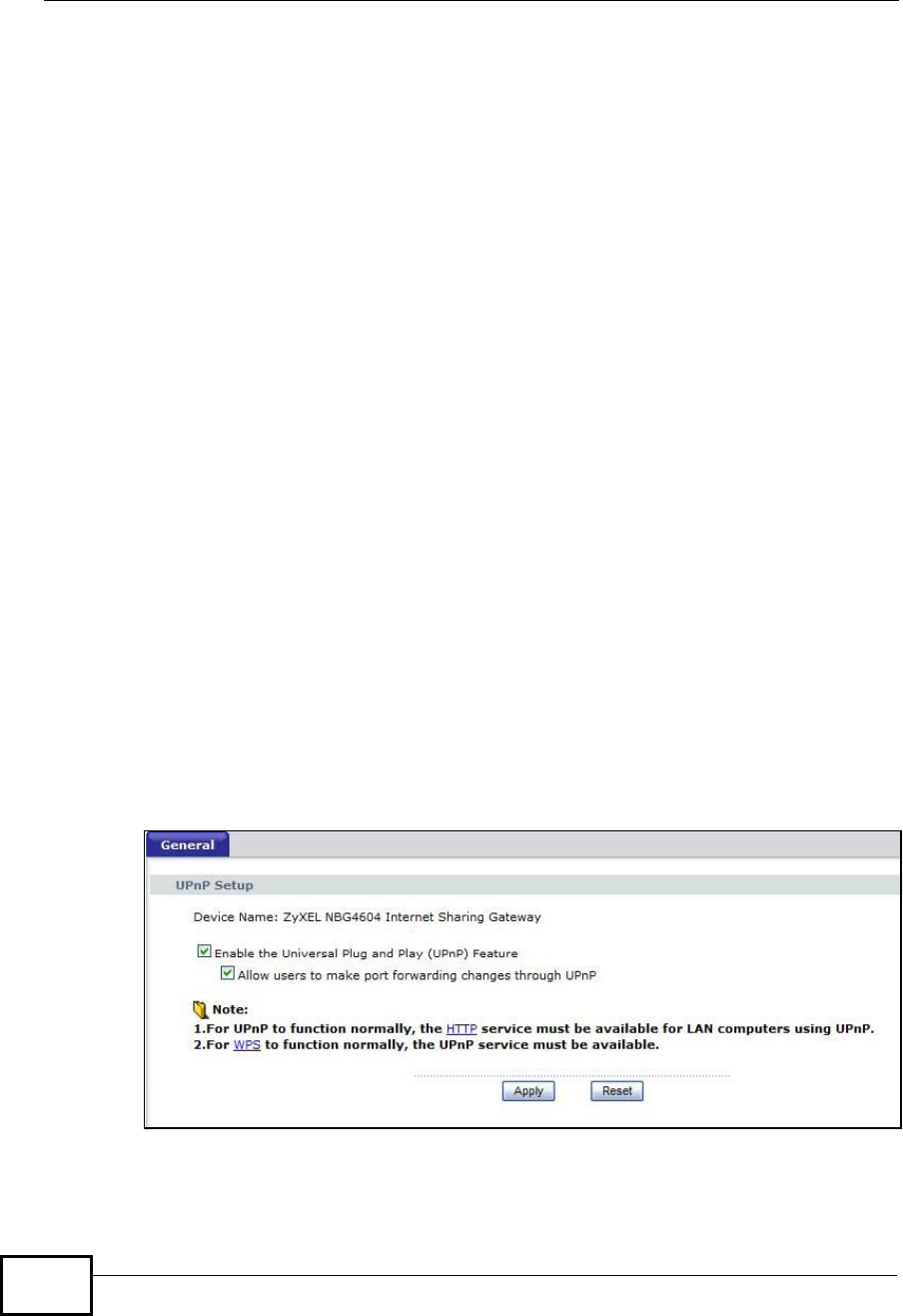
Chapter 18Universal Plug-and-Play (UPnP)
NBG4604 User’s Guide
160
•Dynamic port mapping
•Learning public IP addresses
•Assigning lease times to mappings
Windows Messenger is an example of an application that supports NAT traversal
and UPnP.
See the NAT chapter for more information on NAT.
Cautions with UPnP
The automated nature of NAT traversal applications in establishing their own
services and opening firewall ports may present network security issues. Network
information and configuration may also be obtained and modified by users in some
network environments.
When a UPnP device joins a network, it announces its presence with a multicast
message. For security reasons, the NBG4604 allows multicast messages on the
LAN only.
All UPnP-enabled devices may communicate freely with each other without
additional configuration. Disable UPnP if this is not your intention.
18.4 UPnP Screen
Use this screen to enable UPnP. Click the Management > UPnP to open the
following screen.
Figure 86 Management > UPnP > General
Company Confidential
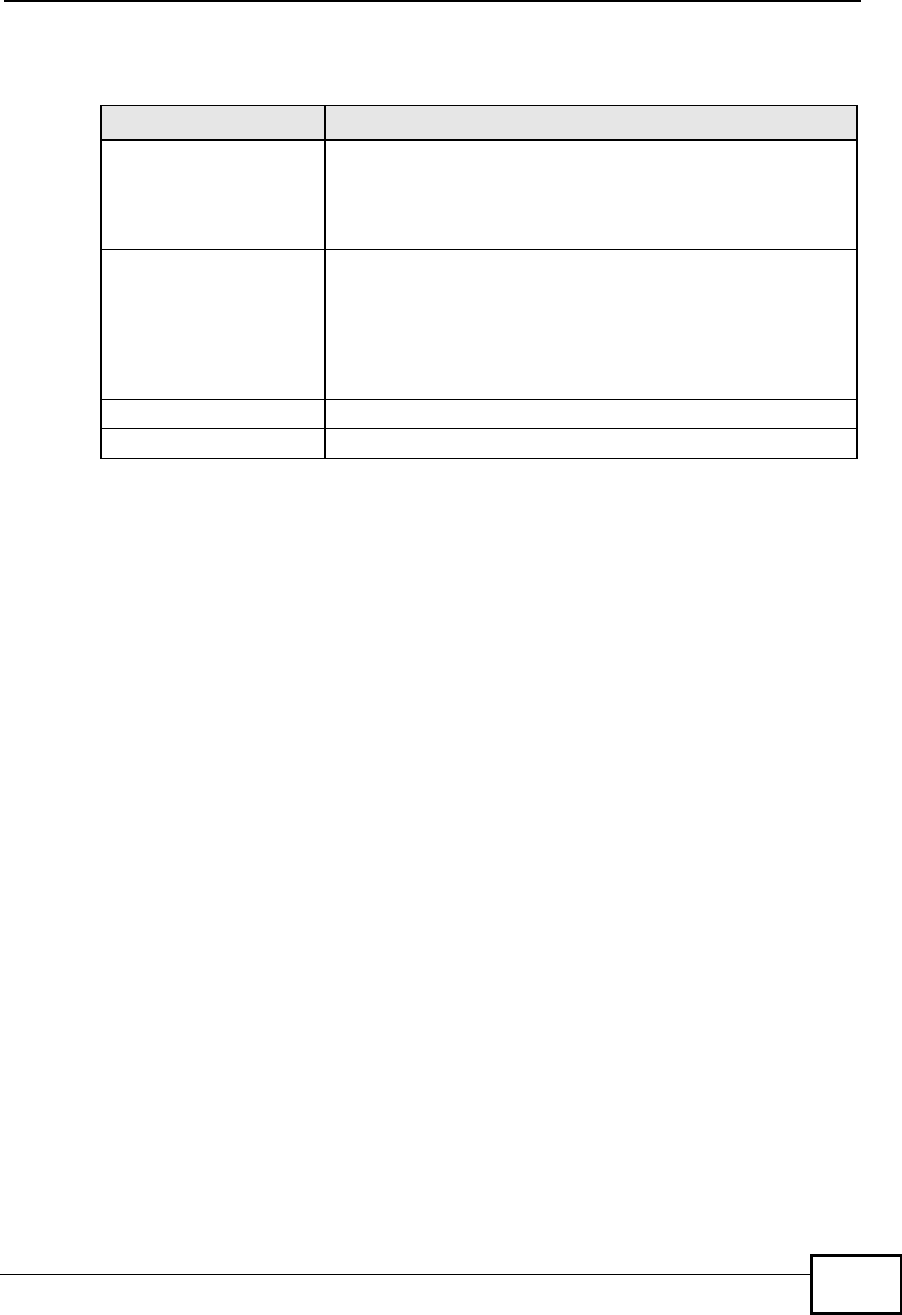
Chapter 18Universal Plug-and-Play (UPnP)
NBG4604 User’s Guide 161
The following table describes the labels in this screen.
18.5 Technical Reference
The sections show examples of using UPnP.
18.5.1 Using UPnP in Windows XP Example
This section shows you how to use the UPnP feature in Windows XP. You must
already have UPnP installed in Windows XP and UPnP activated on the NBG4604.
Make sure the computer is connected to a LAN port of the NBG4604. Turn on your
computer and the NBG4604.
18.5.1.1 Auto-discover Your UPnP-enabled Network Device
1Click start and Control Panel. Double-click Network Connections. An icon
displays under Internet Gateway.
Table 60 Management > UPnP > General
LABEL DESCRIPTION
Enable the Universal Plug
and Play (UPnP) Feature Select this check box to activate UPnP. Be aware that anyone
could use a UPnP application to open the Web Configurator's
login screen without entering the NBG4604's IP address
(although you must still enter the password to access the Web
Configurator).
Allow users to make port
forwarding changes
through UPnP
Select this check box to allow UPnP-enabled applications to
automatically configure the NBG4604 so that they can
communicate through the NBG4604, for example by using NAT
traversal, UPnP applications automatically reserve a NAT
forwarding port in order to communicate with another UPnP
enabled device; this eliminates the need to manually configure
port forwarding for the UPnP enabled application.
Apply Click Apply to save the setting to the NBG4604.
Reset Click Reset to begin configuring this screen afresh.
Company Confidential
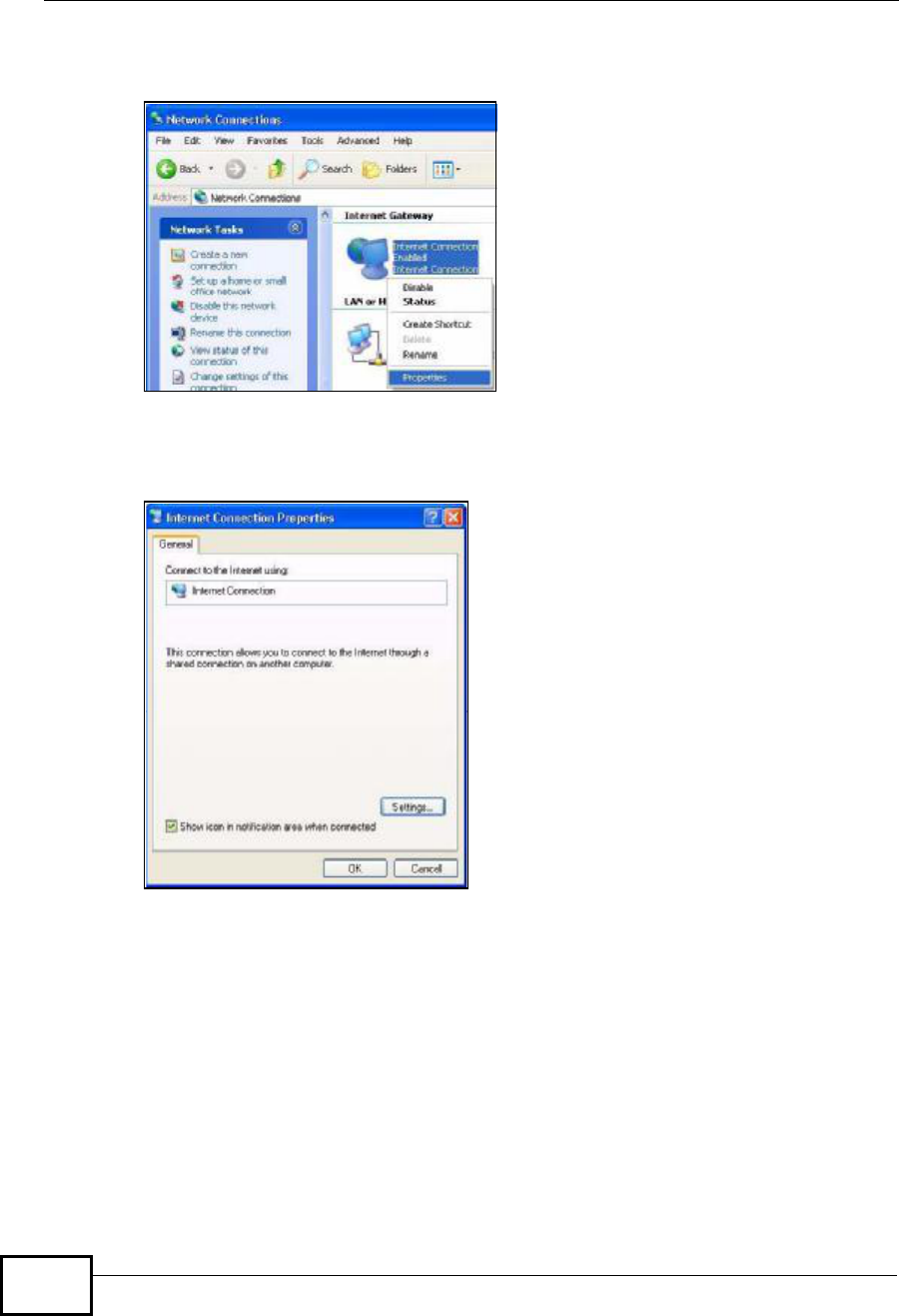
Chapter 18Universal Plug-and-Play (UPnP)
NBG4604 User’s Guide
162
2Right-click the icon and select Properties.
Figure 87 Network Connections
3In the Internet Connection Properties window, click Settings to see the port
mappings there were automatically created.
Figure 88 Internet Connection Properties
Company Confidential
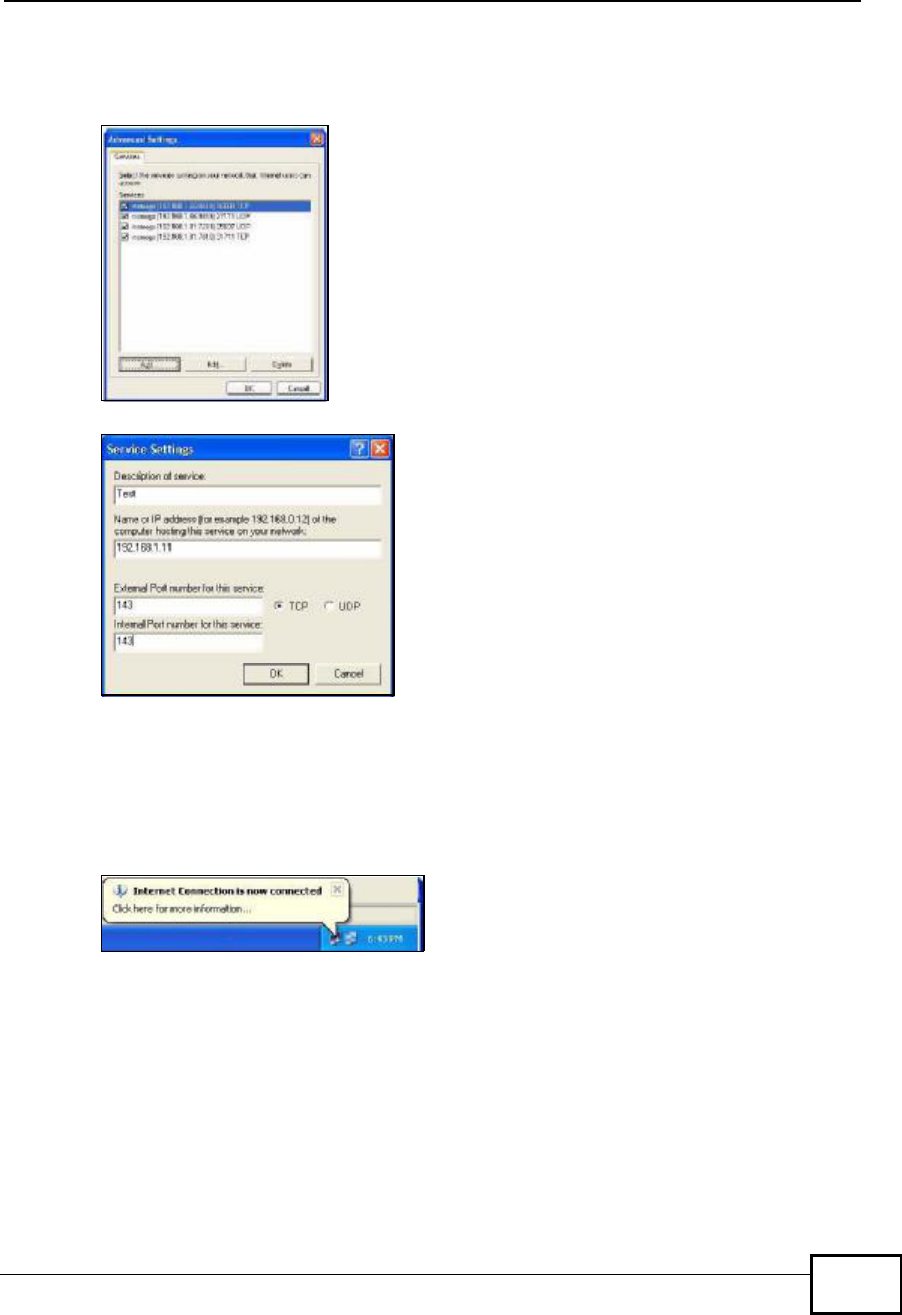
Chapter 18Universal Plug-and-Play (UPnP)
NBG4604 User’s Guide 163
4You may edit or delete the port mappings or click Add to manually add port
mappings.
Figure 89 Internet Connection Properties: Advanced Settings
Figure 90 Internet Connection Properties: Advanced Settings: Add
Note: When the UPnP-enabled device is disconnected from your computer, all port
mappings will be deleted automatically.
5Select Show icon in notification area when connected option and click OK.
An icon displays in the system tray.
Figure 91 System Tray Icon
Company Confidential
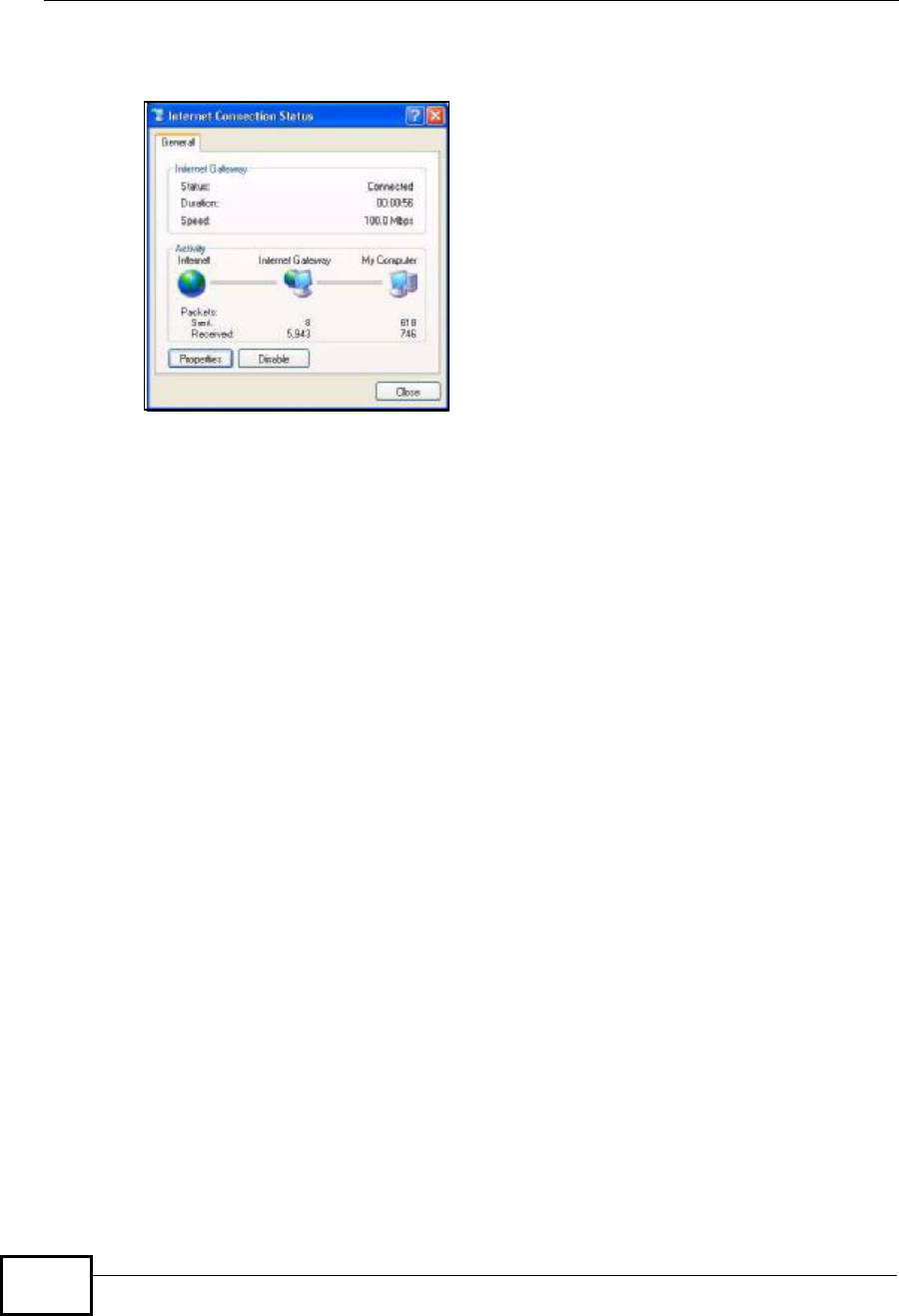
Chapter 18Universal Plug-and-Play (UPnP)
NBG4604 User’s Guide
164
6Double-click on the icon to display your current Internet connection status.
Figure 92 Internet Connection Status
18.5.2 Web Configurator Easy Access
With UPnP, you can access the web-based configurator on the NBG4604 without
finding out the IP address of the NBG4604 first. This comes helpful if you do not
know the IP address of the NBG4604.
Follow the steps below to access the Web Configurator.
1Click Start and then Control Panel.
2Double-click Network Connections.
Company Confidential
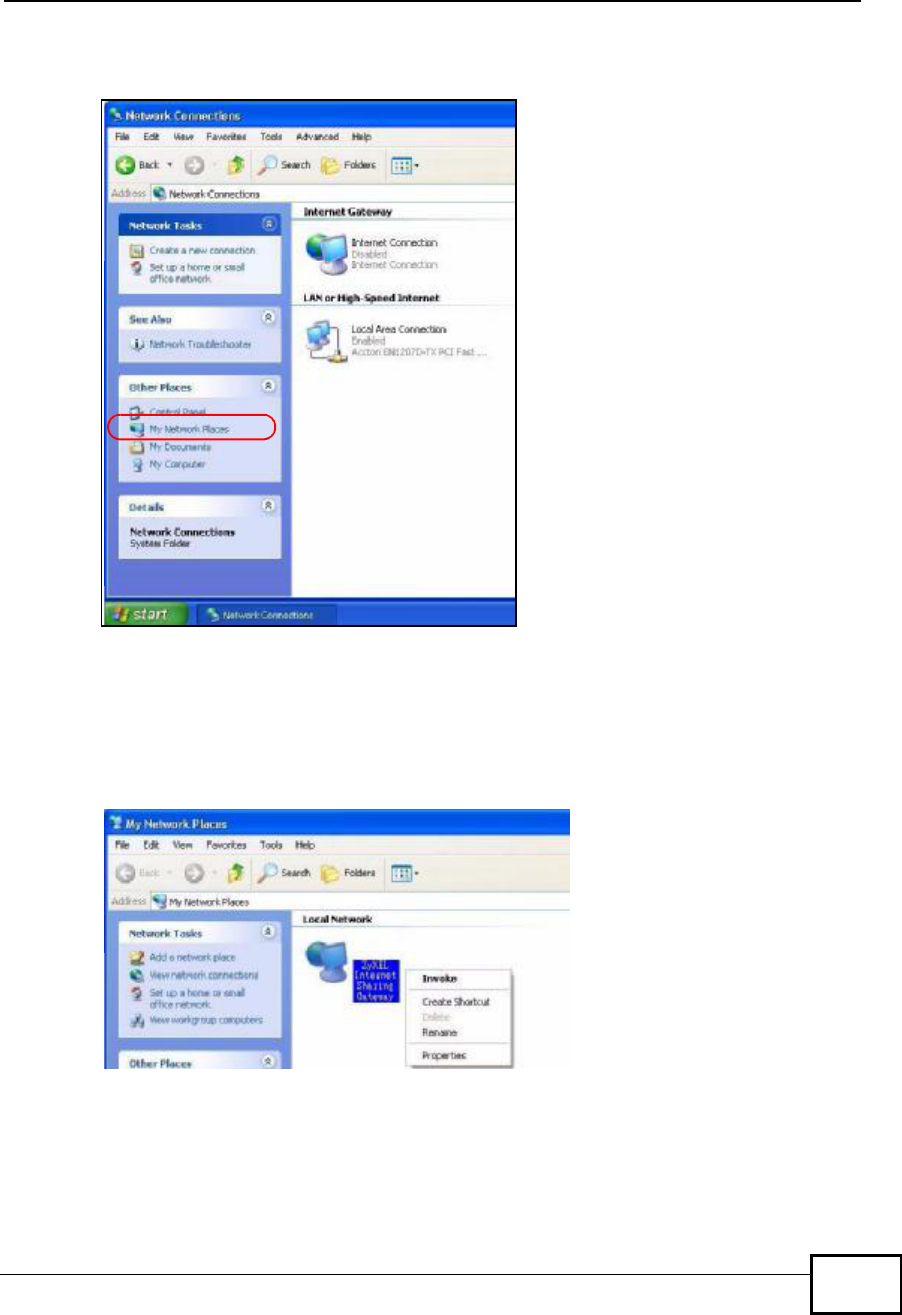
Chapter 18Universal Plug-and-Play (UPnP)
NBG4604 User’s Guide 165
3Select My Network Places under Other Places.
Figure 93 Network Connections
4An icon with the description for each UPnP-enabled device displays under Local
Network.
5Right-click on the icon for your NBG4604 and select Invoke. The Web
Configurator login screen displays.
Figure 94 Network Connections: My Network Places
Company Confidential
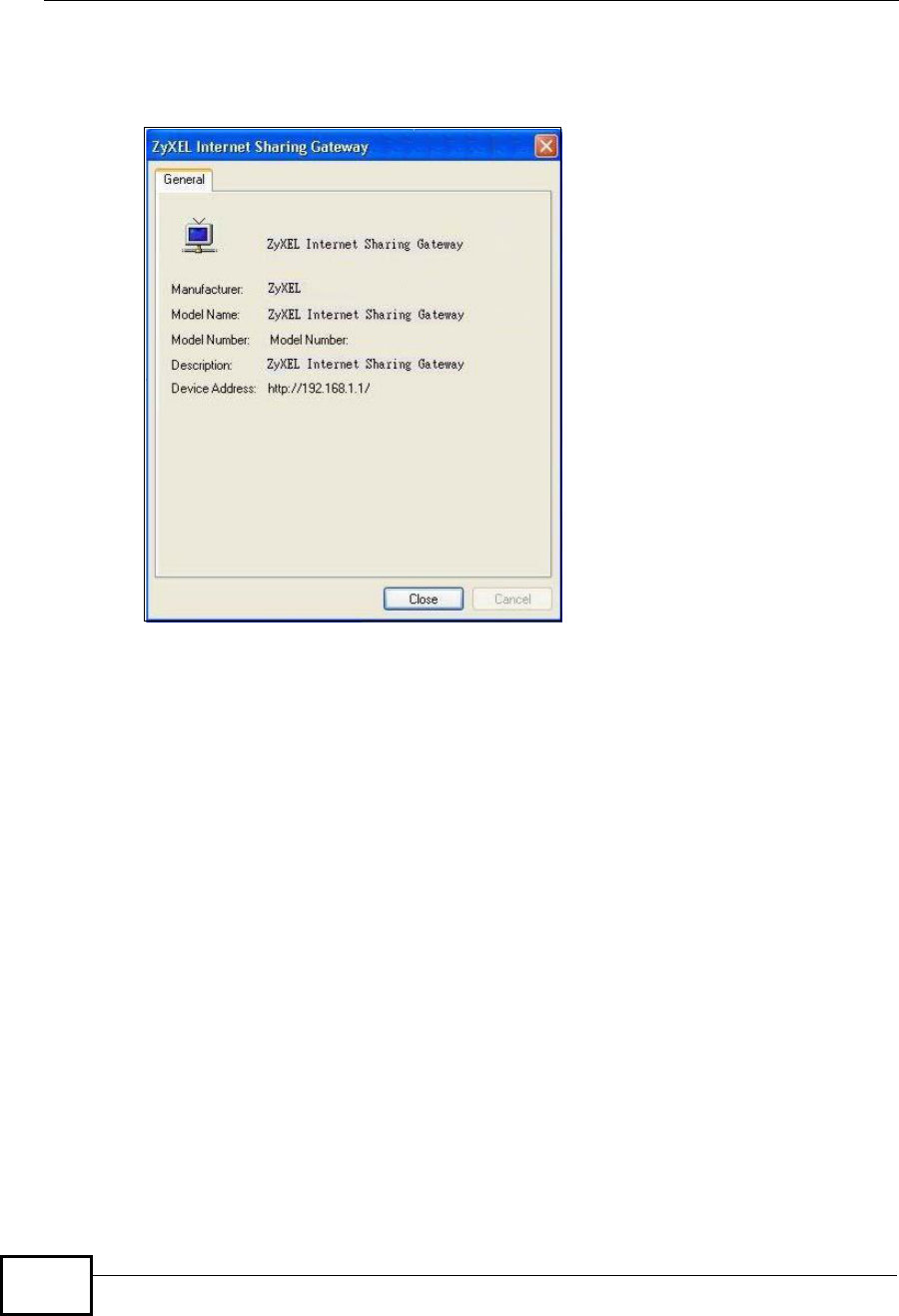
Chapter 18Universal Plug-and-Play (UPnP)
NBG4604 User’s Guide
166
6Right-click on the icon for your NBG4604 and select Properties. A properties
window displays with basic information about the NBG4604.
Figure 95 Network Connections: My Network Places: Properties: Example
Company Confidential
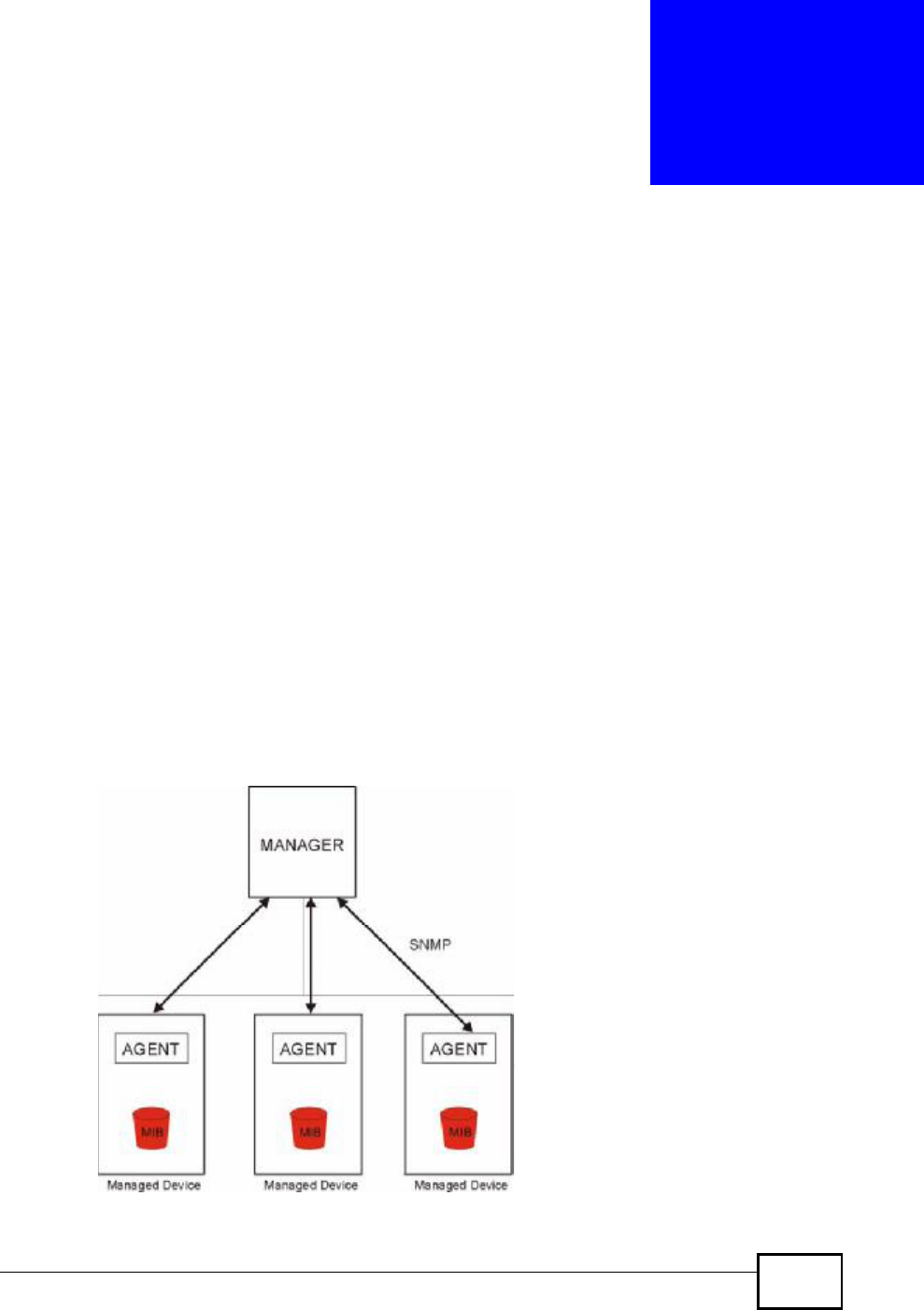
NBG4604 User’s Guide 167
CHAPTER 19
SNMP
19.1 Overview
Simple Network Management Protocol (SNMP) is a protocol for collecting and
managing information about network devices. Your NBG4604 supports SNMP
agent functionality, which allows a manager station to manage and monitor the
NBG4604 through the network. The NBG4604 supports SNMP version one
(SNMPv1) and version two (SNMPv2c).
Note: Only configure the SNMP feature with settings provided by your ISP.
19.2 What You Need to Know
An SNMP managed network consists of two main types of component: agents and
a manager.
Figure 96 SNMP Management Model
Company Confidential
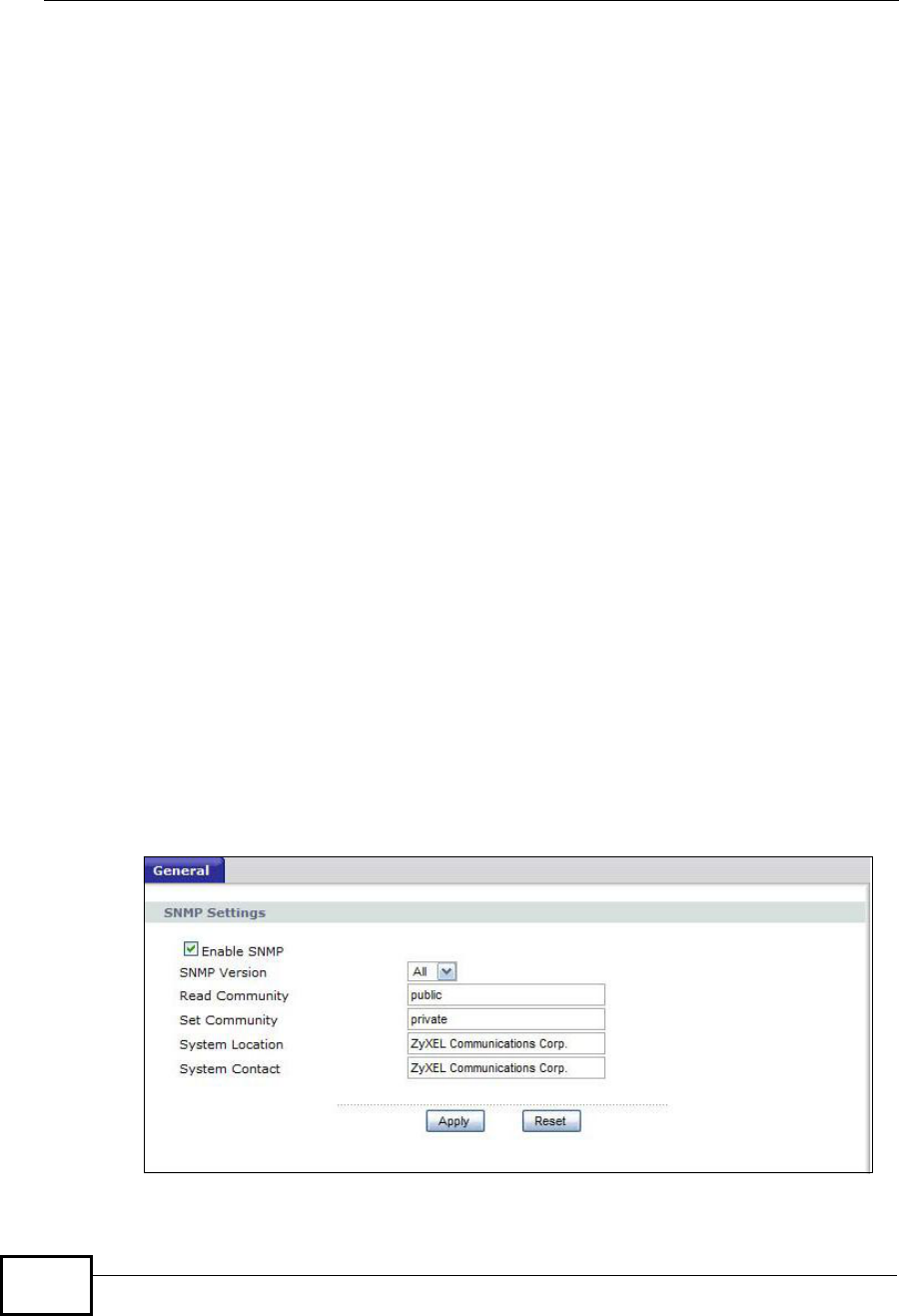
Chapter 19SNMP
NBG4604 User’s Guide
168
An agent is a management software module that resides in a managed device (the
NBG4604). An agent translates the local management information from the
managed device into a form compatible with SNMP. The manager is the console
through which network administrators perform network management functions. It
executes applications that control and monitor managed devices.
The managed devices contain object variables/managed objects that define each
piece of information to be collected about a device. Examples of variables include
such as number of packets received, node port status etc. A Management
Information Base (MIB) is a collection of managed objects. SNMP allows a
manager and agents to communicate for the purpose of accessing these objects.
SNMP itself is a simple request/response protocol based on the manager/agent
model. The manager issues a request and the agent returns responses using the
following protocol operations:
•Get - Allows the manager to retrieve an object variable from the agent.
•GetNext - Allows the manager to retrieve the next object variable from a table
or list within an agent. In SNMPv1, when a manager wants to retrieve all
elements of a table from an agent, it initiates a Get operation, followed by a
series of GetNext operations.
•Set - Allows the manager to set values for object variables within an agent.
•Trap - Used by the agent to inform the manager of some events.
19.3 SNMP Screen
Use this screen to enable SNMP. Click Management > SNMP to open the
following screen.
Figure 97 Management > SNMP > General
Company Confidential

Chapter 19SNMP
NBG4604 User’s Guide 169
The following table describes the labels in this screen.
Table 61 Management > UPnP > General
LABEL DESCRIPTION
Enable SNMP Select this to enable SNMP on this device.
SNMP version Select the SNMP version that corresponds the SNMP used by
the server.
Read Community Enter the SNMP read community information here.
Get Community Enter the SNMP get community information here.
System Location Enter the SNMP system location.
System Contact Enter the SNMP system contact.
Apply Click Apply to save the setting to the NBG4604.
Reset Click Reset to begin configuring this screen afresh.
Company Confidential

Chapter 19SNMP
NBG4604 User’s Guide
170
Company Confidential

NBG4604 User’s Guide 171
CHAPTER 20
ACS
20.1 Overview
This chapter shows you to configure the NBG4604’s ACS settings so that it can be
remotely configured by an Auto-Configuration Server (ACS).
An administrator can use an ACS to remotely set up the NBG4604, modify its
settings, perform firmware upgrades, and monitor and diagnose it. In order to do
so, you must enable the TR-069 feature on your NBG4604 and then configure it
appropriately. (The ACS server which it will use must also be configured by its
administrator.)
20.2 What You Can Do in this Chapter
•Use the General screen (Section 20.4 on page 172) to configure set up the ACS
server information on your NBG4604.
•Use the Certificate screen (Section 20.5 on page 175) to upload encrypted
security certificates to your NBG4604.
20.3 What You Need to Know
The following terms and concepts may help as you read this chapter.
ACS
An Auto-Configuration Server (ACS) centralizes the management and
configuration of a variety of networking devices such as routers, set-top boxes,
Voice over IP (VoIP) gateways, and other Customer Premises Equipment (CPE). It
is based on the TR-069 standard.
Company Confidential

Chapter 20ACS
NBG4604 User’s Guide
172
OUI Filter
An Organizationally Unique Identifier (OUI) filter blocks or forwards packets from
devices with the specified OUI in the MAC address. The OUI field is the first three
octets in a MAC address and uniquely identifies the manufacturer of a network
device.
STUN
STUN allows a device to find the public IP address assigned by a NAT router and/
or a firewall between it and the public Internet.
20.4 General Screen
The General screen allows you to set up the ACS server information on your
NBG4604 so it can be remotely updated. Only use information provided by your
network administrator.
20.4.1 STUN
STUN (Simple Traversal of User Datagram Protocol (UDP) through Network
Address Translators) allows the NBG4604 to find the presence and types of NAT
routers and/or firewalls between it and the public Internet. STUN also allows the
NBG4604 to find the public IP address that NAT assigned, so the NBG4604 can
embed it in the SIP data stream. STUN does not work with symmetric NAT routers
or firewalls. See RFC 3489 for details on STUN.
The following figure shows how STUN works.
1The NBG4604 (A) sends SIP packets to the STUN server (B).
2The STUN server (B) finds the public IP address and port number that the NAT
router used on the NBG4604’s SIP packets and sends them to the NBG4604.
Company Confidential
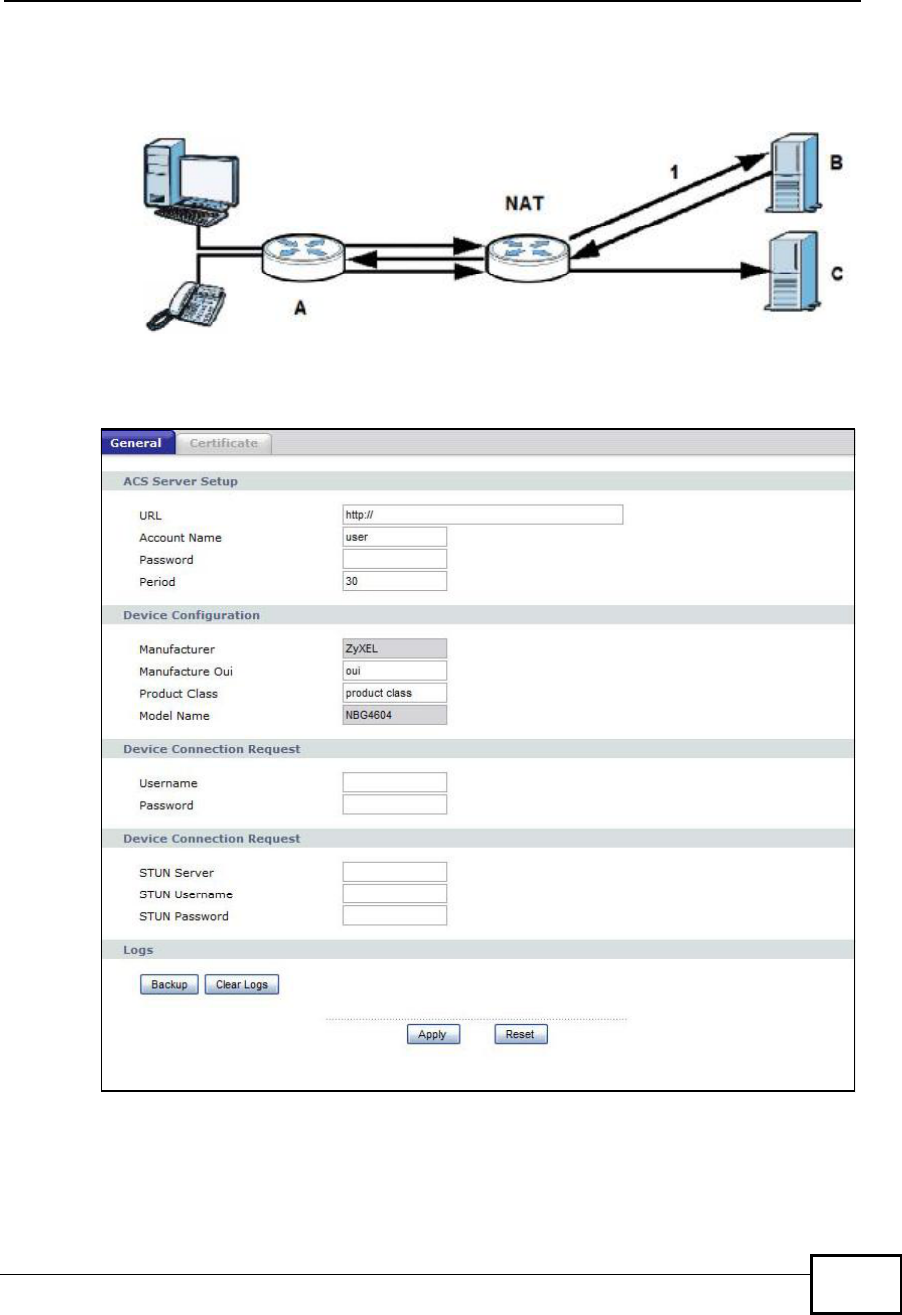
Chapter 20ACS
NBG4604 User’s Guide 173
3The NBG4604 uses the public IP address and port number in the SIP packets that
it sends to the SIP server (C).
Figure 98 STUN
Click Management > ACS to open this screen.
Figure 99 Management > ACS > General
Company Confidential
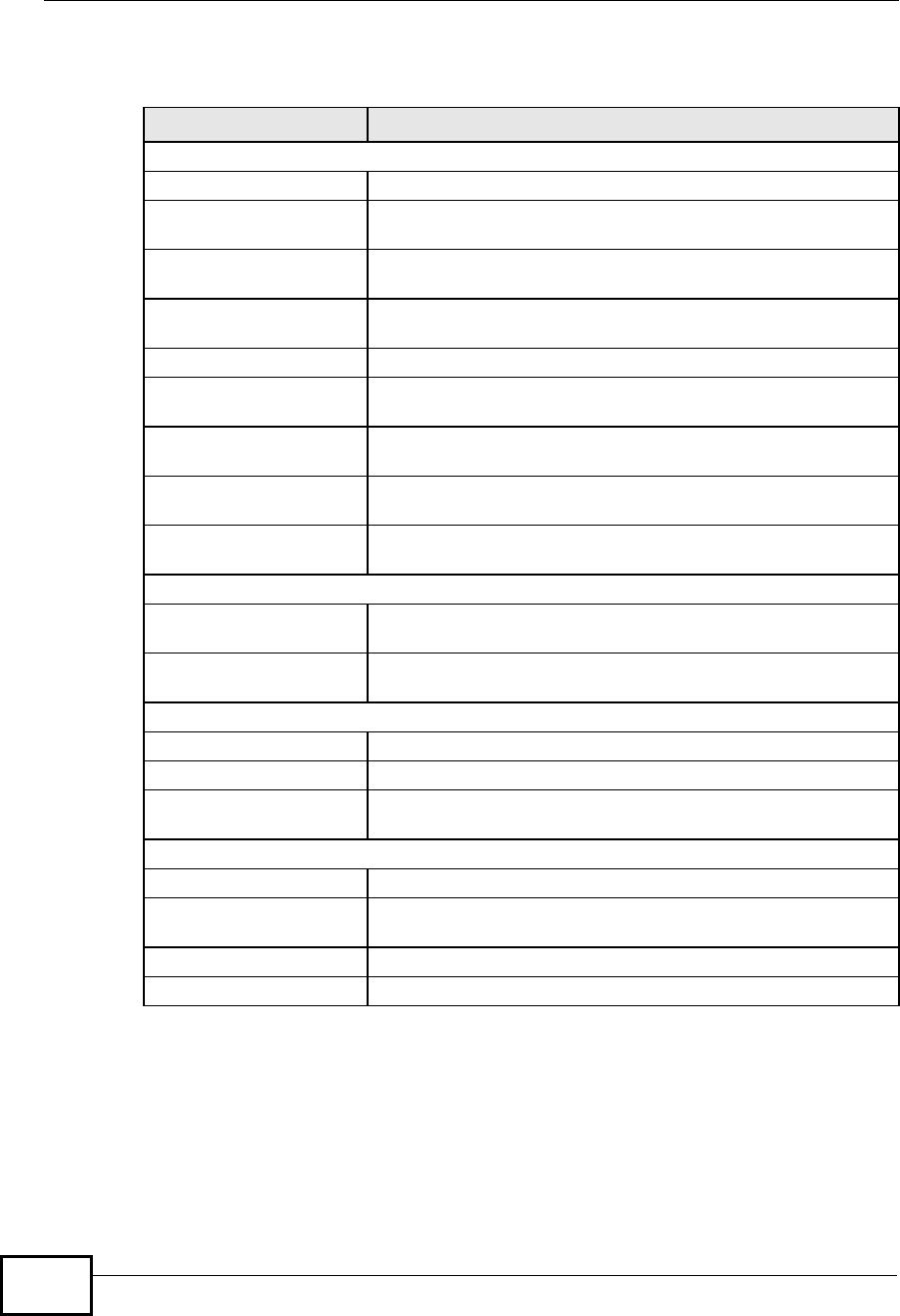
Chapter 20ACS
NBG4604 User’s Guide
174
The following table describes the labels in this screen.
Table 62 Management > ACS > General
LABEL DESCRIPTION
ACS Server Setup
URL Enter the URL of the ACS server.
Account Name Enter the login name used by the NBG4604 to log into the ACS
server.
Password Enter the password for the account used to log into the ACS
server.
Period Enter the duration in seconds over which the NBG4604
attempts to log into the ACS server.
Device Configuration
Manufacturer This displays the manufacturer name of the NBG4604, ‘ZyXEL’,
and cannot be edited.
Manufacturer Oui Enter the manufacturer organizational unit identifier. This
number must consist of a 3-octet MAC address.
Product Class Enter the product class if this was provided by the network
adminstrator. Otherwise, leave it at its default setting.
Model Name This displays the model name. In this case, it is ‘NBG4604’ and
cannot be edited.
Device Connection Request
Username Enter the username required for the ACS server to connect
directly to the NBG4604.
Password Enter the password required for the ACS server to connect
directly to the NBG4604.
Device Connection Request
STUN Server Enter the URL of the STUN server.
STUN Username Enter the username required to log into the STUN server.
STUN Password Enter the password of the username used to log into the STUN
server.
Logs
Backup Click Backup to save a copy of the NBG4604’s ACS activity.
Clear Logs Click Clear Logs to delete the files containing a record of the
NBG4604’s ACS activity.
Apply Click Apply to save the setting to the NBG4604.
Reset Click Reset to begin configuring this screen afresh.
Company Confidential
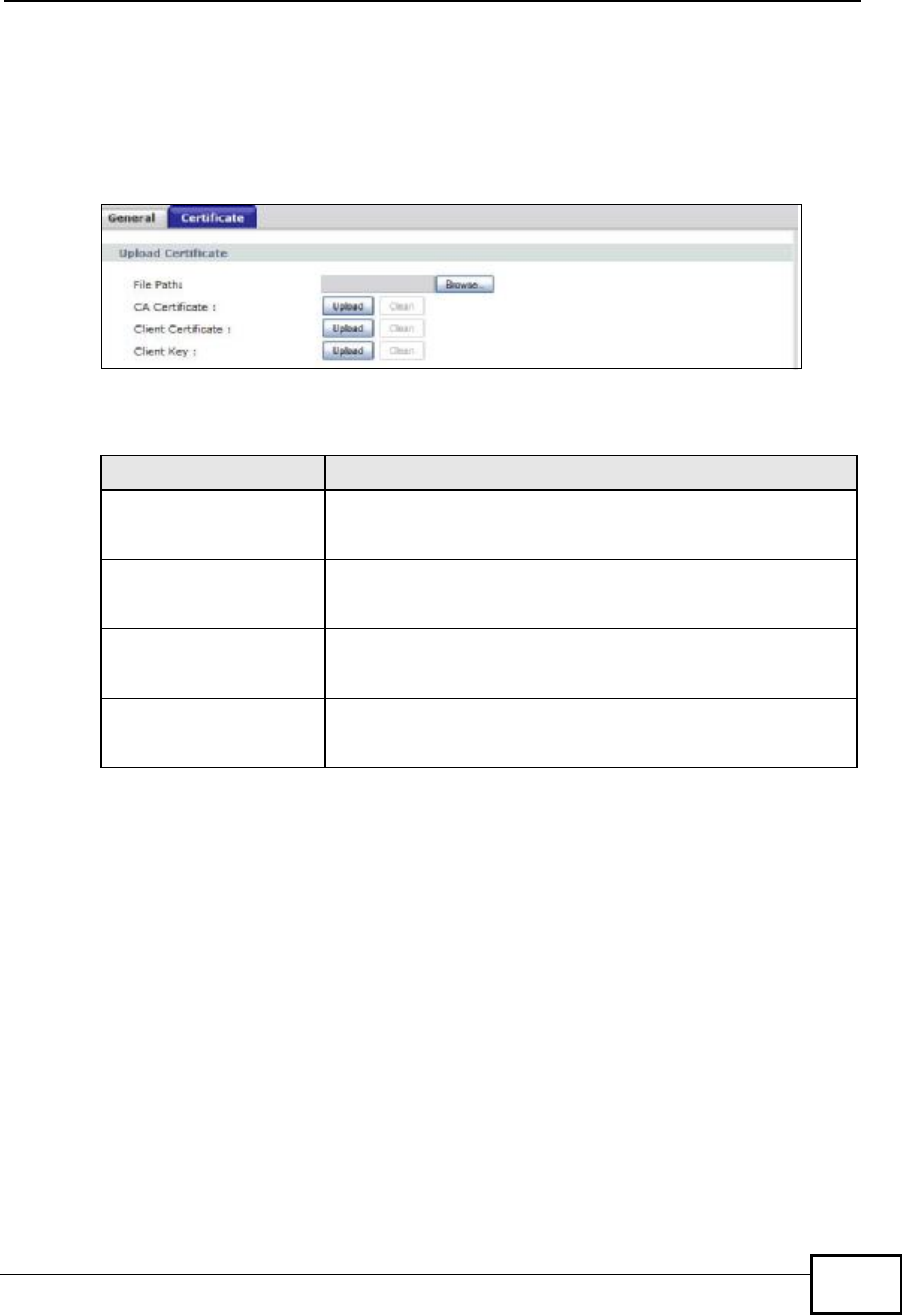
Chapter 20ACS
NBG4604 User’s Guide 175
20.5 Certificate Screen
This screen allows you to upload security certificates to the NBG4604. Click
Management > ACS > Certificates to open this screen.
Figure 100 Management > ACS > Certificates
The following table describes the labels in this screen.
Table 63 Management > UPnP > General
LABEL DESCRIPTION
File Path Enter the path of the certificate file’s location on your local
computer, or click the Browse button to open a browse dialog
box to search for it.
CA Certificate Click Upload to copy the certicate listed in File Path to the
NBG4604. Click Clear to remove the current CA Certificate
from the device.
Client Certificate Click Upload to copy the certicate listed in File Path to the
NBG4604. Click Clear to remove the current Client Certificate
from the device.
Client Key Click Upload to copy the certicate listed in File Path to the
NBG4604. Click Clear Key to remove the current CA
Certificate from the device.
Company Confidential
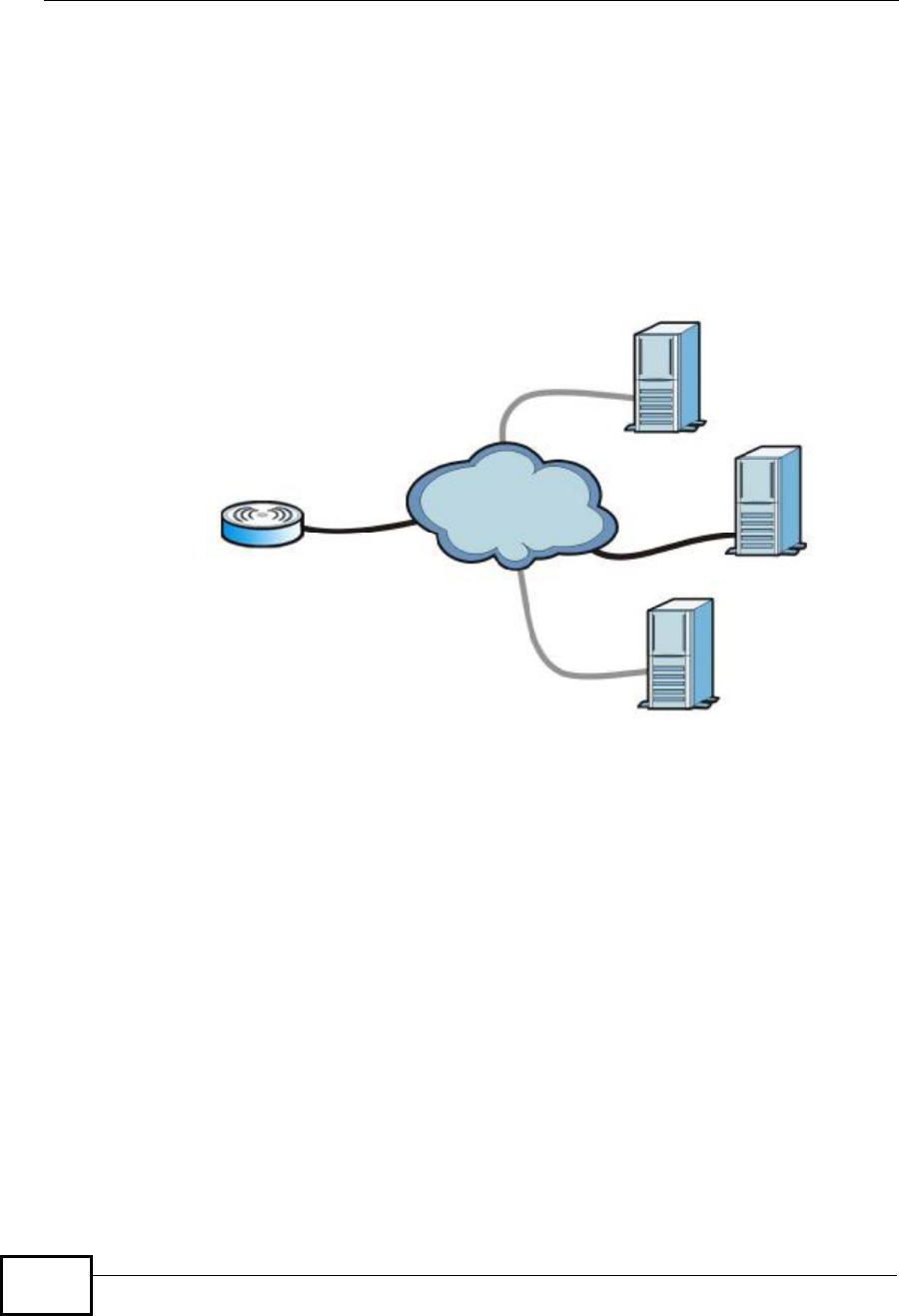
Chapter 20ACS
NBG4604 User’s Guide
176
20.6 Technical Reference
TR-069 is an abbreviation of “Technical Reference 069”, a protocol designed to
facilitate the remote management of Customer Premise Equipement (CPE), such
as the NBG4604. It can be managed over a WAN by means of an Auto
Configuration Server (ACS). TR-069 is based on sending Remote Procedure Calls
(RPCs) between the ACS and the client device. RPCs are sent in Extensible Markup
Language (XML) format over HTTP or HTTPS.
Figure 101 TR-069 Example
In this example, the NBG4604 receives data from at least 3 sources: A SIP server
for handling voice calls, an HTTP server for handling web services, and an ACS, for
configuring the NBG4604 remotely. All three servers are owned and operated by
the client’s Internet Service Provider. However, without the configuration settings
from the ACS, the NBG4604 cannot access the other two servers. Once the
NBG4604 receives its configuration settings and implements them, it can connect
to the other servers. If the settings change, it will once again be unable to connect
until it receives its updates from the ACS.
The NBG4604 can be configured to periodically check for updates from the auto-
configuration server so that the end user need not be worried about it.
SIP
ACS
HTTP
Company Confidential
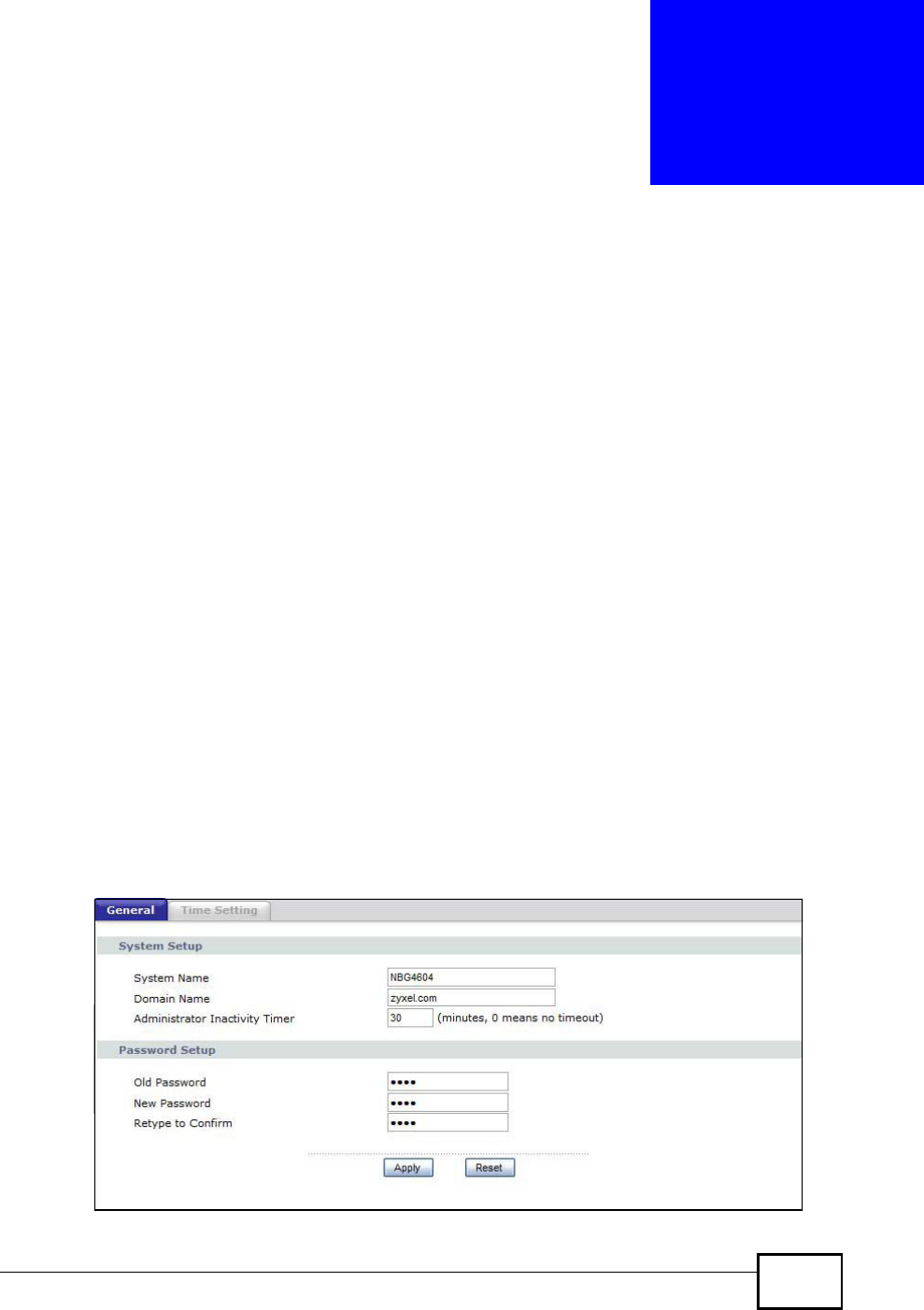
NBG4604 User’s Guide 177
CHAPTER 21
System
21.1 Overview
This chapter provides information on the System screens.
See the chapter about wizard setup for more information on the next few screens.
21.2 What You Can Do
•Use the General screen (Section 21.3 on page 177) to enter a name to identify
the NBG4604 in the network and set the password.
•Use the Time Setting screen (Section 21.4 on page 179) to change your
NBG4604’s time and date.
21.3 System General Screen
Use this screen to enter a name to identify the NBG4604 in the network and set
the password. Click Maintenance > System. The following screen displays.
Figure 102 Maintenance > System > General
Company Confidential
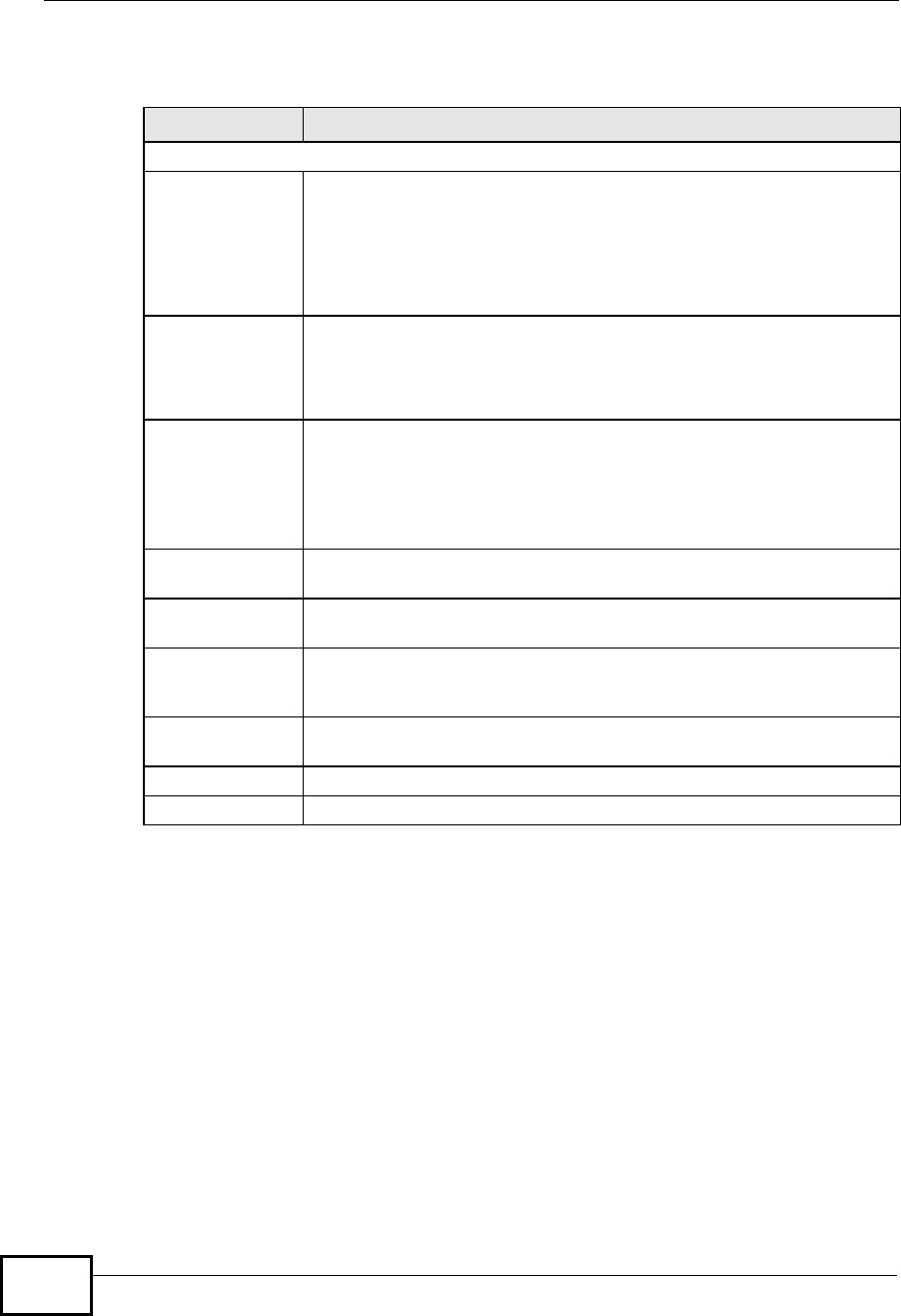
Chapter 21System
NBG4604 User’s Guide
178
The following table describes the labels in this screen.
Table 64 Maintenance > System > General
LABEL DESCRIPTION
System Setup
System Name System Name is a unique name to identify the NBG4604 in an
Ethernet network. It is recommended you enter your computer’s
“Computer name” in this field (see thechapter about wizard setup for
how to find your computer’s name).
This name can be up to 30 alphanumeric characters long. Spaces are
not allowed, but dashes “-” and underscores "_" are accepted.
Domain Name Enter the domain name (if you know it) here. If you leave this field
blank, the ISP may assign a domain name via DHCP.
The domain name entered by you is given priority over the ISP
assigned domain name.
Administrator
Inactivity Timer Type how many minutes a management session can be left idle before
the session times out. The default is 5 minutes. After it times out you
have to log in with your password again. Very long idle timeouts may
have security risks. A value of "0" means a management session never
times out, no matter how long it has been left idle (not
recommended).
Password Setup Change your NBG4604’s password (recommended) using the fields as
shown.
Old Password Type the default password or the existing password you use to access
the system in this field.
New Password Type your new system password (up to 30 characters). Note that as
you type a password, the screen displays an asterisk (*) for each
character you type.
Retype to
Confirm Type the new password again in this field.
Apply Click Apply to save your changes back to the NBG4604.
Reset Click Reset to begin configuring this screen afresh.
Company Confidential
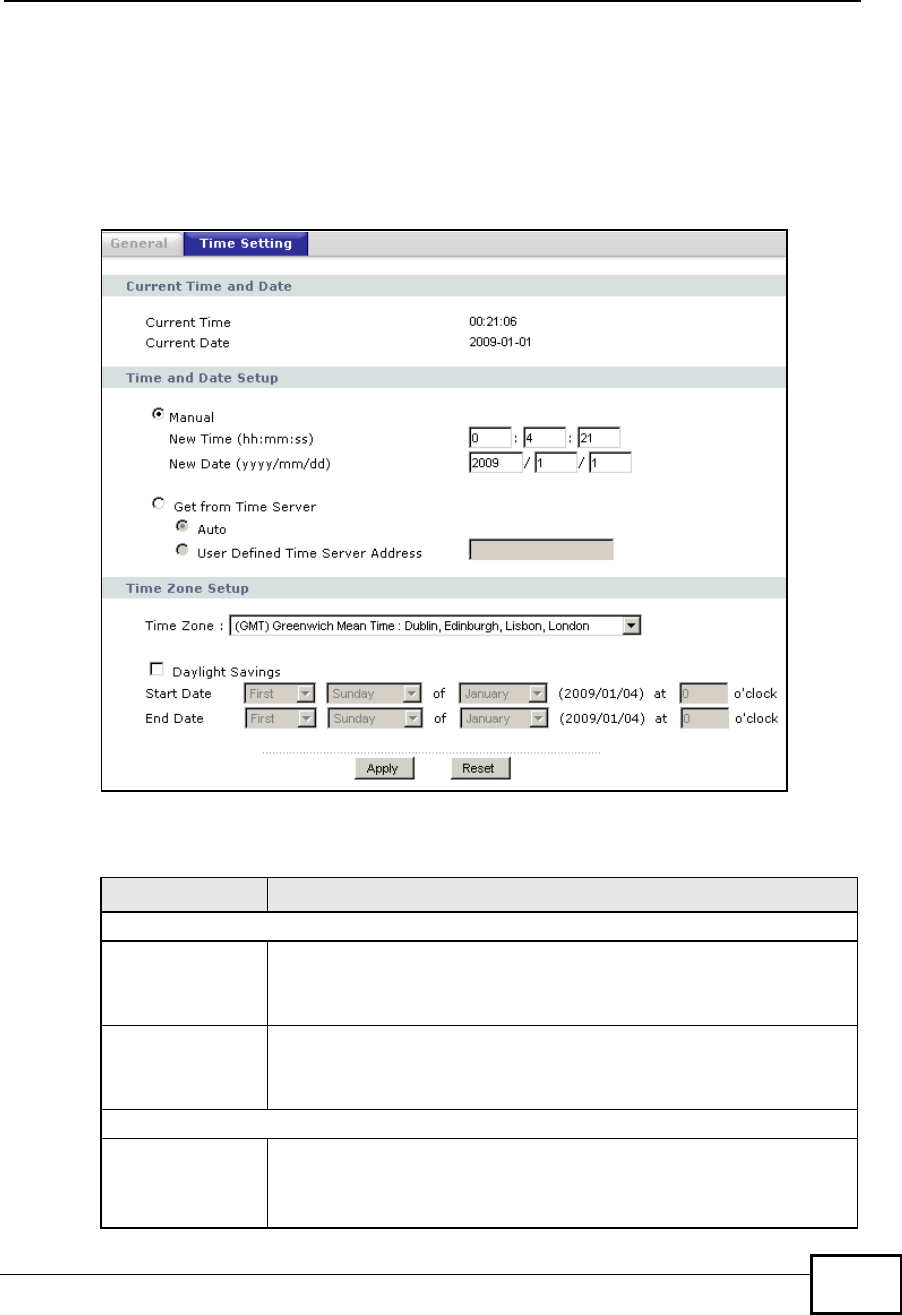
Chapter 21System
NBG4604 User’s Guide 179
21.4 Time Setting Screen
To change your NBG4604’s time and date, click Maintenance > System > Time
Setting. The screen appears as shown. Use this screen to configure the
NBG4604’s time based on your local time zone.
Figure 103 Maintenance > System > Time Setting
he following table describes the labels in this screen.
Table 65 Maintenance > System > Time Setting
LABEL DESCRIPTION
Current Time and Date
Current Time This field displays the time of your NBG4604.
Each time you reload this page, the NBG4604 synchronizes the time
with the time server.
Current Date This field displays the date of your NBG4604.
Each time you reload this page, the NBG4604 synchronizes the date
with the time server.
Time and Date Setup
Manual Select this radio button to enter the time and date manually. If you
configure a new time and date, Time Zone and Daylight Saving at the
same time, the new time and date you entered has priority and the
Time Zone and Daylight Saving settings do not affect it.
Company Confidential
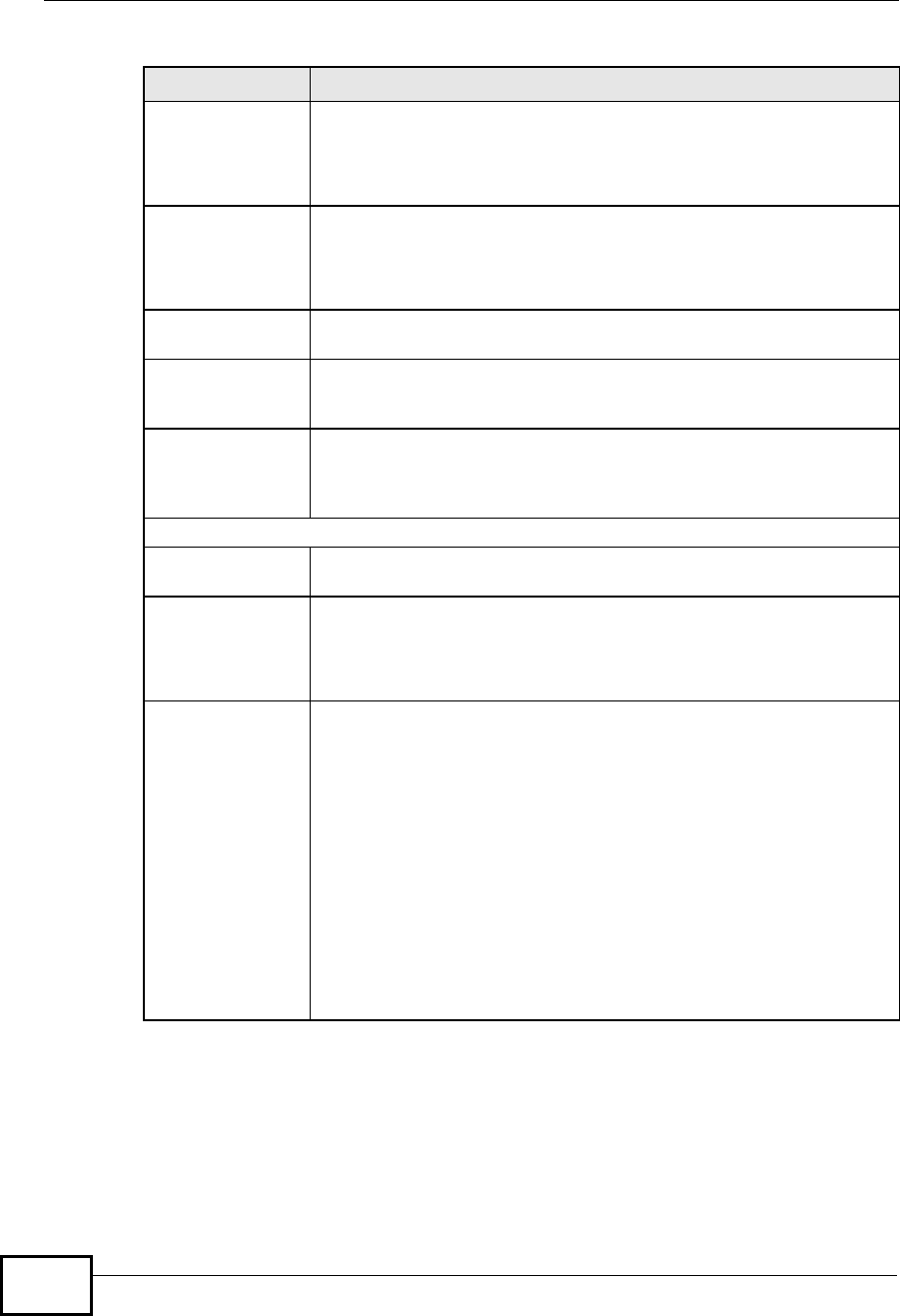
Chapter 21System
NBG4604 User’s Guide
180
New Time
(hh:mm:ss)
This field displays the last updated time from the time server or the
last time configured manually.
When you set Time and Date Setup to Manual, enter the new time
in this field and then click Apply.
New Date
(yyyy/mm/dd)
This field displays the last updated date from the time server or the
last date configured manually.
When you set Time and Date Setup to Manual, enter the new date
in this field and then click Apply.
Get from Time
Server Select this radio button to have the NBG4604 get the time and date
from the time server you specified below.
Auto Select Auto to have the NBG4604 automatically search for an
available time server and synchronize the date and time with the time
server after you click Apply.
User Defined
Time Server
Address
Select User Defined Time Server Address and enter the IP
address or URL (up to 20 extended ASCII characters in length) of
your time server. Check with your ISP/network administrator if you
are unsure of this information.
Time Zone Setup
Time Zone Choose the time zone of your location. This will set the time
difference between your time zone and Greenwich Mean Time (GMT).
Daylight Savings Daylight saving is a period from late spring to early fall when many
countries set their clocks ahead of normal local time by one hour to
give more daytime light in the evening.
Select this option if you use Daylight Saving Time.
Start Date Configure the day and time when Daylight Saving Time starts if you
selected Daylight Savings. The o'clock field uses the 24 hour
format. Here are a couple of examples:
Daylight Saving Time starts in most parts of the United States on the
first Sunday of April. Each time zone in the United States starts using
Daylight Saving Time at 2 A.M. local time. So in the United States you
would select First,Sunday,April and type 2 in the o'clock field.
Daylight Saving Time starts in the European Union on the last Sunday
of March. All of the time zones in the European Union start using
Daylight Saving Time at the same moment (1 A.M. GMT or UTC). So
in the European Union you would select Last,Sunday,March. The
time you type in the o'clock field depends on your time zone. In
Germany for instance, you would type 2 because Germany's time
zone is one hour ahead of GMT or UTC (GMT+1).
Table 65 Maintenance > System > Time Setting
LABEL DESCRIPTION
Company Confidential
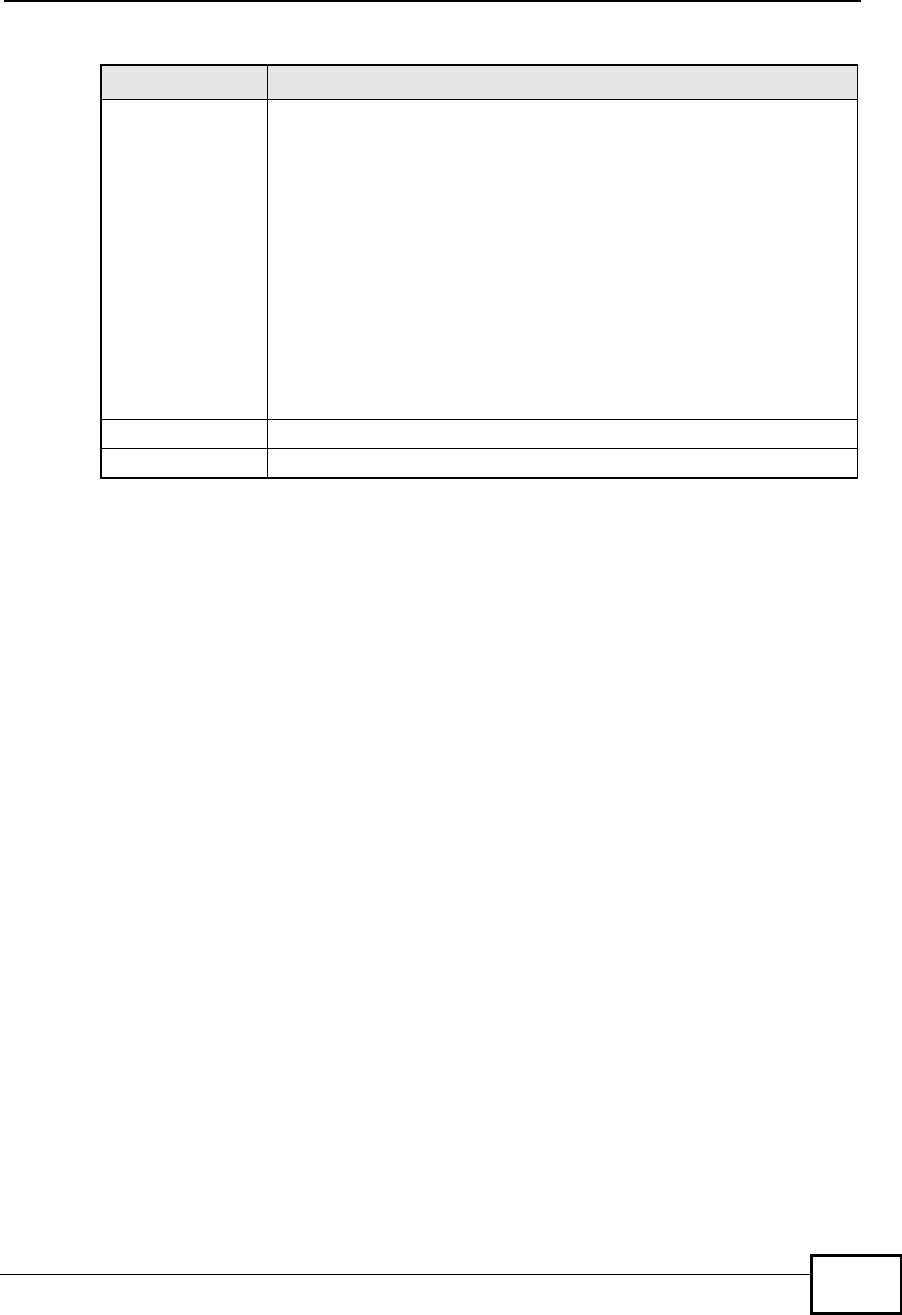
Chapter 21System
NBG4604 User’s Guide 181
End Date Configure the day and time when Daylight Saving Time ends if you
selected Daylight Savings. The o'clock field uses the 24 hour
format. Here are a couple of examples:
Daylight Saving Time ends in the United States on the last Sunday of
October. Each time zone in the United States stops using Daylight
Saving Time at 2 A.M. local time. So in the United States you would
select Last,Sunday,October and type 2 in the o'clock field.
Daylight Saving Time ends in the European Union on the last Sunday
of October. All of the time zones in the European Union stop using
Daylight Saving Time at the same moment (1 A.M. GMT or UTC). So
in the European Union you would select Last,Sunday,October. The
time you type in the o'clock field depends on your time zone. In
Germany for instance, you would type 2 because Germany's time
zone is one hour ahead of GMT or UTC (GMT+1).
Apply Click Apply to save your changes back to the NBG4604.
Reset Click Reset to begin configuring this screen afresh.
Table 65 Maintenance > System > Time Setting
LABEL DESCRIPTION
Company Confidential

Chapter 21System
NBG4604 User’s Guide
182
Company Confidential

NBG4604 User’s Guide 183
CHAPTER 22
Logs
22.1 Overview
This chapter contains information about configuring general log settings and
viewing the NBG4604’s logs.
The Web Configurator allows you to look at all of the NBG4604’s logs in one
location.
22.2 What You Can Do
•Use the View Log screen (Section 22.4 on page 184) to see the logs for the
categories such as system maintenance, system errors, access control, allowed
or blocked web sites, blocked web features, and so on.
•Use the Log Settings screen (Section 5.8 on page 5) to send copies of the
NBG4604 syslog files to a dedicated syslog server.
22.3 What You Need to Know
An alert is a type of log that warrants more serious attention. They include system
errors, attacks (access control) and attempted access to blocked web sites or web
sites with restricted web features such as cookies, active X and so on. Some
categories such as System Errors consist of both logs and alerts. You may
differentiate them by their color in the View Log screen. Alerts display in red and
logs display in black.
Alerts are e-mailed as soon as they happen. Logs may be e-mailed as soon as the
log is full (see Log Schedule). Selecting many alert and/or log categories
(especially Access Control) may result in many e-mails being sent.
Company Confidential
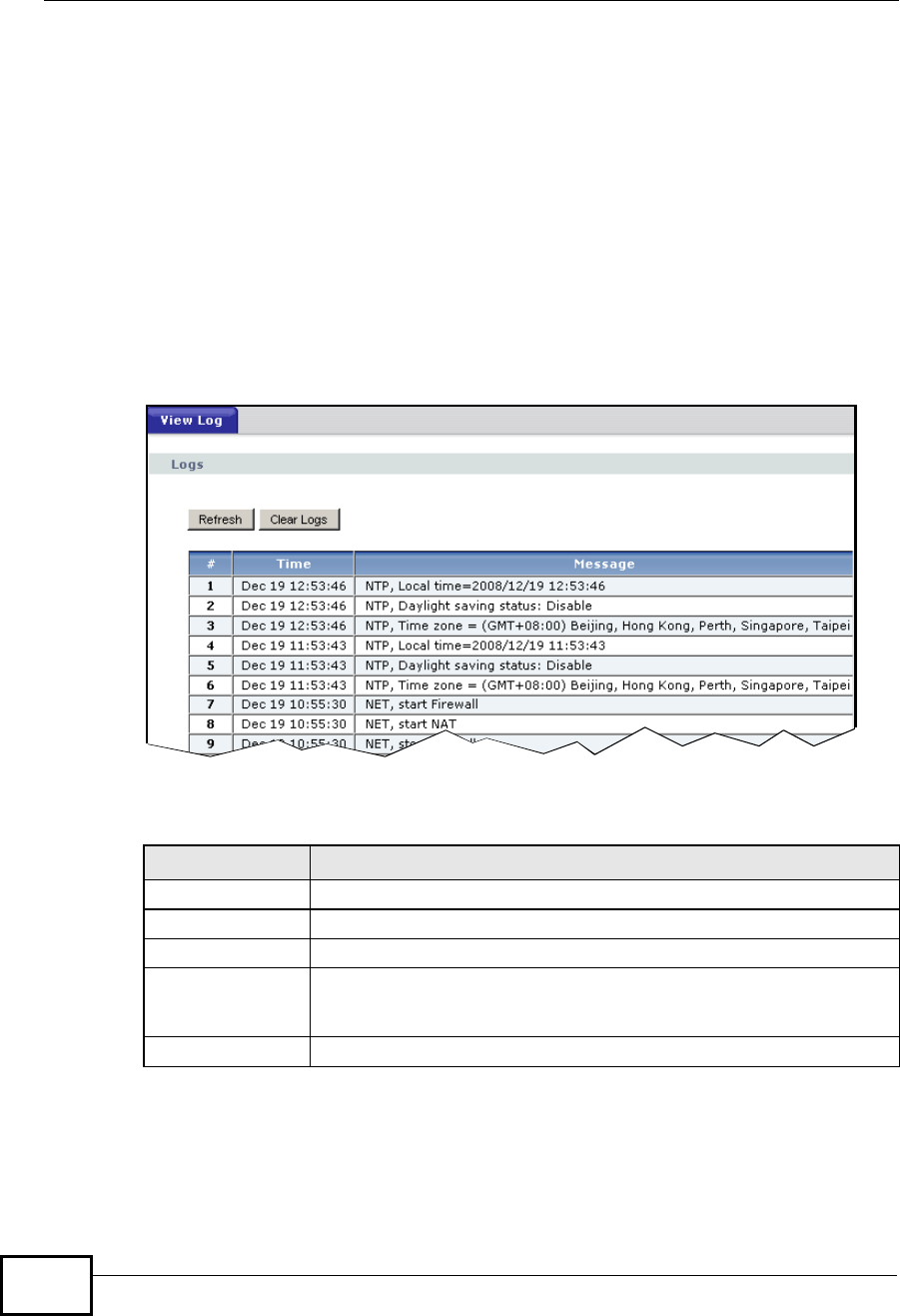
Chapter 22Logs
NBG4604 User’s Guide
184
22.4 View Log Screen
Use the View Log screen to see the logged messages for the NBG4604. Options
include logs about system maintenance, system errors, access control, allowed or
blocked web sites, blocked web features (such as ActiveX controls, Java and
cookies), attacks (such as DoS) and IPSec.
Log entries in red indicate system error logs. The log wraps around and deletes
the old entries after it fills. Click a column heading to sort the entries. A triangle
indicates ascending or descending sort order.
Click Maintenance > Logs to open the View Log screen.
Figure 104 Maintenance > Logs > View Log
The following table describes the labels in this screen.
Table 66 Maintenance > Logs > View Log
LABEL DESCRIPTION
Refresh Click Refresh to renew the log screen.
Clear Log Click Clear Log to delete all the logs.
#This is the index number of the log entry.
Time This field displays the time the log was recorded. See the chapter on
system maintenance and information to configure the NBG4604’s
time and date.
Message This field states the reason for the log.
Company Confidential
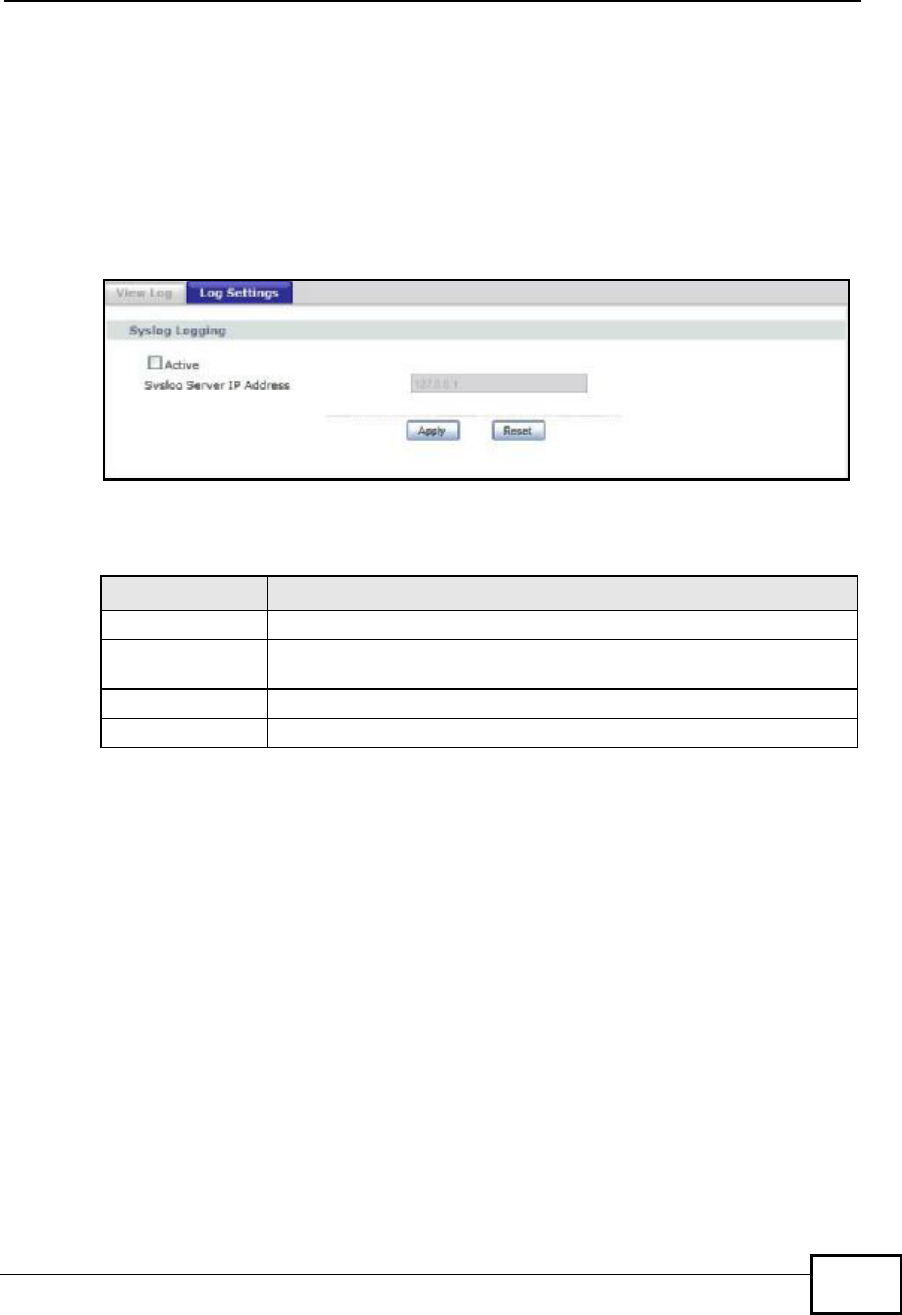
Chapter 22Logs
NBG4604 User’s Guide 185
22.5 Log Settings Screen
Use this screen to send copies of the NBG4604 syslog files to a dedicated syslog
server. For information on setting up a syslog server, consult the documentation
that came with your syslog server product.
Click Maintenance > Logs > Log Settings to open this screen.
Figure 105 Maintenance > Logs > Log Settings
The following table describes the labels in this screen.
Table 67 Maintenance > Logs > Log Settings
LABEL DESCRIPTION
Active Select this to enable syslog logging on this device.
Syslog Server IP
Address Enter the IP address of the syslog server to receive syslogs from this
device.
Apply Click Apply to save the setting to the NBG4604.
Reset Click Reset to begin configuring this screen afresh.
Company Confidential

Chapter 22Logs
NBG4604 User’s Guide
186
Company Confidential

NBG4604 User’s Guide 187
CHAPTER 23
Tools
23.1 Overview
This chapter shows you how to upload a new firmware, upload or save backup
configuration files and restart the NBG4604.
23.2 What You Can Do
•Use the Firmware screen (Section 23.3 on page 187) to upload firmware to
your NBG4604.
•Use the Configuration screen (Section 23.4 on page 190) to view information
related to factory defaults, backup configuration, and restoring configuration.
•Use the Restart screen (Section 23.5 on page 192) to have the NBG4604
reboot.
23.3 Firmware Upload Screen
Find firmware at www.zyxel.com in a file that (usually) uses the system model
name with a “*.bin” extension, e.g., “NBG4604.bin”. The upload process uses
HTTP (Hypertext Transfer Protocol) and may take up to two minutes. After a
successful upload, the system will reboot.
Company Confidential
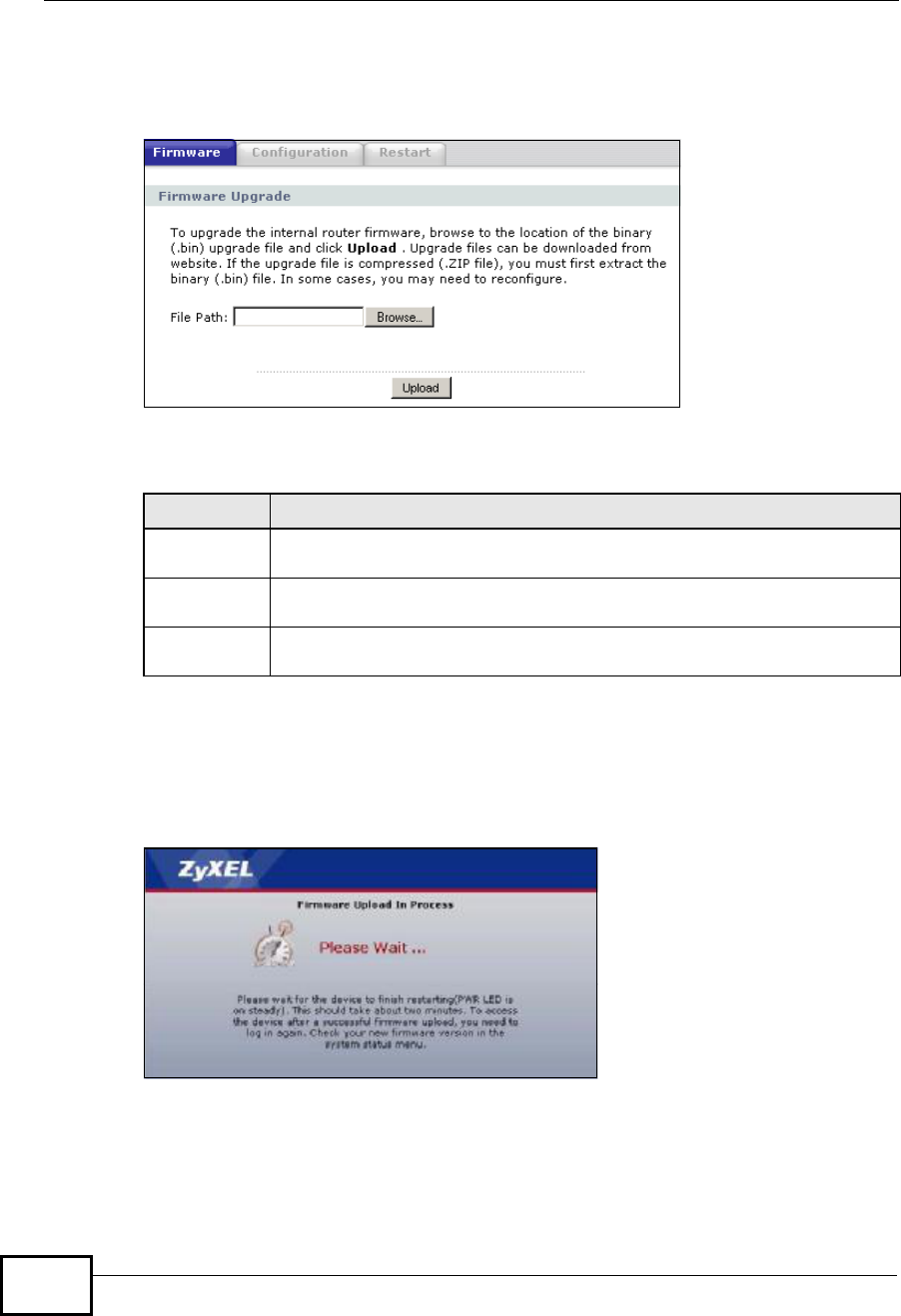
Chapter 23Tools
NBG4604 User’s Guide
188
Click Maintenance > Tools. Follow the instructions in this screen to upload
firmware to your NBG4604.
Figure 106 Maintenance > Tools > Firmware
The following table describes the labels in this screen.
Note: Do not turn off the NBG4604 while firmware upload is in progress!
After you see the Firmware Upload In Process screen, wait two minutes before
logging into the NBG4604 again.
Figure 107 Upload Warning
Table 68 Maintenance > Tools > Firmware
LABEL DESCRIPTION
File Path Type in the location of the file you want to upload in this field or click
Browse... to find it.
Browse... Click Browse... to find the .bin file you want to upload. Remember that
you must decompress compressed (.zip) files before you can upload them.
Upload Click Upload to begin the upload process. This process may take up to
two minutes.
Company Confidential
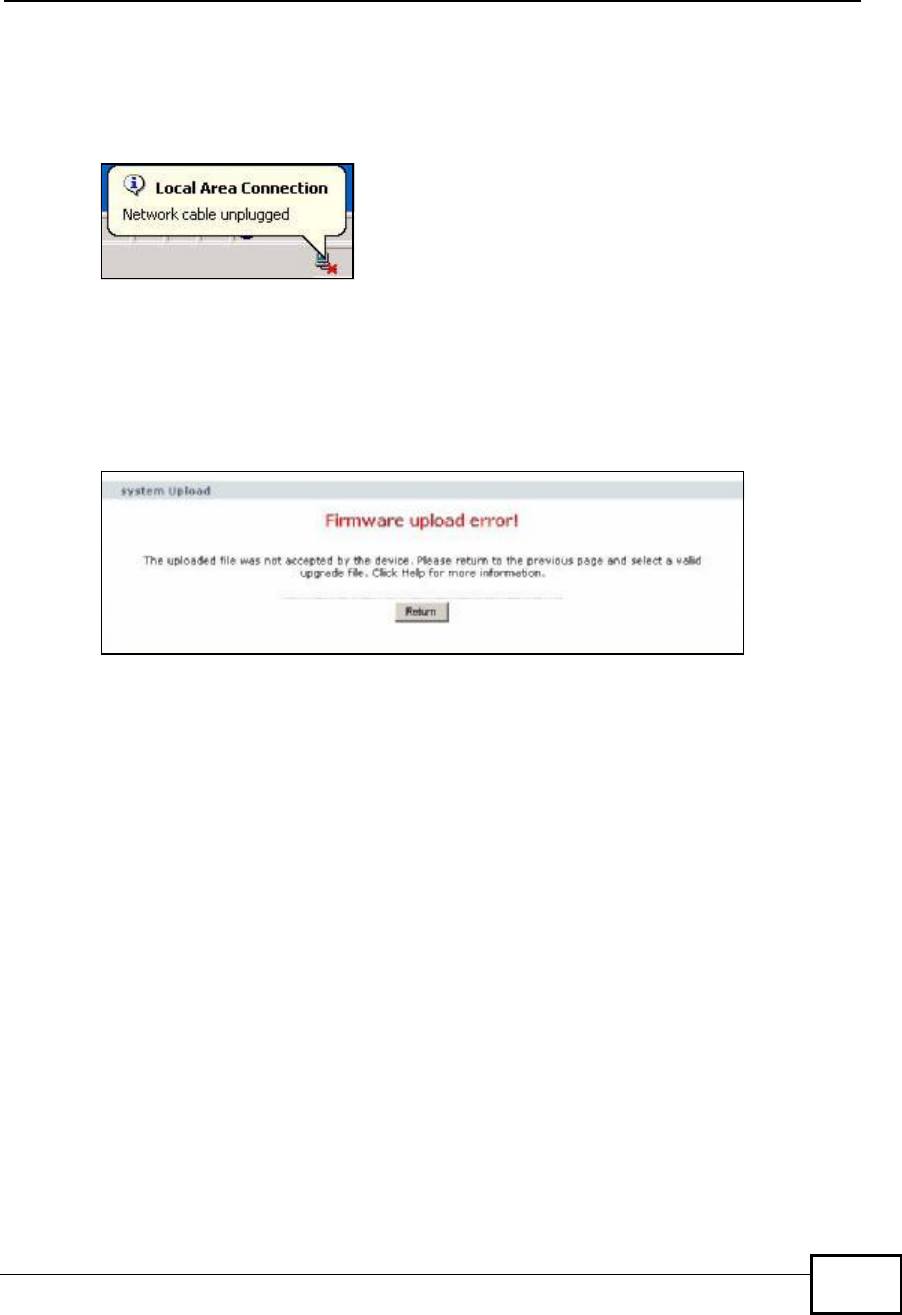
Chapter 23Tools
NBG4604 User’s Guide 189
The NBG4604 automatically restarts in this time causing a temporary network
disconnect. In some operating systems, you may see the following icon on your
desktop.
Figure 108 Network Temporarily Disconnected
After two minutes, log in again and check your new firmware version in the
Status screen.
If the upload was not successful, the following screen will appear. Click Return to
go back to the Firmware screen.
Figure 109 Upload Error Message
Company Confidential
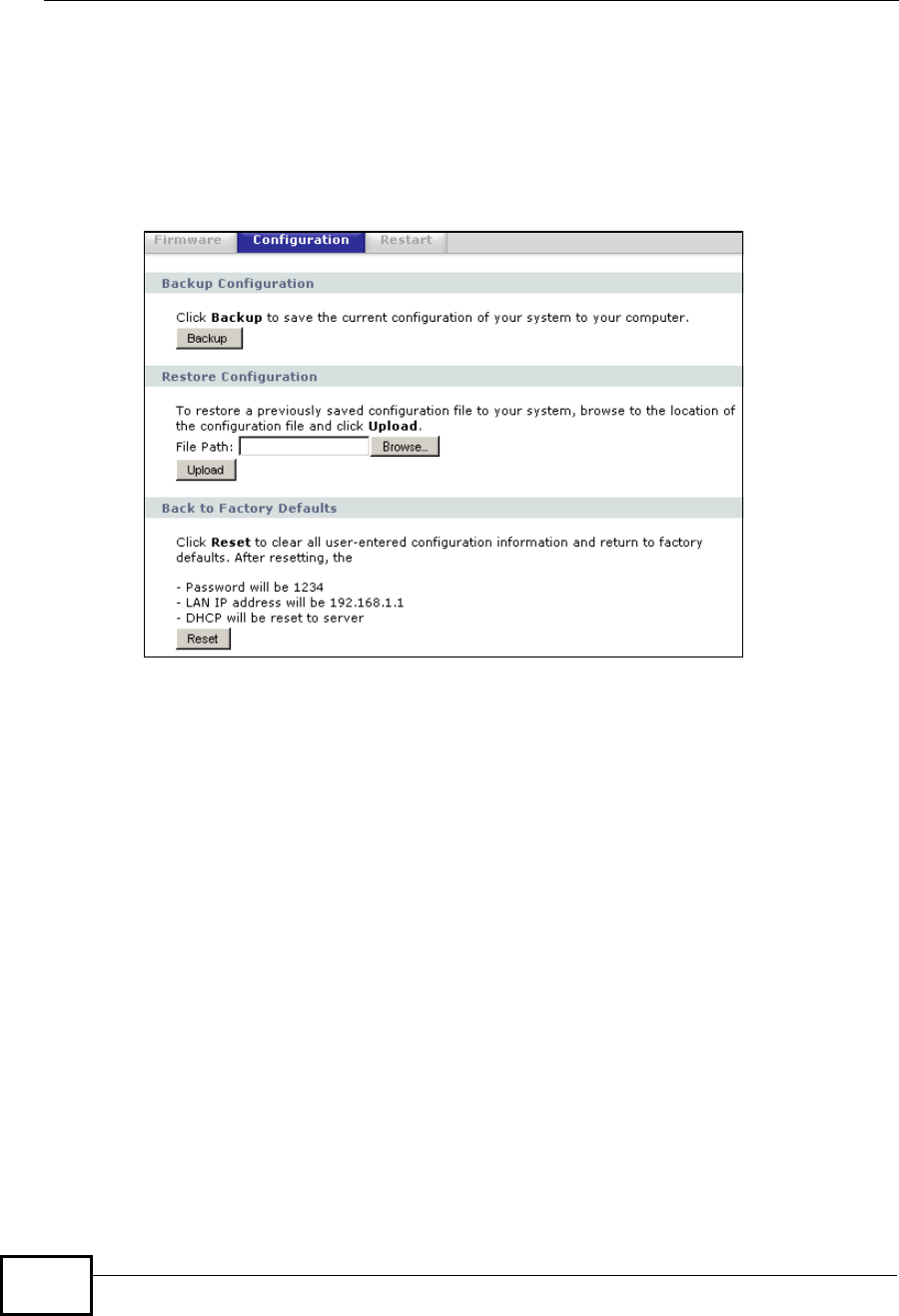
Chapter 23Tools
NBG4604 User’s Guide
190
23.4 Configuration Screen
Click Maintenance > Tools > Configuration. Information related to factory
defaults, backup configuration, and restoring configuration appears as shown
next.
Figure 110 Maintenance > Tools > Configuration
23.4.1 Backup Configuration
Backup configuration allows you to back up (save) the NBG4604’s current
configuration to a file on your computer. Once your NBG4604 is configured and
functioning properly, it is highly recommended that you back up your configuration
file before making configuration changes. The backup configuration file will be
useful in case you need to return to your previous settings.
Click Backup to save the NBG4604’s current configuration to your computer.
Company Confidential
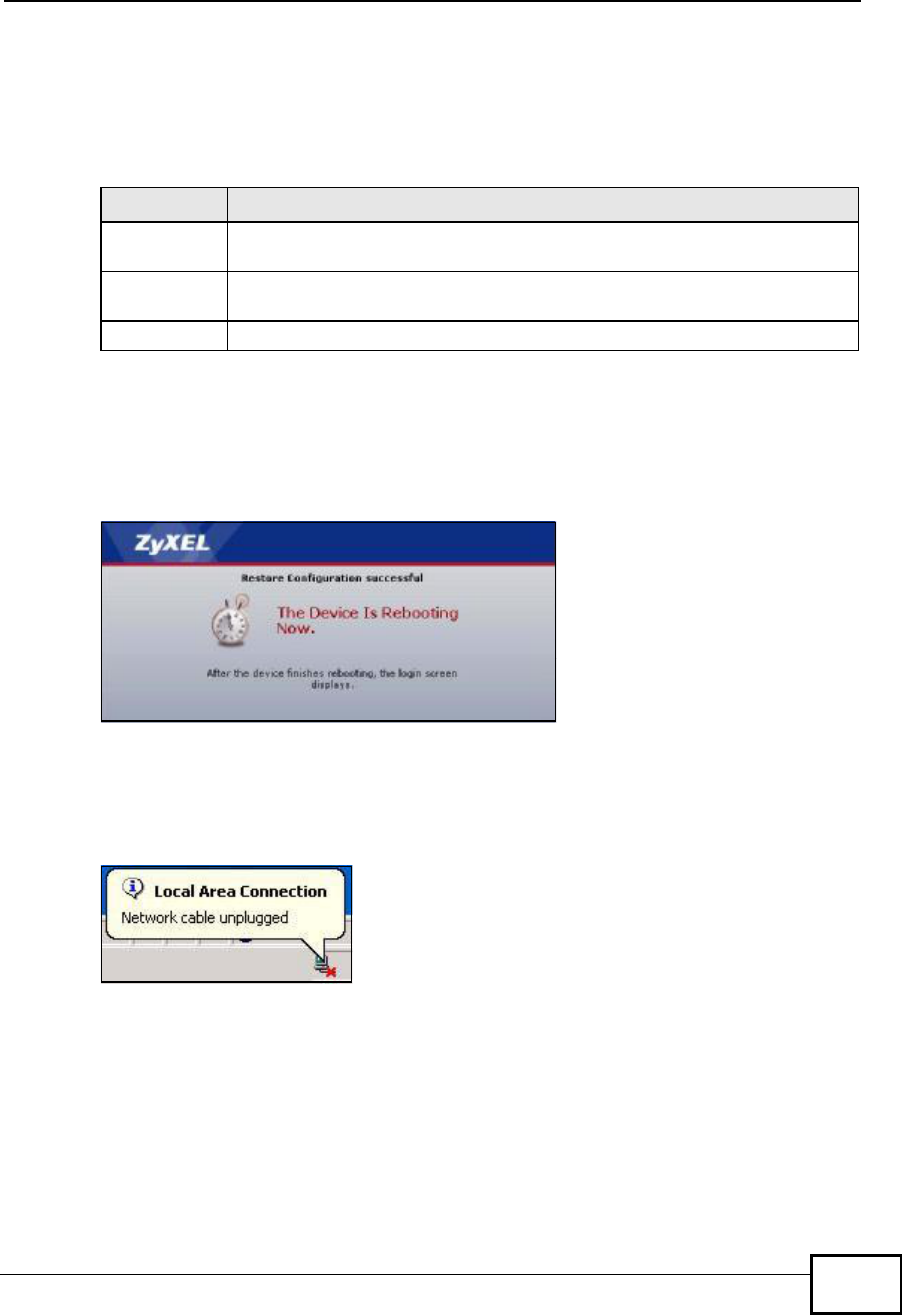
Chapter 23Tools
NBG4604 User’s Guide 191
23.4.2 Restore Configuration
Restore configuration allows you to upload a new or previously saved
configuration file from your computer to your NBG4604.
Note: Do not turn off the NBG4604 while configuration file upload is in progress
After you see a “configuration upload successful” screen, you must then wait one
minute before logging into the NBG4604 again.
Figure 111 Configuration Restore Successful
The NBG4604 automatically restarts in this time causing a temporary network
disconnect. In some operating systems, you may see the following icon on your
desktop.
Figure 112 Temporarily Disconnected
If you uploaded the default configuration file you may need to change the IP
address of your computer to be in the same subnet as that of the default
NBG4604 IP address (192.168.1.1). See Appendix C on page 229 for details on
how to set up your computer’s IP address.
Table 69 Maintenance Restore Configuration
LABEL DESCRIPTION
File Path Type in the location of the file you want to upload in this field or click
Browse... to find it.
Browse... Click Browse... to find the file you want to upload. Remember that you
must decompress compressed (.ZIP) files before you can upload them.
Upload Click Upload to begin the upload process.
Company Confidential
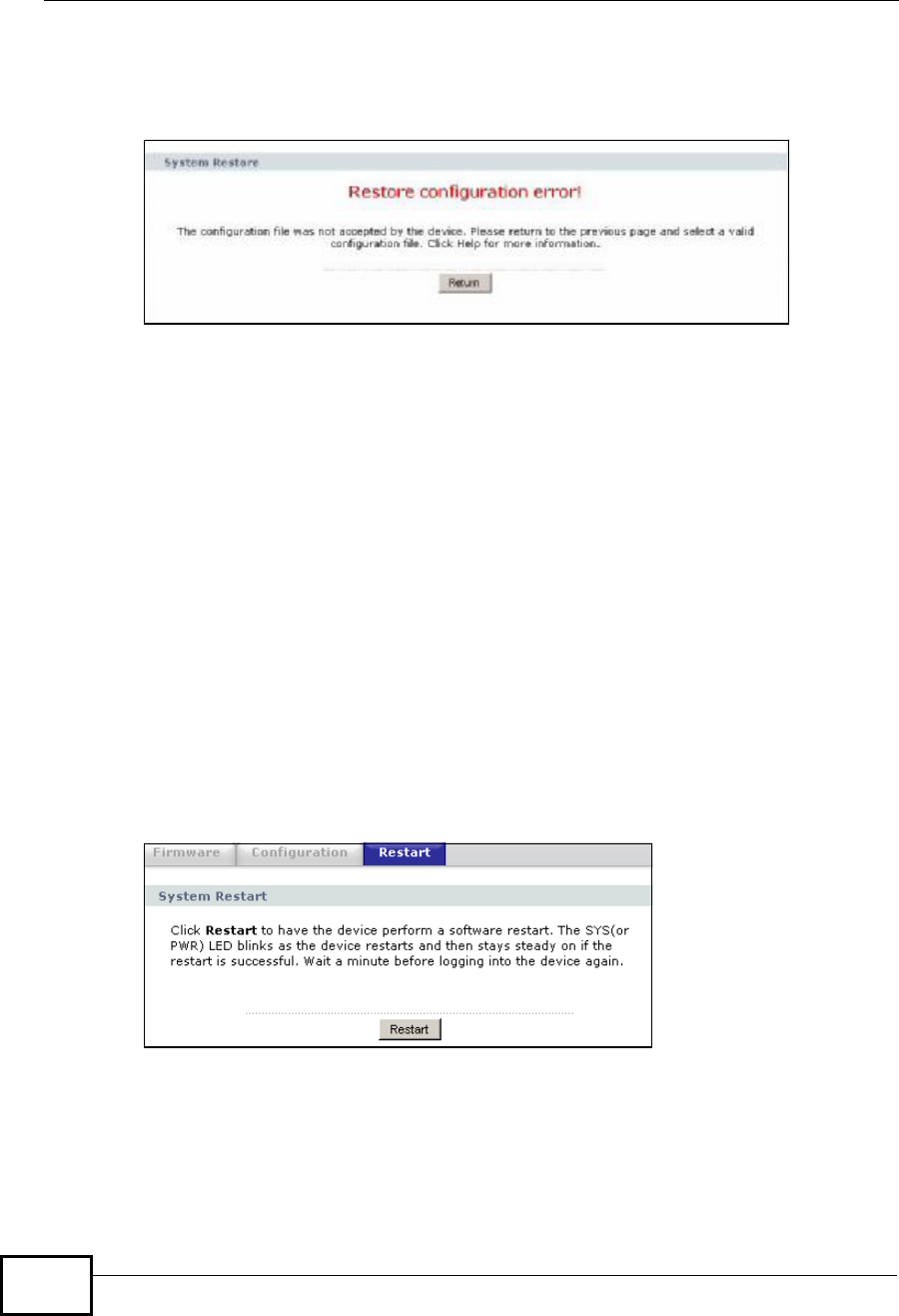
Chapter 23Tools
NBG4604 User’s Guide
192
If the upload was not successful, the following screen will appear. Click Return to
go back to the Configuration screen.
Figure 113 Configuration Restore Error
23.4.3 Back to Factory Defaults
Pressing the Reset button in this section clears all user-entered configuration
information and returns the NBG4604 to its factory defaults.
You can also press the RESET button on the rear panel to reset the factory
defaults of your NBG4604. Refer to the chapter about introducing the Web
Configurator for more information on the RESET button.
23.5 Restart Screen
System restart allows you to reboot the NBG4604 without turning the power off.
Click Maintenance > Tools > Restart. Click Restart to have the NBG4604
reboot. This does not affect the NBG4604's configuration.
Figure 114 Maintenance > Tools > Restart
Company Confidential
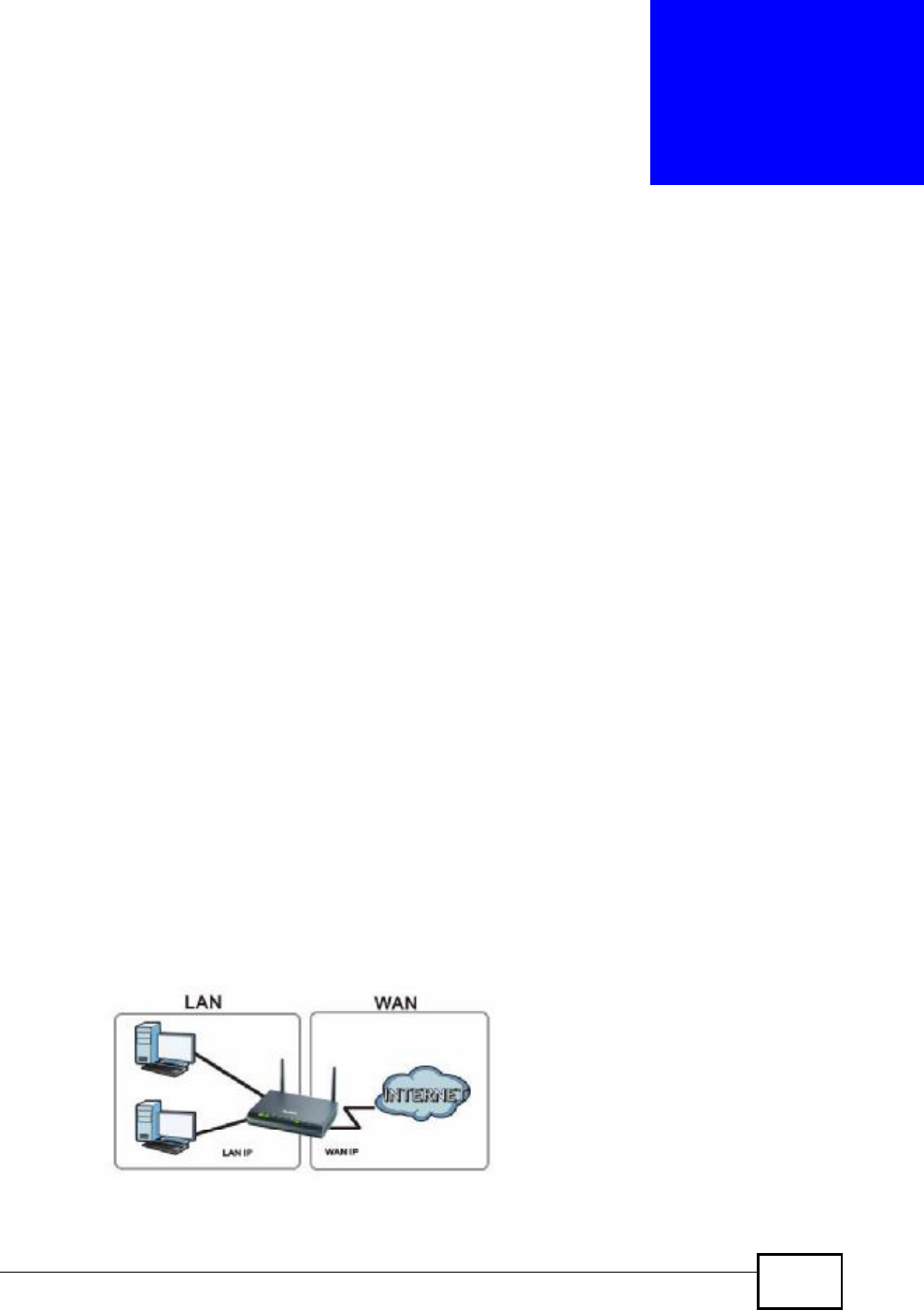
NBG4604 User’s Guide 193
CHAPTER 24
Sys OP Mode
24.1 Overview
The Sys OP Mode (System Operation Mode) function lets you configure whether
your NBG4604 is a router or AP.
You can choose between Router Mode and AP Mode depending on your network
topology and the features you require from your device. See Section 1.1 on page
21 for more information on which mode to choose.
24.2 What You Can Do
Use the General screen (Section 24.4 on page 194) to select how you connect to
the Internet.
24.3 What You Need to Know
Router
A router connects your local network with another network, such as the Internet.
The router has two IP addresses, the LAN IP address and the WAN IP address.
Figure 115 LAN and WAN IP Addresses in Router Mode
Company Confidential
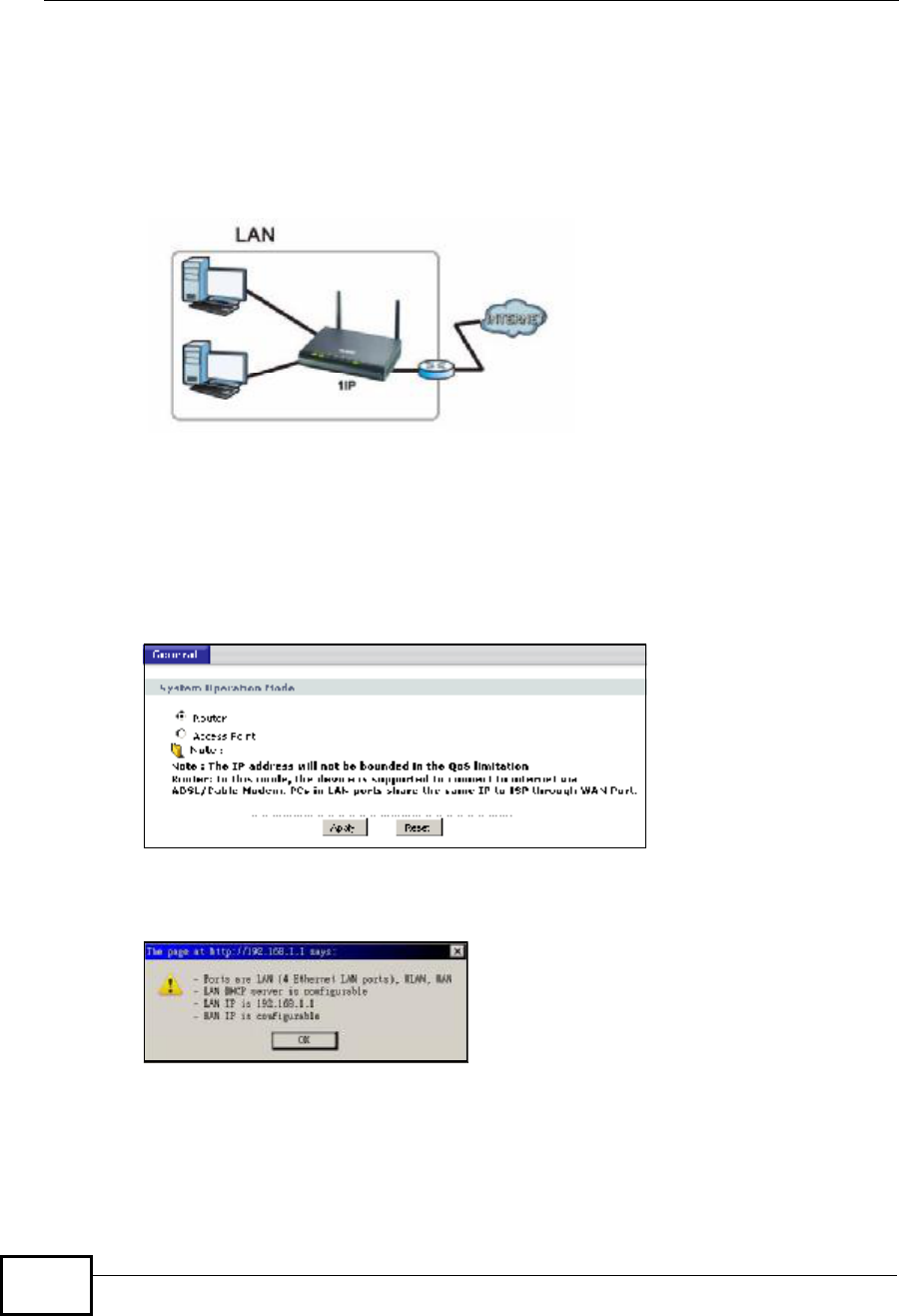
Chapter 24Sys OP Mode
NBG4604 User’s Guide
194
AP
An AP extends one network and so has just one IP address. All Ethernet ports on
the AP have the same IP address. To connect to the Internet, another device, such
as a router, is required.
Figure 116 IP Address in AP Mode
24.4 General Screen
Use this screen to select how you connect to the Internet.
Figure 117 Maintenance > Sys OP Mode > General
If you select Router Mode, the following pop-up message window appears.
Figure 118 Maintenance > Sys Op Mode > General: Router
•In this mode there are both LAN and WAN ports. The LAN Ethernet and WAN
Ethernet ports have different IP addresses.
•The DHCP server on your device is enabled and allocates IP addresses to other
devices on your local network.
•The LAN IP address of the device on the local network is set to 192.168.1.1.
Company Confidential
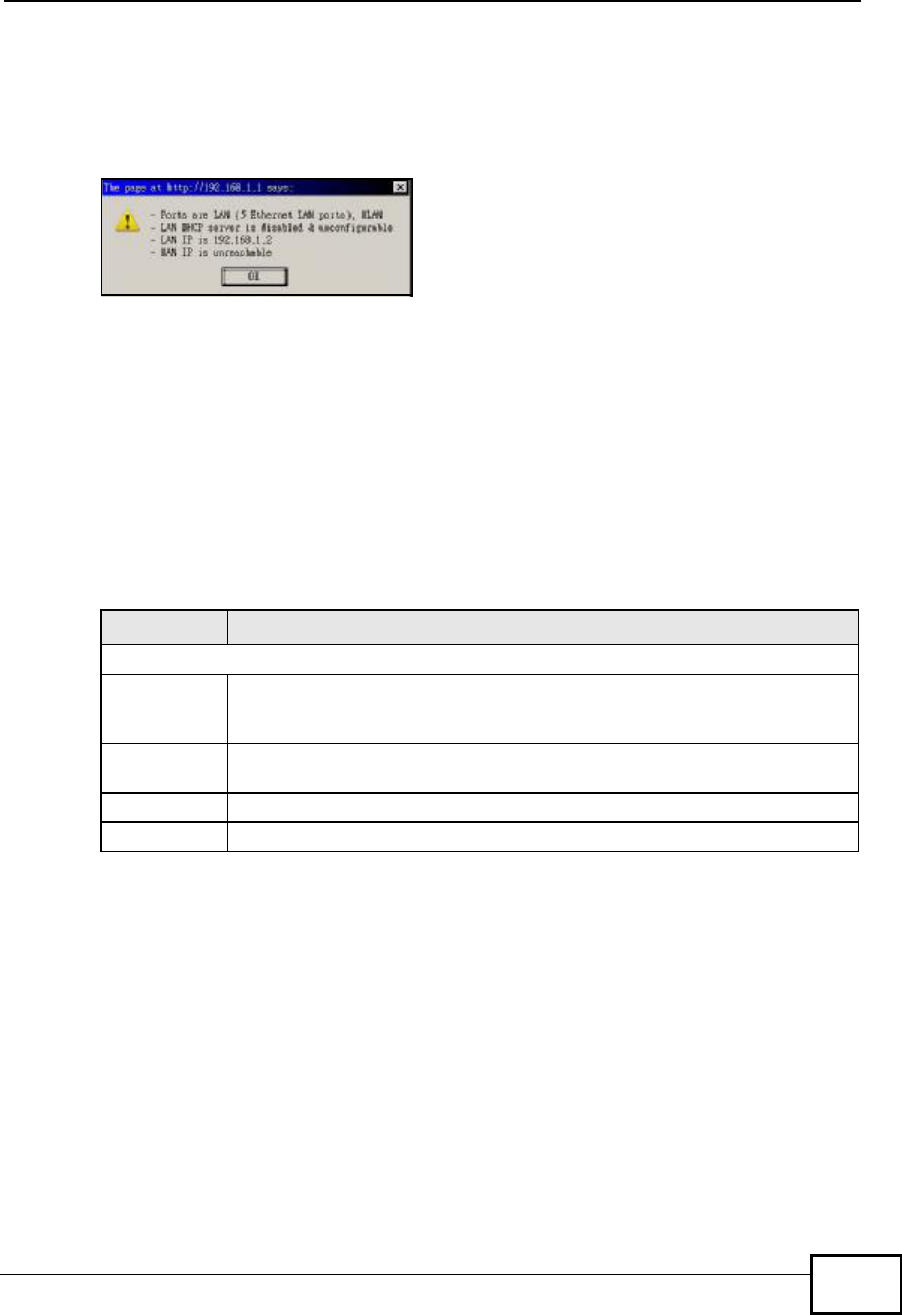
Chapter 24Sys OP Mode
NBG4604 User’s Guide 195
•You can configure the IP address settings on your WAN port. Contact your ISP or
system administrator for more information on appropriate settings.
If you select Access Point the following pop-up message window appears.
Figure 119 Maintenance > Sys Op Mode > General: AP
•In AP Mode all Ethernet ports have the same IP address.
•All ports on the rear panel of the device are LAN ports, including the port labeled
WAN. There is no WAN port.
•The DHCP server on your device is disabled. In AP mode there must be a device
with a DHCP server on your network such as a router or gateway which can
allocate IP addresses.
The IP address of the device on the local network is set to 192.168.1.2.
The following table describes the labels in the General screen.
Table 70 Maintenance > Sys OP Mode > General
Note: If you select the incorrect System Operation Mode you cannot connect to the
Internet.
LABEL DESCRIPTION
System Operation Mode
Router Select Router if your device routes traffic between a local network and
another network such as the Internet. This mode offers services such as a
firewall or content filter.
Access Point Select Access Point if your device bridges traffic between clients on the
same network.
Apply Click Apply to save your settings.
Reset Click Reset to return your settings to the default (Router)
Company Confidential

Chapter 24Sys OP Mode
NBG4604 User’s Guide
196
Company Confidential
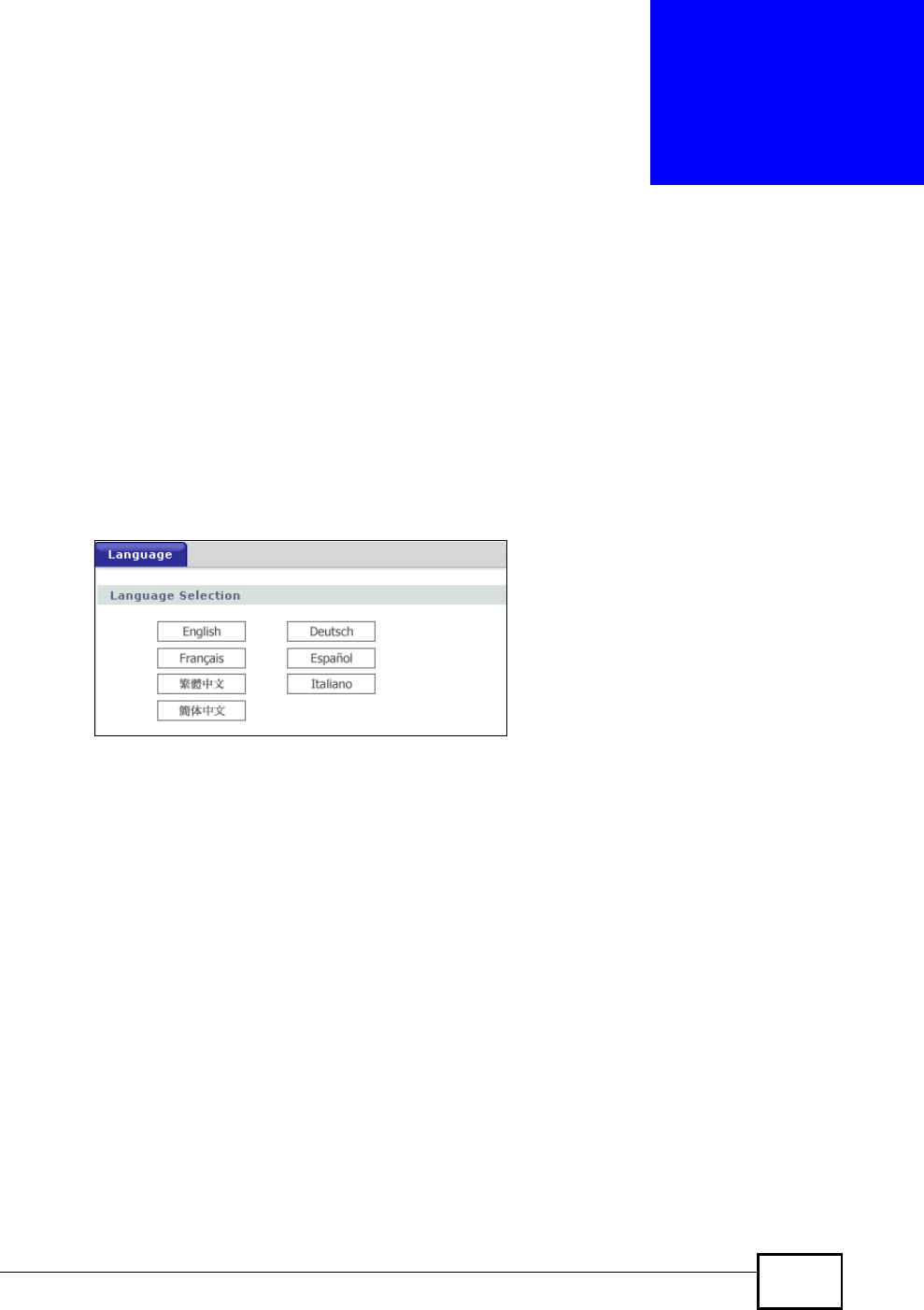
NBG4604 User’s Guide 197
CHAPTER 25
Language
25.1 Language Screen
Use this screen to change the language for the Web Configurator display.
Click the language you prefer. The Web Configurator language changes after a
while without restarting the NBG4604.
Figure 120 Language
Company Confidential

Chapter 25Language
NBG4604 User’s Guide
198
Company Confidential

NBG4604 User’s Guide 199
CHAPTER 26
Troubleshooting
This chapter offers some suggestions to solve problems you might encounter. The
potential problems are divided into the following categories.
•Power, Hardware Connections, and LEDs
•NBG4604 Access and Login
•Internet Access
•Resetting the NBG4604 to Its Factory Defaults
•Wireless Router/AP Troubleshooting
26.1 Power, Hardware Connections, and LEDs
The NBG4604 does not turn on. None of the LEDs turn on.
1Make sure you are using the power adaptor or cord included with the NBG4604.
2Make sure the power adaptor or cord is connected to the NBG4604 and plugged in
to an appropriate power source. Make sure the power source is turned on.
3Disconnect and re-connect the power adaptor or cord to the NBG4604.
4If the problem continues, contact the vendor.
One of the LEDs does not behave as expected.
1Make sure you understand the normal behavior of the LED. See Section 1.5 on
page 22.
2Check the hardware connections. See the Quick Start Guide.
Company Confidential

Chapter 26Troubleshooting
NBG4604 User’s Guide
200
3Inspect your cables for damage. Contact the vendor to replace any damaged
cables.
4Disconnect and re-connect the power adaptor to the NBG4604.
5If the problem continues, contact the vendor.
26.2 NBG4604 Access and Login
I don’t know the IP address of my NBG4604.
1The default IP address is 192.168.1.1.
2If you changed the IP address and have forgotten it, you might get the IP address
of the NBG4604 by looking up the IP address of the default gateway for your
computer. To do this in most Windows computers, click Start > Run, enter cmd,
and then enter ipconfig. The IP address of the Default Gateway might be the IP
address of the NBG4604 (it depends on the network), so enter this IP address in
your Internet browser.Set your device to Router Mode, login (see the Quick Start
Guide for instructions) and go to the Device Information table in the Status
screen. Your NBG4604’s IP address is available in the Device Information table.
•If the DHCP setting under LAN information is None, your device has a fixed
IP address.
•If the DHCP setting under LAN information is Client, then your device
receives an IP address from a DHCP server on the network.
3If your NBG4604 is a DHCP client, you can find your IP address from the DHCP
server. This information is only available from the DHCP server which allocates IP
addresses on your network. Find this information directly from the DHCP server or
contact your system administrator for more information.
4Reset your NBG4604 to change all settings back to their default. This means your
current settings are lost. See Section 26.4 on page 203 in the Troubleshooting
for information on resetting your NBG4604.
I forgot the password.
1The default password is 1234.
Company Confidential

Chapter 26Troubleshooting
NBG4604 User’s Guide 201
2If this does not work, you have to reset the device to its factory defaults. See
Section 26.4 on page 203.
I cannot see or access the Login screen in the Web Configurator.
1Make sure you are using the correct IP address.
•The default IP address is 192.168.1.1.
•If you changed the IP address (Section 7.3 on page 102), use the new IP
address.
•If you changed the IP address and have forgotten it, see the troubleshooting
suggestions for I don’t know the IP address of my NBG4604.
2Check the hardware connections, and make sure the LEDs are behaving as
expected. See the Quick Start Guide.
3Make sure your Internet browser does not block pop-up windows and has
JavaScripts and Java enabled. See Appendix B on page 221.
4Make sure your computer is in the same subnet as the NBG4604. (If you know
that there are routers between your computer and the NBG4604, skip this step.)
•If there is a DHCP server on your network, make sure your computer is using
a dynamic IP address. See Section 7.3 on page 102.
•If there is no DHCP server on your network, make sure your computer’s IP
address is in the same subnet as the NBG4604. See Section 7.3 on page 102.
5Reset the device to its factory defaults, and try to access the NBG4604 with the
default IP address. See Section 7.3 on page 102.
6If the problem continues, contact the network administrator or vendor, or try one
of the advanced suggestions.
Advanced Suggestions
•If your computer is connected to the WAN port or is connected wirelessly, use a
computer that is connected to a LAN/ETHERNET port.
I can see the Login screen, but I cannot log in to the NBG4604.
1Make sure you have entered the password correctly. The default password is
1234. This field is case-sensitive, so make sure [Caps Lock] is not on.
Company Confidential
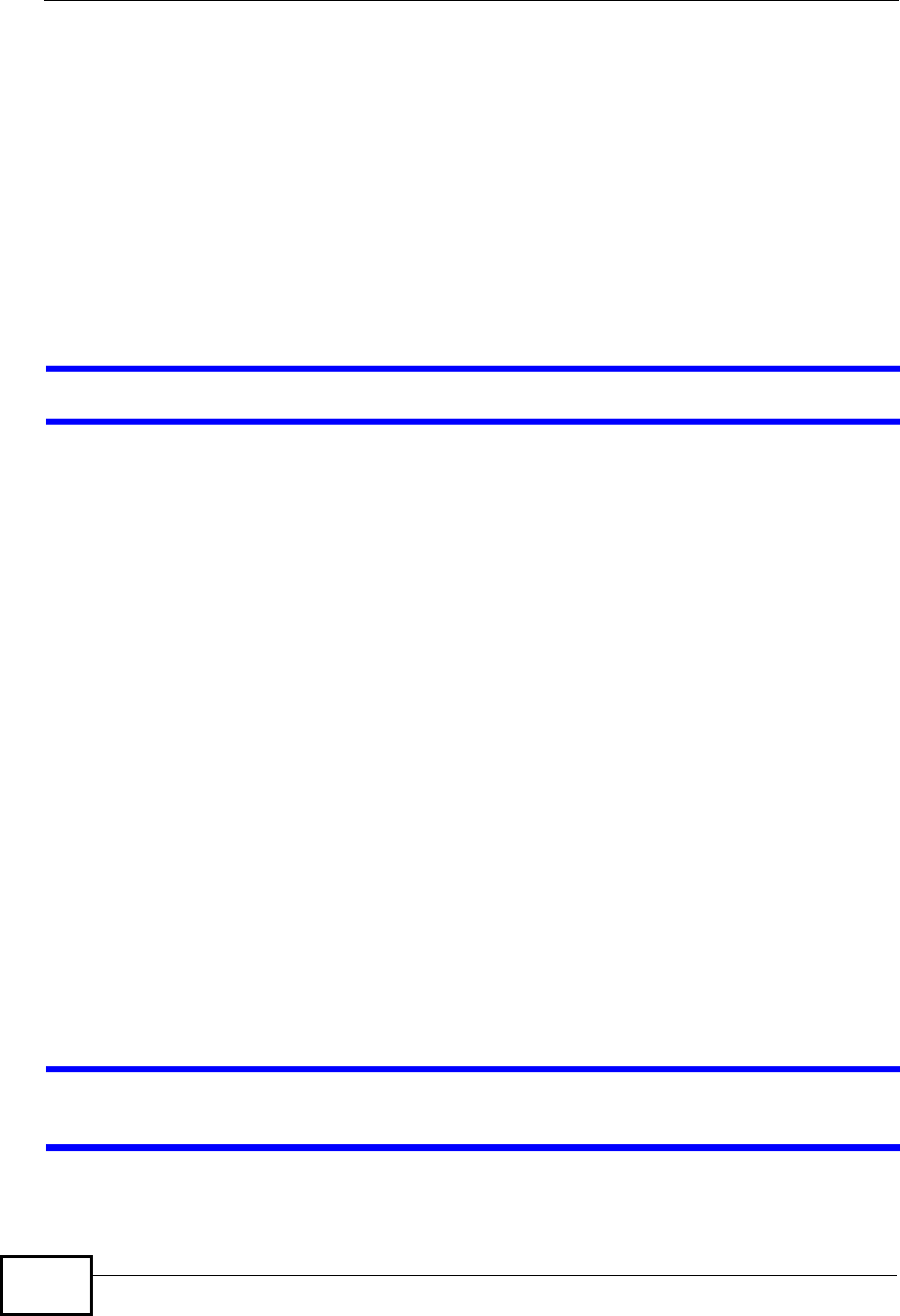
Chapter 26Troubleshooting
NBG4604 User’s Guide
202
2This can happen when you fail to log out properly from your last session. Try
logging in again after 5 minutes.
3Disconnect and re-connect the power adaptor or cord to the NBG4604.
4If this does not work, you have to reset the device to its factory defaults. See
Section 26.4 on page 203.
26.3 Internet Access
I cannot access the Internet.
1Check the hardware connections, and make sure the LEDs are behaving as
expected. See the Quick Start Guide.
2Make sure you entered your ISP account information correctly in the wizard. These
fields are case-sensitive, so make sure [Caps Lock] is not on.
3If you are trying to access the Internet wirelessly, make sure the wireless settings
in the wireless client are the same as the settings in the AP.
•Go to Network > Wireless LAN > General > WDS and check if the NBG4604 is
set to bridge mode. Select Disable and try to connect to the Internet again.
4Disconnect all the cables from your device, and follow the directions in the Quick
Start Guide again.
5Go to Maintenance > Sys OP Mode > General. Check your System Operation Mode
setting.
•Select Router if your device routes traffic between a local network and
another network such as the Internet.
•Select Access Point if your device bridges traffic between clients on the
same network.
6If the problem continues, contact your ISP.
I cannot access the Internet anymore. I had access to the Internet (with the
NBG4604), but my Internet connection is not available anymore.
Company Confidential

Chapter 26Troubleshooting
NBG4604 User’s Guide 203
1Check the hardware connections, and make sure the LEDs are behaving as
expected. See the Quick Start Guide and Section 1.5 on page 22.
2Reboot the NBG4604.
3If the problem continues, contact your ISP.
The Internet connection is slow or intermittent.
1There might be a lot of traffic on the network. Look at the LEDs, and check Section
1.5 on page 22. If the NBG4604 is sending or receiving a lot of information, try
closing some programs that use the Internet, especially peer-to-peer applications.
2Check the signal strength. If the signal strength is low, try moving the NBG4604
closer to the AP if possible, and look around to see if there are any devices that
might be interfering with the wireless network (for example, microwaves, other
wireless networks, and so on).
3Reboot the NBG4604.
4If the problem continues, contact the network administrator or vendor, or try one
of the advanced suggestions.
Advanced Suggestion
•Check the settings for QoS. If it is disabled, you might consider activating it.
26.4 Resetting the NBG4604 to Its Factory
Defaults
If you reset the NBG4604, you lose all of the changes you have made. The
NBG4604 re-loads its default settings, and the password resets to 1234. You have
to make all of your changes again.
You will lose all of your changes when you push the RESET button.
To reset the NBG4604,
1Make sure the power LED is on.
Company Confidential

Chapter 26Troubleshooting
NBG4604 User’s Guide
204
2Press the RESET button for longer than 1 second to restart/reboot the NBG4604.
3Press the RESET button for longer than five seconds to set the NBG4604 back to
its factory-default configurations.
If the NBG4604 restarts automatically, wait for the NBG4604 to finish restarting,
and log in to the Web Configurator. The password is “1234”.
If the NBG4604 does not restart automatically, disconnect and reconnect the
NBG4604’s power. Then, follow the directions above again.
26.5 Wireless Router/AP Troubleshooting
I cannot access the NBG4604 or ping any computer from the WLAN (wireless AP
or router).
1Make sure the wireless LAN is enabled on the NBG4604
2Make sure the wireless adapter on the wireless station is working properly.
3Make sure the wireless adapter installed on your computer is IEEE 802.11
compatible and supports the same wireless standard as the NBG4604.
4Make sure your computer (with a wireless adapter installed) is within the
transmission range of the NBG4604.
5Check that both the NBG4604 and your wireless station are using the same
wireless and wireless security settings.
6Make sure traffic between the WLAN and the LAN is not blocked by the firewall on
the NBG4604.
7Make sure you allow the NBG4604 to be remotely accessed through the WLAN
interface. Check your remote management settings.
•See the chapter on Wireless LAN in the User’s Guide for more information.
to select Router Mode.
I set up URL keyword blocking, but I can still access a website that should be
blocked.
Company Confidential
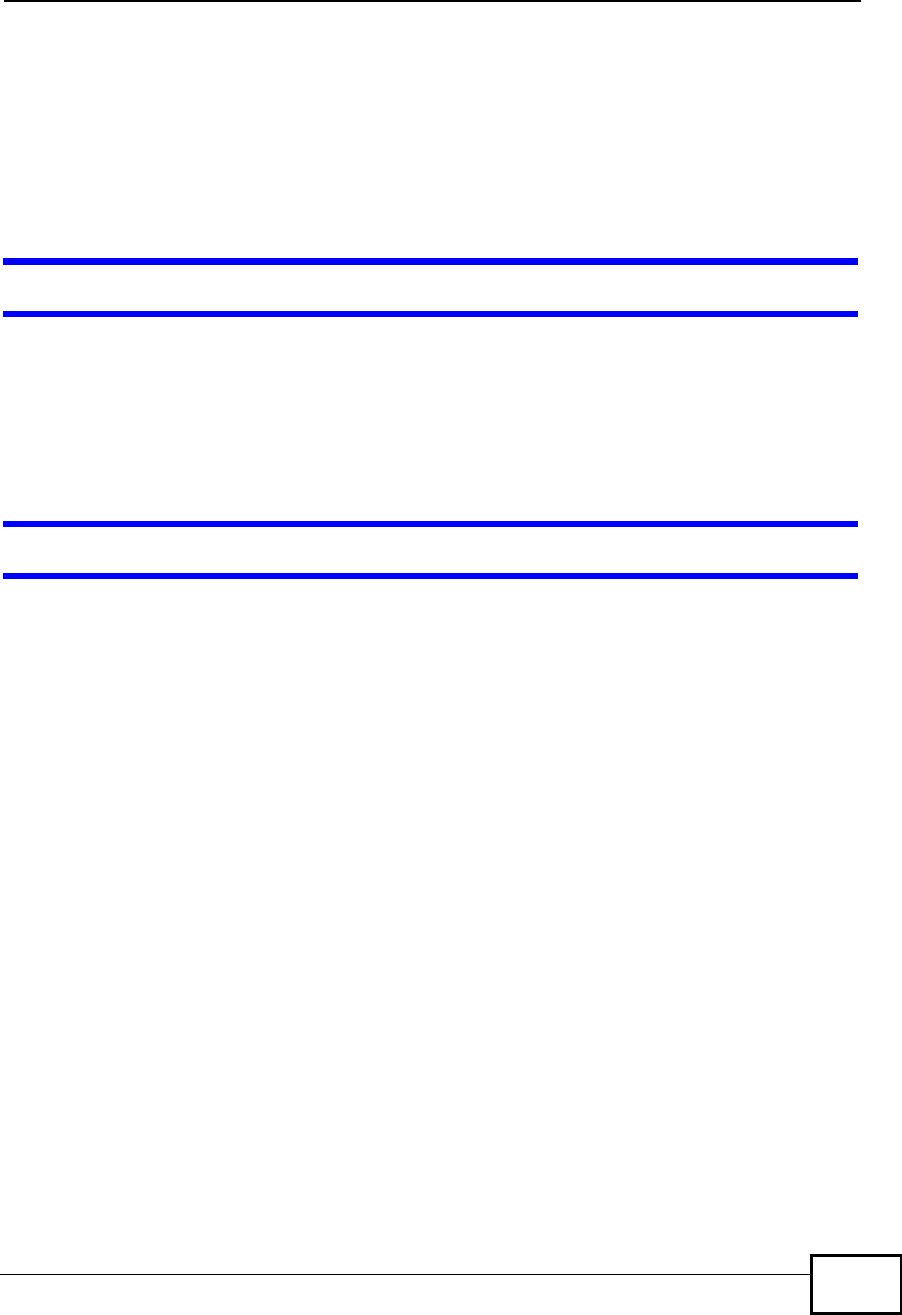
Chapter 26Troubleshooting
NBG4604 User’s Guide 205
Make sure that you select the Enable URL Keyword Blocking check box in the
Content Filtering screen. Make sure that the keywords that you type are listed in
the Keyword List.
If a keyword that is listed in the Keyword List is not blocked when it is found in a
URL, customize the keyword blocking using commands. See the Customizing
Keyword Blocking URL Checking section in the Content Filter chapter.
I can access the Internet, but I cannot open my network folders.
In the Network > LAN > Advancedscreen, make sure Allow between LAN and
WAN is checked. This is not checked by default to keep the LAN secure.
If you still cannot access a network folder, make sure your account has access
rights to the folder you are trying to open.
I can access the Web Configurator after I switched to AP mode.
When you change from router mode to AP mode, your computer must have an IP
address in the range between “192.168.1.3” and “192.168.1.254”.
Refer to Appendix C on page 229 for instructions on how to change your
computer’s IP address.
Company Confidential

Chapter 26Troubleshooting
NBG4604 User’s Guide
206
Company Confidential

NBG4604 User’s Guide 207
CHAPTER 27
Product Specifications
The following tables summarize the NBG4604’s hardware and firmware features.
Table 71 Hardware Features
Dimensions (W x D x
H) 140 mm x 110 mm x 30 mm
Weight 190 g
Power Specification Input: 100~240 AC, 50~60 Hz
Output: 12 V DC 1A
Ethernet portsAuto-negotiating: 10/100/1000 Mbps in either half-duplex or full-
duplex mode.
Auto-crossover: Use either crossover or straight-through Ethernet
cables.
4-5 Port Switch A combination of switch and router makes your NBG4604 a cost-
effective and viable network solution. You can add up to four
computers to the NBG4604 without the cost of a hub when
connecting to the Internet through the WAN port. You can add up
to five computers to the NBG4604 when you connect to the
Internet in AP mode. Add more than four computers to your LAN
by using a hub.
LEDsPWR, LAN1-4, WAN, WLAN, WPS
Reset Button The reset button is built into the rear panel. Use this button to
restore the NBG4604 to its factory default settings. Press for 1
second to restart the device. Press for 5 seconds to restore to
factory default settings.
WPS button Press the WPS on two WPS enabled devices within 120 seconds
for a security-enabled wireless connection.
Antenna The NBG4604 is equipped witha 2dBi (2.4GHz) detachable
antenna to provide clear radio transmission and reception on the
wireless network.
Operation
Environment Temperature: 0º C ~ 40º C / 32ºF ~ 104ºF
Humidity: 20% ~ 90%
Storage Environment Temperature: -30º C ~ 70º C / -22ºF ~ 158ºF
Humidity: 20% ~ 95%
Company Confidential
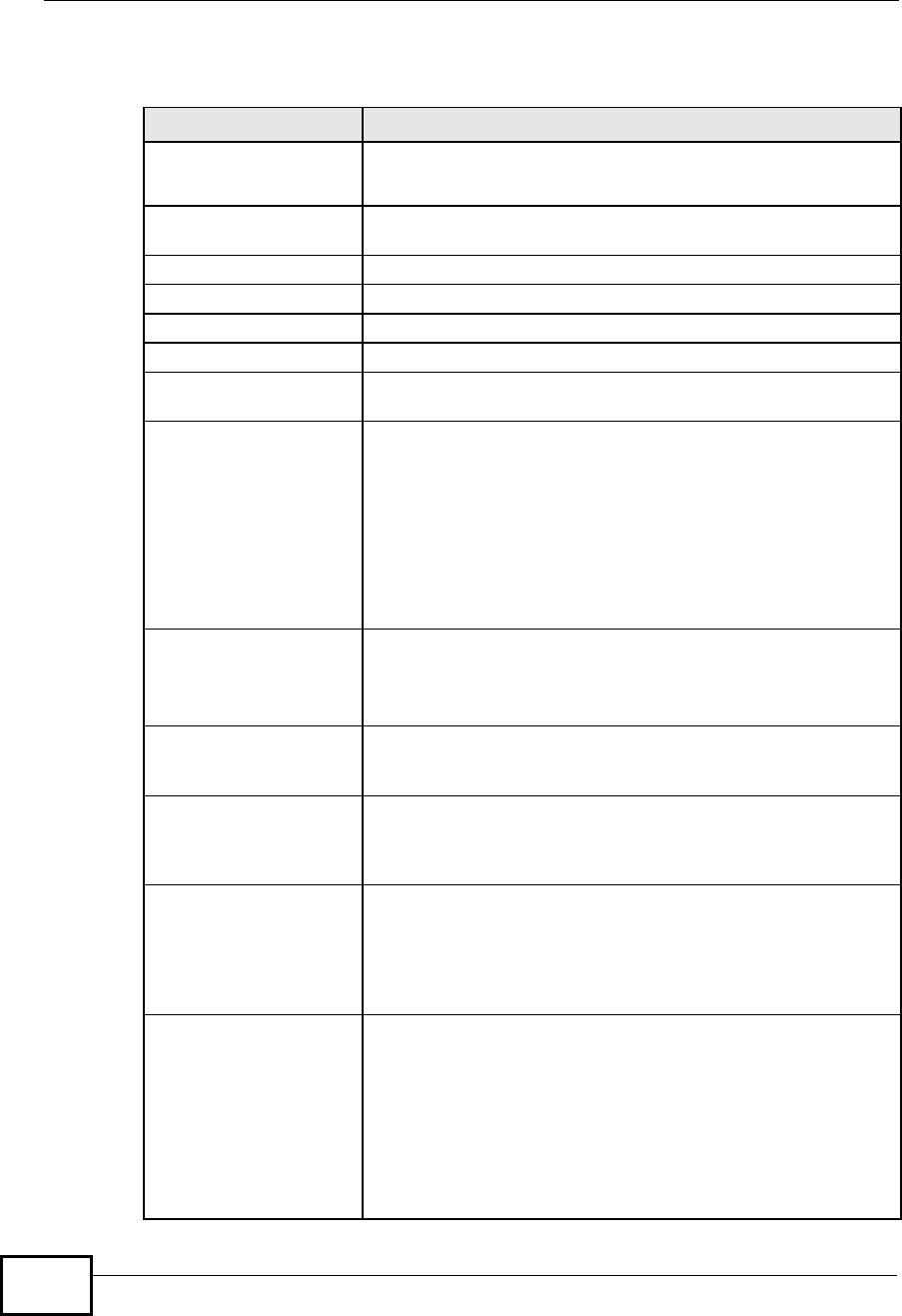
Chapter 27Product Specifications
NBG4604 User’s Guide
208
Table 72 Firmware Features
FEATURE DESCRIPTION
Default LAN IP Address 192.168.1.1 (router)
192.168.1.2. (AP)
Default LAN Subnet
Mask 255.255.255.0 (24 bits)
Default Password 1234
DHCP Pool 192.168.1.33 to 192.168.1.64
Wireless InterfaceWireless LAN
Default Wireless SSIDZyXEL
Device ManagementUse the Web Configurator to easily configure the rich range of
features on the NBG4604.
Wireless FunctionalityAllows IEEE 802.11b and/or IEEE 802.11g wireless clients to
connect to the NBG4604 wirelessly. Enable wireless security (
WPA(2)-PSK) and/or MAC filtering to protect your wireless
network.
Note: The NBG4604 may be prone to RF (Radio
Frequency) interference from other 2.4 GHz devices
such as microwave ovens, wireless phones,
Bluetooth enabled devices, and other wireless LANs.
Firmware UpgradeDownload new firmware (when available) from the ZyXEL web
site and use the Web Configurator to put it on the NBG4604.
Note: Only upload firmware for your specific model!
Configuration Backup &
Restoration Make a copy of the NBG4604’s configuration and put it back on
the NBG4604 later if you decide you want to revert back to an
earlier configuration.
Network Address
Translation (NAT) Each computer on your network must have its own unique IP
address. Use NAT to convert a single public IP address to
multiple private IP addresses forthe computers on your
network.
FirewallYou can configure firewall on the NBG4604 for secure Internet
access. When the firewall is on, by default, all incoming traffic
from the Internet to your network is blocked unless it is
initiated from your network. This means that probes from the
outside to your network are not allowed, but you can safely
browse the Internet and download files for example.
Content FilterThe NBG4604 blocks or allows access to web sites that you
specify and blocks access to web sites with URLs that contain
keywords that you specify. You can define time periods and
days during which content filtering is enabled. You can also
include or exclude particular computers on your network from
content filtering.
You can also subscribe to category-based content filtering that
allows your NBG4604 to check web sites against an external
database.
Company Confidential
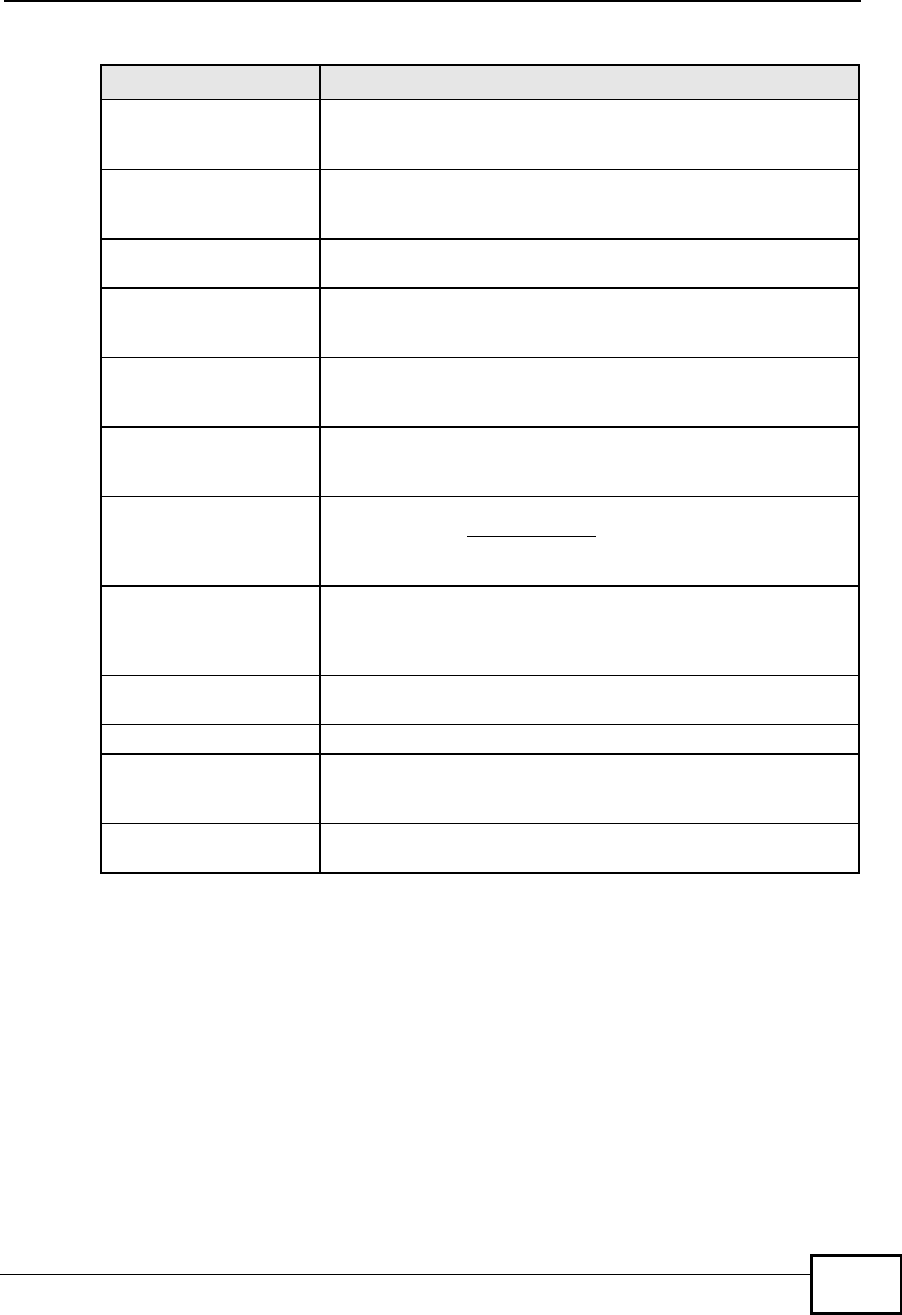
Chapter 27Product Specifications
NBG4604 User’s Guide 209
27.1 Wall-mounting Instructions
Complete the following steps to hang your NBG4604 on a wall.
1Select a position free of obstructions on a sturdy wall.
2Drill two holes for the screws.
Be careful to avoid damaging pipes or cables located inside the
wall when drilling holes for the screws.
Bandwidth Management You can efficiently manage traffic on your network by reserving
bandwidth and giving priority to certain types of traffic and/or
to particular computers.
Remote ManagementThis allows you to decide whether a service (HTTP or FTP traffic
for example) from a computer on a network (LAN or WAN for
example) can access the NBG4604.
Wireless LAN SchedulerYou can schedule the times the Wireless LAN is enabled/
disabled.
Time and DateGet the current time and date from an external server when
you turn on your NBG4604. You can also set the time manually.
These dates and times are then used in logs.
Port ForwardingIf you have a server (mail or web server for example) on your
network, then use this feature to let people access it from the
Internet.
DHCP (Dynamic Host
Configuration Protocol) Use this feature to have the NBG4604 assign IP addresses, an
IP default gateway and DNS servers to computers on your
network.
Dynamic DNS SupportWith Dynamic DNS (Domain Name System) support, you can
use a fixed URL, www.zyxel.com for example, with a dynamic
IP address. You must register for this service with a Dynamic
DNS service provider.
IP MulticastIP Multicast is used to send traffic to a specific group of
computers. The NBG4604 supports versions 1 and 2 of IGMP
(Internet Group Management Protocol) used to join multicast
groups (see RFC 2236).
LoggingUse logs for troubleshooting. You can view logs in the Web
Configurator.
PPPoEPPPoE mimics a dial-up Internet access connection.
PPTP EncapsulationPoint-to-Point Tunneling Protocol (PPTP) enables secure
transfer of data through a Virtual Private Network (VPN). The
NBG4604 supports one PPTP connection at a time.
Universal Plug and Play
(UPnP) The NBG4604 can communicate with other UPnP enabled
devices in a network.
Table 72 Firmware Features
FEATURE DESCRIPTION
Company Confidential
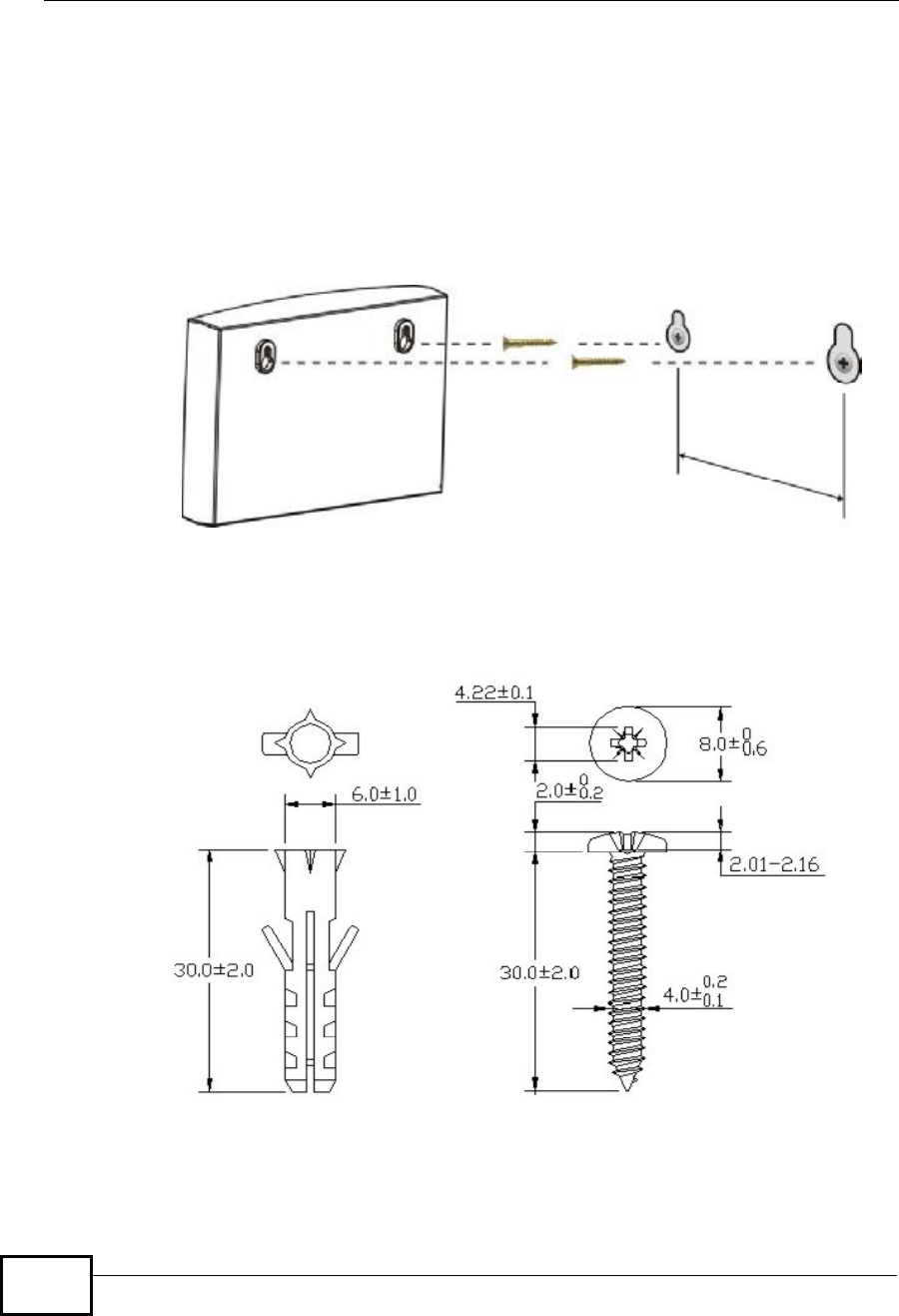
Chapter 27Product Specifications
NBG4604 User’s Guide
210
3Do not insert the screws all the way into the wall. Leave a small gap of about 0.5
cm between the heads of the screws and the wall.
4Make sure the screws are snugly fastened to the wall. They need to hold the
weight of the NBG4604 with the connection cables.
5Align the holes on the back of the NBG4604 with the screws on the wall. Hang the
NBG4604 on the screws.
Figure 121 Wall-mounting Example
The following are dimensions of an M4 tap screw and masonry plug used for wall
mounting. All measurements are in millimeters (mm).
Figure 122 Masonry Plug and M4 Tap Screw
Company Confidential

NBG4604 User’s Guide 211
APPENDIX A
IP Addresses and Subnetting
This appendix introduces IP addresses and subnet masks.
IP addresses identify individual devices on a network. Every networking device
(including computers, servers, routers, printers, etc.) needs an IP address to
communicate across the network. These networking devices are also known as
hosts.
Subnet masks determine the maximum number of possible hosts on a network.
You can also use subnet masks to divide one network into multiple sub-networks.
Introduction to IP Addresses
One part of the IP address is the network number, and the other part is the host
ID. In the same way that houses on a street share a common street name, the
hosts on a network share a common network number. Similarly, as each house
has its own house number, each host on the network has its own unique
identifying number - the host ID. Routers use the network number to send packets
to the correct network, while the host ID determines to which host on the network
the packets are delivered.
Structure
An IP address is made up of four parts, written in dotted decimal notation (for
example, 192.168.1.1). Each of these four parts is known as an octet. An octet is
an eight-digit binary number (for example 11000000, which is 192 in decimal
notation).
Therefore, each octet has a possible range of 00000000 to 11111111 in binary, or
0 to 255 in decimal.
Company Confidential
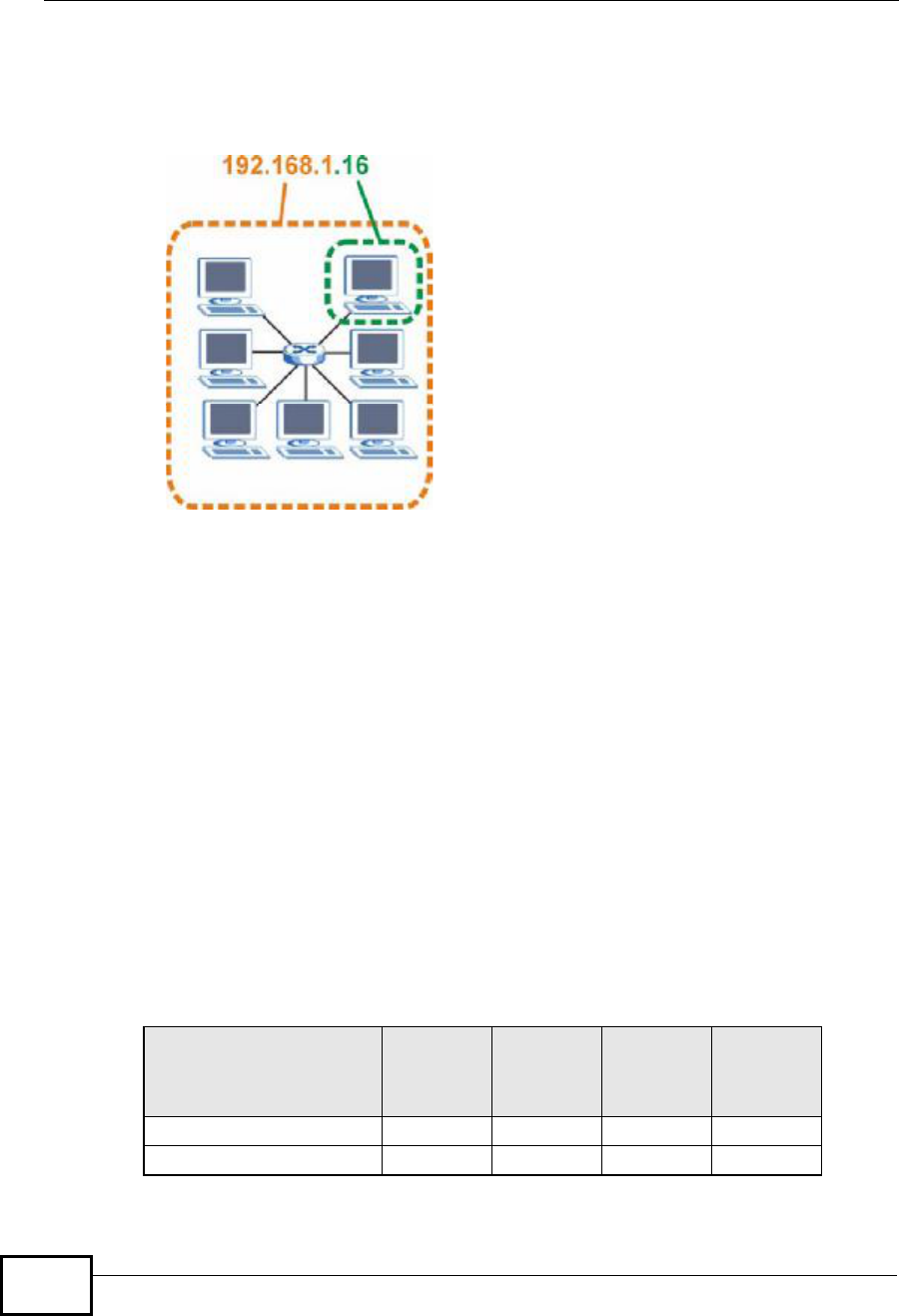
Appendix AIP Addresses and Subnetting
NBG4604 User’s Guide
212
The following figure shows an example IP address in which the first three octets
(192.168.1) are the network number, and the fourth octet (16) is the host ID.
Figure 123 Network Number and Host ID
How much of the IP address is the network number and how much is the host ID
varies according to the subnet mask.
Subnet Masks
A subnet mask is used to determine which bits are part of the network number,
and which bits are part of the host ID (using a logical AND operation). The term
“subnet” is short for “sub-network”.
A subnet mask has 32 bits. If a bit in the subnet mask is a “1” then the
corresponding bit in the IP address is part of the network number. If a bit in the
subnet mask is “0” then the corresponding bit in the IP address is part of the host
ID.
The following example shows a subnet mask identifying the network number (in
bold text) and host ID of an IP address (192.168.1.2 in decimal).
Table 73 Subnet Mask - Identifying Network Number
1ST
OCTET:
(192)
2ND
OCTET:
(168)
3RD
OCTET:
(1)
4TH
OCTET
(2)
IP Address (Binary)11000000101010000000000100000010
Subnet Mask (Binary) 111111111111111111111111 00000000
Company Confidential
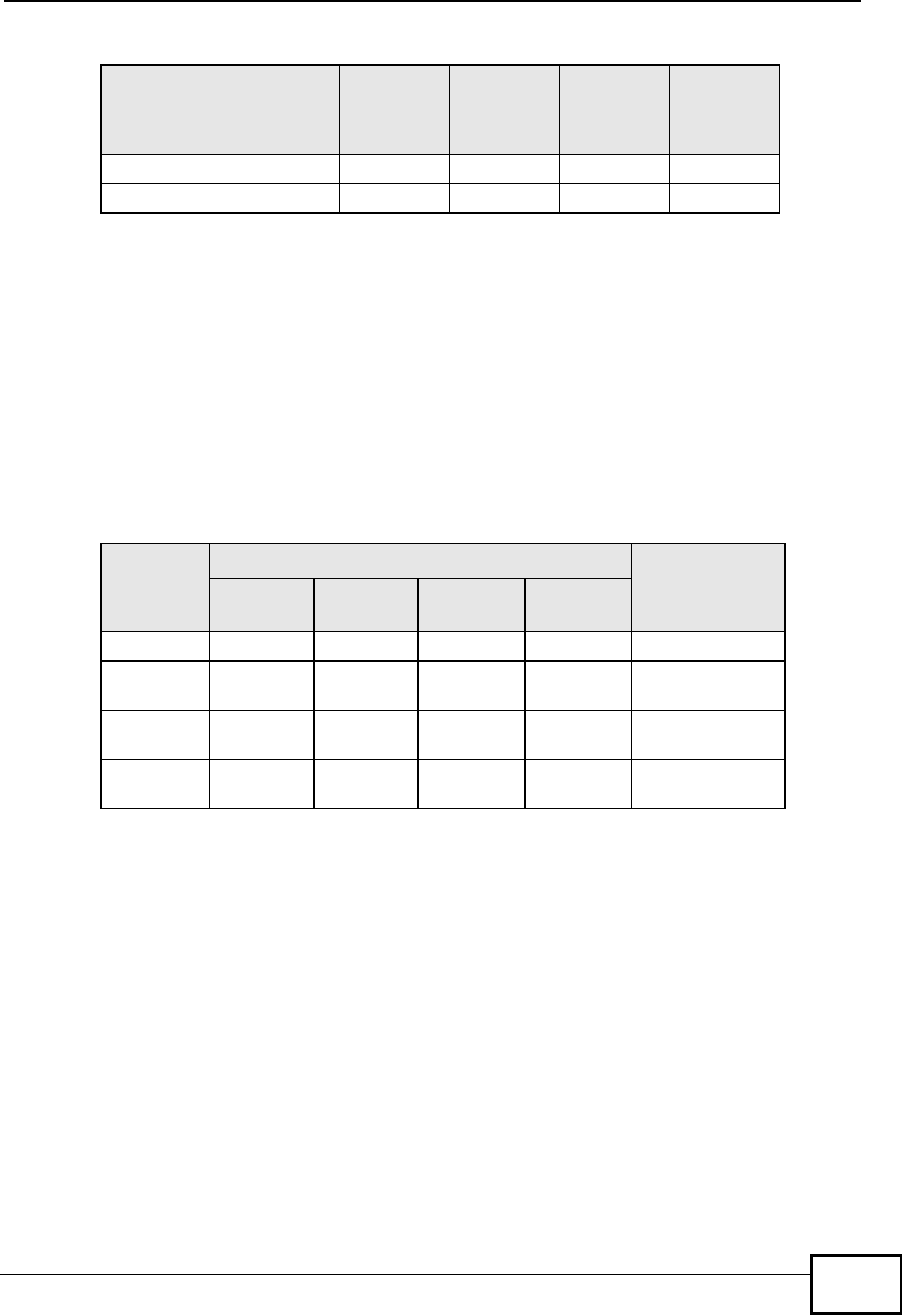
Appendix AIP Addresses and Subnetting
NBG4604 User’s Guide 213
By convention, subnet masks always consist of a continuous sequence of ones
beginning from the leftmost bit of the mask, followed by a continuous sequence of
zeros, for a total number of 32 bits.
Subnet masks can be referred to by the size of the network number part (the bits
with a “1” value). For example, an “8-bit mask” means that the first 8 bits of the
mask are ones and the remaining 24 bits are zeroes.
Subnet masks are expressed in dotted decimal notation just like IP addresses. The
following examples show the binary and decimal notation for 8-bit, 16-bit, 24-bit
and 29-bit subnet masks.
Network Size
The size of the network number determines the maximum number of possible
hosts you can have on your network. The larger the number of network number
bits, the smaller the number of remaining host ID bits.
An IP address with host IDs of all zeros is the IP address of the network
(192.168.1.0 with a 24-bit subnet mask, for example). An IP address with host
IDs of all ones is the broadcast address for that network (192.168.1.255 with a
24-bit subnet mask, for example).
Network Number 110000001010100000000001
Host ID00000010
Table 74 Subnet Masks
BINARY
DECIMAL
1ST
OCTET 2ND
OCTET 3RD
OCTET 4TH
OCTET
8-bit mask 11111111 00000000 00000000 00000000 255.0.0.0
16-bit
mask 11111111 11111111 00000000 00000000 255.255.0.0
24-bit
mask 11111111 11111111 11111111 00000000 255.255.255.0
29-bit
mask 11111111 11111111 11111111 11111000 255.255.255.24
8
Table 73 Subnet Mask - Identifying Network Number
1ST
OCTET:
(192)
2ND
OCTET:
(168)
3RD
OCTET:
(1)
4TH
OCTET
(2)
Company Confidential
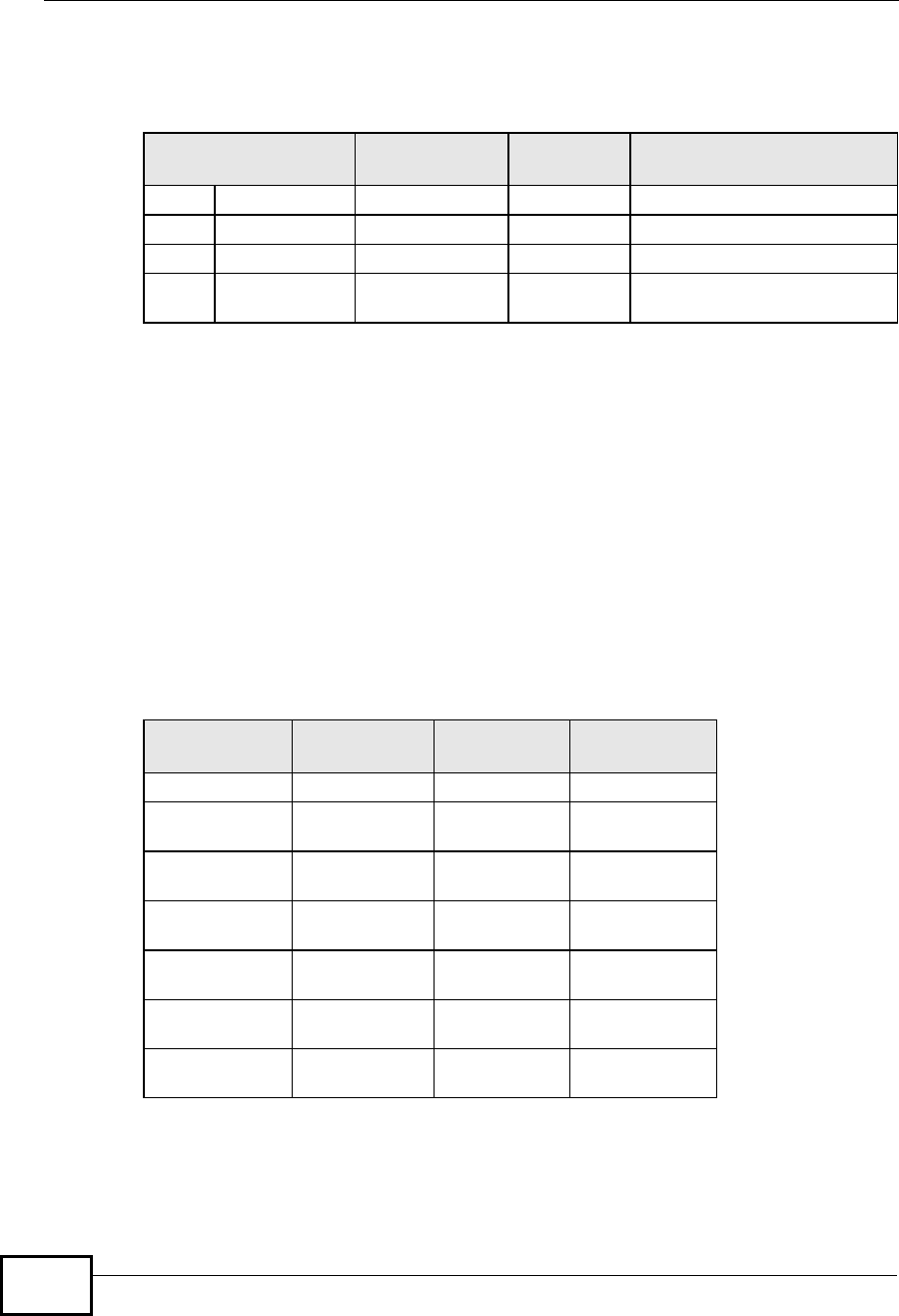
Appendix AIP Addresses and Subnetting
NBG4604 User’s Guide
214
As these two IP addresses cannot be used for individual hosts, calculate the
maximum number of possible hosts in a network as follows:
Notation
Since the mask is always a continuous number of ones beginning from the left,
followed by a continuous number of zeros for the remainder of the 32 bit mask,
you can simply specify the number of ones instead of writing the value of each
octet. This is usually specified by writing a “/” followed by the number of bits in
the mask after the address.
For example, 192.1.1.0 /25 is equivalent to saying 192.1.1.0 with subnet mask
255.255.255.128.
The following table shows some possible subnet masks using both notations.
Table 75 Maximum Host Numbers
SUBNET MASK HOST ID SIZE MAXIMUM NUMBER OF
HOSTS
8 bits255.0.0.024 bits2
24 – 216777214
16 bits255.255.0.016 bits2
16 – 265534
24 bits255.255.255.08 bits2
8
– 2254
29 bits255.255.255.2
48 3 bits2
3
– 26
Table 76 Alternative Subnet Mask Notation
SUBNET
MASK ALTERNATIVE
NOTATION LAST OCTET
(BINARY) LAST OCTET
(DECIMAL)
255.255.255.0 /24 0000 0000 0
255.255.255.12
8/25 1000 0000 128
255.255.255.19
2/26 1100 0000 192
255.255.255.22
4/27 1110 0000 224
255.255.255.24
0/28 1111 0000 240
255.255.255.24
8/29 1111 1000 248
255.255.255.25
2/30 1111 1100 252
Company Confidential
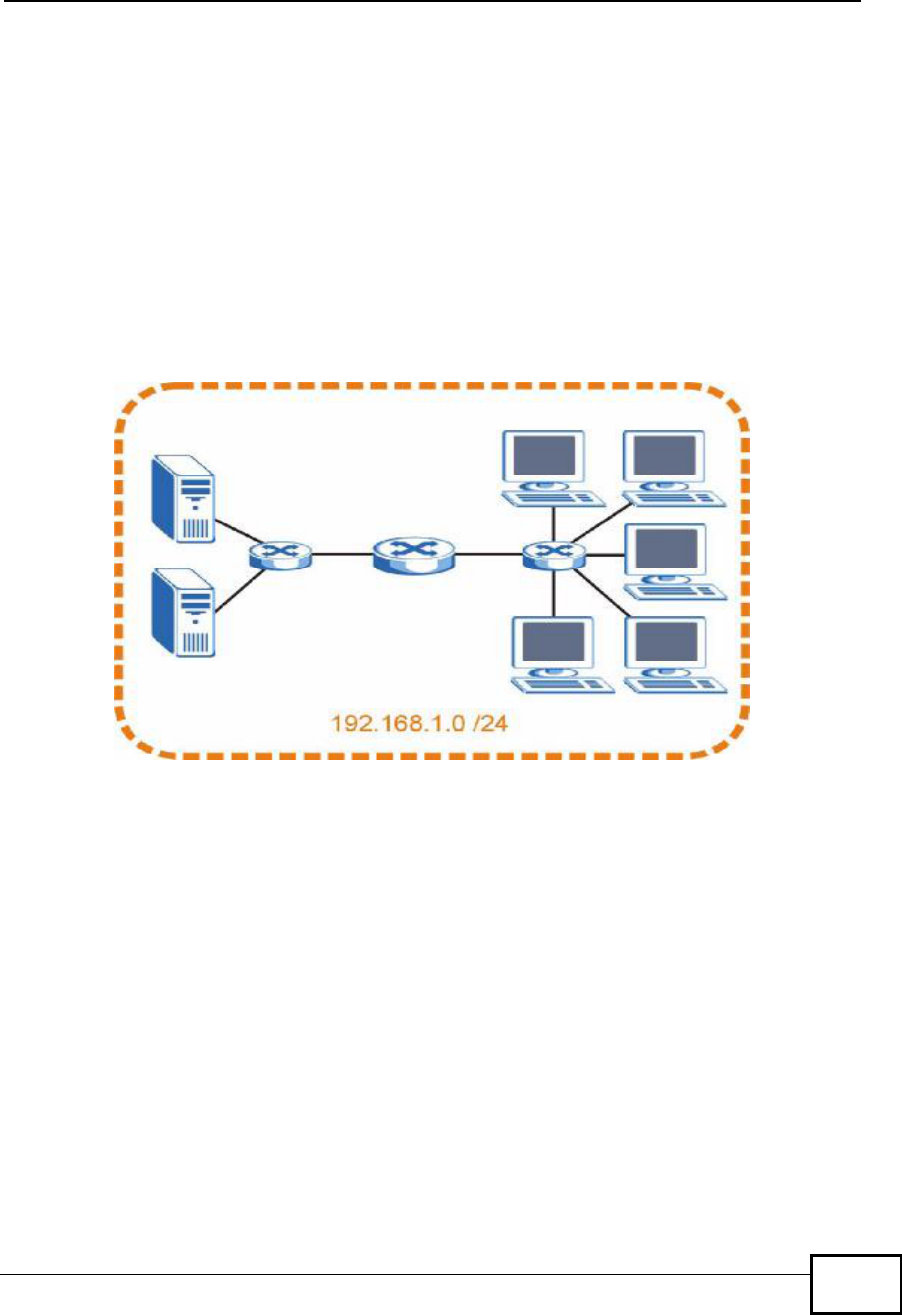
Appendix AIP Addresses and Subnetting
NBG4604 User’s Guide 215
Subnetting
You can use subnetting to divide one network into multiple sub-networks. In the
following example a network administrator creates two sub-networks to isolate a
group of servers from the rest of the company network for security reasons.
In this example, the company network address is 192.168.1.0. The first three
octets of the address (192.168.1) are the network number, and the remaining
octet is the host ID, allowing a maximum of 28 – 2 or 254 possible hosts.
The following figure shows the company network before subnetting.
Figure 124 Subnetting Example: Before Subnetting
You can “borrow” one of the host ID bits to divide the network 192.168.1.0 into
two separate sub-networks. The subnet mask is now 25 bits (255.255.255.128 or
/25).
The “borrowed” host ID bit can have a value of either 0 or 1, allowing two
subnets; 192.168.1.0 /25 and 192.168.1.128 /25.
Company Confidential
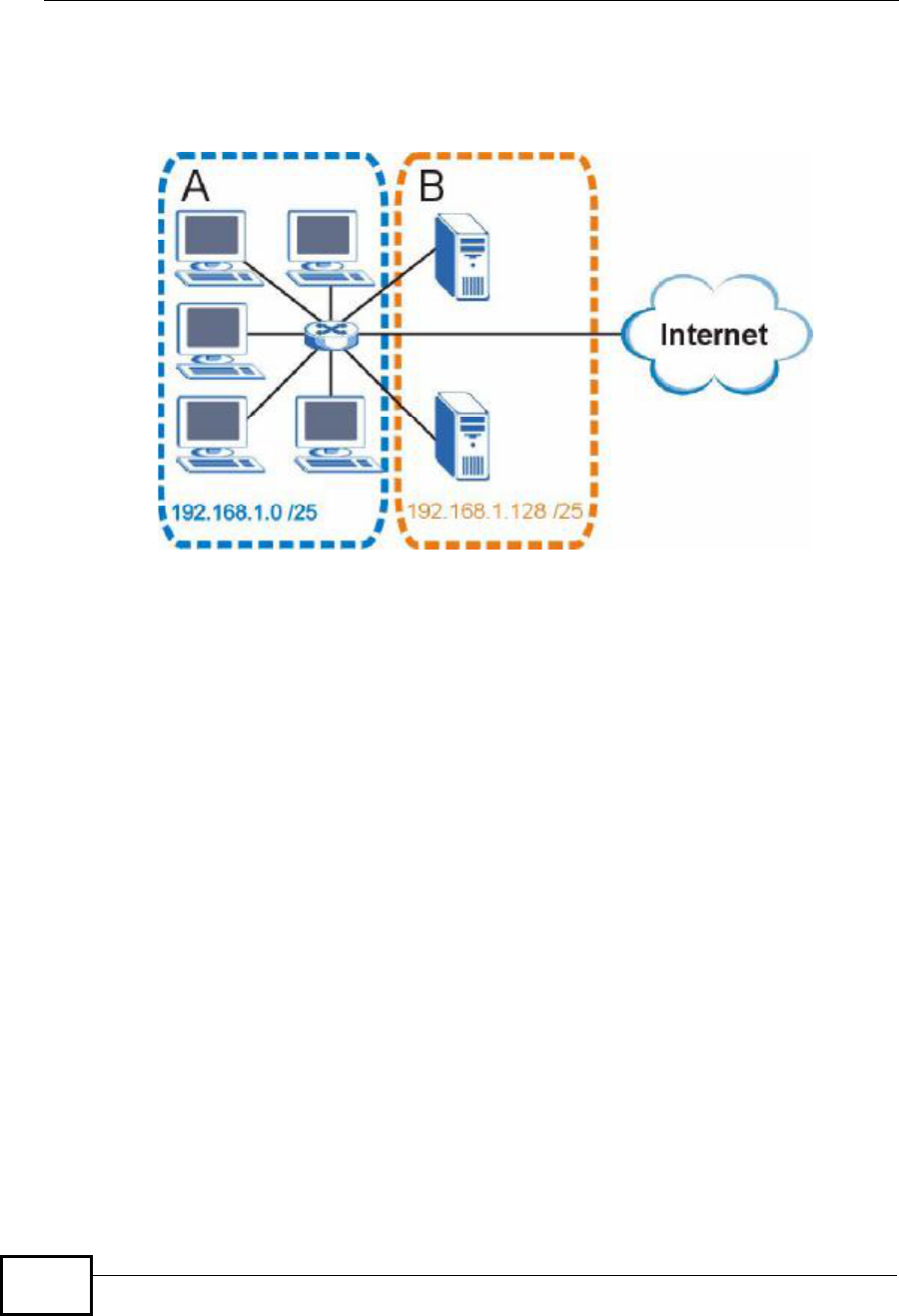
Appendix AIP Addresses and Subnetting
NBG4604 User’s Guide
216
The following figure shows the company network after subnetting. There are now
two sub-networks, A and B.
Figure 125 Subnetting Example: After Subnetting
In a 25-bit subnet the host ID has 7 bits, so each sub-network has a maximum of
27 – 2 or 126 possible hosts (a host ID of all zeroes is the subnet’s address itself,
all ones is the subnet’s broadcast address).
192.168.1.0 with mask 255.255.255.128 is subnet A itself, and 192.168.1.127
with mask 255.255.255.128 is its broadcast address. Therefore, the lowest IP
address that can be assigned to an actual host for subnet A is 192.168.1.1 and
the highest is 192.168.1.126.
Similarly, the host ID range for subnet B is 192.168.1.129 to 192.168.1.254.
Example: Four Subnets
The previous example illustrated using a 25-bit subnet mask to divide a 24-bit
address into two subnets. Similarly, to divide a 24-bit address into four subnets,
you need to “borrow” two host ID bits to give four possible combinations (00, 01,
10 and 11). The subnet mask is 26 bits
(11111111.11111111.11111111.11000000) or 255.255.255.192.
Company Confidential
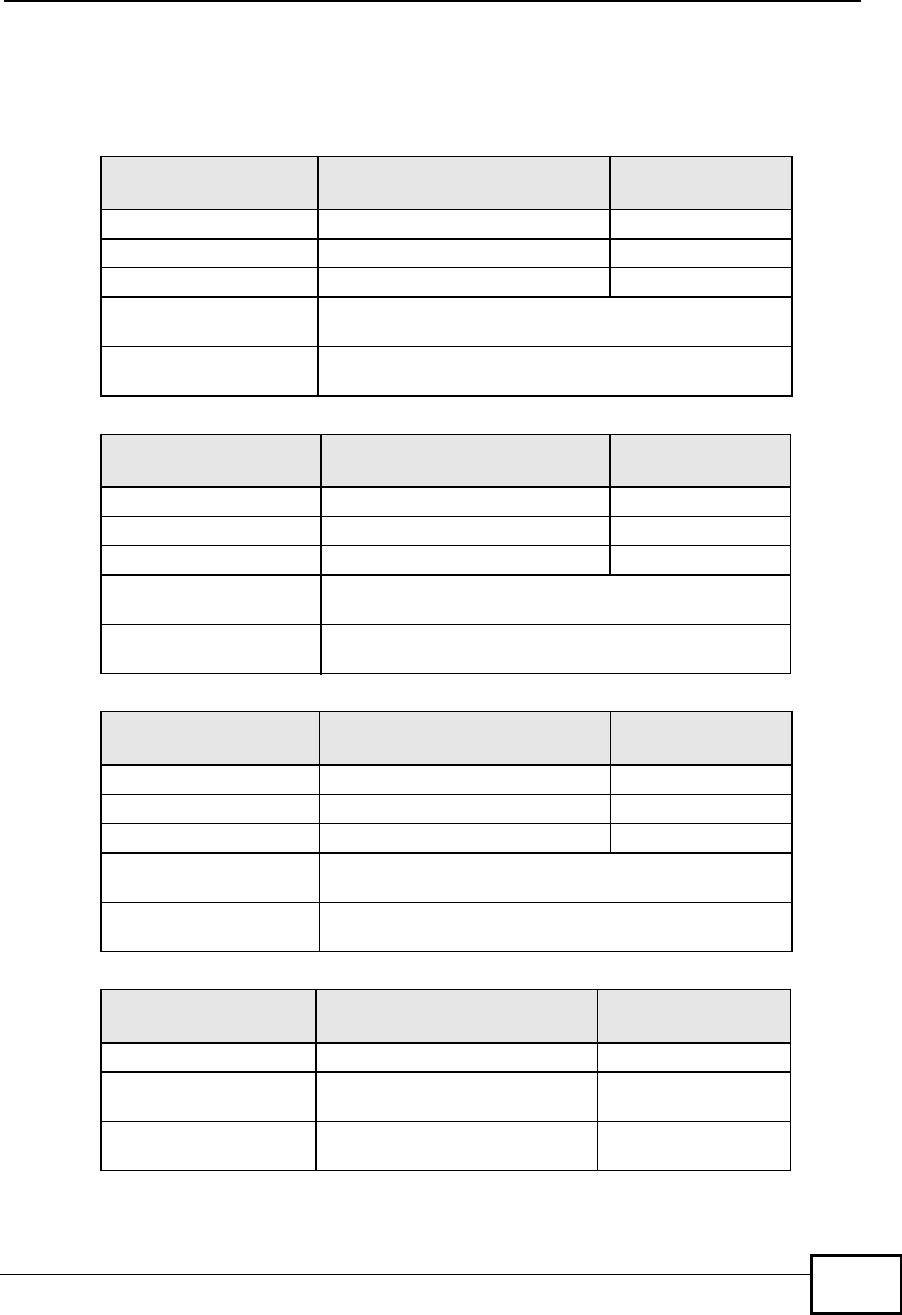
Appendix AIP Addresses and Subnetting
NBG4604 User’s Guide 217
Each subnet contains 6 host ID bits, giving 26 - 2 or 62 hosts for each subnet (a
host ID of all zeroes is the subnet itself, all ones is the subnet’s broadcast
address).
Table 77 Subnet 1
IP/SUBNET MASK NETWORK NUMBER LAST OCTET BIT
VALUE
IP Address (Decimal) 192.168.1. 0
IP Address (Binary) 11000000.10101000.00000001. 00000000
Subnet Mask (Binary) 11111111.11111111.11111111. 11000000
Subnet Address:
192.168.1.0 Lowest Host ID: 192.168.1.1
Broadcast Address:
192.168.1.63 Highest Host ID: 192.168.1.62
Table 78 Subnet 2
IP/SUBNET MASK NETWORK NUMBER LAST OCTET BIT
VALUE
IP Address 192.168.1. 64
IP Address (Binary) 11000000.10101000.00000001. 01000000
Subnet Mask (Binary) 11111111.11111111.11111111. 11000000
Subnet Address:
192.168.1.64 Lowest Host ID: 192.168.1.65
Broadcast Address:
192.168.1.127 Highest Host ID: 192.168.1.126
Table 79 Subnet 3
IP/SUBNET MASK NETWORK NUMBER LAST OCTET BIT
VALUE
IP Address 192.168.1. 128
IP Address (Binary) 11000000.10101000.00000001. 10000000
Subnet Mask (Binary) 11111111.11111111.11111111. 11000000
Subnet Address:
192.168.1.128 Lowest Host ID: 192.168.1.129
Broadcast Address:
192.168.1.191 Highest Host ID: 192.168.1.190
Table 80 Subnet 4
IP/SUBNET MASK NETWORK NUMBER LAST OCTET BIT
VALUE
IP Address 192.168.1. 192
IP Address (Binary) 11000000.10101000.00000001
.11000000
Subnet Mask (Binary) 11111111.11111111.11111111
.11000000
Company Confidential
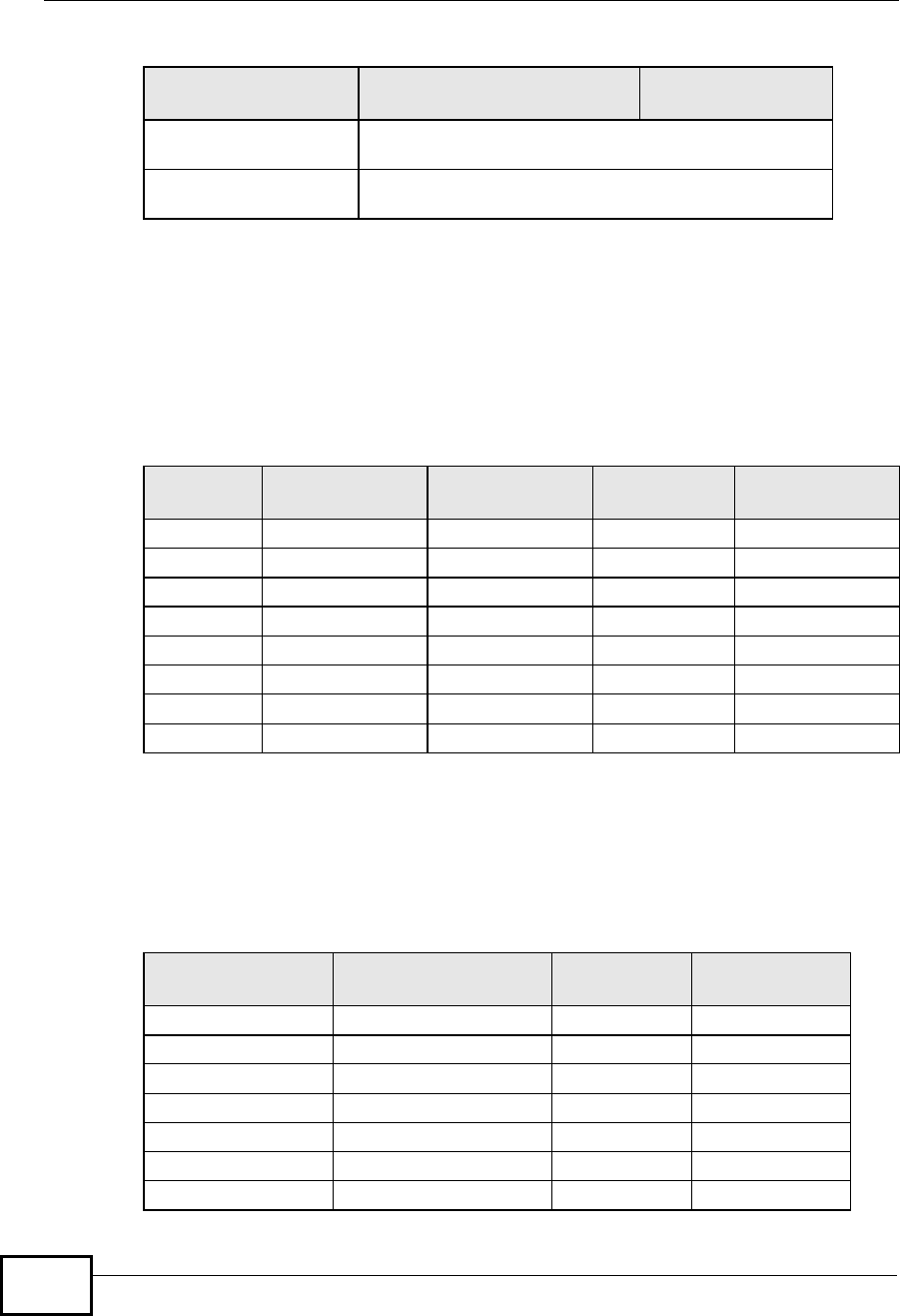
Appendix AIP Addresses and Subnetting
NBG4604 User’s Guide
218
Example: Eight Subnets
Similarly, use a 27-bit mask to create eight subnets (000, 001, 010, 011, 100,
101, 110 and 111).
The following table shows IP address last octet values for each subnet.
Subnet Planning
The following table is a summary for subnet planning on a network with a 24-bit
network number.
Subnet Address:
192.168.1.192 Lowest Host ID: 192.168.1.193
Broadcast Address:
192.168.1.255 Highest Host ID: 192.168.1.254
Table 80 Subnet 4 (continued)
IP/SUBNET MASK NETWORK NUMBER LAST OCTET BIT
VALUE
Table 81 Eight Subnets
SUBNET SUBNET
ADDRESS FIRST ADDRESS LAST
ADDRESS BROADCAST
ADDRESS
10130 31
2 32 33 62 63
3 64 65 94 95
4 96 97 126 127
5 128 129 158 159
6 160 161 190 191
7 192 193 222 223
8 224 225 254 255
Table 82 24-bit Network Number Subnet Planning
NO. “BORROWED”
HOST BITS SUBNET MASK NO. SUBNETS NO. HOSTS PER
SUBNET
1255.255.255.128 (/25) 2 126
2 255.255.255.192 (/26) 4 62
3 255.255.255.224 (/27) 8 30
4 255.255.255.240 (/28) 16 14
5 255.255.255.248 (/29) 32 6
6 255.255.255.252 (/30) 64 2
7 255.255.255.254 (/31) 128 1
Company Confidential
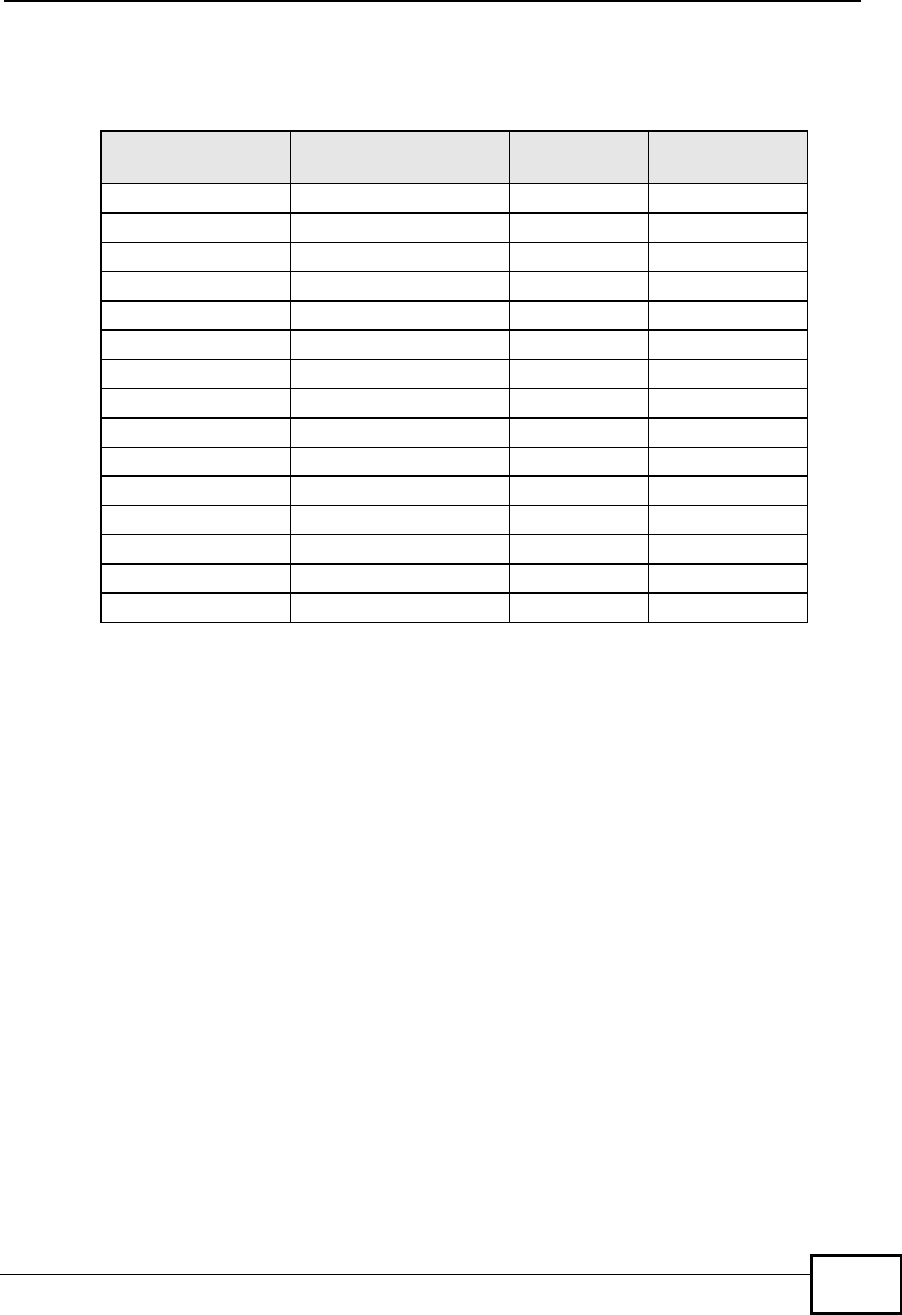
Appendix AIP Addresses and Subnetting
NBG4604 User’s Guide 219
The following table is a summary for subnet planning on a network with a 16-bit
network number.
Configuring IP Addresses
Where you obtain your network number depends on your particular situation. If
the ISP or your network administrator assigns you a block of registered IP
addresses, follow their instructions in selecting the IP addresses and the subnet
mask.
If the ISP did not explicitly give you an IP network number, then most likely you
have a single user account and the ISP will assign you a dynamic IP address when
the connection is established. If this is the case, it is recommended that you select
a network number from 192.168.0.0 to 192.168.255.0. The Internet Assigned
Number Authority (IANA) reserved this block of addresses specifically for private
use; please do not use any other number unless you are told otherwise. You must
also enable Network Address Translation (NAT) on the NBG4604.
Once you have decided on the network number, pick an IP address for your
NBG4604 that is easy to remember (for instance, 192.168.1.1) but make sure
that no other device on your network is using that IP address.
The subnet mask specifies the network number portion of an IP address. Your
NBG4604 will compute the subnet mask automatically based on the IP address
Table 83 16-bit Network Number Subnet Planning
NO. “BORROWED”
HOST BITS SUBNET MASK NO. SUBNETS NO. HOSTS PER
SUBNET
1255.255.128.0 (/17) 2 32766
2 255.255.192.0 (/18) 4 16382
3 255.255.224.0 (/19) 8 8190
4255.255.240.0 (/20) 16 4094
5255.255.248.0 (/21) 32 2046
6255.255.252.0 (/22) 64 1022
7255.255.254.0 (/23) 128 510
8 255.255.255.0 (/24) 256 254
9 255.255.255.128 (/25) 512 126
10 255.255.255.192 (/26) 1024 62
11 255.255.255.224 (/27) 2048 30
12 255.255.255.240 (/28) 4096 14
13 255.255.255.248 (/29) 8192 6
14 255.255.255.252 (/30) 16384 2
15 255.255.255.254 (/31) 32768 1
Company Confidential

Appendix AIP Addresses and Subnetting
NBG4604 User’s Guide
220
that you entered. You don't need to change the subnet mask computed by the
NBG4604 unless you are instructed to do otherwise.
Private IP Addresses
Every machine on the Internet must have a unique address. If your networks are
isolated from the Internet (running only between two branch offices, for example)
you can assign any IP addresses to the hosts without problems. However, the
Internet Assigned Numbers Authority (IANA) has reserved the following three
blocks of IP addresses specifically for private networks:
•10.0.0.0 — 10.255.255.255
•172.16.0.0 — 172.31.255.255
•192.168.0.0 — 192.168.255.255
You can obtain your IP address from the IANA, from an ISP, or it can be assigned
from a private network. If you belong to a small organization and your Internet
access is through an ISP, the ISP can provide you with the Internet addresses for
your local networks. On the other hand, if you are part of a much larger
organization, you should consult your network administrator for the appropriate IP
addresses.
Regardless of your particular situation, do not create an arbitrary IP address;
always follow the guidelines above. For more information on address assignment,
please refer to RFC 1597, Address Allocation for Private Internets and RFC 1466,
Guidelines for Management of IP Address Space.
Company Confidential
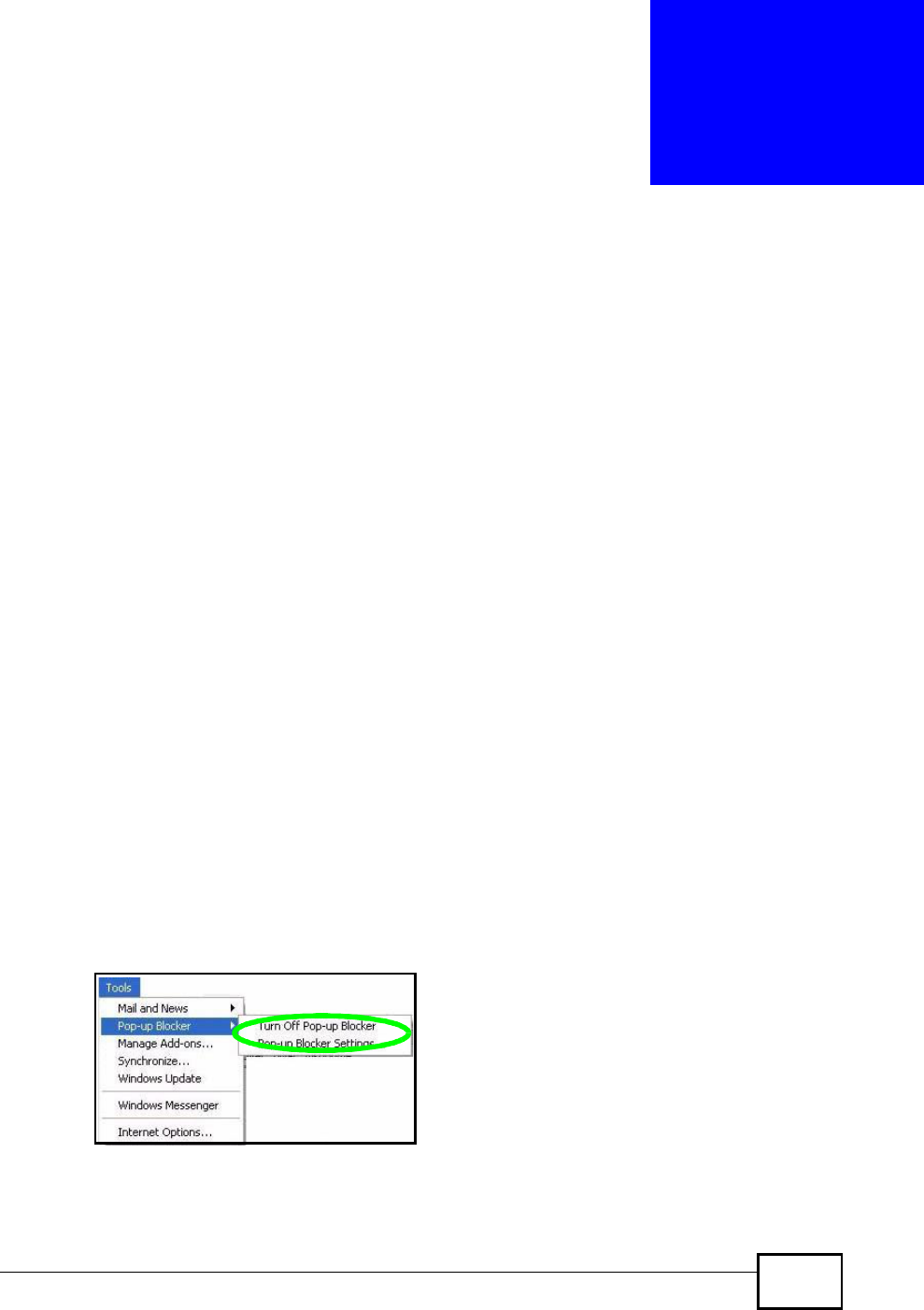
NBG4604 User’s Guide 221
APPENDIX B
Pop-up Windows, JavaScript
and Java Permissions
In order to use the Web Configurator you need to allow:
•Web browser pop-up windows from your device.
•JavaScript (enabled by default).
•Java permissions (enabled by default).
Note: Internet Explorer 6 screens are used here. Screens for other Internet Explorer
versions may vary.
Internet Explorer Pop-up Blockers
You may have to disable pop-up blocking to log into your device.
Either disable pop-up blocking (enabled by default in Windows XP SP (Service
Pack) 2) or allow pop-up blocking and create an exception for your device’s IP
address.
Disable pop-up Blockers
1In Internet Explorer, select Tools,Pop-up Blocker and then select Turn Off
Pop-up Blocker.
Figure 126 Pop-up Blocker
You can also check if pop-up blocking is disabled in the Pop-up Blocker section in
the Privacy tab.
Company Confidential
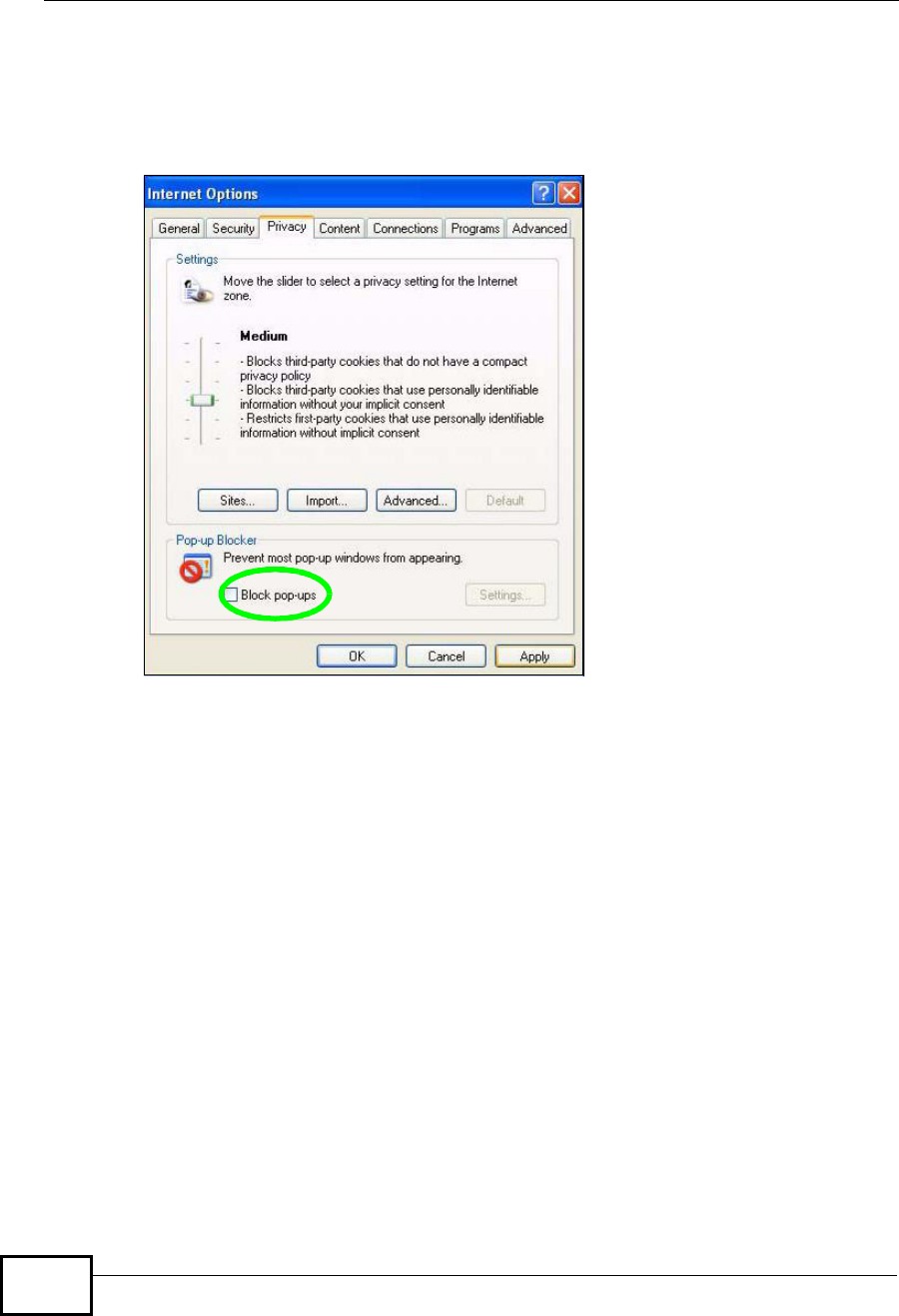
Appendix BPop-up Windows, JavaScript and Java Permissions
NBG4604 User’s Guide
222
1In Internet Explorer, select Tools,Internet Options,Privacy.
2Clear the Block pop-ups check box in the Pop-up Blocker section of the screen.
This disables any web pop-up blockers you may have enabled.
Figure 127 Internet Options: Privacy
3Click Apply to save this setting.
Enable pop-up Blockers with Exceptions
Alternatively, if you only want to allow pop-up windows from your device, see the
following steps.
1In Internet Explorer, select Tools,Internet Options and then the Privacy tab.
Company Confidential
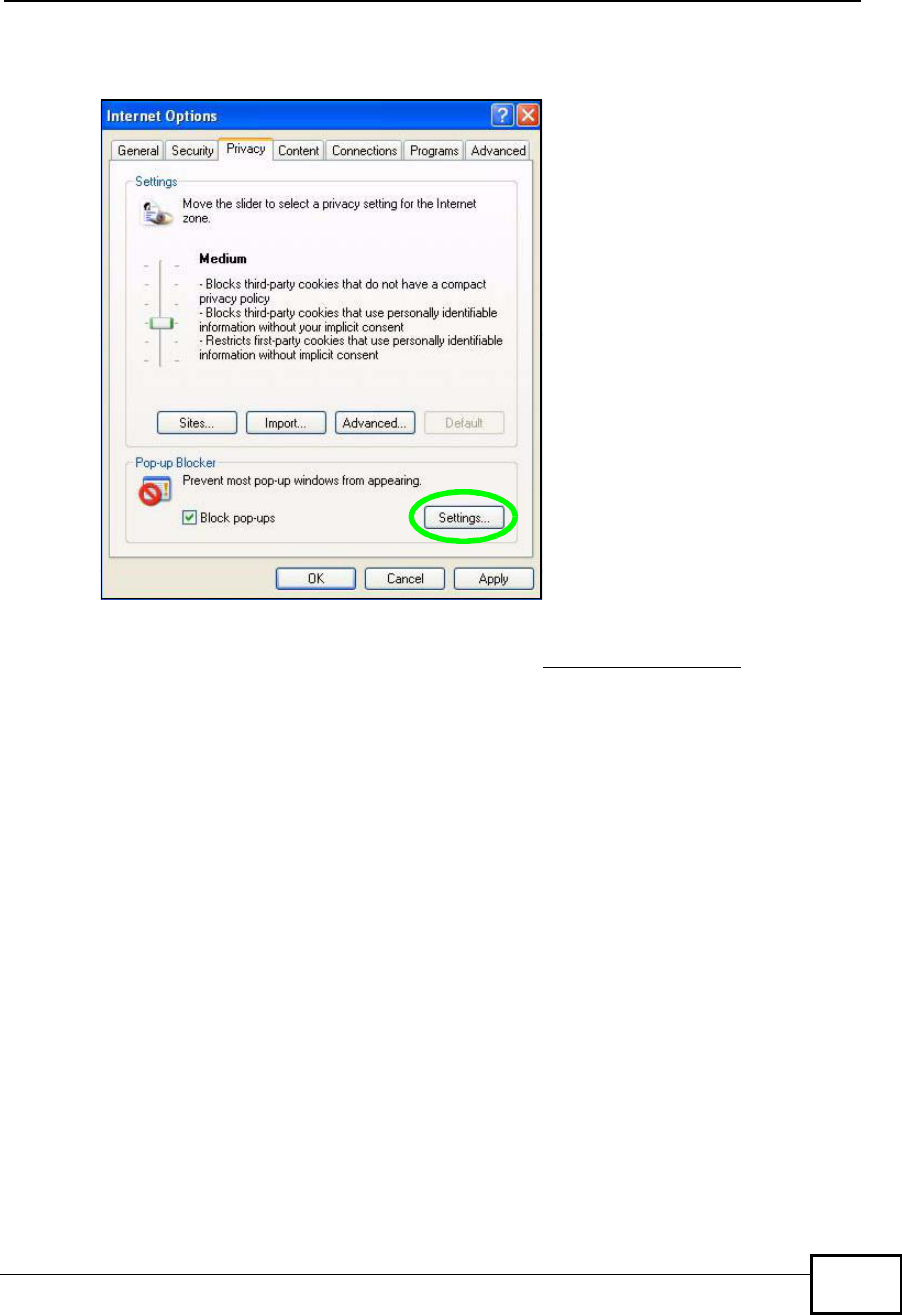
Appendix BPop-up Windows, JavaScript and Java Permissions
NBG4604 User’s Guide 223
2Select Settings…to open the Pop-up Blocker Settings screen.
Figure 128 Internet Options: Privacy
3Type the IP address of your device (the web page that you do not want to have
blocked) with the prefix “http://”. For example, http://192.168.167.1.
Company Confidential
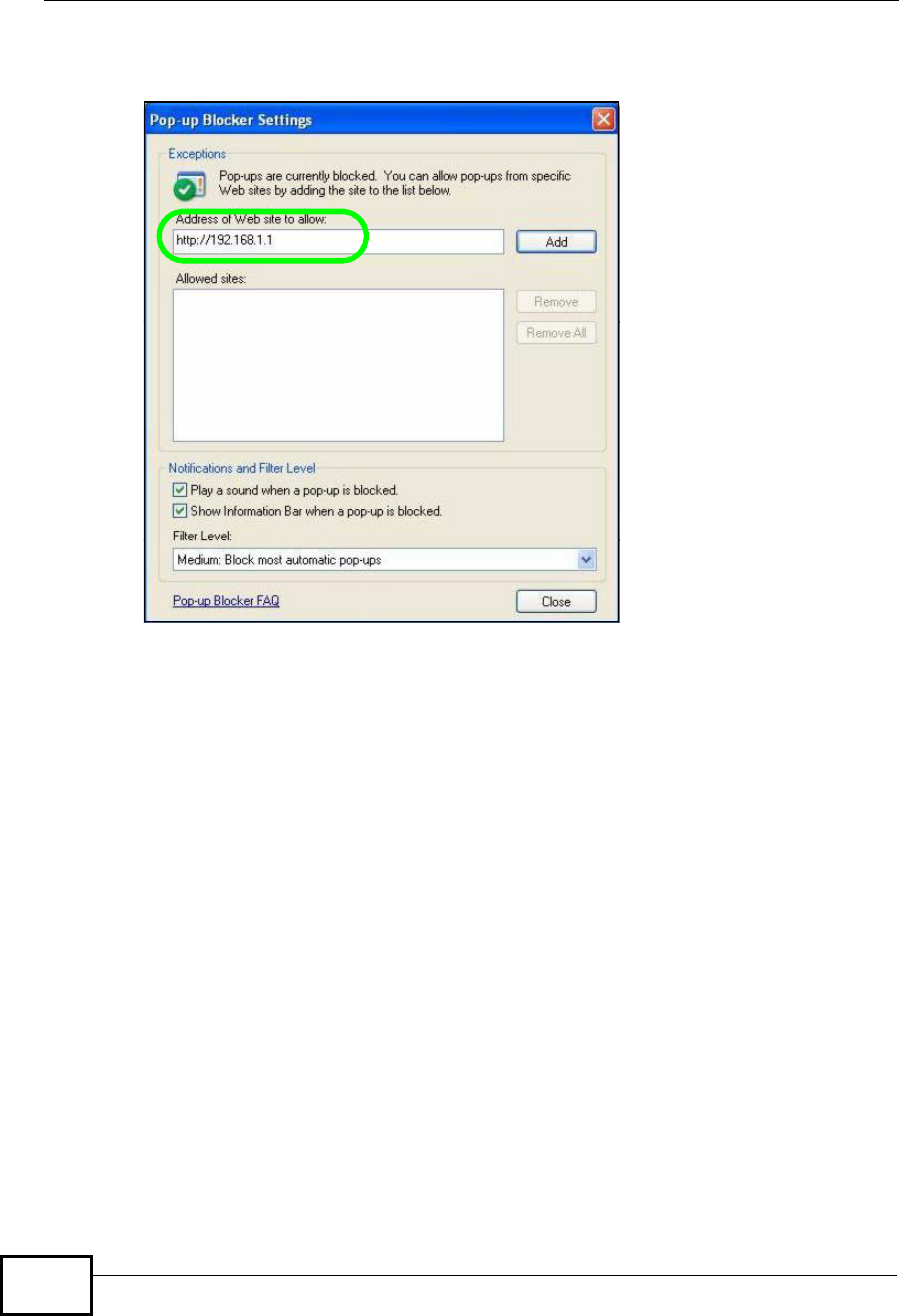
Appendix BPop-up Windows, JavaScript and Java Permissions
NBG4604 User’s Guide
224
4Click Add to move the IP address to the list of Allowed sites.
Figure 129 Pop-up Blocker Settings
5Click Close to return to the Privacy screen.
6Click Apply to save this setting.
JavaScripts
If pages of the Web Configurator do not display properly in Internet Explorer,
check that JavaScripts are allowed.
Company Confidential
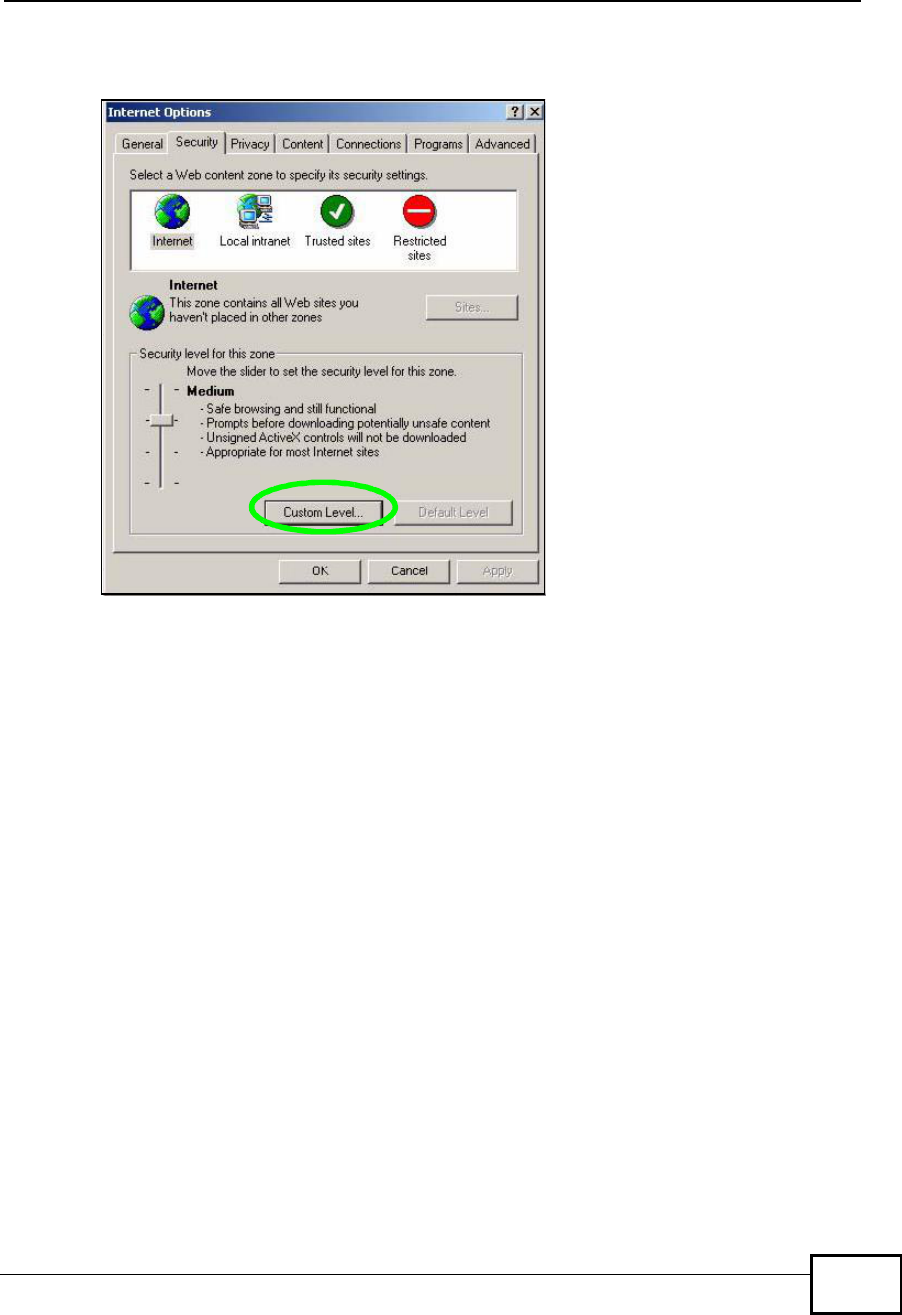
Appendix BPop-up Windows, JavaScript and Java Permissions
NBG4604 User’s Guide 225
1In Internet Explorer, click Tools,Internet Options and then the Security tab.
Figure 130 Internet Options: Security
2Click the Custom Level... button.
3Scroll down to Scripting.
4Under Active scripting make sure that Enable is selected (the default).
5Under Scripting of Java applets make sure that Enable is selected (the
default).
Company Confidential
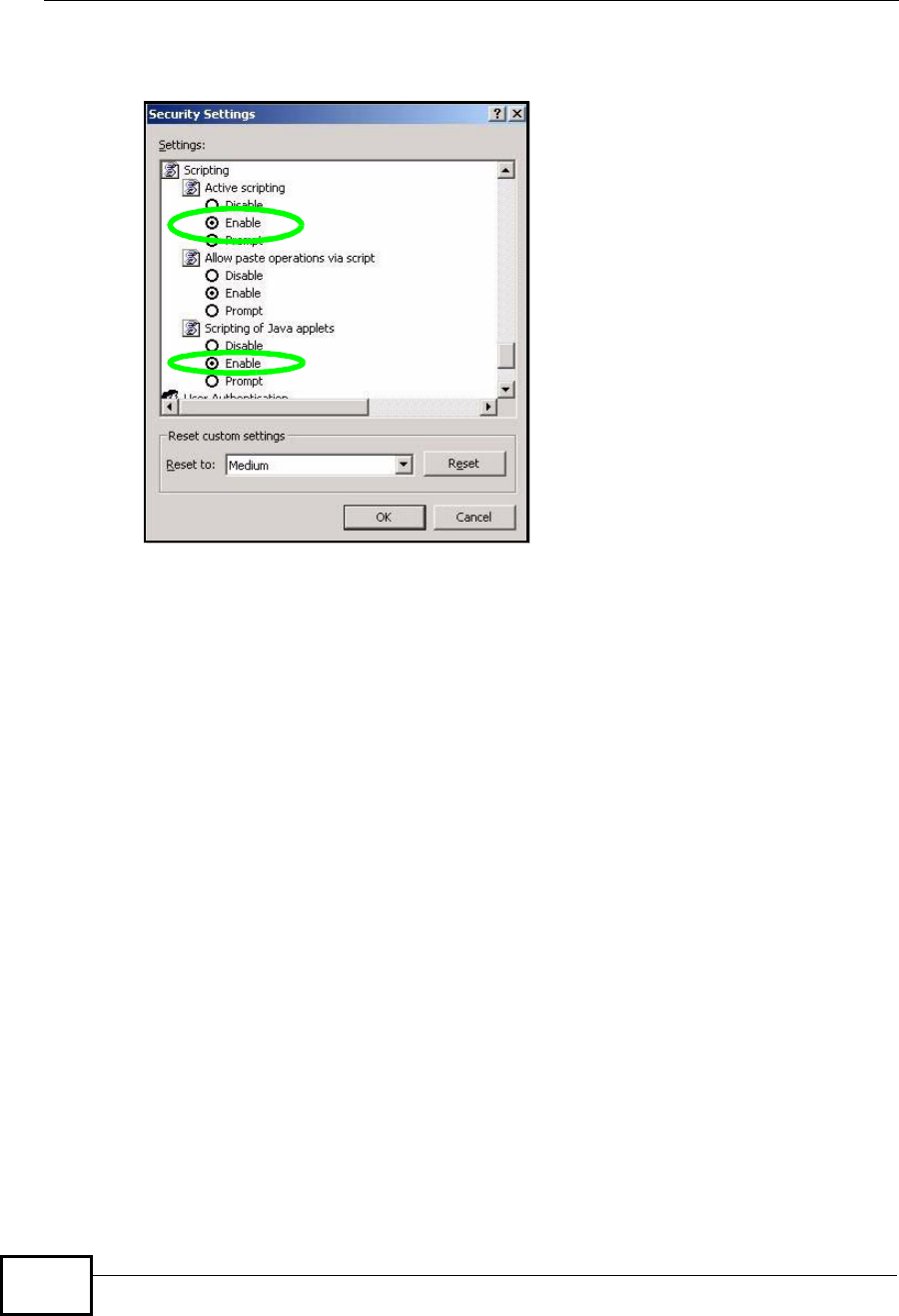
Appendix BPop-up Windows, JavaScript and Java Permissions
NBG4604 User’s Guide
226
6Click OK to close the window.
Figure 131 Security Settings - Java Scripting
Java Permissions
1From Internet Explorer, click Tools,Internet Options and then the Security
tab.
2Click the Custom Level... button.
3Scroll down to Microsoft VM.
4Under Java permissions make sure that a safety level is selected.
Company Confidential
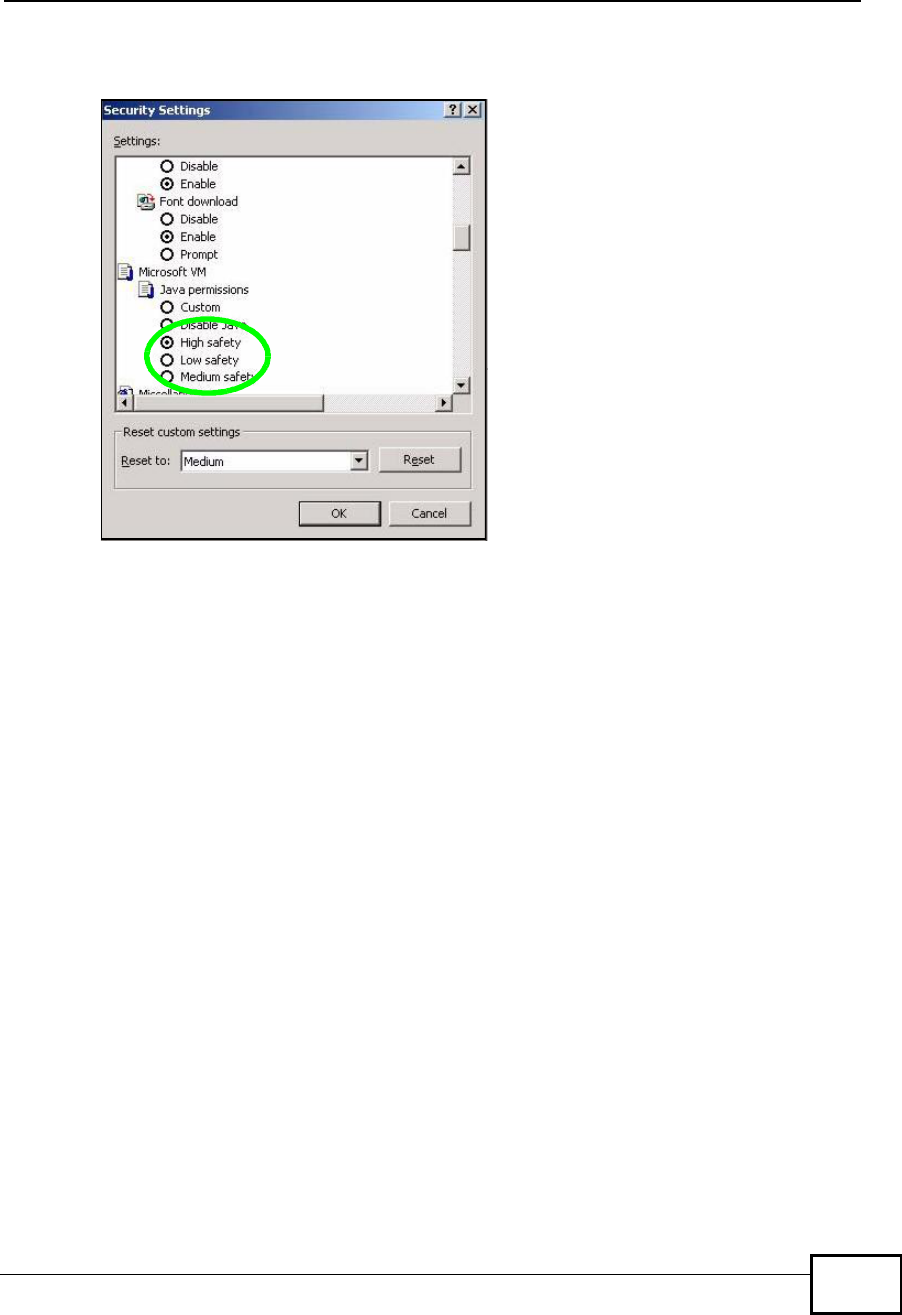
Appendix BPop-up Windows, JavaScript and Java Permissions
NBG4604 User’s Guide 227
5Click OK to close the window.
Figure 132 Security Settings - Java
JAVA (Sun)
1From Internet Explorer, click Tools,Internet Options and then the Advanced
tab.
2Make sure that Use Java 2 for <applet> under Java (Sun) is selected.
Company Confidential
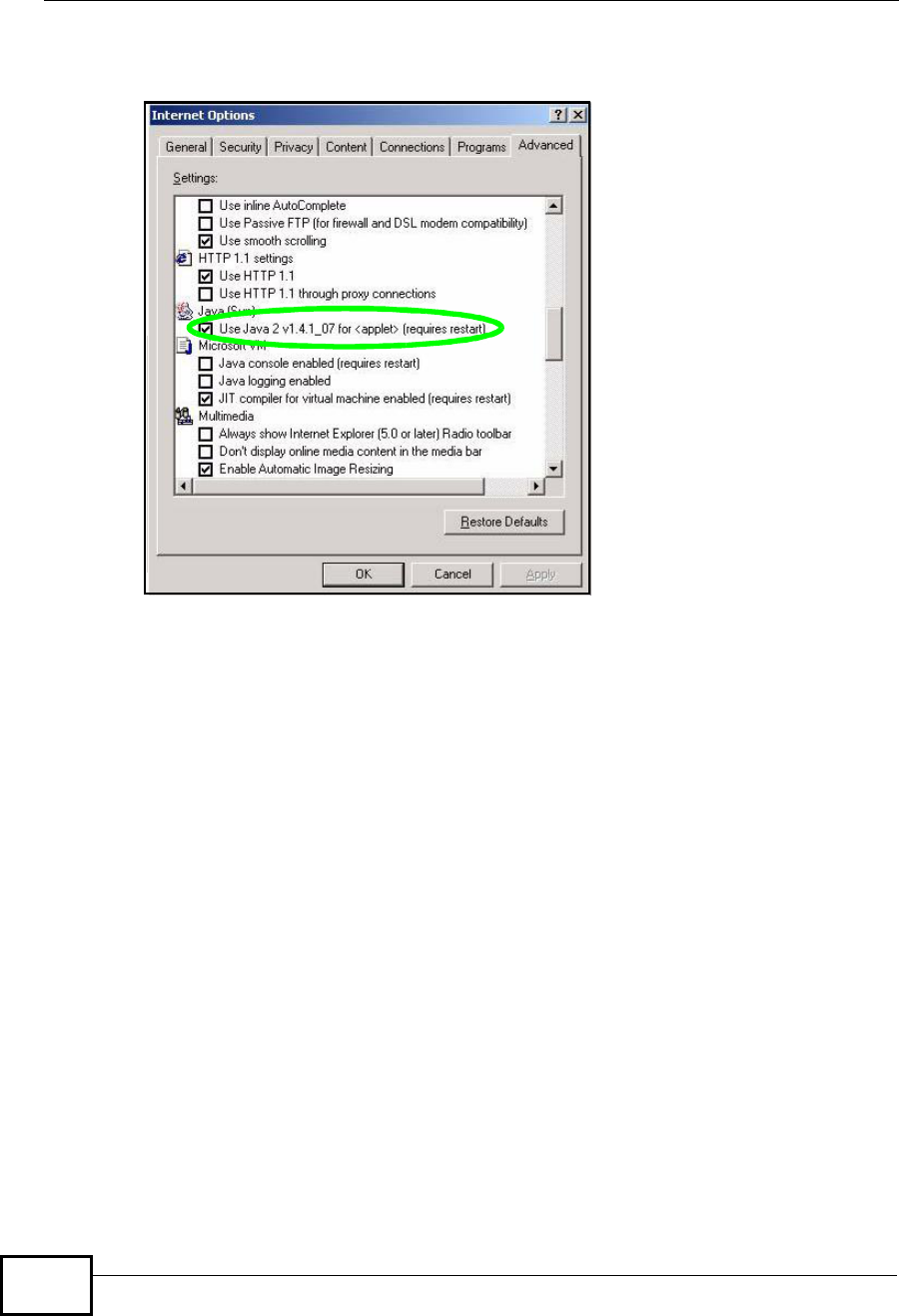
Appendix BPop-up Windows, JavaScript and Java Permissions
NBG4604 User’s Guide
228
3Click OK to close the window.
Figure 133 Java (Sun)
Company Confidential

NBG4604 User’s Guide 229
APPENDIX C
Setting up Your Computer’s IP
Address
All computers must have a 10M or 100M Ethernet adapter card and TCP/IP
installed.
Windows 95/98/Me/NT/2000/XP, Macintosh OS 7 and later operating systems and
all versions of UNIX/LINUX include the software components you need to install
and use TCP/IP on your computer. Windows 3.1 requires the purchase of a third-
party TCP/IP application package.
TCP/IP should already be installed on computers using Windows NT/2000/XP,
Macintosh OS 7 and later operating systems.
After the appropriate TCP/IP components are installed, configure the TCP/IP
settings in order to "communicate" with your network.
If you manually assign IP information instead of using dynamic assignment, make
sure that your computers have IP addresses that place them in the same subnet
as the Prestige’s LAN port.
Company Confidential
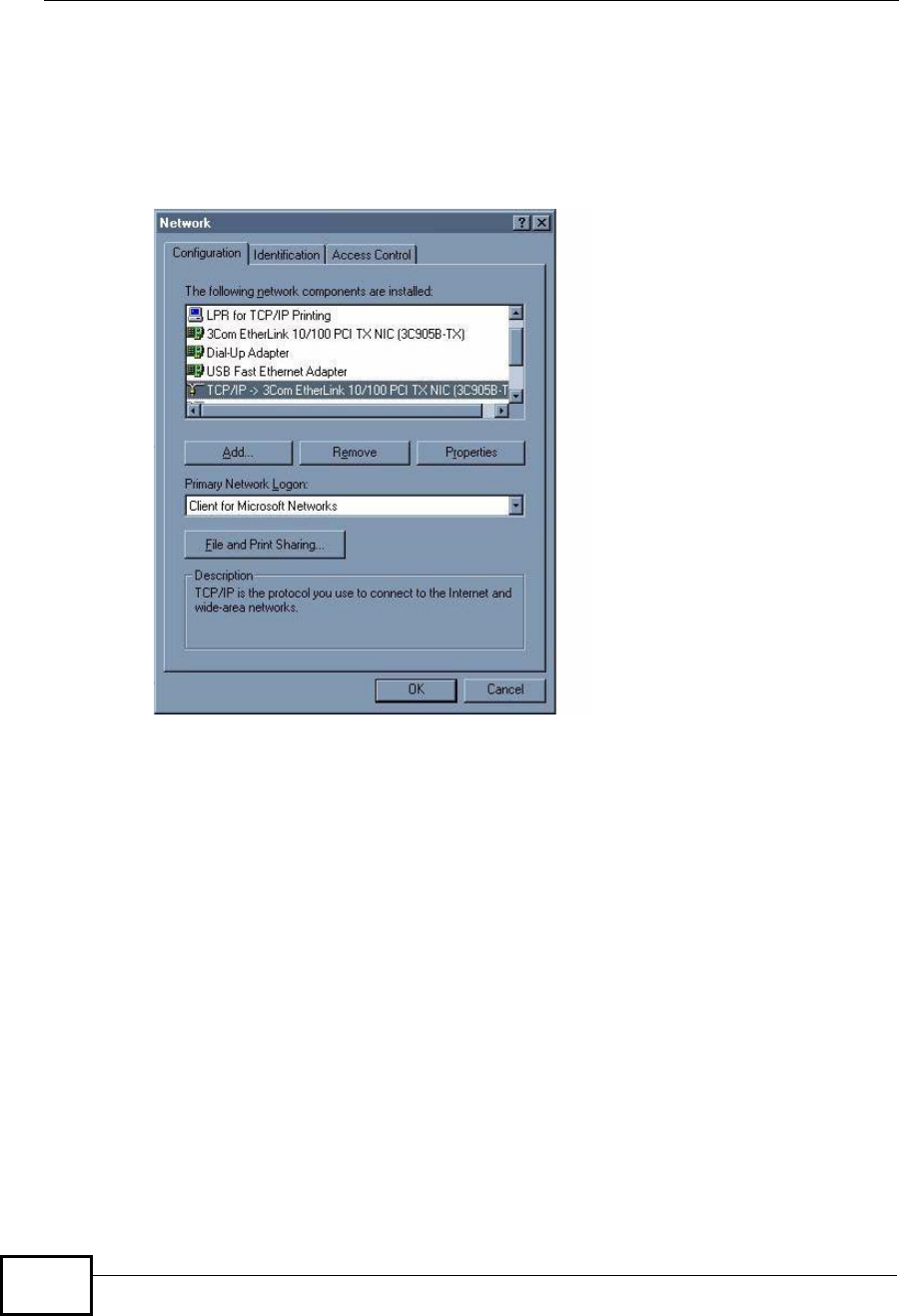
Appendix CSetting up Your Computer’s IP Address
NBG4604 User’s Guide
230
Windows 95/98/Me
Click Start,Settings,Control Panel and double-click the Network icon to open
the Network window.
Figure 134 WIndows 95/98/Me: Network: Configuration
Installing Components
The Network window Configuration tab displays a list of installed components.
You need a network adapter, the TCP/IP protocol and Client for Microsoft
Networks.
If you need the adapter:
1In the Network window, click Add.
2Select Adapter and then click Add.
3Select the manufacturer and model of your network adapter and then click OK.
If you need TCP/IP:
1In the Network window, click Add.
2Select Protocol and then click Add.
Company Confidential
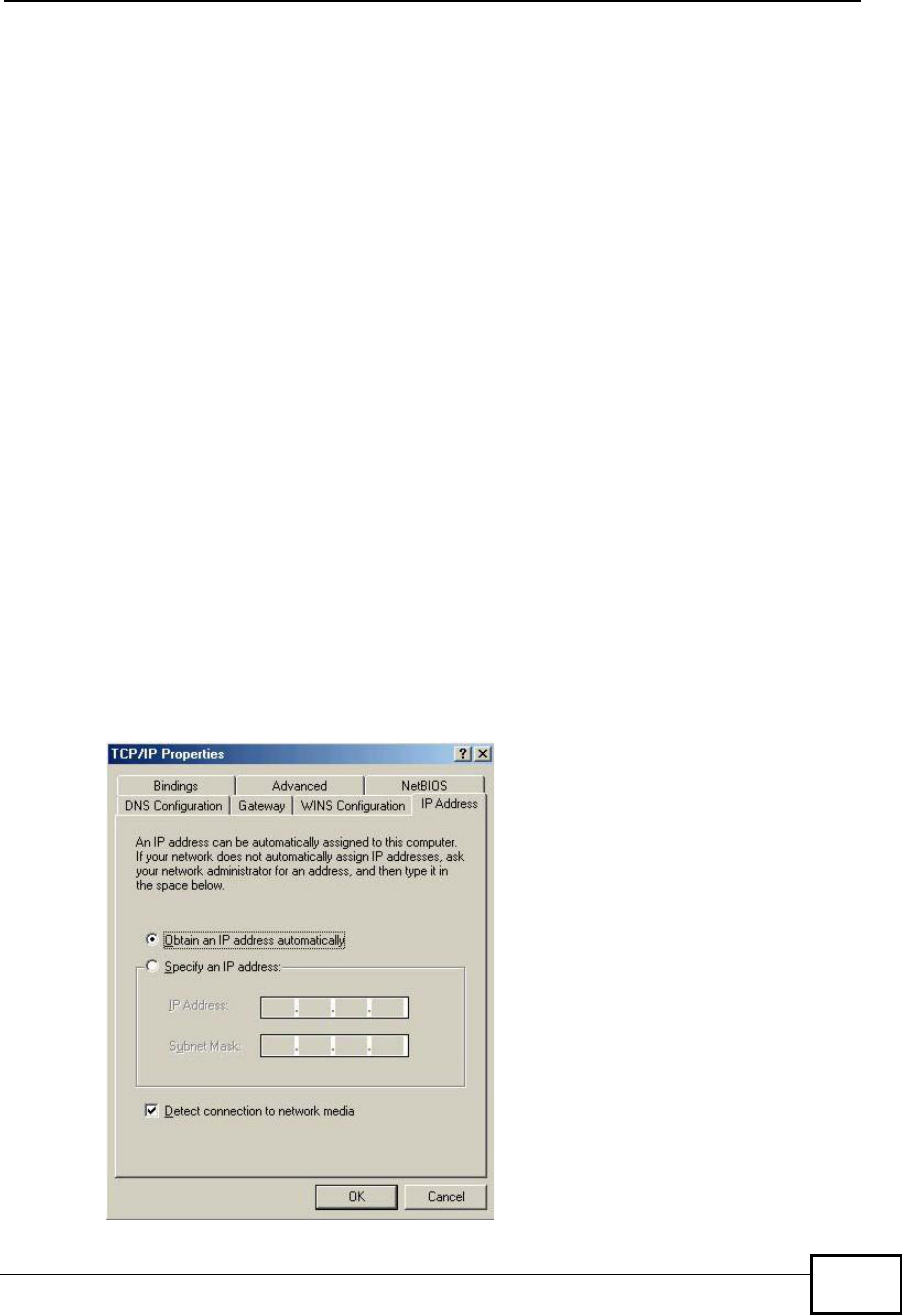
Appendix CSetting up Your Computer’s IP Address
NBG4604 User’s Guide 231
3Select Microsoft from the list of manufacturers.
4Select TCP/IP from the list of network protocols and then click OK.
If you need Client for Microsoft Networks:
1Click Add.
2Select Client and then click Add.
3Select Microsoft from the list of manufacturers.
4Select Client for Microsoft Networks from the list of network clients and then
click OK.
5Restart your computer so the changes you made take effect.
Configuring
1In the Network window Configuration tab, select your network adapter's TCP/IP
entry and click Properties
2Click the IP Address tab.
•If your IP address is dynamic, select Obtain an IP address automatically.
•If you have a static IP address, select Specify an IP address and type your
information into the IP Address and Subnet Mask fields.
Figure 135 Windows 95/98/Me: TCP/IP Properties: IP Address
Company Confidential
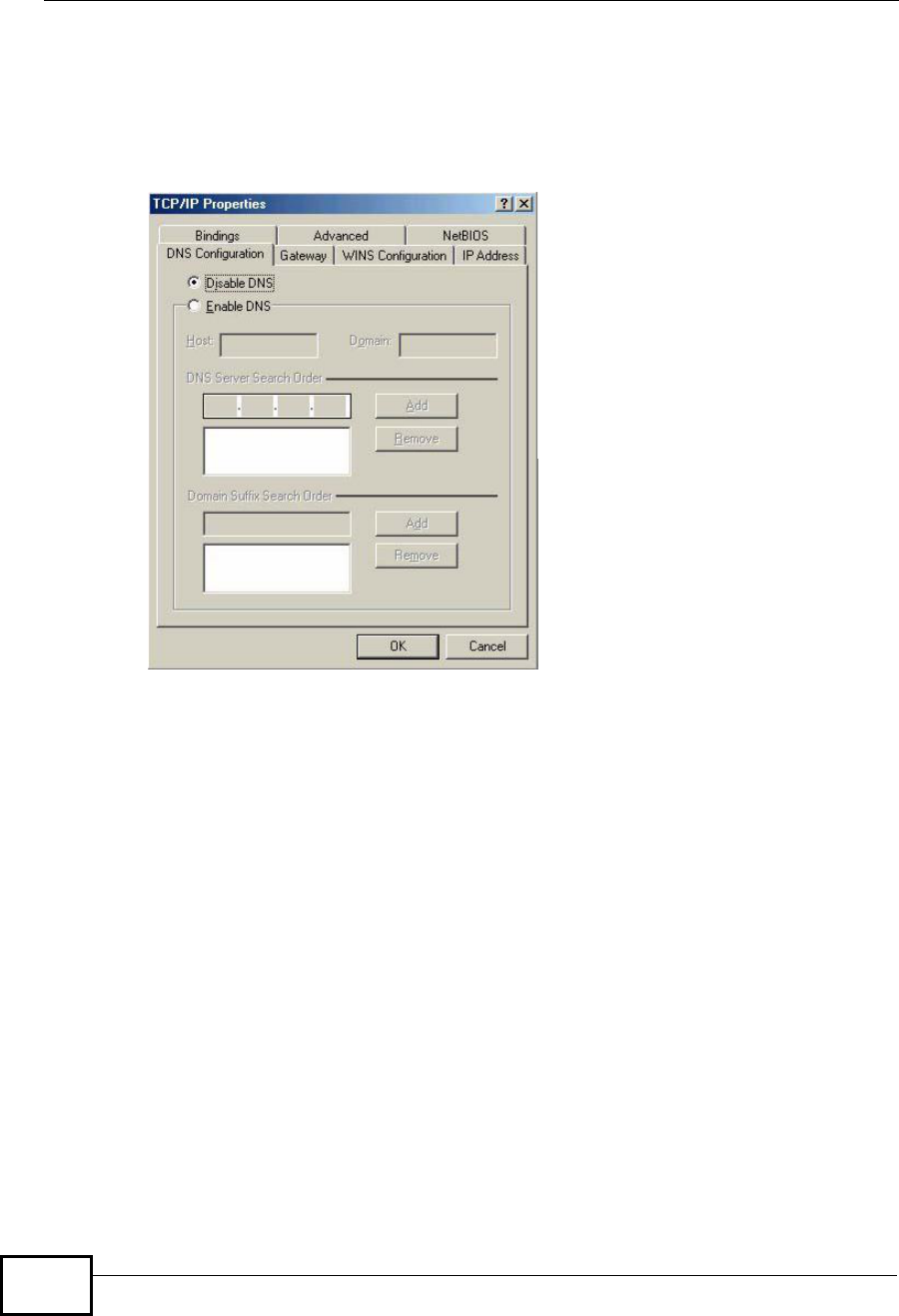
Appendix CSetting up Your Computer’s IP Address
NBG4604 User’s Guide
232
3Click the DNS Configuration tab.
•If you do not know your DNS information, select Disable DNS.
•If you know your DNS information, select Enable DNS and type the
information in the fields below (you may not need to fill them all in).
Figure 136 Windows 95/98/Me: TCP/IP Properties: DNS Configuration
4Click the Gateway tab.
•If you do not know your gateway’s IP address, remove previously installed
gateways.
•If you have a gateway IP address, type it in the New gateway field and click
Add.
5Click OK to save and close the TCP/IP Properties window.
6Click OK to close the Network window. Insert the Windows CD if prompted.
7Turn on your Prestige and restart your computer when prompted.
Verifying Settings
1Click Start and then Run.
2In the Run window, type "winipcfg" and then click OK to open the IP
Configuration window.
Company Confidential
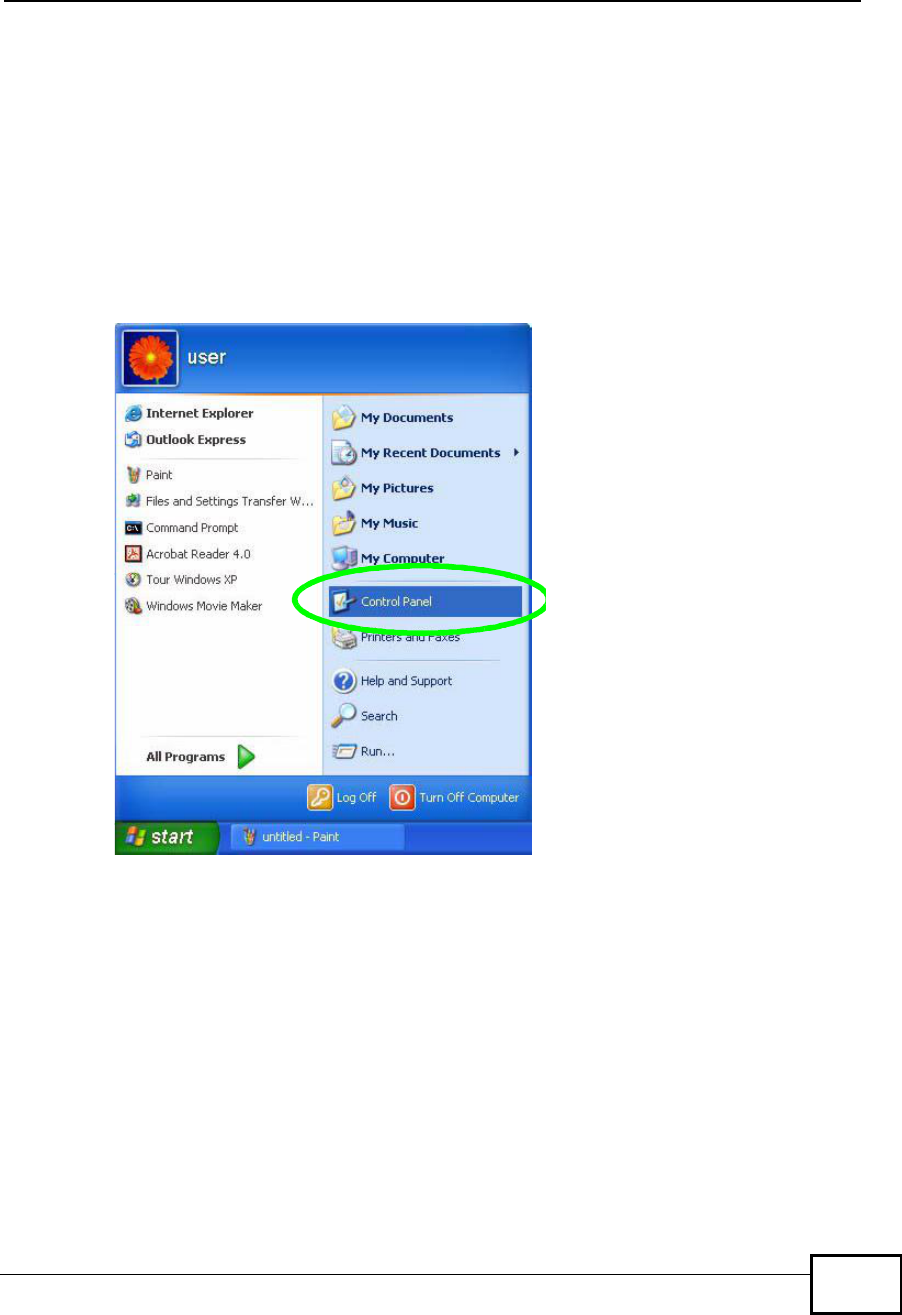
Appendix CSetting up Your Computer’s IP Address
NBG4604 User’s Guide 233
3Select your network adapter. You should see your computer's IP address, subnet
mask and default gateway.
Windows 2000/NT/XP
The following example figures use the default Windows XP GUI theme.
1Click start (Start in Windows 2000/NT), Settings,Control Panel.
Figure 137 Windows XP: Start Menu
Company Confidential
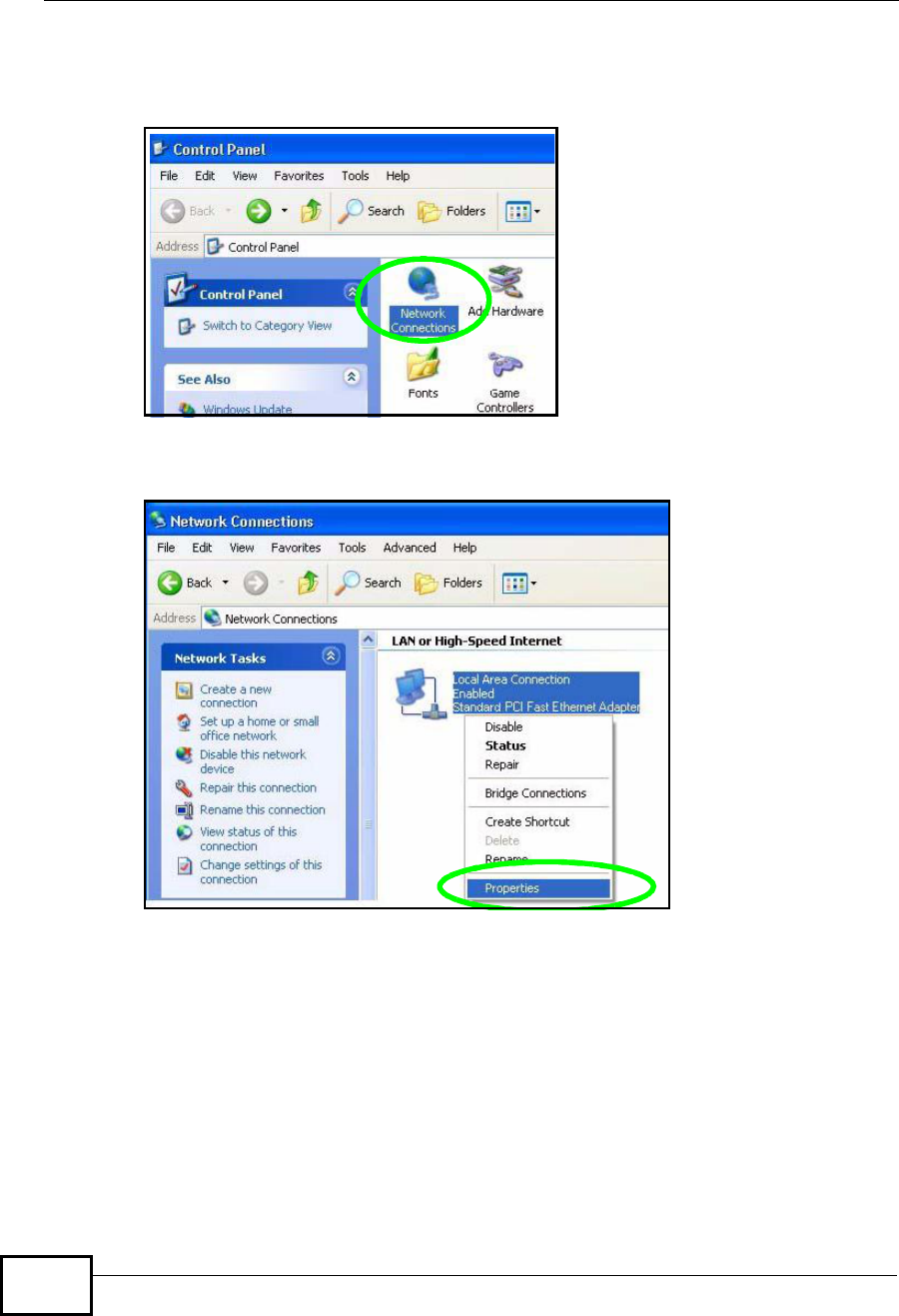
Appendix CSetting up Your Computer’s IP Address
NBG4604 User’s Guide
234
2In the Control Panel, double-click Network Connections (Network and Dial-
up Connections in Windows 2000/NT).
Figure 138 Windows XP: Control Panel
3Right-click Local Area Connection and then click Properties.
Figure 139 Windows XP: Control Panel: Network Connections: Properties
Company Confidential
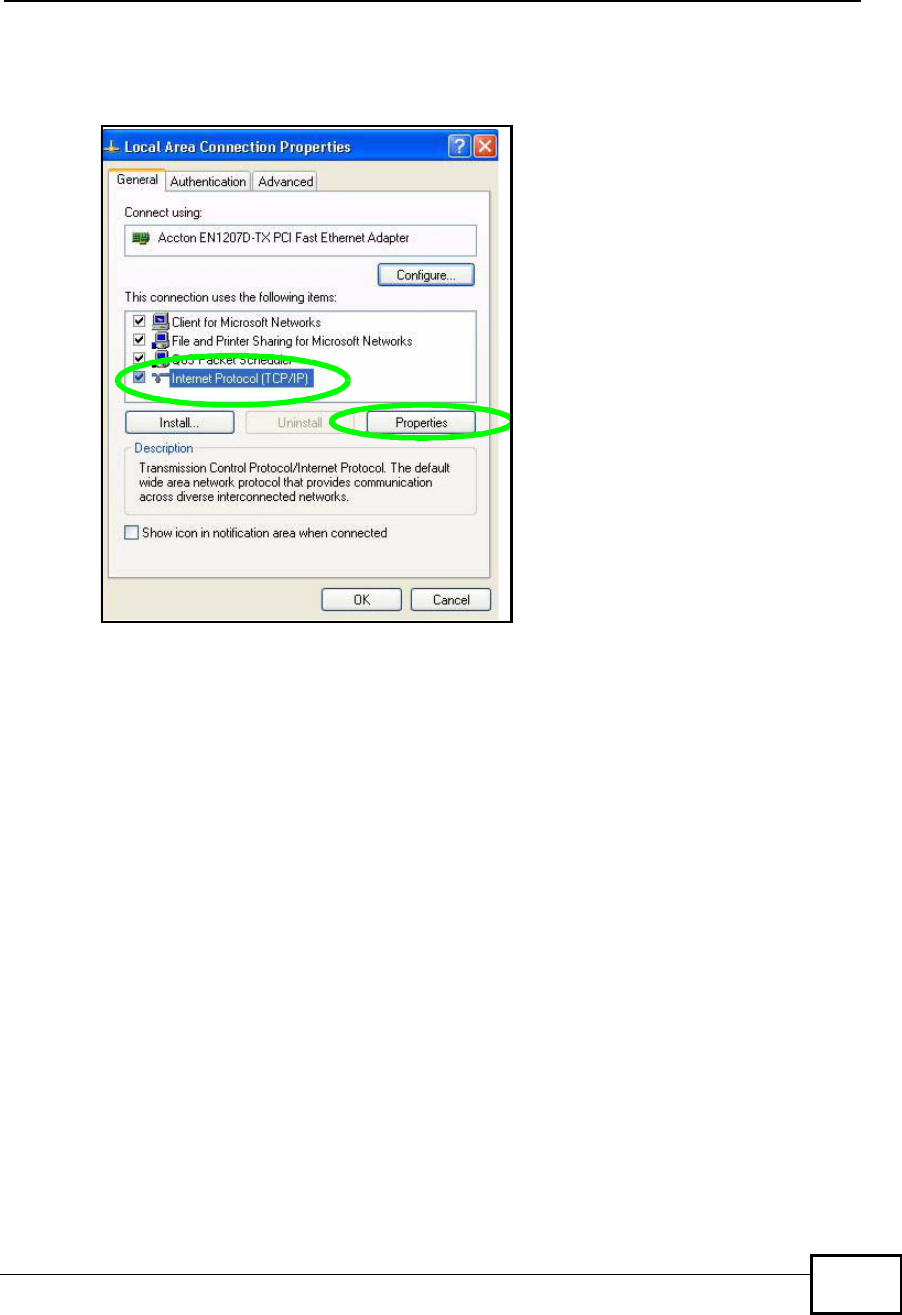
Appendix CSetting up Your Computer’s IP Address
NBG4604 User’s Guide 235
4Select Internet Protocol (TCP/IP) (under the General tab in Win XP) and then
click Properties.
Figure 140 Windows XP: Local Area Connection Properties
5The Internet Protocol TCP/IP Properties window opens (the General tab in
Windows XP).
•If you have a dynamic IP address click Obtain an IP address
automatically.
•If you have a static IP address click Use the following IP Address and fill in
the IP address,Subnet mask, and Default gateway fields.
Company Confidential
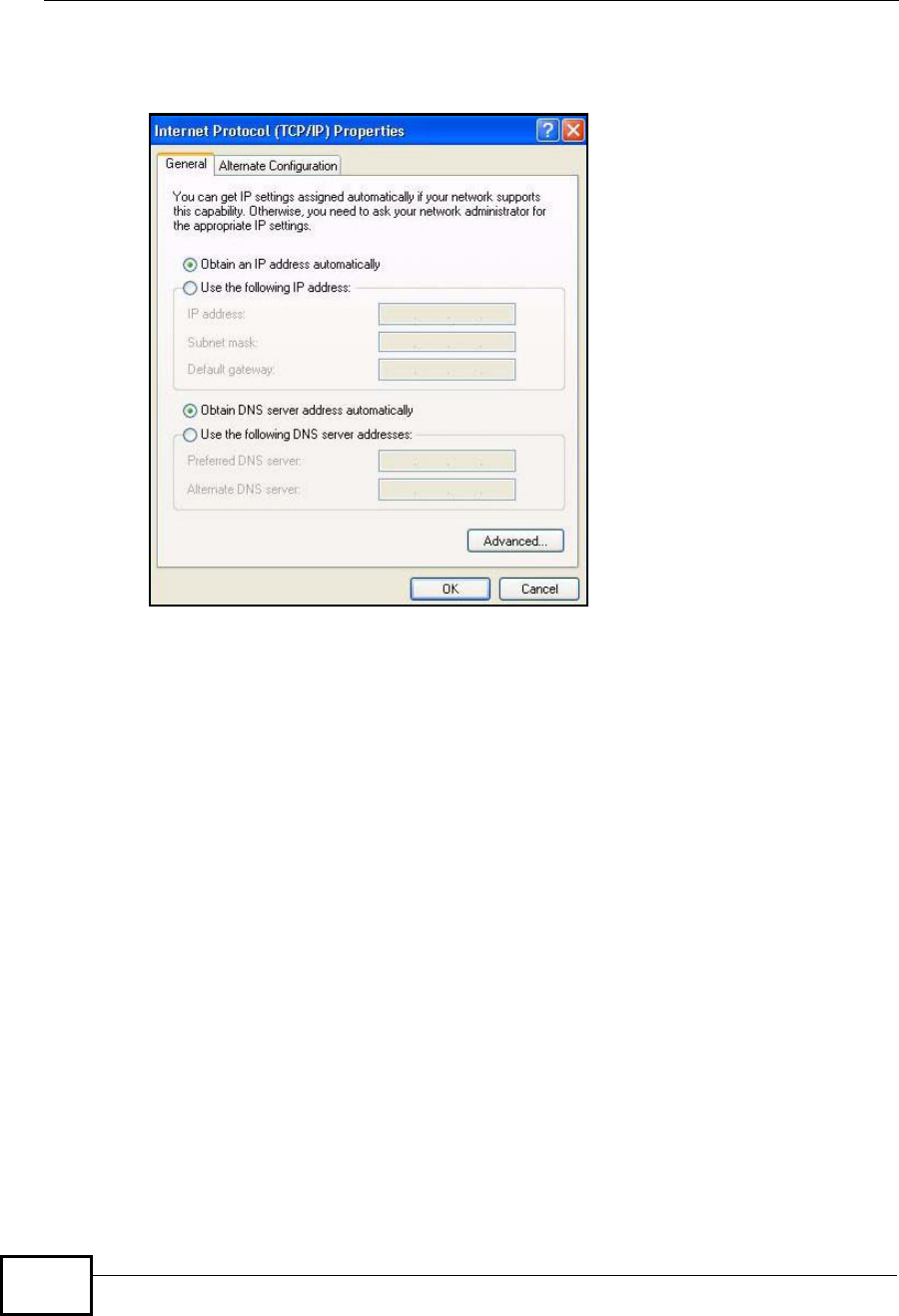
Appendix CSetting up Your Computer’s IP Address
NBG4604 User’s Guide
236
•Click Advanced.
Figure 141 Windows XP: Internet Protocol (TCP/IP) Properties
6 If you do not know your gateway's IP address, remove any previously installed
gateways in the IP Settings tab and click OK.
Do one or more of the following if you want to configure additional IP addresses:
•In the IP Settings tab, in IP addresses, click Add.
•In TCP/IP Address, type an IP address in IP address and a subnet mask in
Subnet mask, and then click Add.
•Repeat the above two steps for each IP address you want to add.
•Configure additional default gateways in the IP Settings tab by clicking Add
in Default gateways.
•In TCP/IP Gateway Address, type the IP address of the default gateway in
Gateway. To manually configure a default metric (the number of transmission
hops), clear the Automatic metric check box and type a metric in Metric.
•Click Add.
•Repeat the previous three steps for each default gateway you want to add.
Company Confidential
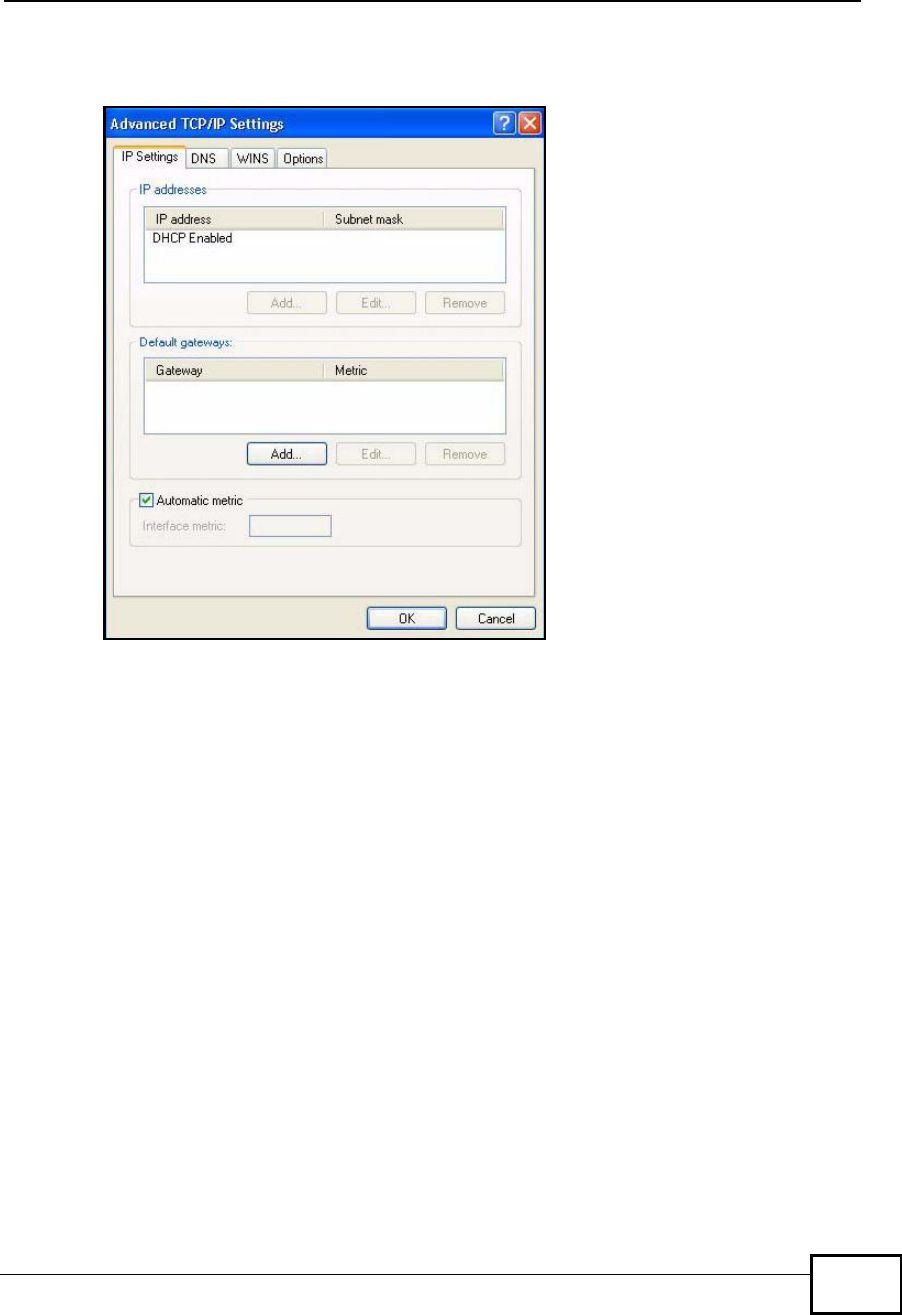
Appendix CSetting up Your Computer’s IP Address
NBG4604 User’s Guide 237
•Click OK when finished.
Figure 142 Windows XP: Advanced TCP/IP Properties
7In the Internet Protocol TCP/IP Properties window (the General tab in
Windows XP):
•Click Obtain DNS server address automatically if you do not know your
DNS server IP address(es).
•If you know your DNS server IP address(es), click Use the following DNS
server addresses, and type them in the Preferred DNSserver and
Alternate DNS server fields.
Company Confidential
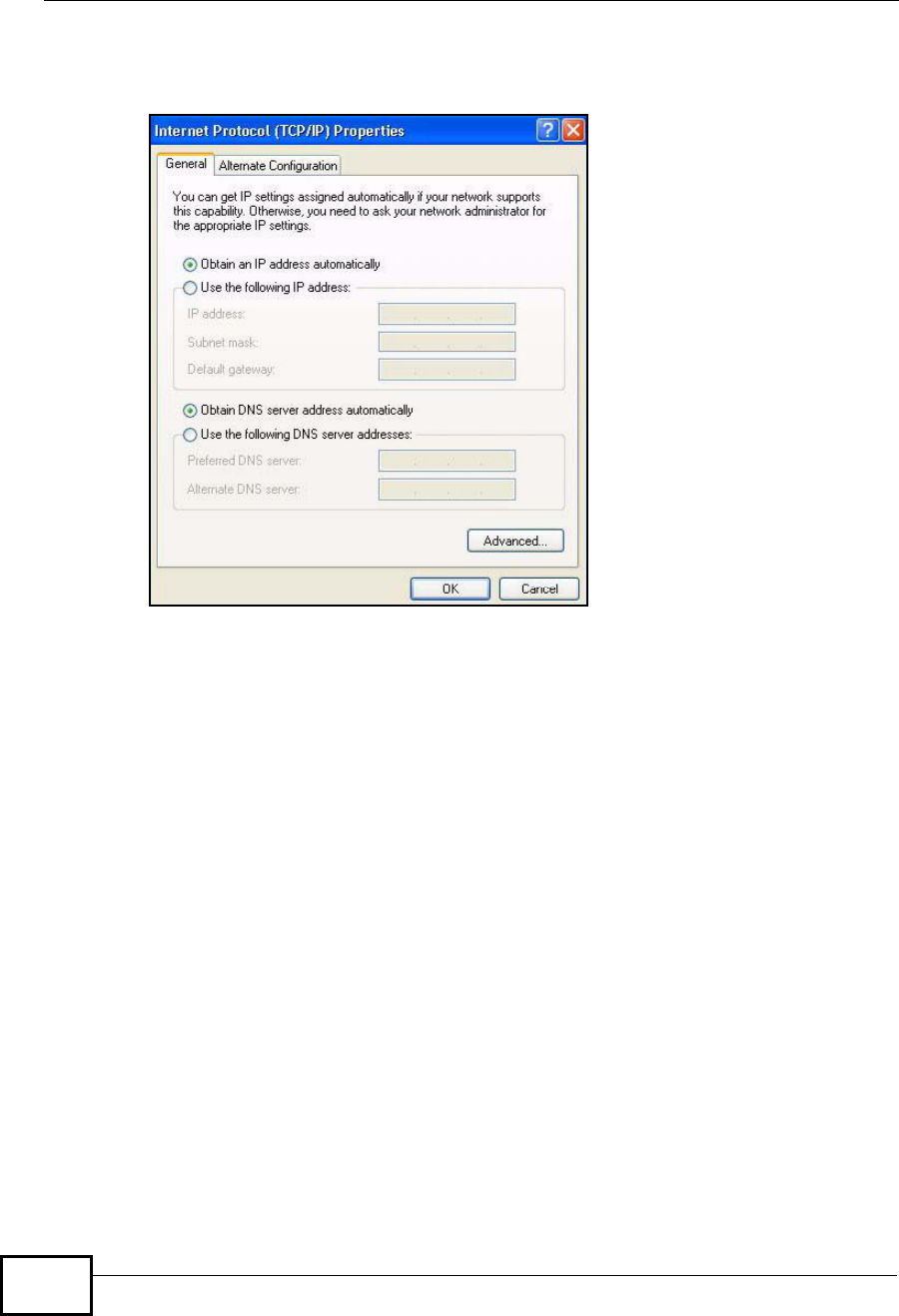
Appendix CSetting up Your Computer’s IP Address
NBG4604 User’s Guide
238
If you have previously configured DNS servers, click Advanced and then the
DNS tab to order them.
Figure 143 Windows XP: Internet Protocol (TCP/IP) Properties
8Click OK to close the Internet Protocol (TCP/IP) Properties window.
9Click Close (OK in Windows 2000/NT) to close the Local Area Connection
Properties window.
10 Close the Network Connections window (Network and Dial-up Connections
in Windows 2000/NT).
11 Turn on your Prestige and restart your computer (if prompted).
Verifying Settings
1Click Start,All Programs,Accessories and then Command Prompt.
2In the Command Prompt window, type "ipconfig" and then press [ENTER]. You
can also open Network Connections, right-click a network connection, click
Status and then click the Support tab.
Company Confidential
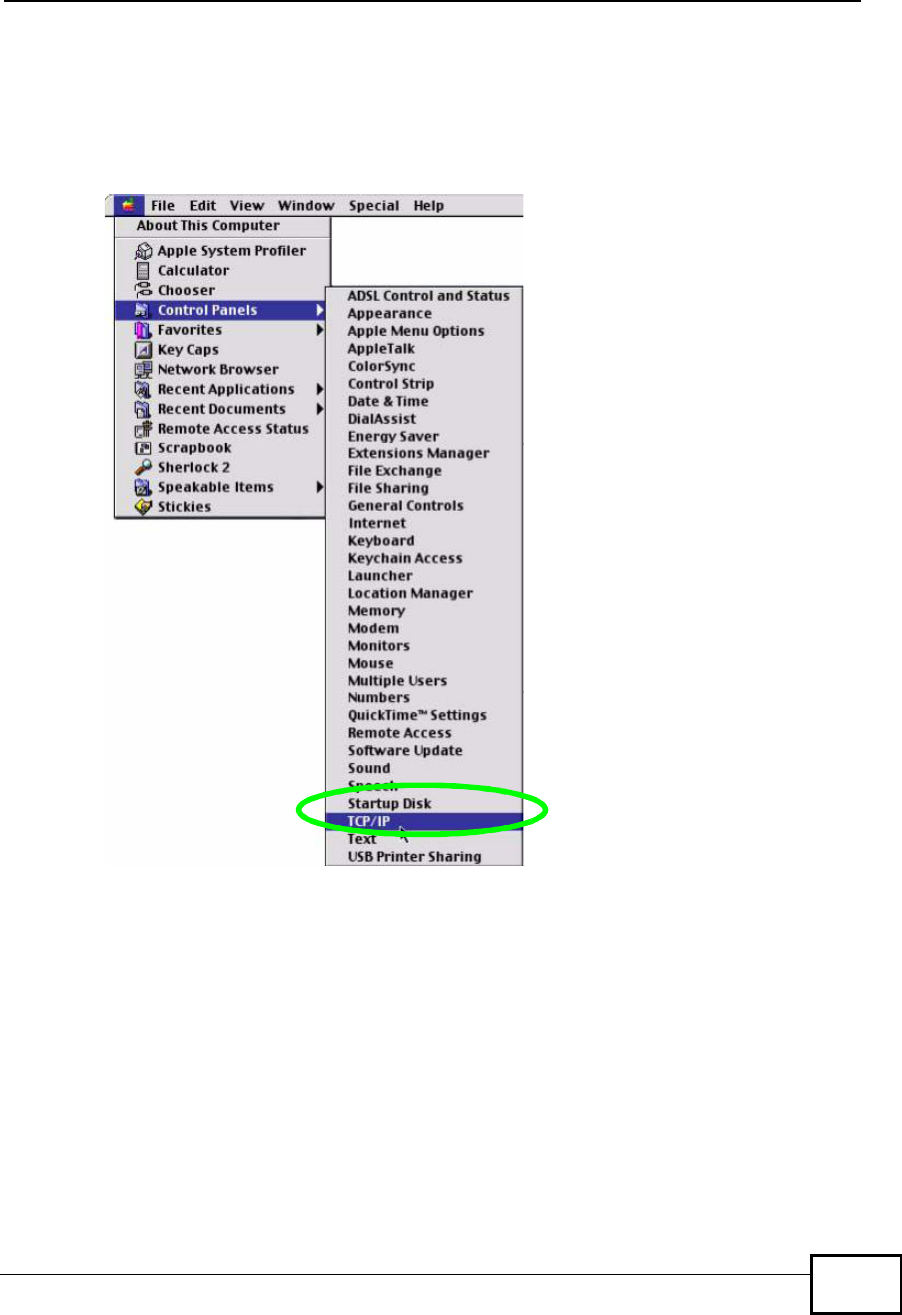
Appendix CSetting up Your Computer’s IP Address
NBG4604 User’s Guide 239
Macintosh OS 8/9
1Click the Apple menu, Control Panel and double-click TCP/IP to open the TCP/
IP Control Panel.
Figure 144 Macintosh OS 8/9: Apple Menu
Company Confidential
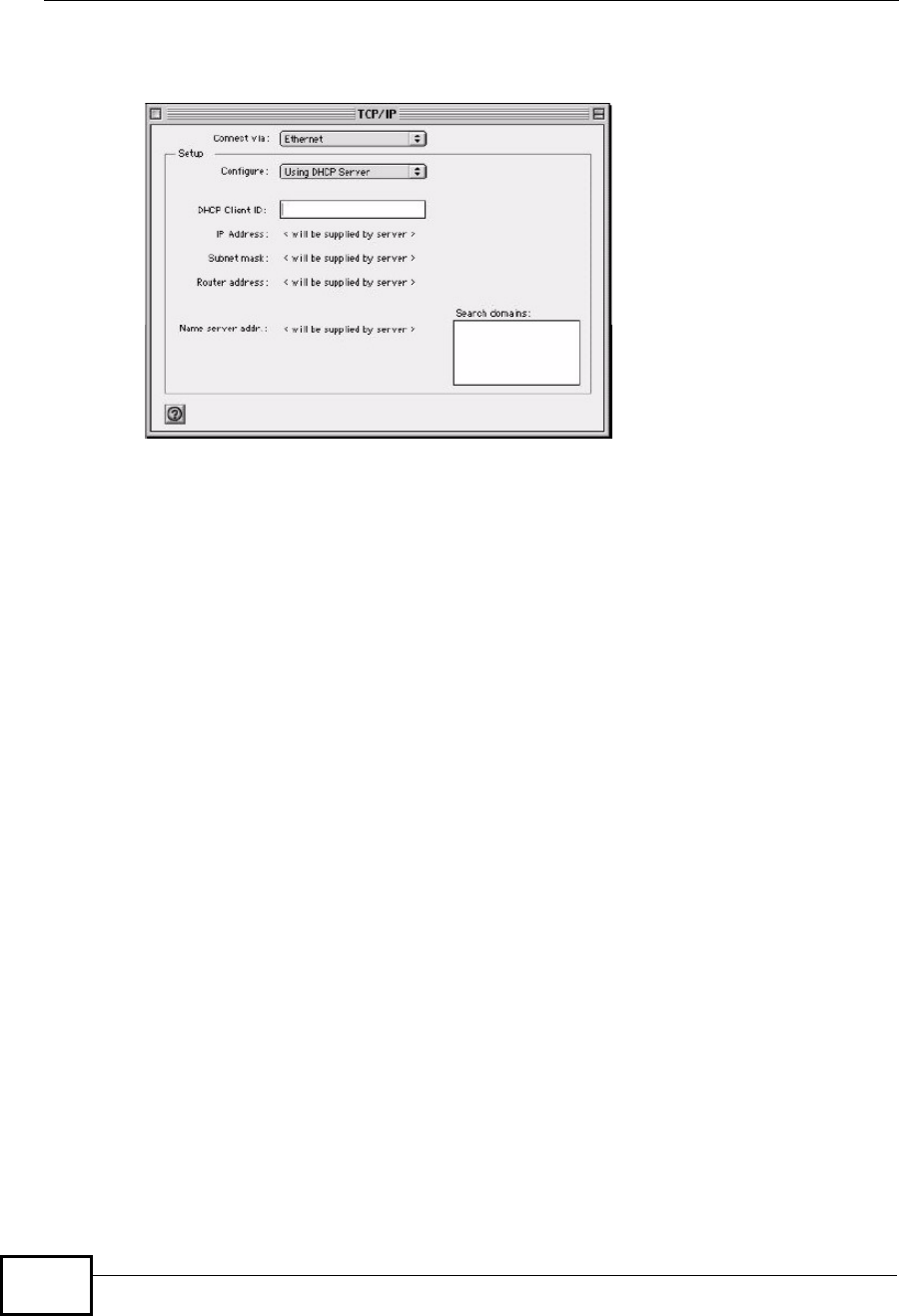
Appendix CSetting up Your Computer’s IP Address
NBG4604 User’s Guide
240
2Select Ethernet built-in from the Connect via list.
Figure 145 Macintosh OS 8/9: TCP/IP
3For dynamically assigned settings, select Using DHCP Server from the
Configure: list.
4For statically assigned settings, do the following:
•From the Configure box, select Manually.
•Type your IP address in the IP Address box.
•Type your subnet mask in the Subnet mask box.
•Type the IP address of your Prestige in the Router address box.
5Close the TCP/IP Control Panel.
6Click Save if prompted, to save changes to your configuration.
7Turn on your Prestige and restart your computer (if prompted).
Verifying Settings
Check your TCP/IP properties in the TCP/IP Control Panel window.
Company Confidential
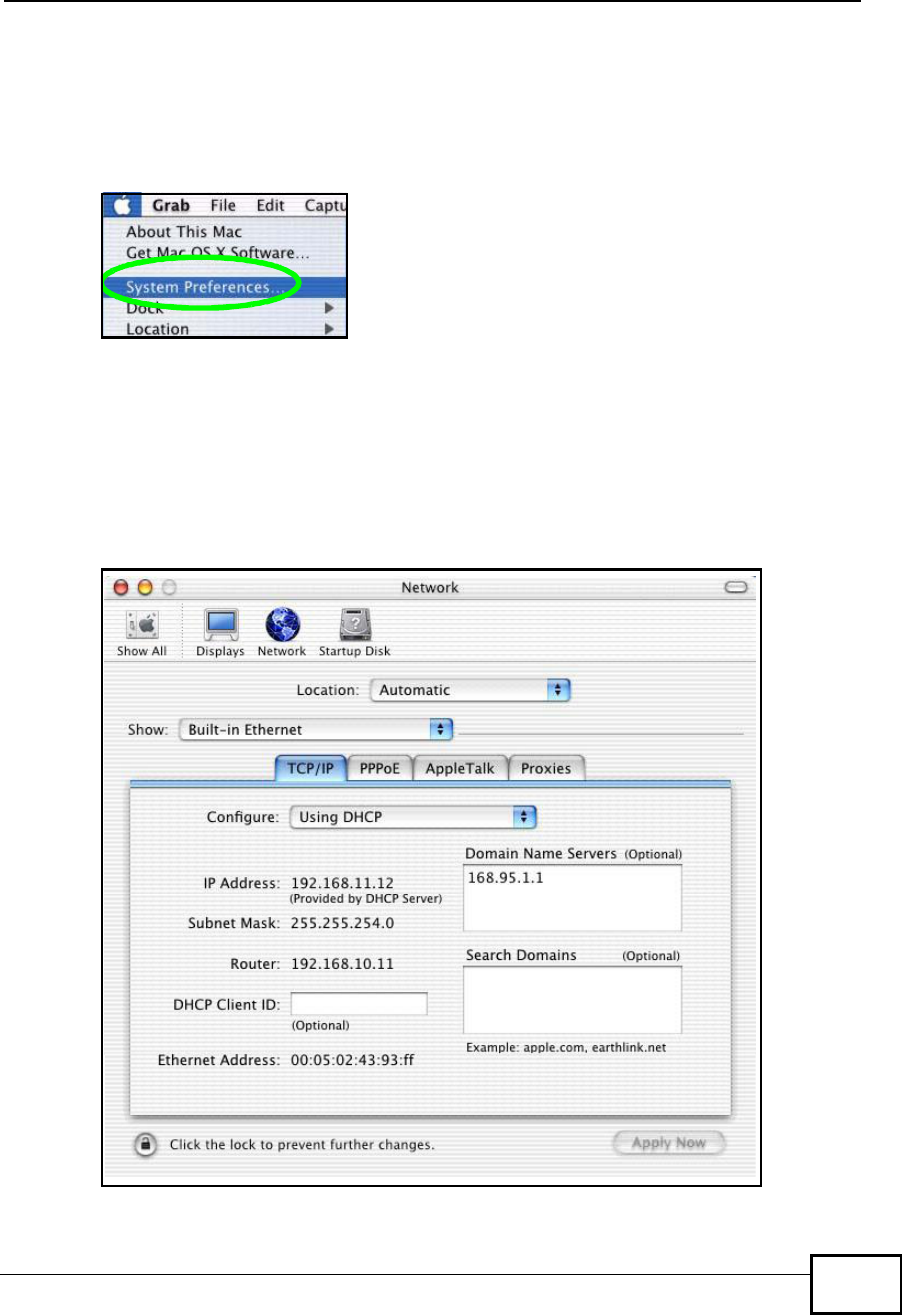
Appendix CSetting up Your Computer’s IP Address
NBG4604 User’s Guide 241
Macintosh OS X
1Click the Apple menu, and click System Preferences to open the System
Preferences window.
Figure 146 Macintosh OS X: Apple Menu
2Click Network in the icon bar.
•Select Automatic from the Location list.
•Select Built-in Ethernet from the Show list.
•Click the TCP/IP tab.
3For dynamically assigned settings, select Using DHCP from the Configure list.
Figure 147 Macintosh OS X: Network
Company Confidential
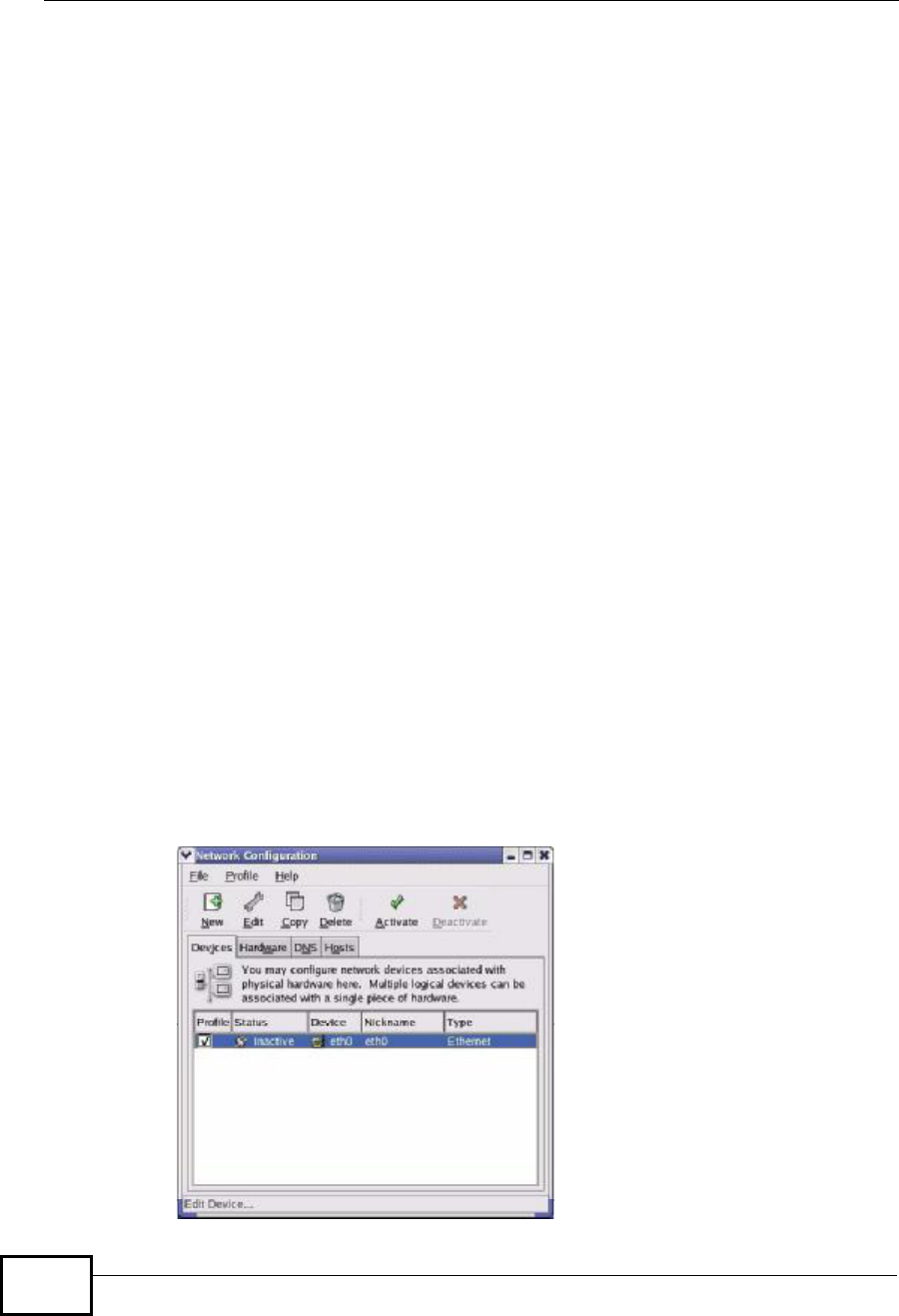
Appendix CSetting up Your Computer’s IP Address
NBG4604 User’s Guide
242
4For statically assigned settings, do the following:
•From the Configure box, select Manually.
•Type your IP address in the IP Address box.
•Type your subnet mask in the Subnet mask box.
•Type the IP address of your Prestige in the Router address box.
5Click Apply Now and close the window.
6Turn on your Prestige and restart your computer (if prompted).
Verifying Settings
Check your TCP/IP properties in the Network window.
Linux
This section shows you how to configure your computer’s TCP/IP settings in Red
Hat Linux 9.0. Procedure, screens and file location may vary depending on your
Linux distribution and release version.
Note: Make sure you are logged in as the root administrator.
Using the K Desktop Environment (KDE)
Follow the steps below to configure your computer IP address using the KDE.
1Click the Red Hat button (located on the bottom left corner), select System
Setting and click Network.
Figure 148 Red Hat 9.0: KDE: Network Configuration: Devices
Company Confidential
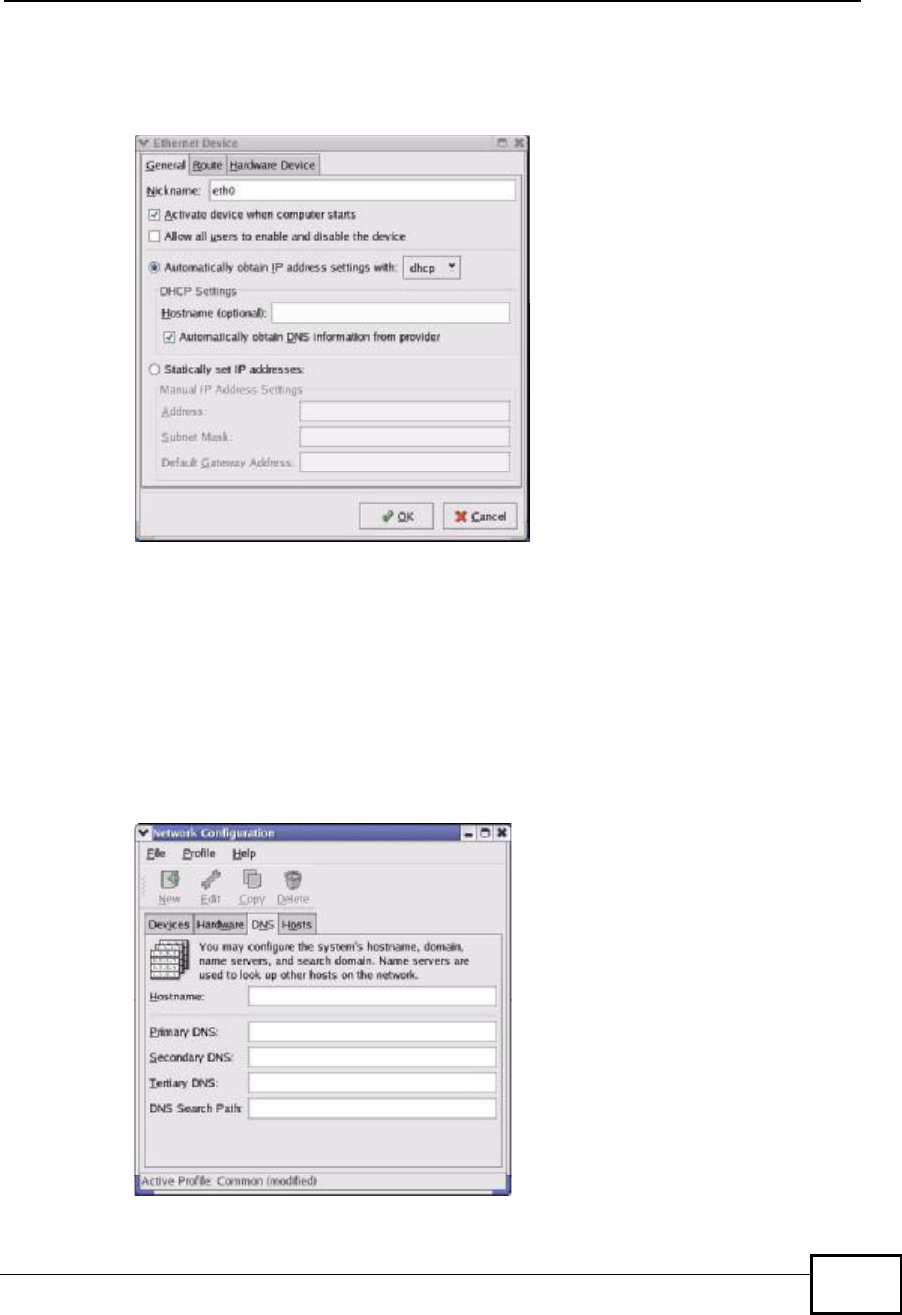
Appendix CSetting up Your Computer’s IP Address
NBG4604 User’s Guide 243
2Double-click on the profile of the network card you wish to configure. The
Ethernet Device General screen displays as shown.
Figure 149 Red Hat 9.0: KDE: Ethernet Device: General
•If you have a dynamic IP address click Automatically obtain IP address
settings with and select dhcp from the drop down list.
•If you have a static IP address click Statically set IP Addresses and fill in
the Address,Subnet mask, and Default Gateway Address fields.
3Click OK to save the changes and close the Ethernet Device General screen.
4If you know your DNS server IP address(es), click the DNS tab in the Network
Configuration screen. Enter the DNS server information in the fields provided.
Figure 150 Red Hat 9.0: KDE: Network Configuration: DNS
Company Confidential
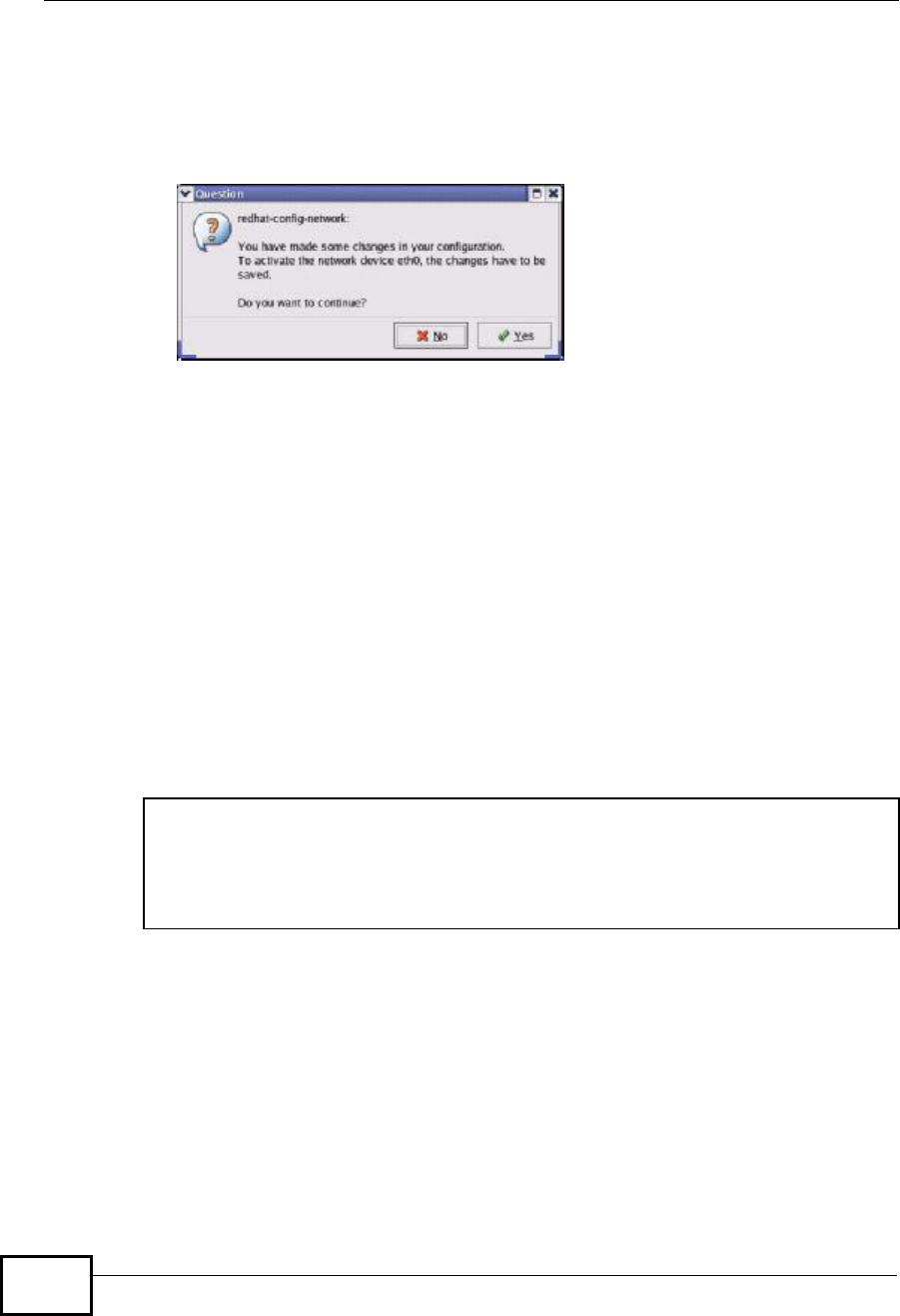
Appendix CSetting up Your Computer’s IP Address
NBG4604 User’s Guide
244
5Click the Devices tab.
6Click the Activate button to apply the changes. The following screen displays.
Click Yes to save the changes in all screens.
Figure 151 Red Hat 9.0: KDE: Network Configuration: Activate
7After the network card restart process is complete, make sure the Status is
Active in the Network Configuration screen.
Using Configuration Files
Follow the steps below to edit the network configuration files and set your
computer IP address.
1Assuming that you have only one network card on the computer, locate the
ifconfig-eth0 configuration file (where eth0 is the name of the Ethernet card).
Open the configuration file with any plain text editor.
•If you have a dynamic IP address, enter dhcp in the BOOTPROTO= field. The
following figure shows an example.
Figure 152 Red Hat 9.0: Dynamic IP Address Setting in ifconfig-eth0
DEVICE=eth0
ONBOOT=yes
BOOTPROTO=dhcp
USERCTL=no
PEERDNS=yes
TYPE=Ethernet
Company Confidential
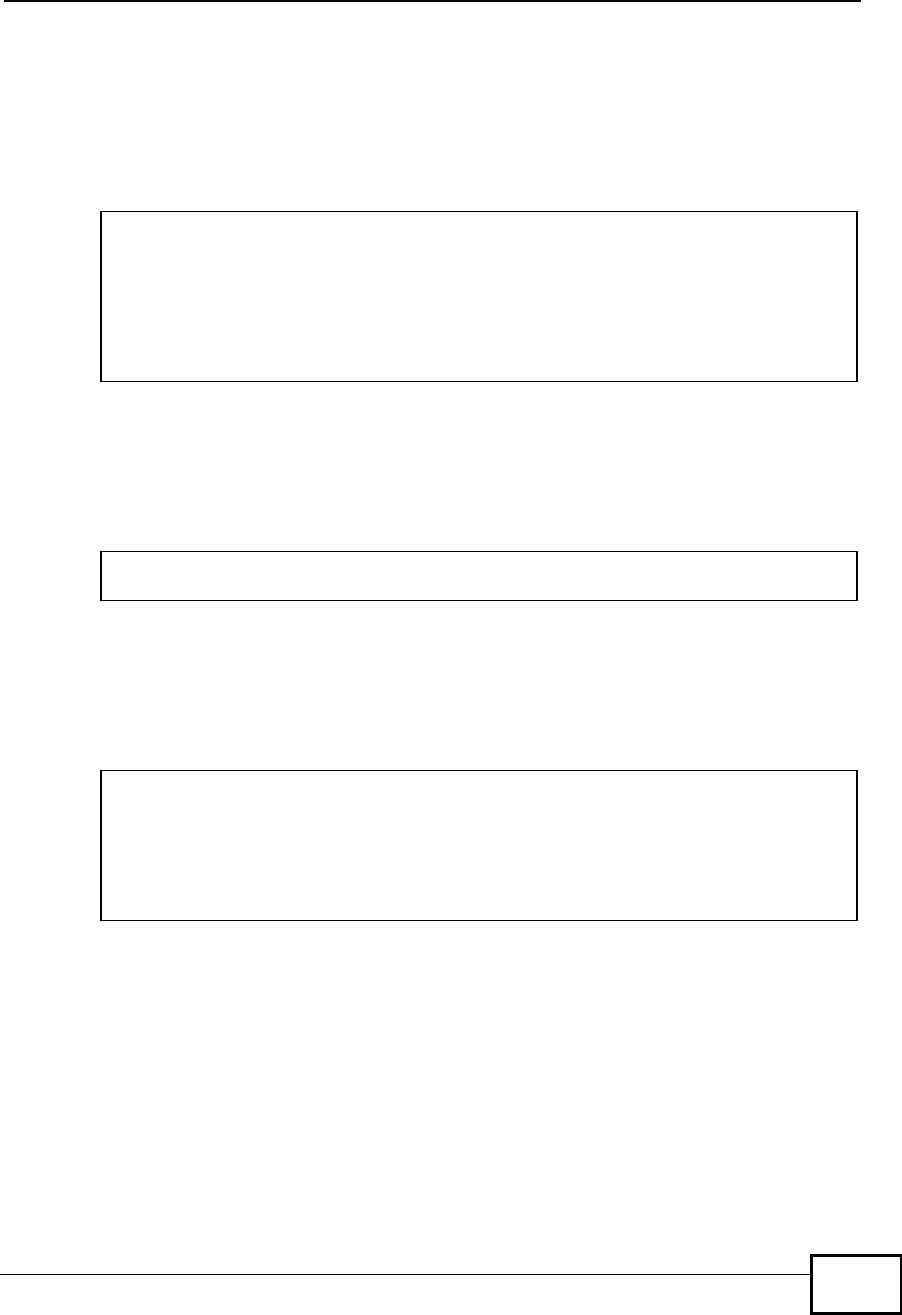
Appendix CSetting up Your Computer’s IP Address
NBG4604 User’s Guide 245
•If you have a static IP address, enter static in the BOOTPROTO= field. Type
IPADDR= followed by the IP address (in dotted decimal notation) and type
NETMASK= followed by the subnet mask. The following example shows an
example where the static IP address is 192.168.1.10 and the subnet mask is
255.255.255.0.
Figure 153 Red Hat 9.0: Static IP Address Setting in ifconfig-eth0
2If you know your DNS server IP address(es), enter the DNS server information in
the resolv.conf file in the /etc directory. The following figure shows an example
where two DNS server IP addresses are specified.
Figure 154 Red Hat 9.0: DNS Settings in resolv.conf
3After you edit and save the configuration files, you must restart the network card.
Enter./network restart in the /etc/rc.d/init.d directory. The following figure
shows an example.
Figure 155 Red Hat 9.0: Restart Ethernet Card
DEVICE=eth0
ONBOOT=yes
BOOTPROTO=static
IPADDR=192.168.1.10
NETMASK=255.255.255.0
USERCTL=no
PEERDNS=yes
TYPE=Ethernet
nameserver 172.23.5.1
nameserver 172.23.5.2
[root@localhost init.d]# network restart
Shutting down interface eth0: [OK]
Shutting down loopback interface: [OK]
Setting network parameters: [OK]
Bringing up loopback interface: [OK]
Bringing up interface eth0: [OK]
Company Confidential

Appendix CSetting up Your Computer’s IP Address
NBG4604 User’s Guide
246
27.1.1 Verifying Settings
Enter ifconfig in a terminal screen to check your TCP/IP properties.
Figure 156 Red Hat 9.0: Checking TCP/IP Properties
[root@localhost]# ifconfig
eth0 Link encap:Ethernet HWaddr 00:50:BA:72:5B:44
inet addr:172.23.19.129 Bcast:172.23.19.255 Mask:255.255.255.0
UP BROADCAST RUNNING MULTICAST MTU:1500 Metric:1
RX packets:717 errors:0 dropped:0 overruns:0 frame:0
TX packets:13 errors:0 dropped:0 overruns:0 carrier:0
collisions:0 txqueuelen:100
RX bytes:730412 (713.2 Kb) TX bytes:1570 (1.5 Kb)
Interrupt:10 Base address:0x1000
[root@localhost]#
Company Confidential
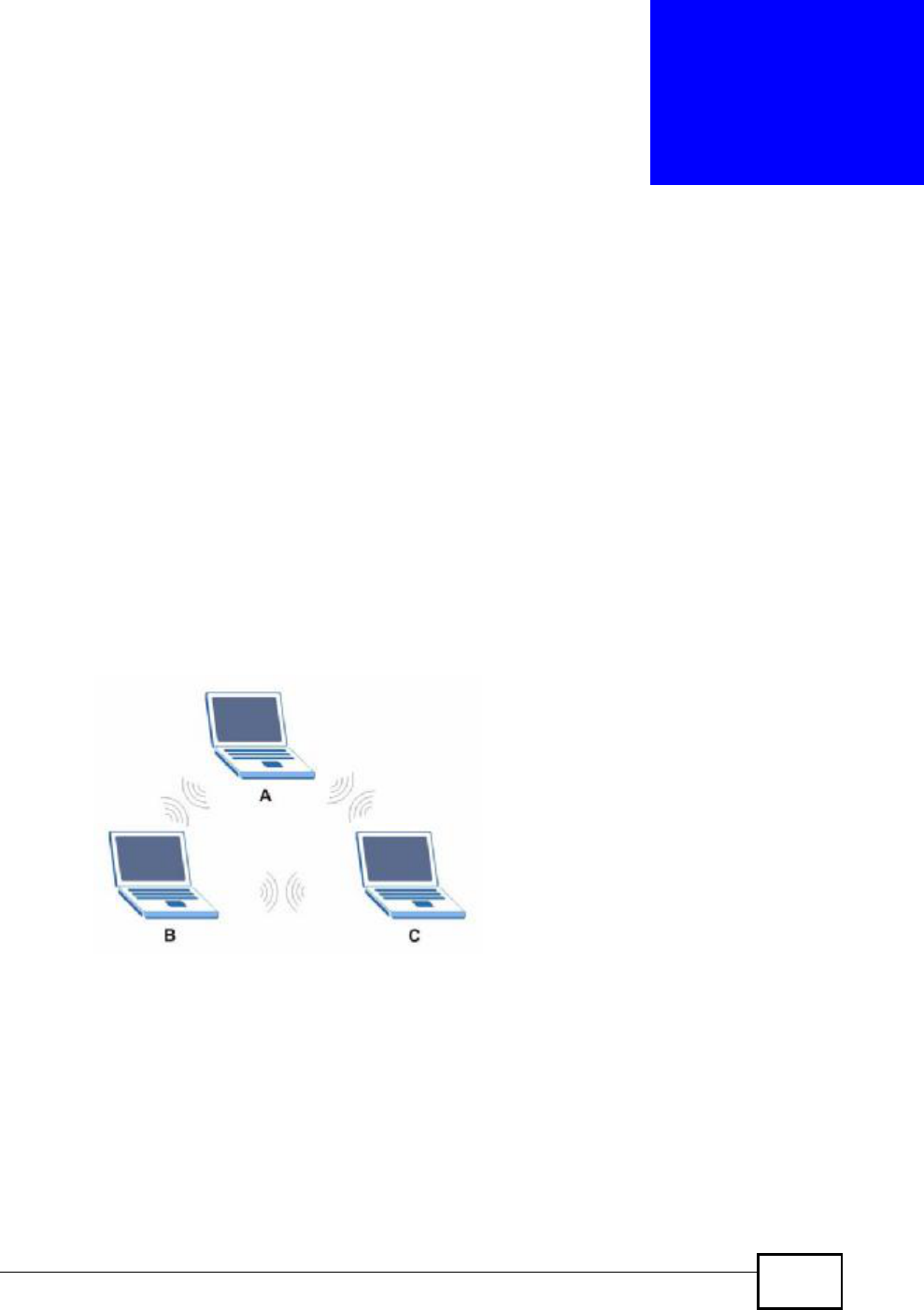
NBG4604 User’s Guide 247
APPENDIX D
Wireless LANs
Wireless LAN Topologies
This section discusses ad-hoc and infrastructure wireless LAN topologies.
Ad-hoc Wireless LAN Configuration
The simplest WLAN configuration is an independent (Ad-hoc) WLAN that connects
a set of computers with wireless stations (A, B, C). Any time two or more wireless
adapters are within range of each other, they can set up an independent network,
which is commonly referred to as an Ad-hoc network or Independent Basic Service
Set (IBSS). The following diagram shows an example of notebook computers
using wireless adapters to form an Ad-hoc wireless LAN.
Figure 157 Peer-to-Peer Communication in an Ad-hoc Network
BSS
A Basic Service Set (BSS) exists when all communications between wireless
stations or between a wireless station and a wired network client go through one
access point (AP).
Intra-BSS traffic is traffic between wireless stations in the BSS. When Intra-BSS is
enabled, wireless station A and B can access the wired network and communicate
Company Confidential
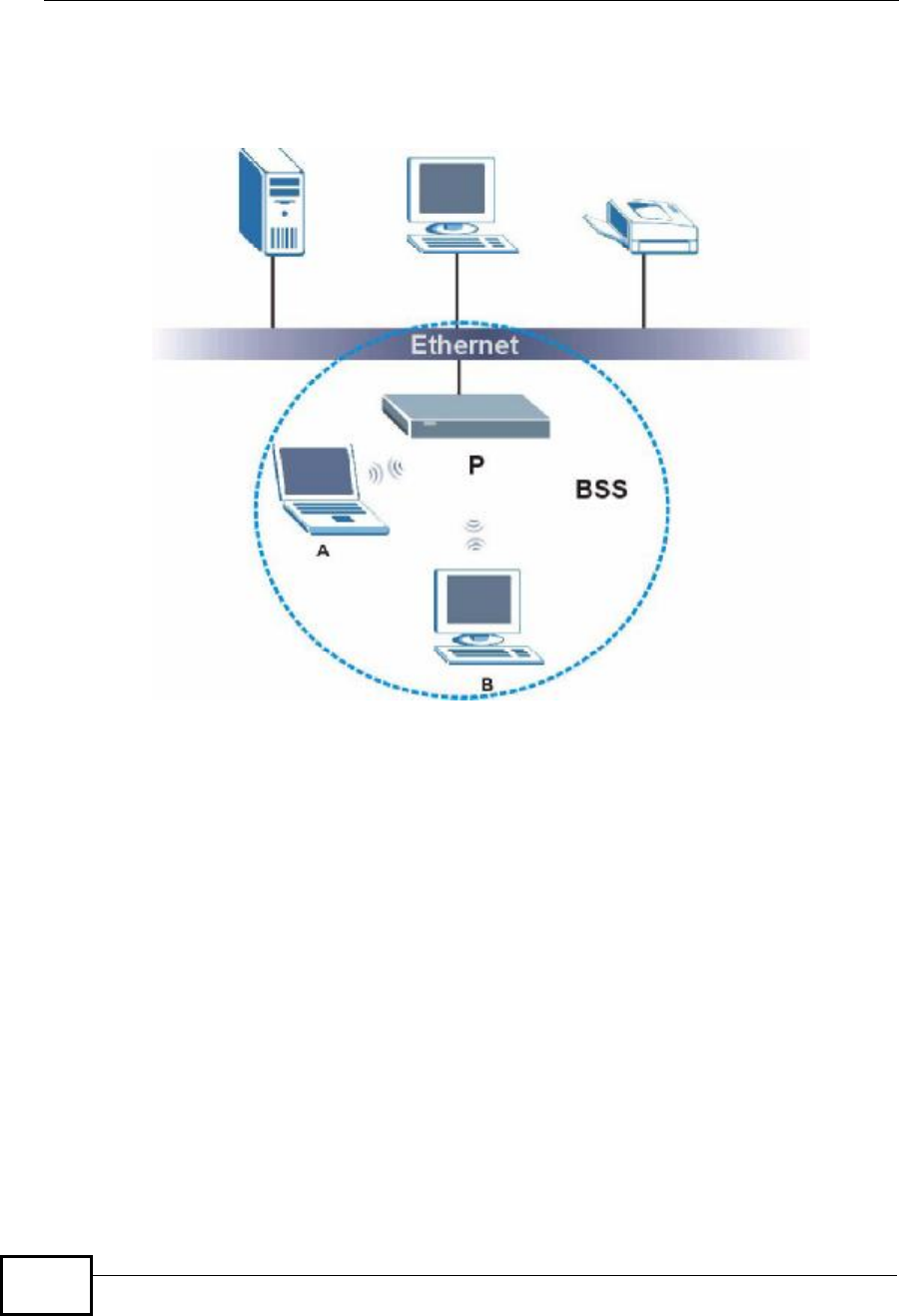
Appendix DWireless LANs
NBG4604 User’s Guide
248
with each other. When Intra-BSS is disabled, wireless station A and B can still
access the wired network but cannot communicate with each other.
Figure 158 Basic Service Set
ESS
An Extended Service Set (ESS) consists of a series of overlapping BSSs, each
containing an access point, with each access point connected together by a wired
network. This wired connection between APs is called a Distribution System (DS).
This type of wireless LAN topology is called an Infrastructure WLAN. The Access
Points not only provide communication with the wired network but also mediate
wireless network traffic in the immediate neighborhood.
Company Confidential
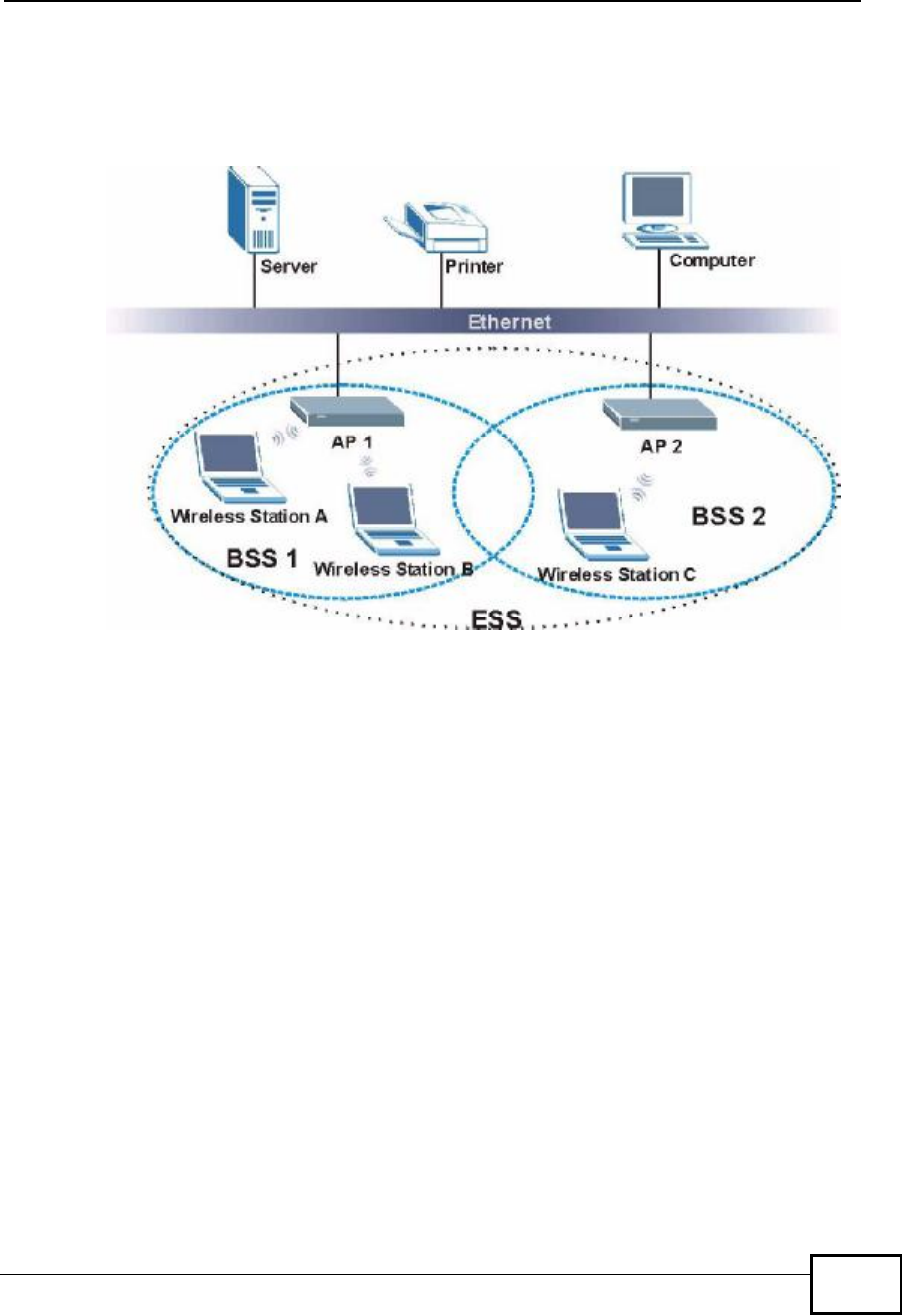
Appendix DWireless LANs
NBG4604 User’s Guide 249
An ESSID (ESS IDentification) uniquely identifies each ESS. All access points and
their associated wireless stations within the same ESS must have the same ESSID
in order to communicate.
Figure 159 Infrastructure WLAN
Channel
A channel is the radio frequency(ies) used by IEEE 802.11a/b/g wireless devices.
Channels available depend on your geographical area. You may have a choice of
channels (for your region) so you should use a different channel than an adjacent
AP (access point) to reduce interference. Interference occurs when radio signals
from different access points overlap causing interference and degrading
performance.
Adjacent channels partially overlap however. To avoid interference due to overlap,
your AP should be on a channel at least five channels away from a channel that an
adjacent AP is using. For example, if your region has 11 channels and an adjacent
AP is using channel 1, then you need to select a channel between 6 or 11.
RTS/CTS
A hidden node occurs when two stations are within range of the same access
point, but are not within range of each other. The following figure illustrates a
hidden node. Both stations (STA) are within range of the access point (AP) or
Company Confidential
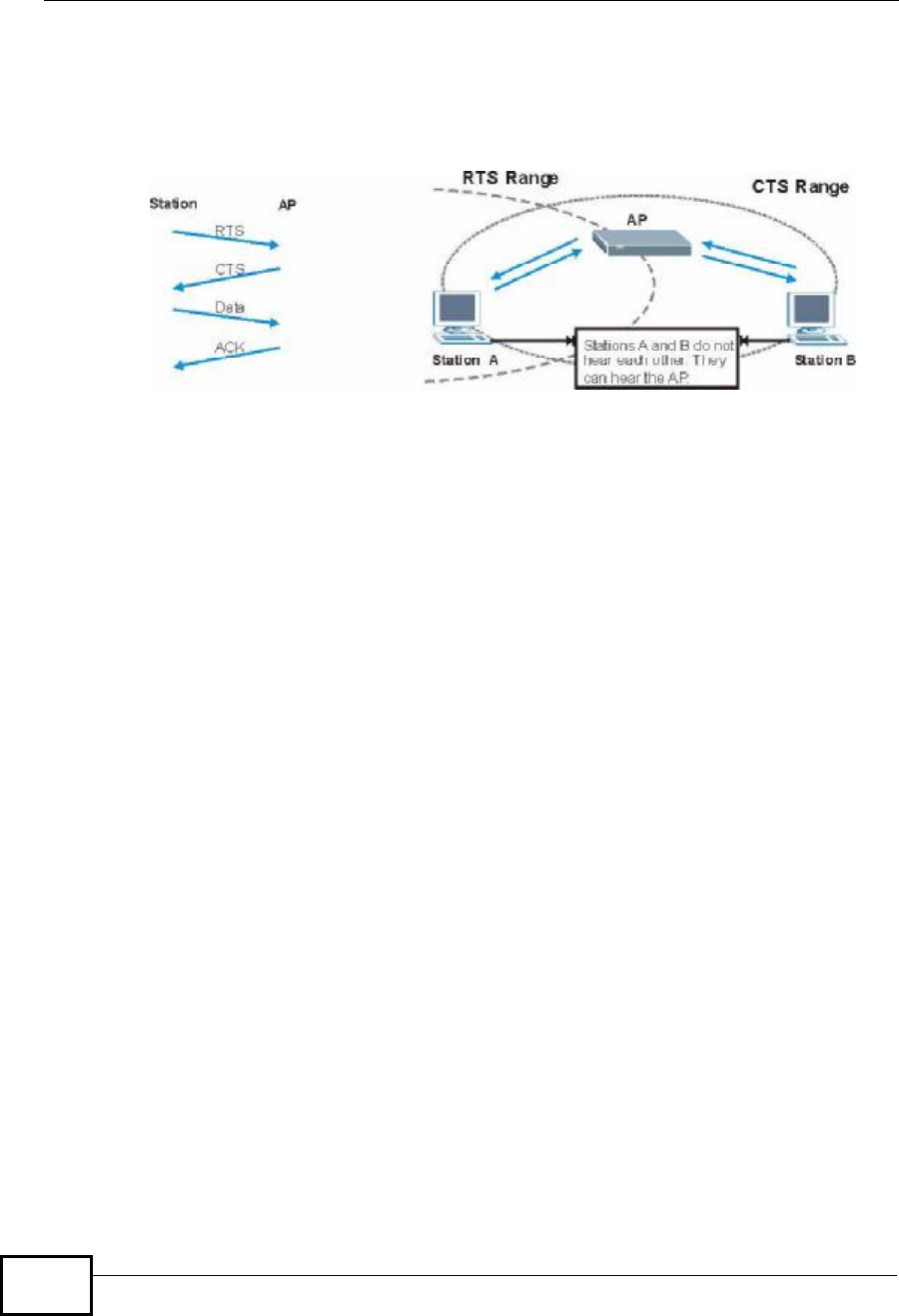
Appendix DWireless LANs
NBG4604 User’s Guide
250
wireless gateway, but out-of-range of each other, so they cannot "hear" each
other, that is they do not know if the channel is currently being used. Therefore,
they are considered hidden from each other.
Figure 160 RTS/CTS
When station A sends data to the AP, it might not know that the station B is
already using the channel. If these two stations send data at the same time,
collisions may occur when both sets of data arrive at the AP at the same time,
resulting in a loss of messages for both stations.
RTS/CTS is designed to prevent collisions due to hidden nodes. An RTS/CTS
defines the biggest size data frame you can send before an RTS (Request To
Send)/CTS (Clear to Send) handshake is invoked.
When a data frame exceeds the RTS/CTS value you set (between 0 to 2432
bytes), the station that wants to transmit this frame must first send an RTS
(Request To Send) message to the AP for permission to send it. The AP then
responds with a CTS (Clear to Send) message to all other stations within its range
to notify them to defer their transmission. It also reserves and confirms with the
requesting station the time frame for the requested transmission.
Stations can send frames smaller than the specified RTS/CTS directly to the AP
without the RTS (Request To Send)/CTS (Clear to Send) handshake.
You should only configure RTS/CTS if the possibility of hidden nodes exists on
your network and the "cost" of resending large frames is more than the extra
network overhead involved in the RTS (Request To Send)/CTS (Clear to Send)
handshake.
If the RTS/CTS value is greater than the Fragmentation Threshold value (see
next), then the RTS (Request To Send)/CTS (Clear to Send) handshake will never
occur as data frames will be fragmented before they reach RTS/CTS size.
Note: Enabling the RTS Threshold causes redundant network overhead that could
negatively affect the throughput performance instead of providing a remedy.
Company Confidential

Appendix DWireless LANs
NBG4604 User’s Guide 251
Fragmentation Threshold
AFragmentation Threshold is the maximum data fragment size (between 256
and 2432 bytes) that can be sent in the wireless network before the AP will
fragment the packet into smaller data frames.
A large Fragmentation Threshold is recommended for networks not prone to
interference while you should set a smaller threshold for busy networks or
networks that are prone to interference.
If the Fragmentation Threshold value is smaller than the RTS/CTS value (see
previously) you set then the RTS (Request To Send)/CTS (Clear to Send)
handshake will never occur as data frames will be fragmented before they reach
RTS/CTS size.
Preamble Type
A preamble is used to synchronize the transmission timing in your wireless
network. There are two preamble modes: Long and Short.
Short preamble takes less time to process and minimizes overhead, so it should
be used in a good wireless network environment when all wireless stations
support it.
Select Long if you have a ‘noisy’ network or are unsure of what preamble mode
your wireless stations support as all IEEE 802.11b compliant wireless adapters
must support long preamble. However, not all wireless adapters support short
preamble. Use long preamble if you are unsure what preamble mode the wireless
adapters support, to ensure interpretability between the AP and the wireless
stations and to provide more reliable communication in ‘noisy’ networks.
Select Dynamic to have the AP automatically use short preamble when all
wireless stations support it, otherwise the AP uses long preamble.
Note: The AP and the wireless stations MUSTuse the same preamble mode in order
to communicate.
IEEE 802.11g Wireless LAN
IEEE 802.11g is fully compatible with the IEEE 802.11b standard. This means an
IEEE 802.11b adapter can interface directly with an IEEE 802.11g access point
(and vice versa) at 11 Mbps or lower depending on range. IEEE 802.11g has
Company Confidential
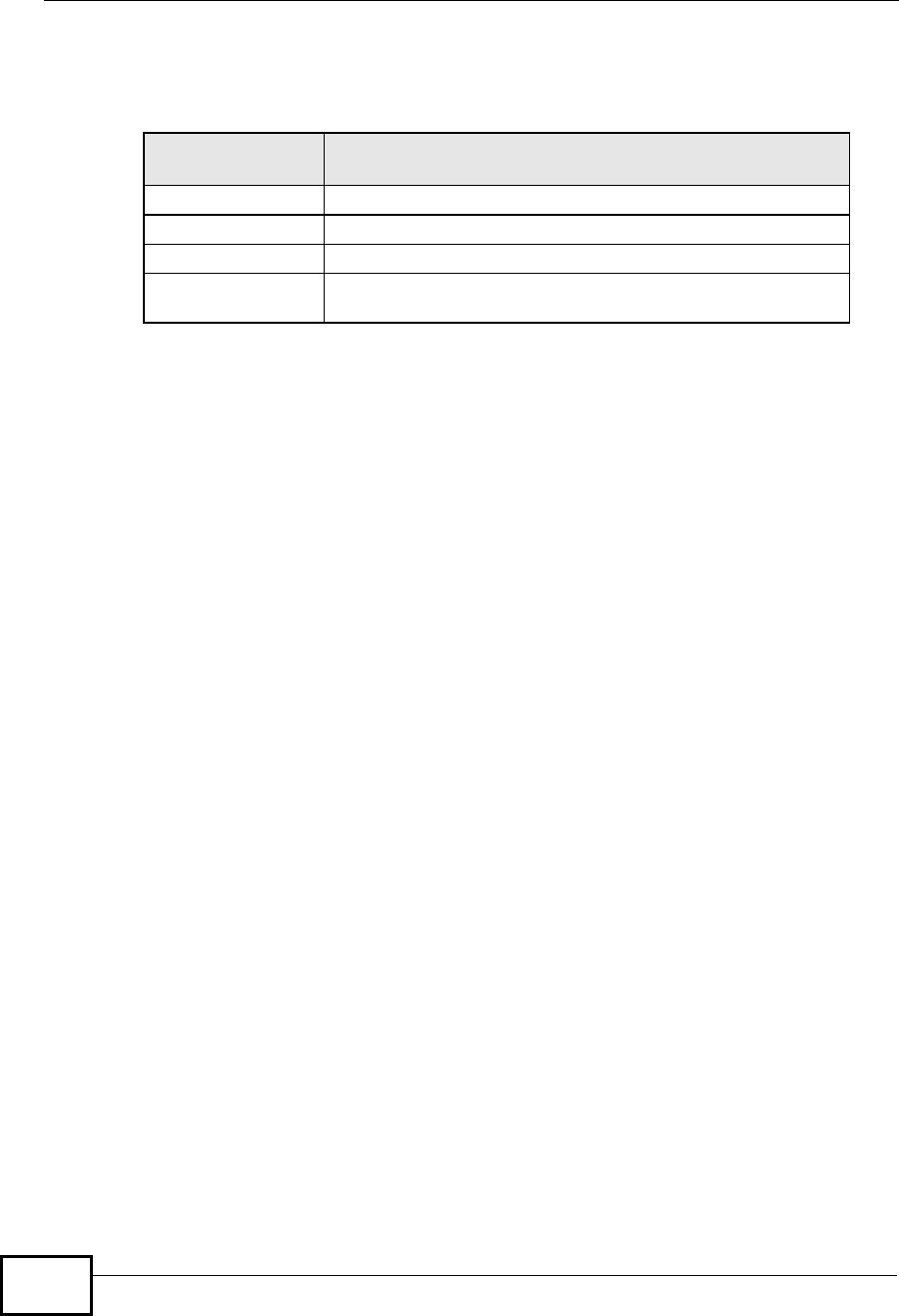
Appendix DWireless LANs
NBG4604 User’s Guide
252
several intermediate rate steps between the maximum and minimum data rates.
The IEEE 802.11g data rate and modulation are as follows:
IEEE 802.1x
In June 2001, the IEEE 802.1x standard was designed to extend the features of
IEEE 802.11 to support extended authentication as well as providing additional
accounting and control features. It is supported by Windows XP and a number of
network devices. Some advantages of IEEE 802.1x are:
•User based identification that allows for roaming.
•Support for RADIUS (Remote Authentication Dial In User Service, RFC 2138,
2139) for centralized user profile and accounting management on a network
RADIUS server.
•Support for EAP (Extensible Authentication Protocol, RFC 2486) that allows
additional authentication methods to be deployed with no changes to the access
point or the wireless stations.
RADIUS
RADIUS is based on a client-server model that supports authentication,
authorization and accounting. The access point is the client and the server is the
RADIUS server. The RADIUS server handles the following tasks:
•Authentication
Determines the identity of the users.
•Authorization
Determines the network services available to authenticated users once they are
connected to the network.
•Accounting
Keeps track of the client’s network activity.
RADIUS is a simple package exchange in which your AP acts as a message relay
between the wireless station and the network RADIUS server.
Table 84 IEEE 802.11g
DATA RATE
(MBPS) MODULATION
1DBPSK (Differential Binary Phase Shift Keyed)
2DQPSK (Differential Quadrature Phase Shift Keying)
5.5 / 11CCK (Complementary Code Keying)
6/9/12/18/24/36/
48/54 OFDM (Orthogonal Frequency Division Multiplexing)
Company Confidential

Appendix DWireless LANs
NBG4604 User’s Guide 253
Types of RADIUS Messages
The following types of RADIUS messages are exchanged between the access point
and the RADIUS server for user authentication:
•Access-Request
Sent by an access point requesting authentication.
•Access-Reject
Sent by a RADIUS server rejecting access.
•Access-Accept
Sent by a RADIUS server allowing access.
•Access-Challenge
Sent by a RADIUS server requesting more information in order to allow access.
The access point sends a proper response from the user and then sends another
Access-Request message.
The following types of RADIUS messages are exchanged between the access point
and the RADIUS server for user accounting:
•Accounting-Request
Sent by the access point requesting accounting.
•Accounting-Response
Sent by the RADIUS server to indicate that it has started or stopped accounting.
In order to ensure network security, the access point and the RADIUS server use a
shared secret key, which is a password, they both know. The key is not sent over
the network. In addition to the shared key, password information exchanged is
also encrypted to protect the network from unauthorized access.
Types of Authentication
This appendix discusses some popular authentication types: EAP-MD5,EAP-TLS,
EAP-TTLS,PEAP and LEAP.
The type of authentication you use depends on the RADIUS server or the AP.
Consult your network administrator for more information.
EAP-MD5 (Message-Digest Algorithm 5)
MD5 authentication is the simplest one-way authentication method. The
authentication server sends a challenge to the wireless station. The wireless
station ‘proves’ that it knows the password by encrypting the password with the
challenge and sends back the information. Password is not sent in plain text.
Company Confidential

Appendix DWireless LANs
NBG4604 User’s Guide
254
However, MD5 authentication has some weaknesses. Since the authentication
server needs to get the plaintext passwords, the passwords must be stored. Thus
someone other than the authentication server may access the password file. In
addition, it is possible to impersonate an authentication server as MD5
authentication method does not perform mutual authentication. Finally, MD5
authentication method does not support data encryption with dynamic session
key. You must configure WEP encryption keys for data encryption.
EAP-TLS (Transport Layer Security)
With EAP-TLS, digital certifications are needed by both the server and the wireless
stations for mutual authentication. The server presents a certificate to the client.
After validating the identity of the server, the client sends a different certificate to
the server. The exchange of certificates is done in the open before a secured
tunnel is created. This makes user identity vulnerable to passive attacks. A digital
certificate is an electronic ID card that authenticates the sender’s identity.
However, to implement EAP-TLS, you need a Certificate Authority (CA) to handle
certificates, which imposes a management overhead.
EAP-TTLS (Tunneled Transport Layer Service)
EAP-TTLS is an extension of the EAP-TLS authentication that uses certificates for
only the server-side authentications to establish a secure connection. Client
authentication is then done by sending username and password through the
secure connection, thus client identity is protected. For client authentication, EAP-
TTLS supports EAP methods and legacy authentication methods such as PAP,
CHAP, MS-CHAP and MS-CHAP v2.
PEAP (Protected EAP)
Like EAP-TTLS, server-side certificate authentication is used to establish a secure
connection, then use simple username and password methods through the
secured connection to authenticate the clients, thus hiding client identity.
However, PEAP only supports EAP methods, such as EAP-MD5, EAP-MSCHAPv2
and EAP-GTC (EAP-Generic Token Card), for client authentication. EAP-GTC is
implemented only by Cisco.
LEAP
LEAP (Lightweight Extensible Authentication Protocol) is a Cisco implementation of
IEEE 802.1x.
Dynamic WEP Key Exchange
The AP maps a unique key that is generated with the RADIUS server. This key
expires when the wireless connection times out, disconnects or reauthentication
times out. A new WEP key is generated each time reauthentication is performed.
Company Confidential
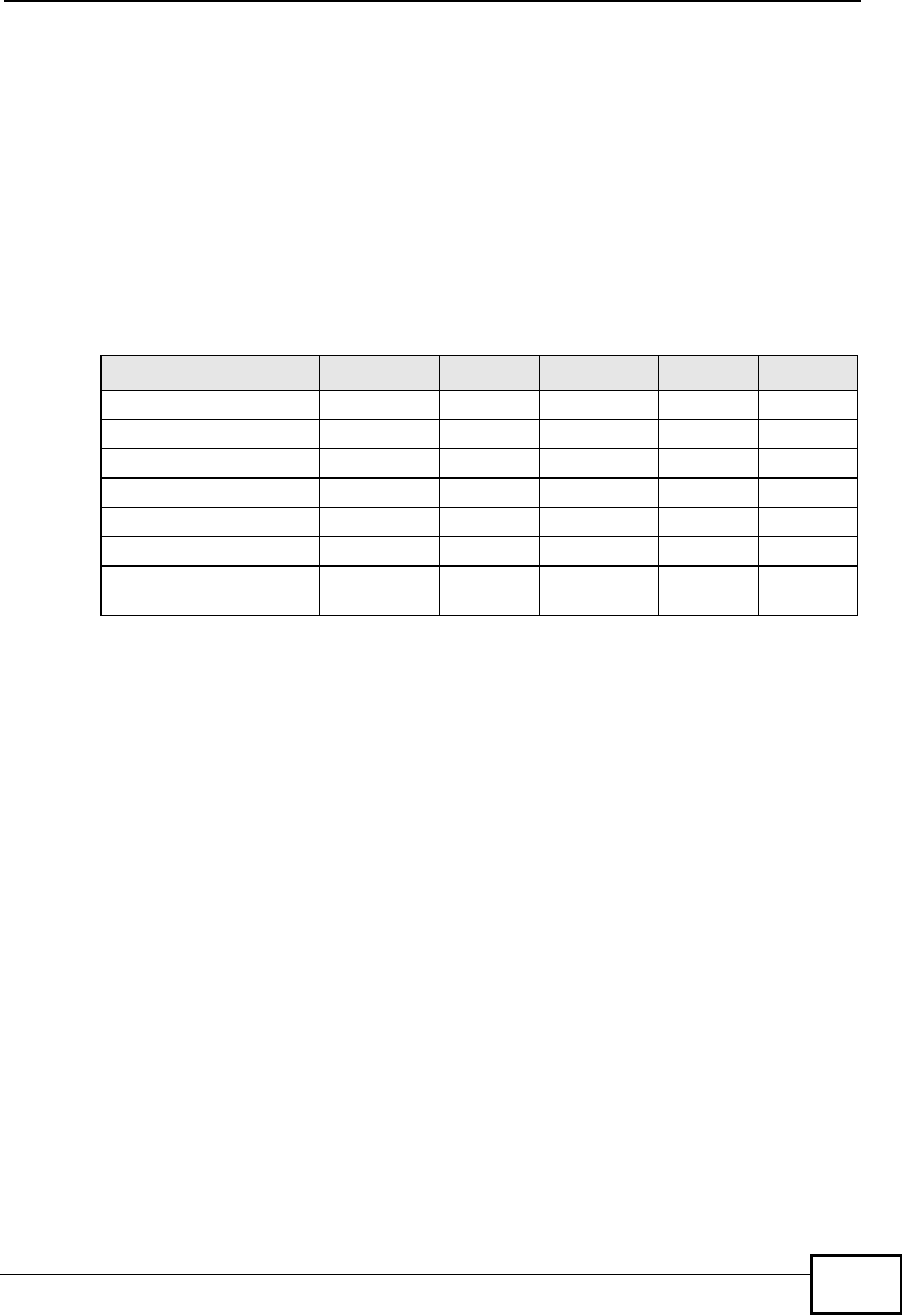
Appendix DWireless LANs
NBG4604 User’s Guide 255
If this feature is enabled, it is not necessary to configure a default encryption key
in the Wireless screen. You may still configure and store keys here, but they will
not be used while Dynamic WEP is enabled.
Note: EAP-MD5 cannot be used with dynamic WEP key exchange
For added security, certificate-based authentications (EAP-TLS, EAP-TTLS and
PEAP) use dynamic keys for data encryption. They are often deployed in corporate
environments, but for public deployment, a simple user name and password pair
is more practical. The following table is a comparison of the features of
authentication types.
WPA(2)
Wi-Fi Protected Access (WPA) is a subset of the IEEE 802.11i standard. WPA2
(IEEE 802.11i) is a wireless security standard that defines stronger encryption,
authentication and key management than WPA.
Key differences between WPA(2) and WEP are improved data encryption and user
authentication.
Encryption
Both WPA and WPA2 improve data encryption by using Temporal Key Integrity
Protocol (TKIP), Message Integrity Check (MIC) and IEEE 802.1x. In addition to
TKIP, WPA2 also uses Advanced Encryption Standard (AES) in the Counter mode
with Cipher block chaining Message authentication code Protocol (CCMP) to offer
stronger encryption.
Temporal Key Integrity Protocol (TKIP) uses 128-bit keys that are dynamically
generated and distributed by the authentication server. It includes a per-packet
key mixing function, a Message Integrity Check (MIC) named Michael, an
extended initialization vector (IV) with sequencing rules, and a re-keying
mechanism.
Table 85 Comparison of EAP Authentication Types
EAP-MD5 EAP-TLS EAP-TTLS PEAP LEAP
Mutual Authentication No Yes Yes Yes Yes
Certificate – Client No Yes Optional Optional No
Certificate – Server No Yes Yes Yes No
Dynamic Key Exchange No Yes Yes Yes Yes
Credential Integrity None Strong Strong Strong Moderate
Deployment Difficulty Easy Hard Moderate Moderate Moderate
Client Identity
Protection No No Yes Yes No
Company Confidential

Appendix DWireless LANs
NBG4604 User’s Guide
256
TKIP regularly changes and rotates the encryption keys so that the same
encryption key is never used twice. The RADIUS server distributes a Pairwise
Master Key (PMK) key to the AP that then sets up a key hierarchy and
management system, using the pair-wise key to dynamically generate unique data
encryption keys to encrypt every data packet that is wirelessly communicated
between the AP and the wireless clients. This all happens in the background
automatically.
WPA2 AES (Advanced Encryption Standard) is a block cipher that uses a 256-bit
mathematical algorithm called Rijndael.
The Message Integrity Check (MIC) is designed to prevent an attacker from
capturing data packets, altering them and resending them. The MIC provides a
strong mathematical function in which the receiver and the transmitter each
compute and then compare the MIC. If they do not match, it is assumed that the
data has been tampered with and the packet is dropped.
By generating unique data encryption keys for every data packet and by creating
an integrity checking mechanism (MIC), TKIP makes it much more difficult to
decode data on a Wi-Fi network than WEP, making it difficult for an intruder to
break into the network.
The encryption mechanisms used for WPA and WPA-PSK are the same. The only
difference between the two is that WPA-PSK uses a simple common password,
instead of user-specific credentials. The common-password approach makes WPA-
PSK susceptible to brute-force password-guessing attacks but it's still an
improvement over WEP as it employs an easier-to-use, consistent, single,
alphanumeric password.
User Authentication
WPA or WPA2 applies IEEE 802.1x and Extensible Authentication Protocol (EAP) to
authenticate wireless clients using an external RADIUS database.
If both an AP and the wireless clients support WPA2 and you have an external
RADIUS server, use WPA2 for stronger data encryption. If you don't have an
external RADIUS server, you should use WPA2 -PSK (WPA2 -Pre-Shared Key) that
only requires a single (identical) password entered into each access point, wireless
gateway and wireless client. As long as the passwords match, a wireless client will
be granted access to a WLAN.
If the AP or the wireless clients do not support WPA2, just use WPA or WPA-PSK
depending on whether you have an external RADIUS server or not.
Select WEP only when the AP and/or wireless clients do not support WPA or WPA2.
WEP is less secure than WPA or WPA2.
Company Confidential
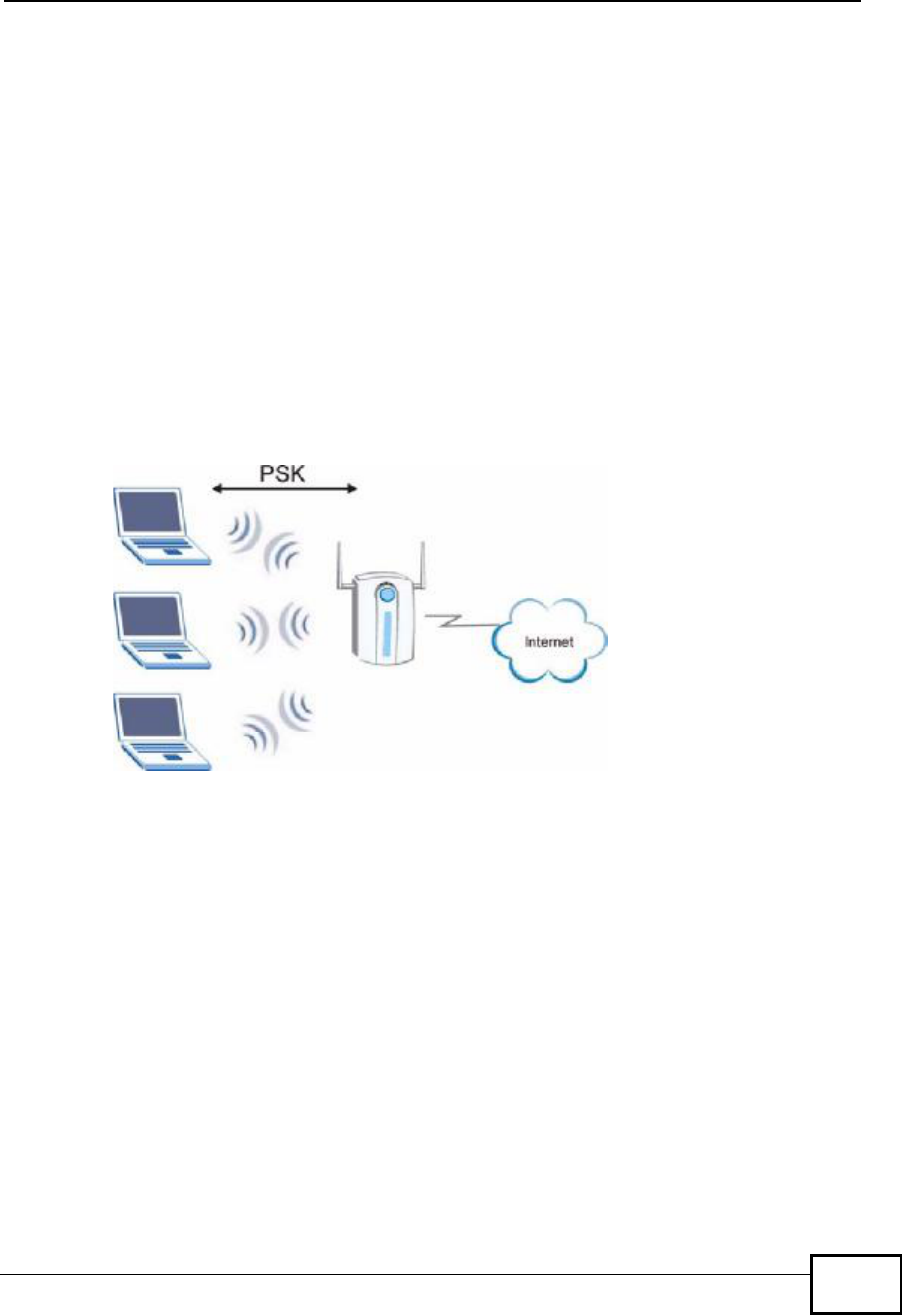
Appendix DWireless LANs
NBG4604 User’s Guide 257
27.1.2 WPA(2)-PSK Application Example
A WPA(2)-PSK application looks as follows.
1First enter identical passwords into the AP and all wireless clients. The Pre-Shared
Key (PSK) must consist of between 8 and 63 ASCII characters (including spaces
and symbols).
2The AP checks each wireless client's password and (only) allows it to join the
network if the password matches.
3The AP derives and distributes keys to the wireless clients.
4The AP and wireless clients use the TKIP or AES encryption process to encrypt
data exchanged between them.
Figure 161 WPA(2)-PSK Authentication
27.1.3 WPA(2) with RADIUS Application Example
You need the IP address of the RADIUS server, its port number (default is 1812),
and the RADIUS shared secret. A WPA(2) application example with an external
RADIUS server looks as follows. "A" is the RADIUS server. "DS" is the distribution
system.
1The AP passes the wireless client's authentication request to the RADIUS server.
2The RADIUS server then checks the user's identification against its database and
grants or denies network access accordingly.
3The RADIUS server distributes a Pairwise Master Key (PMK) key to the AP that
then sets up a key hierarchy and management system, using the pair-wise key to
dynamically generate unique data encryption keys to encrypt every data packet
that is wirelessly communicated between the AP and the wireless clients.
Company Confidential
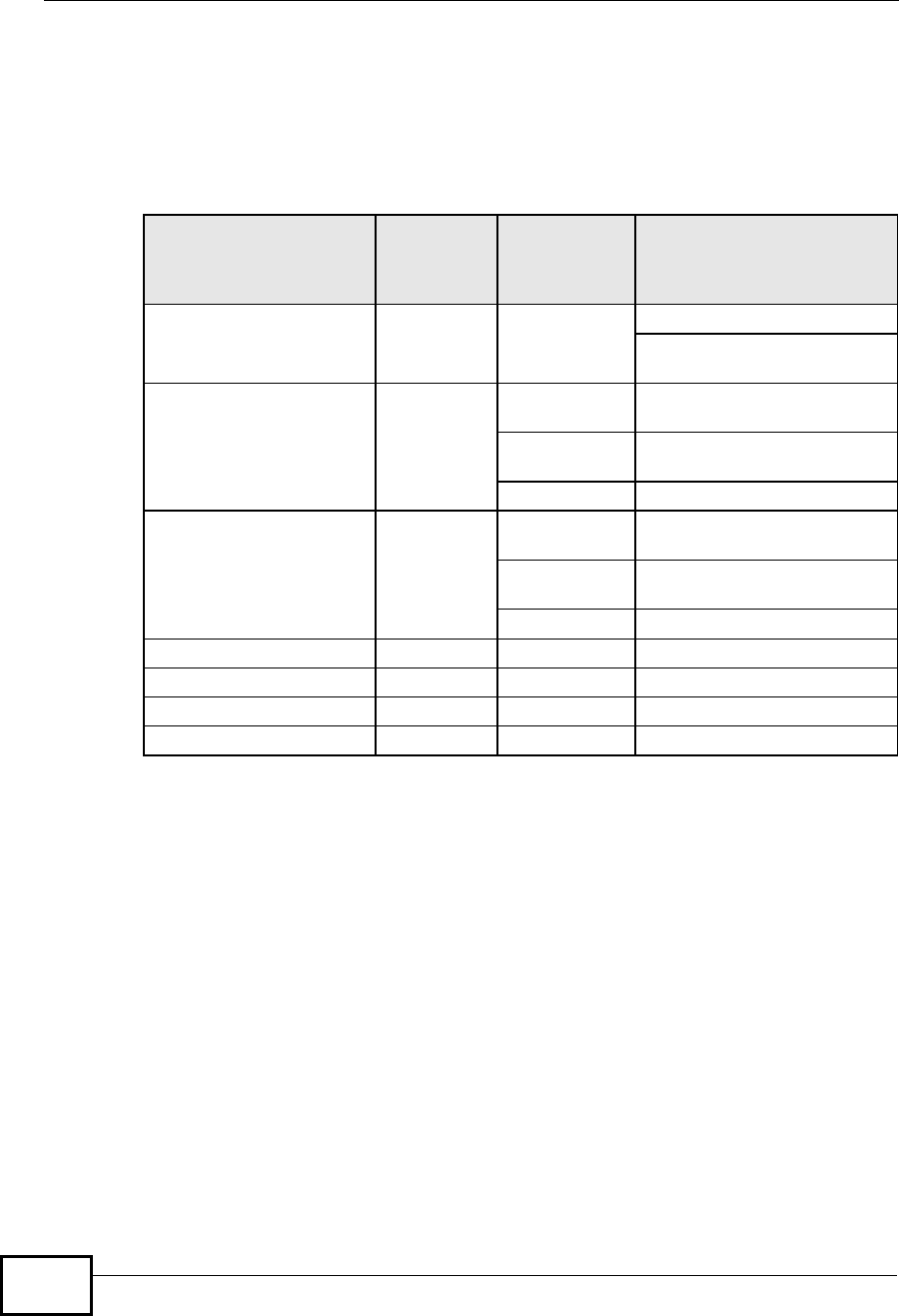
Appendix DWireless LANs
NBG4604 User’s Guide
258
Security Parameters Summary
Refer to this table to see what other security parameters you should configure for
each Authentication Method/ key management protocol type. MAC address filters
are not dependent on how you configure these security features.
Table 86 Wireless Security Relational Matrix
AUTHENTICATION
METHOD/ KEY
MANAGEMENT
PROTOCOL
ENCRYPTIO
N METHOD ENTER
MANUAL KEY IEEE 802.1X
OpenNoneNoDisable
Enable without Dynamic WEP
Key
Open WEP No Enable with Dynamic WEP
Key
Yes Enable without Dynamic WEP
Key
Yes Disable
Shared WEP No Enable with Dynamic WEP
Key
Yes Enable without Dynamic WEP
Key
Yes Disable
WPA TKIP No Enable
WPA-PSK TKIP Yes Enable
WPA2 AES No Enable
WPA2-PSK AES Yes Enable
Company Confidential
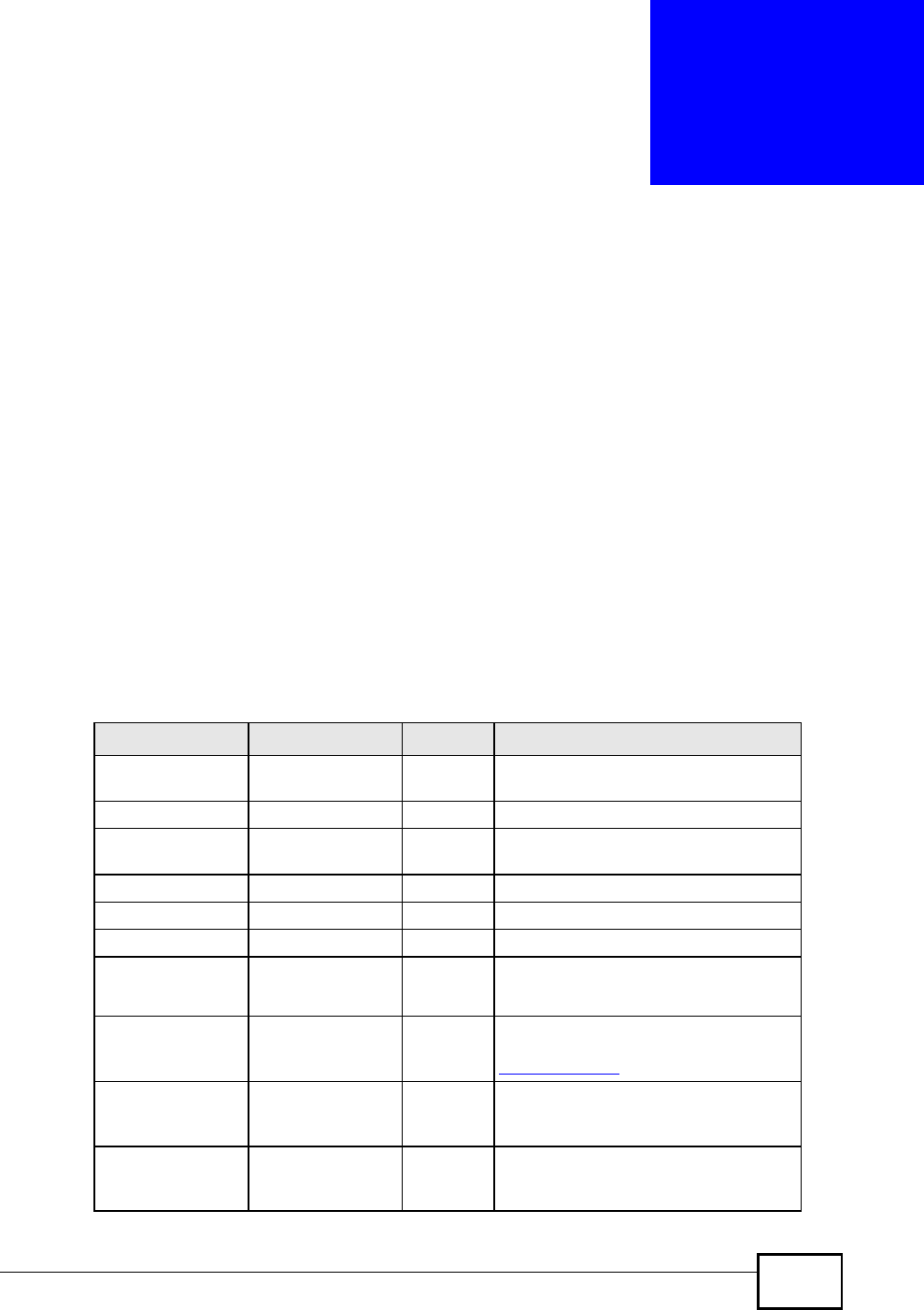
NBG4604 User’s Guide 259
APPENDIX E
Services
The following table lists some commonly-used services and their associated
protocols and port numbers.
•Name: This is a short, descriptive name for the service. You can use this one or
create a different one, if you like.
•Protocol: This is the type of IP protocol used by the service. If this is TCP/
UDP, then the service uses the same port number with TCP and UDP. If this is
User-Defined, the Port(s) is the IP protocol number, not the port number.
•Port(s): This value depends on the Protocol.
•If the Protocol is TCP,UDP, or TCP/UDP, this is the IP port number.
•If the Protocol is USER, this is the IP protocol number.
•Description: This is a brief explanation of the applications that use this service
or the situations in which this service is used.
Table 87 Examples of Services
NAME PROTOCOL PORT(S) DESCRIPTION
AH
(IPSEC_TUNNEL) User-Defined 51 The IPSEC AH (Authentication Header)
tunneling protocol uses this service.
AIM TCP 5190 AOL’s Internet Messenger service.
AUTH TCP 113 Authentication protocol used by some
servers.
BGP TCP 179 Border Gateway Protocol.
BOOTP_CLIENT UDP 68 DHCP Client.
BOOTP_SERVER UDP 67 DHCP Server.
CU-SEEME TCP/UDP
TCP/UDP
7648
24032
A popular videoconferencing solution
from White Pines Software.
DNS TCP/UDP 53 Domain Name Server, a service that
matches web names (e.g.
www.zyxel.com) to IP numbers.
ESP
(IPSEC_TUNNEL) User-Defined 50 The IPSEC ESP (Encapsulation
Security Protocol) tunneling protocol
uses this service.
FINGER TCP 79 Finger is a UNIX or Internet related
command that can be used to find out
if a user is logged on.
Company Confidential
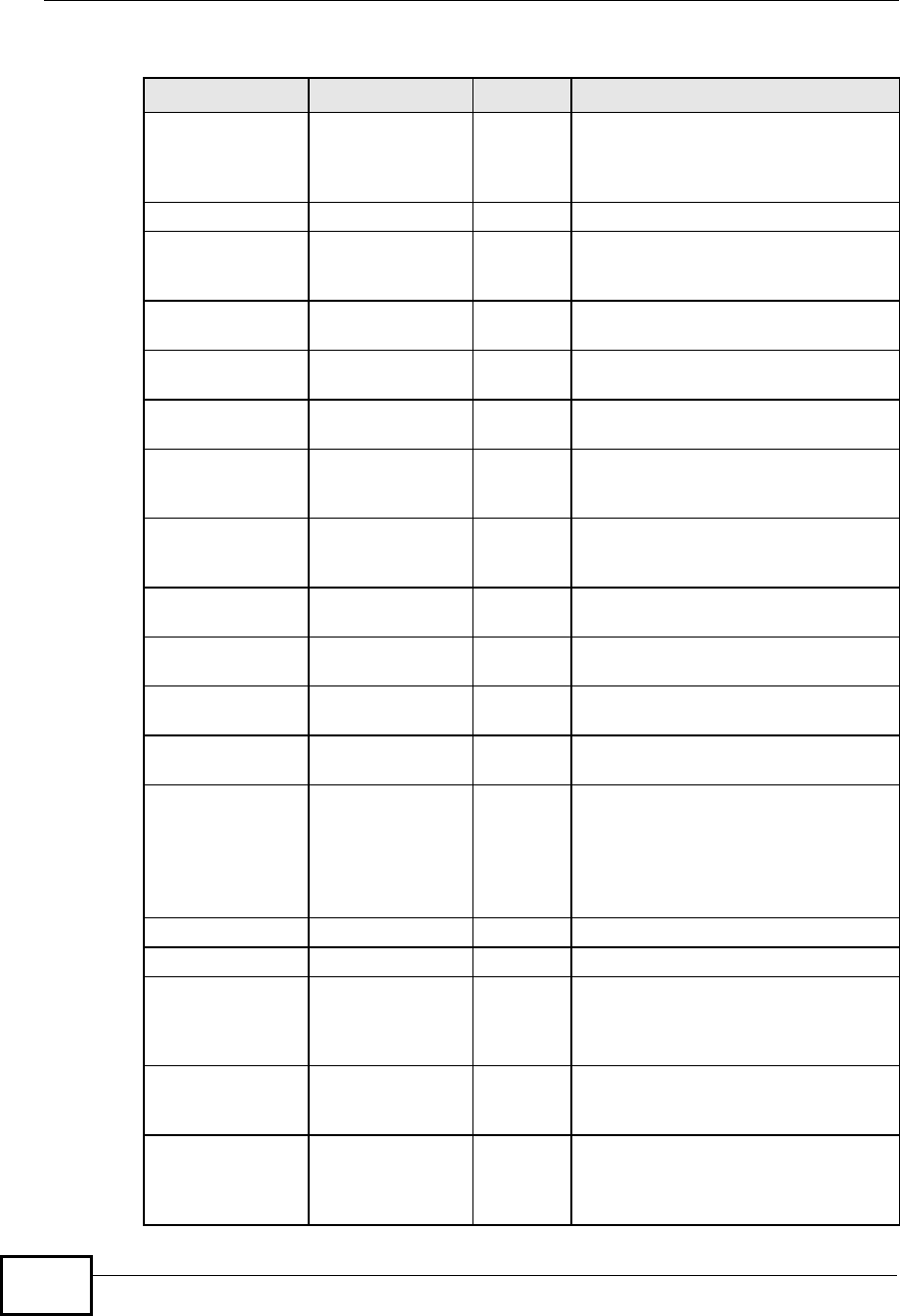
Appendix EServices
NBG4604 User’s Guide
260
FTP TCP
TCP
20
21
File Transfer Program, a program to
enable fast transfer of files, including
large files that may not be possible by
e-mail.
H.323 TCP 1720 NetMeeting uses this protocol.
HTTP TCP 80 Hyper Text Transfer Protocol - a client/
server protocol for the world wide
web.
HTTPS TCP 443 HTTPS is a secured http session often
used in e-commerce.
ICMP User-Defined 1 Internet Control Message Protocol is
often used for diagnostic purposes.
ICQ UDP 4000 This is a popular Internet chat
program.
IGMP
(MULTICAST) User-Defined 2 Internet Group Multicast Protocol is
used when sending packets to a
specific group of hosts.
IKE UDP 500 The Internet Key Exchange algorithm
is used for key distribution and
management.
IMAP4 TCP 143 The Internet Message Access Protocol
is used for e-mail.
IMAP4S TCP 993 This is a more secure version of IMAP4
that runs over SSL.
IRC TCP/UDP 6667 This is another popular Internet chat
program.
MSN Messenger TCP 1863 Microsoft Networks’ messenger
service uses this protocol.
NetBIOS TCP/UDP
TCP/UDP
TCP/UDP
TCP/UDP
137
138
139
445
The Network Basic Input/Output
System is used for communication
between computers in a LAN.
NEW-ICQ TCP 5190 An Internet chat program.
NEWS TCP 144 A protocol for news groups.
NFS UDP 2049 Network File System - NFS is a client/
server distributed file service that
provides transparent file sharing for
network environments.
NNTP TCP 119 Network News Transport Protocol is
the delivery mechanism for the
USENET newsgroup service.
PING User-Defined 1 Packet INternet Groper is a protocol
that sends out ICMP echo requests to
test whether or not a remote host is
reachable.
Table 87 Examples of Services (continued)
NAME PROTOCOL PORT(S) DESCRIPTION
Company Confidential

Appendix EServices
NBG4604 User’s Guide 261
POP3 TCP 110 Post Office Protocol version 3 lets a
client computer get e-mail from a
POP3 server through a temporary
connection (TCP/IP or other).
POP3S TCP 995 This is a more secure version of POP3
that runs over SSL.
PPTP TCP 1723 Point-to-Point Tunneling Protocol
enables secure transfer of data over
public networks. This is the control
channel.
PPTP_TUNNEL
(GRE) User-Defined 47 PPTP (Point-to-Point Tunneling
Protocol) enables secure transfer of
data over public networks. This is the
data channel.
RCMD TCP 512 Remote Command Service.
REAL_AUDIO TCP 7070 A streaming audio service that
enables real time sound over the web.
REXEC TCP 514 Remote Execution Daemon.
RLOGIN TCP 513 Remote Login.
ROADRUNNER TCP/UDP 1026 This is an ISP that provides services
mainly for cable modems.
RTELNET TCP 107 Remote Telnet.
RTSP TCP/UDP 554 The Real Time Streaming (media
control) Protocol (RTSP) is a remote
control for multimedia on the
Internet.
SFTP TCP 115 The Simple File Transfer Protocol is an
old way of transferring files between
computers.
SMTP TCP 25 Simple Mail Transfer Protocol is the
message-exchange standard for the
Internet. SMTP enables you to move
messages from one e-mail server to
another.
SMTPS TCP 465 This is a more secure version of SMTP
that runs over SSL.
SNMP TCP/UDP 161 Simple Network Management
Program.
SNMP-TRAPS TCP/UDP 162 Traps for use with the SNMP
(RFC:1215).
SQL-NET TCP 1521 Structured Query Language is an
interface to access data on many
different types of database systems,
including mainframes, midrange
systems, UNIX systems and network
servers.
Table 87 Examples of Services (continued)
NAME PROTOCOL PORT(S) DESCRIPTION
Company Confidential
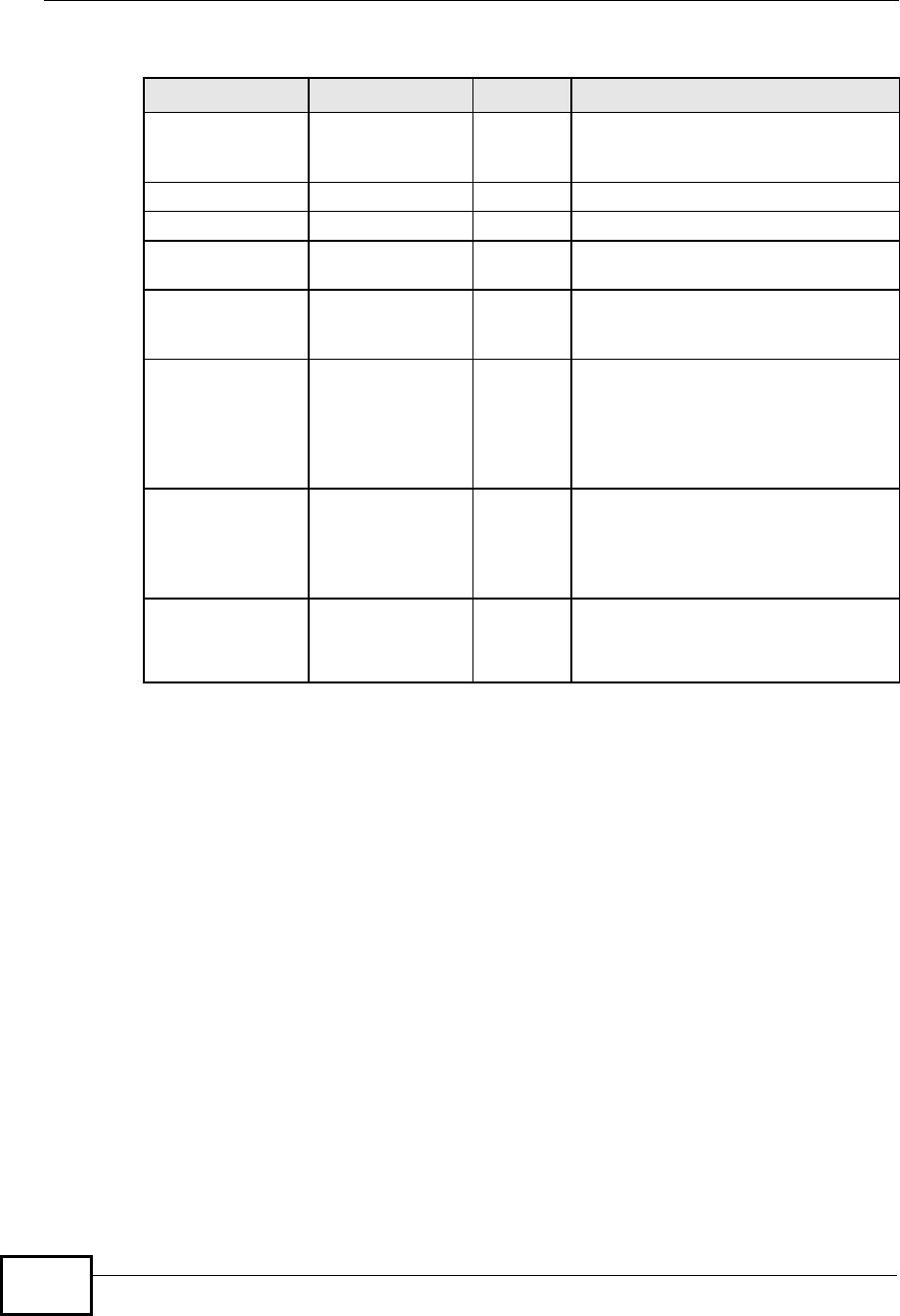
Appendix EServices
NBG4604 User’s Guide
262
SSDP UDP 1900 The Simple Service Discovery Protocol
supports Universal Plug-and-Play
(UPnP).
SSH TCP/UDP 22 Secure Shell Remote Login Program.
STRM WORKS UDP 1558 Stream Works Protocol.
SYSLOG UDP 514 Syslog allows you to send system logs
to a UNIX server.
TACACS UDP 49 Login Host Protocol used for (Terminal
Access Controller Access Control
System).
TELNET TCP 23 Telnet is the login and terminal
emulation protocol common on the
Internet and in UNIX environments. It
operates over TCP/IP networks. Its
primary function is to allow users to
log into remote host systems.
TFTP UDP 69 Trivial File Transfer Protocol is an
Internet file transfer protocol similar
to FTP, but uses the UDP (User
Datagram Protocol) rather than TCP
(Transmission Control Protocol).
VDOLIVE TCP
UDP
7000
user-
defined
A videoconferencing solution. The UDP
port number is specified in the
application.
Table 87 Examples of Services (continued)
NAME PROTOCOL PORT(S) DESCRIPTION
Company Confidential

STB-2101H User’s Guide 263
APPENDIX F
Open Software Announcements
End-User License Agreement for “NBG4604”
WARNING: ZyXEL Communications Corp. IS WILLING TO LICENSE THE SOFTWARE TO YOU ONLY UPON THE
CONDITION THAT YOU ACCEPT ALL OF THE TERMS CONTAINED IN THIS LICENSE AGREEMENT. PLEASE
READ THE TERMS CAREFULLY BEFORE COMPLETING THE INSTALLATION PROCESS AS INSTALLING THE
SOFTWARE WILL INDICATE YOUR ASSENT TO THEM. IF YOU DO NOT AGREE TO THESE TERMS, THEN ZyXEL,
IS UNWILLING TO LICENSE THE SOFTWARE TO YOU, IN WHICH EVENT YOU SHOULD RETURN THE UNIN-
STALLED SOFTWARE AND PACKAGING TO THE PLACE FROM WHICH IT WAS ACQUIRED OR ZyXEL, AND YOUR
MONEY WILL BE REFUNDED.
1.Grant of License for Personal Use
ZyXEL Communications Corp. ("ZyXEL") grants you a non-exclusive, non-sublicense, non-transferable license to use the pro-
gram with which this license is distributed (the "Software"), including any documentation files accompanying the Software
("Documentation"), for internal business use only, for up to the number of users specified in sales order and invoice. You have the
right to make one backup copy of the Software and Documentation solely for archival, back-up or disaster recovery purposes.
You shall not exceed the scope of the license granted hereunder. Any rights not expressly granted by ZyXEL to you are reserved
by ZyXEL, and all implied licenses are disclaimed.
2.Ownership
You have no ownership rights in the Software. Rather, you have a license to use the Software as long as this License Agreement
remains in full force and effect. Ownership of the Software, Documentation and all intellectual property rights therein shall
remain at all times with ZyXEL. Any other use of the Software by any other entity is strictly forbidden and is a violation of this
License Agreement.
3.Copyright
The Software and Documentation contain material that is protected by International Copyright Law and trade secret law, and by
international treaty provisions. All rights not granted to you herein are expressly reserved by ZyXEL. You may not remove any
proprietary notice of ZyXEL or any of its licensors from any copy of the Software or Documentation.
4.Restrictions
You may not publish, display, disclose, sell, rent, lease, modify, store, loan, distribute, or create derivative works of the Software,
or any part thereof. You may not assign, sublicense, convey or otherwise transfer, pledge as security or otherwise encumber the
rights and licenses granted hereunder with respect to the Software. Certain components of the Software, and third party open
source programs included with the Software, have been or may be made available by ZyXEL listed in the below Table (collec-
tively the “Open-Sourced Components”) You may modify or replace only these Open-Sourced Components; provided that you
comply with the terms of this License and any applicable licensing terms governing use of the Open-Sourced Components, which
have been provided on the License Notice as below for the Software. ZyXEL is not obligated to provide any maintenance, techni-
cal or other support for the resultant modified Software. You may not copy, reverse engineer, decompile, reverse compile, trans-
late, adapt, or disassemble the Software, or any part thereof, nor shall you attempt to create the source code from the object code
for the Software. Except as and only to the extent expressly permitted in this License, by applicable licensing terms governing use
of the Open-Sourced Components, or by applicable law, you may not market, co-brand, private label or otherwise permit third
parties to link to the Software, or any part thereof. You may not use the Software, or any part thereof, in the operation of a service
bureau or for the benefit of any other person or entity. You may not cause, assist or permit any third party to do any of the forego-
Company Confidential

Appendix FOpen Software Announcements
STB-2101H User’s Guide
264
ing. Portions of the Software utilize or include third party software and other copyright material. Acknowledgements, licensing
terms and disclaimers for such material are contained in the License Notice as below for the Software, and your use of such mate-
rial is governed by their respective terms. ZyXEL has provided, as part of the Software package, access to certain third party soft-
ware as a convenience. To the extent that the Software contains third party software, ZyXEL has no express or implied obligation
to provide any technical or other support for such software. Please contact the appropriate software vendor or manufacturer
directly for technical support and customer service related to its software and products.
5.Confidentiality
You acknowledge that the Software contains proprietary trade secrets of ZyXEL and you hereby agree to maintain the confidenti-
ality of the Software using at least as great a degree of care as you use to maintain the confidentiality of your own most confiden-
tial information. You agree to reasonably communicate the terms and conditions of this License Agreement to those persons
employed by you who come into contact with the Software, and to use reasonable best efforts to ensure their compliance with
such terms and conditions, including, without limitation, not knowingly permitting such persons to use any portion of the Soft-
ware for the purpose of deriving the source code of the Software.
6.No Warranty
THE SOFTWARE IS PROVIDED "AS IS." TO THE MAXIMUM EXTENT PERMITTED BY LAW, ZyXEL DISCLAIMS
ALL WARRANTIES OF ANY KIND, EITHER EXPRESSED OR IMPLIED, INCLUDING, WITHOUT LIMITATION,
IMPLIED WARRANTIES OF MERCHANTABILITY AND FITNESS FOR A PARTICULAR PURPOSE. ZyXEL DOES NOT
WARRANT THAT THE FUNCTIONS CONTAINED IN THE SOFTWARE WILL MEET ANY REQUIREMENTS OR NEEDS
YOU MAY HAVE, OR THAT THE SOFTWARE WILL OPERATE ERROR FREE, OR IN AN UNINTERUPTED FASHION,
OR THAT ANY DEFECTS OR ERRORS IN THE SOFTWARE WILL BE CORRECTED, OR THAT THE SOFTWARE IS
COMPATIBLE WITH ANY PARTICULAR PLATFORM. SOME JURISDICTIONS DO NOT ALLOW THE WAIVER OR
EXCLUSION OF IMPLIED WARRANTIES SO THEY MAY NOT APPLY TO YOU. IF THIS EXCLUSION IS HELD TO BE
UNENFORCEABLE BY A COURT OF COMPETENT JURISDICTION, THEN ALL EXPRESS AND IMPLIED WARRAN-
TIES SHALL BE LIMITED IN DURATION TO A PERIOD OF THIRTY (30) DAYS FROM THE DATE OF PURCHASE OF
THE SOFTWARE, AND NO WARRANTIES SHALL APPLY AFTER THAT PERIOD.
7.Limitation of Liability
IN NO EVENT WILL ZyXEL BE LIABLE TO YOU OR ANY THIRD PARTY FOR ANY INCIDENTAL OR CONSEQUEN-
TIAL DAMAGES (INCLUDING, WITHOUT LIMITATION, INDIRECT, SPECIAL, PUNITIVE, OR EXEMPLARY DAM-
AGES FOR LOSS OF BUSINESS, LOSS OF PROFITS, BUSINESS INTERRUPTION, OR LOSS OF BUSINESS
INFORMATION) ARISING OUT OF THE USE OF OR INABILITY TO USE THE PROGRAM, OR FOR ANY CLAIM BY
ANY OTHER PARTY, EVEN IF ZyXEL HAS BEEN ADVISED OF THE POSSIBILITY OF SUCH DAMAGES. ZyXEL's
AGGREGATE LIABILITY WITH RESPECT TO ITS OBLIGATIONS UNDER THIS AGREEMENT OR OTHERWISE WITH
RESPECT TO THE SOFTWARE AND DOCUMENTATION OR OTHERWISE SHALL BE EQUAL TO THE PURCHASE
PRICE, BUT SHALL IN NO EVENT EXCEED THE PRODUCT’S PRICE. BECAUSE SOME STATES/COUNTRIES DO
NOT ALLOW THE EXCLUSION OR LIMITATION OF LIABILITY FOR CONSEQUENTIAL OR INCIDENTAL DAM-
AGES, THE ABOVE LIMITATION MAY NOT APPLY TO YOU.
8.Export Restrictions
THIS LICENSE AGREEMENT IS EXPRESSLY MADE SUBJECT TO ANY APPLICABLE LAWS, REGULATIONS,
ORDERS, OR OTHER RESTRICTIONS ON THE EXPORT OF THE SOFTWARE OR INFORMATION ABOUT SUCH
SOFTWARE WHICH MAY BE IMPOSED FROM TIME TO TIME. YOU SHALL NOT EXPORT THE SOFTWARE, DOCU-
MENTATION OR INFORMATION ABOUT THE SOFTWARE AND DOCUMENTATION WITHOUT COMPLYING WITH
SUCH LAWS, REGULATIONS, ORDERS, OR OTHER RESTRICTIONS. YOU AGREE TO INDEMNIFY ZyXEL
AGAINST ALL CLAIMS, LOSSES, DAMAGES, LIABILITIES, COSTS AND EXPENSES, INCLUDING REASONABLE
ATTORNEYS' FEES, TO THE EXTENT SUCH CLAIMS ARISE OUT OF ANY BREACH OF THIS SECTION 8.
9.Audit Rights
ZyXEL SHALL HAVE THE RIGHT, AT ITS OWN EXPENSE, UPON REASONABLE PRIOR NOTICE, TO PERIODICALLY
INSPECT AND AUDIT YOUR RECORDS TO ENSURE YOUR COMPLIANCE WITH THE TERMS AND CONDITIONS
OF THIS LICENSE AGREEMENT.
10.Termination
This License Agreement is effective until it is terminated. You may terminate this License Agreement at any time by destroying
Company Confidential

Appendix FOpen Software Announcements
STB-2101H User’s Guide 265
or returning to ZyXEL all copies of the Software and Documentation in your possession or under your control. ZyXEL may ter-
minate this License Agreement for any reason, including, but not limited to, if ZyXEL finds that you have violated any of the
terms of this License Agreement. Upon notification of termination, you agree to destroy or return to ZyXEL all copies of the
Software and Documentation and to certify in writing that all known copies, including backup copies, have been destroyed. All
provisions relating to confidentiality, proprietary rights, and non-disclosure shall survive the termination of this Software License
Agreement.
11.General
This License Agreement shall be construed, interpreted and governed by the laws of Republic of China without regard to conflicts
of laws provisions thereof. The exclusive forum for any disputes arising out of or relating to this License Agreement shall be an
appropriate court or Commercial Arbitration Association sitting in ROC, Taiwan. This License Agreement shall constitute the
entire Agreement between the parties hereto. This License Agreement, the rights granted hereunder, the Software and Documen-
tation shall not be assigned by you without the prior written consent of ZyXEL. Any waiver or modification of this License
Agreement shall only be effective if it is in writing and signed by both parties hereto. If any part of this License Agreement is
found invalid or unenforceable by a court of competent jurisdiction, the remainder of this License Agreement shall be interpreted
so as to reasonably effect the intention of the parties.
NOTE: Some components of this product incorporate source code covered under the open source code licenses. To obtain the
source code covered under those Licenses, please check ZyXEL Technical Support (support@zyxel.com.tw) to get it.
Company Confidential
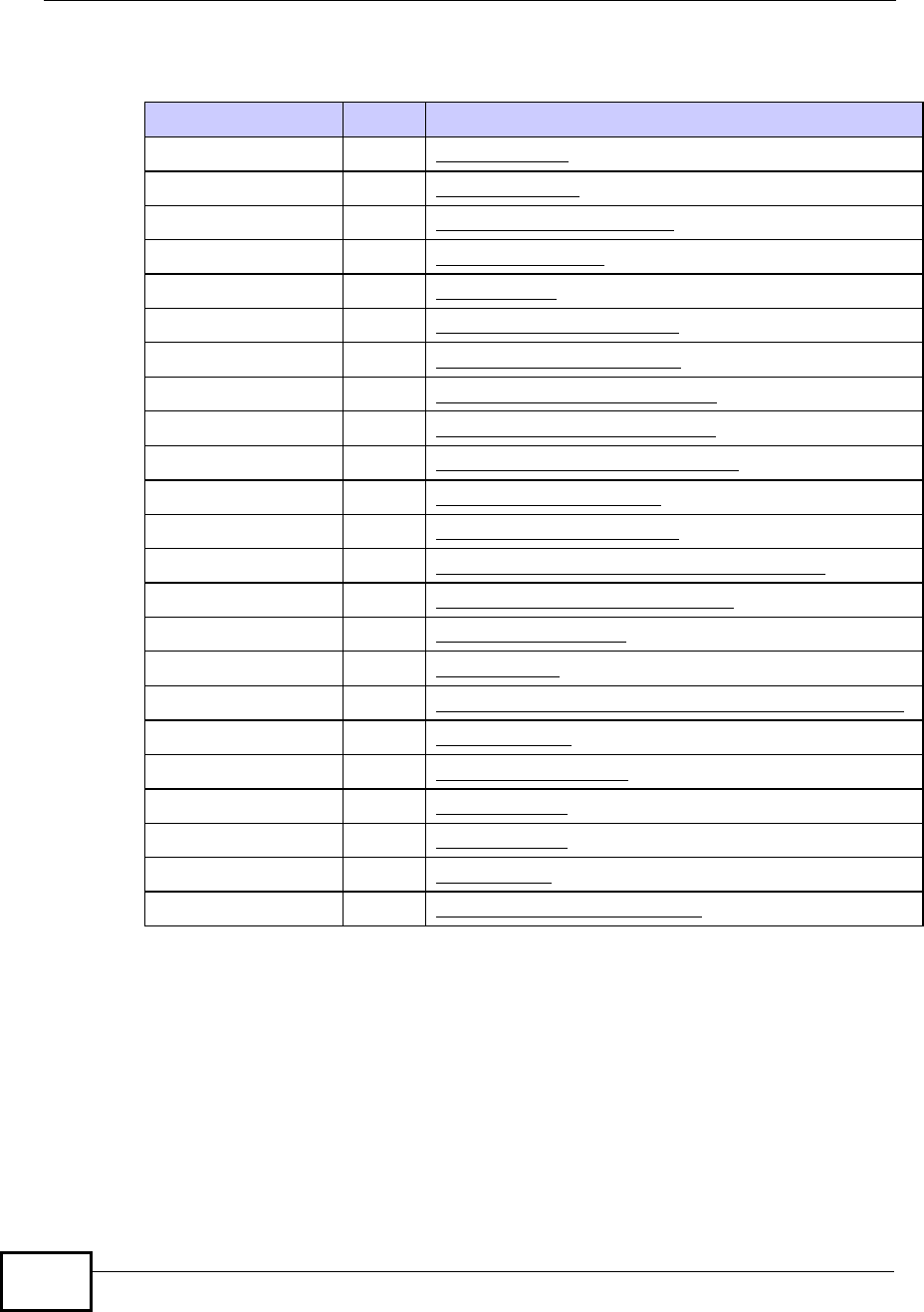
Appendix FOpen Software Announcements
STB-2101H User’s Guide
266
Open-Sourced Components
Notice
Information herein is subject to change without notice. Companies, names, and data used in examples herein are fictitious unless
otherwise noted. No part may be reproduced or transmitted in any form or by any means, electronic or mechanical, for any pur-
pose, except the express written permission of ZyXEL Communications Corporation.
This Product includes Linux Kernel-2.6.21, busybox-1.7.5, libesmtp-1.0.4, igmpproxy-0.1-beta2, dnsmasq-2.39, iproute2-2.6.16,
rp-pppoe-3.8, iptables-1.3.8, updatedd-2.6, linuxigd-1, wireless_tools-2.8, bridge-utils-1.2, pptp-client-1.7.1, ppp-2.4.3, udhcp-
0.9.9-pre, ez-ipupdate-3.0.11b8, uboot-1.1.3, mtd-utils-1.2, usb_modeswitch-0.9.7 software under GPL 2.0 license.
GNU GENERAL PUBLIC LICENSE
Version 2, June 1991
Copyright (C) 1989, 1991 Free Software Foundation, Inc.
59 Temple Place - Suite 330, Boston, MA 02111-1307, USA
Everyone is permitted to copy and distribute verbatim copies of this license document, but changing it is not allowed.
3rd party software Version Web Address Of The Software License Term
Linux Kernel-2.6.21 2.6.21 http://www.kernel.org/
busybox-1.7.51.7.5 http://www.busybox.net/
libesmtp-1.0.4 1.0.4 http://www.stafford.uklinux.net/libesmtp
libupnp-1.6.0 1.6.0 http://pupnp.sourceforge.net/
pcre-6.7 6.7 http://www.pcre.org/
igmpproxy-0.1-beta2 0.1-beta2 http://sourceforge.net/projects/igmpproxy
dnsmasq-2.39 2.39 http://thekelleys.org.uk/dnsmasq/doc.html
iproute2-2.6.16 2-2.6.16 http://www.linuxfoundation.org/en/Net:Iproute2
rp-pppoe-3.8 3.8 http://www.roaringpenguin.com/products/pppoe
iptables-1.3.81.3.8 http://www.netfilter.org/projects/iptables/index.html
updatedd-2.62.6 http://freshmeat.net/projects/updatedd/
linuxigd-11http://linux-igd.sourceforge.net/index.php
wireless_tools-2.82.8 http://www.hpl.hp.com/personal/Jean_Tourrilhes/Linux/Tools.html
bridge-utils-1.21.2 http://www.linuxfoundation.org/en/Net:Main_Page
pptp-client-1.7.11.7.1 http://pptpclient.sourceforge.net/
ppp-2.4.32.4.3 http://ppp.samba.org/
udhcp-0.9.9-pre0.9.9-pre http://sources.busybox.net/index.py/trunk/udhcp-web/index.html?revision=9967
ez-ipupdate-3.0.11b83.0.11b8 http://ez-ipupdate.com/
uboot-1.1.31.1.3 http://www.denx.de/wiki/U-Boot
uclibc-0.9.29 0.9.29 http://www.uclibc.org/
mtd-utils-1.2 1.2 http://git.infradead.org
zlib-1.2.3 1.2.3 http://www.zlib.net/
usb_modeswitch-0.9.7 0.9.7 http://www.draisberghof.de/usb_modeswitch/
Company Confidential

Appendix FOpen Software Announcements
STB-2101H User’s Guide 267
Preamble
The licenses for most software are designed to take away your freedom to share and change it. By contrast, the GNU General Pub-
lic License is intended to guarantee your freedom to share and change free software--to make sure the software is free for all its
users. This General Public License applies to most of the Free Software Foundation's software and to any other program whose
authors commit to using it. (Some other Free Software Foundation software is covered by the GNU Library General Public
License instead.) You can apply it to your programs, too.
When we speak of free software, we are referring to freedom, not price. Our General Public Licenses are designed to make sure
that you have the freedom to distribute copies of free software (and charge for this service if you wish), that you receive source
code or can get it if you want it, that you can change the software or use pieces of it in new free programs; and that you know you
can do these things.
To protect your rights, we need to make restrictions that forbid anyone to deny you these rights or to ask you to surrender the
rights. These restrictions translate to certain responsibilities for you if you distribute copies of the software, or if you modify it.
For example, if you distribute copies of such a program, whether gratis or for a fee, you must give the recipients all the rights that
you have. You must make sure that they, too, receive or can get the source code. And you must show them these terms so they
know their rights.
We protect your rights with two steps: (1) copyright the software, and (2) offer you this license which gives you legal permission
to copy, distribute and/or modify the software. Also, for each author's protection and ours, we want to make certain that everyone
understands that there is no warranty for this free software. If the software is modified by someone else and passed on, we want its
recipients to know that what they have is not the original, so that any problems introduced by others will not reflect on the original
authors' reputations.
Finally, any free program is threatened constantly by software patents. We wish to avoid the danger that redistributors of a free
program will individually obtain patent licenses, in effect making the program proprietary. To prevent this, we have made it clear
that any patent must be licensed for everyone's free use or not licensed at all.
The precise terms and conditions for copying, distribution and modification follow.
TERMS AND CONDITIONS FOR COPYING, DISTRIBUTION AND MODIFICATION
0. This License applies to any program or other work which contains a notice placed by the copyright holder saying it may be dis-
tributed under the terms of this General Public License. The "Program", below, refers to any such program or work, and a "work
based on the Program" means either the Program or any derivative work under copyright law: that is to say, a work containing the
Program or a portion of it, either verbatim or with modifications and/or translated into another language. (Hereinafter, translation
is included without limitation in the term "modification".) Each licensee is addressed as "you". Activities other than copying, dis-
tribution and modification are not covered by this License; they are outside its scope. The act of running the Program is not
restricted, and the output from the Program is covered only if its contents constitute a work based on the Program (independent of
having been made by running the Program). Whether that is true depends on what the Program does.
1. You may copy and distribute verbatim copies of the Program's source code as you receive it, in any medium, provided that you
conspicuously and appropriately publish on each copy an appropriate copyright notice and disclaimer of warranty; keep intact all
the notices that refer to this License and to the absence of any warranty; and give any other recipients of the Program a copy of
this License along with the Program. You may charge a fee for the physical act of transferring a copy, and you may at your option
offer warranty protection in exchange for a fee.
2. You may modify your copy or copies of the Program or any portion of it, thus forming a work based on the Program, and copy
and distribute such modifications or work under the terms of Section 1 above, provided that you also meet all of these conditions:
a) You must cause the modified files to carry prominent notices stating that you changed the files and the date of any change.
b) You must cause any work that you distribute or publish, that in whole or in part contains or is derived from the Program or any
part thereof, to be licensed as a whole at no charge to all third parties under the terms of this License.
c) If the modified program normally reads commands interactively when run, you must cause it, when started running for such
interactive use in the most ordinary way, to print or display an announcement including an appropriate copyright notice and a
notice that there is no warranty (or else, saying that you provide a warranty) and that users may redistribute the program under
these conditions, and telling the user how to view a copy of this License. (Exception: if the Program itself is interactive but does
not normally print such an announcement, your work based on the Program is not required to print an announcement.)
Company Confidential

Appendix FOpen Software Announcements
STB-2101H User’s Guide
268
These requirements apply to the modified work as a whole. If identifiable sections of that work are not derived from the Program,
and can be reasonably considered independent and separate works in themselves, then this License, and its terms, do not apply to
those sections when you distribute them as separate works. But when you distribute the same sections as part of a whole which is
a work based on the Program, the distribution of the whole must be on the terms of this License, whose permissions for other lic-
ensees extend to the entire whole, and thus to each and every part regardless of who wrote it. Thus, it is not the intent of this sec-
tion to claim rights or contest your rights to work written entirely by you; rather, the intent is to exercise the right to control the
distribution of derivative or collective works based on the Program. In addition, mere aggregation of another work not based on
the Program with the Program (or with a work based on the Program) on a volume of a storage or distribution medium does not
bring the other work under the scope of this License.
3. You may copy and distribute the Program (or a work based on it, under Section 2) in object code or executable form under the
terms of Sections 1 and 2 above provided that you also do one of the following:
a) Accompany it with the complete corresponding machine-readable source code, which must be distributed under the terms of
Sections 1 and 2 above on a medium customarily used for software interchange; or,
b) Accompany it with a written offer, valid for at least three years, to give any third party, for a charge no more than your cost of
physically performing source distribution, a complete machine-readable copy of the corresponding source code, to be distributed
under the terms of Sections 1 and 2 above on a medium customarily used for software interchange; or, c) Accompany it with the
information you received as to the offer to distribute corresponding source code. (This alternative is allowed only for noncommer-
cial distribution and only if you received the program in object code or executable form with such an offer, in accord with Subsec-
tion b above.) The source code for a work means the preferred form of the work for making modifications to it. For an executable
work, complete source code means all the source code for all modules it contains, plus any associated interface definition files,
plus the
scripts used to control compilation and installation of the executable. However, as a special exception, the source code distributed
need not include anything that is normally distributed (in either source or binary form) with the major components (compiler, ker-
nel, and so on) of the operating system on which the executable runs, unless that component itself accompanies the executable. If
distribution of executable or object code is made by offering access to copy from a designated place, then offering equivalent
access to copy the source code from the same place counts as distribution of the source code, even though third parties are not
compelled to copy the source along with the object code.
4. You may not copy, modify, sublicense, or distribute the Program except as expressly provided under this License. Any attempt
otherwise to copy, modify, sublicense or distribute the Program is void, and will automatically terminate your rights under this
License. However, parties who have received copies, or rights, from you under this License will not have their licenses terminated
so long as such parties remain in full compliance.
5. You are not required to accept this License, since you have not signed it. However, nothing else grants you permission to mod-
ify or distribute the Program or its derivative works. These actions are prohibited by law if you do not accept this License. There-
fore, by modifying or distributing the Program (or any work based on the Program), you indicate your acceptance of this License
to do so, and all its terms and conditions for copying, distributing or modifying the Program or works based on it.
6. Each time you redistribute the Program (or any work based on the Program), the recipient automatically receives a license from
the original licensor to copy, distribute or modify the Program subject to these terms and conditions. You may not impose any fur-
ther restrictions on the recipients' exercise of the rights granted herein. You are not responsible for enforcing compliance by third
parties to this License.
7. If, as a consequence of a court judgment or allegation of patent infringement or for any other reason (not limited to patent
issues), conditions are imposed on you (whether by court order, agreement or otherwise) that contradict the conditions of this
License, they do not excuse you from the conditions of this License. If you cannot distribute so as to satisfy simultaneously your
obligations under this License and any other pertinent obligations, then as a consequence you may not distribute the Program at
all. For example, if a patent license would not permit royalty-free redistribution of the Program by all those who receive copies
directly or indirectly through you, then the only way you could satisfy both it and this License would be to refrain entirely from
distribution of the Program. If any portion of this section is held invalid or unenforceable under any particular circumstance, the
balance of the section is intended to apply and the section as a whole is intended to apply in other circumstances. It is not the pur-
pose of this section to induce you to infringe any patents or other property right claims or to contest validity of any such claims;
this section has the sole purpose of protecting the integrity of the free software distribution system, which is implemented by pub-
lic license practices. Many people have made generous contributions to the wide range of software distributed through that system
Company Confidential

Appendix FOpen Software Announcements
STB-2101H User’s Guide 269
in reliance on consistent application of that system; it is up to the author/donor to decide if he or she is willing to distribute soft-
ware through any other system and a licensee cannot impose that choice. This section is intended to make thoroughly clear what is
believed to be a consequence of the rest of this License.
8. If the distribution and/or use of the Program is restricted in certain countries either by patents or by copyrighted interfaces, the
original copyright holder who places the Program under this License may add an explicit geographical distribution limitation
excluding those countries, so that distribution is permitted only in or among countries not thus excluded. In such case, this License
incorporates the limitation as if written in the body of this License.
9. The Free Software Foundation may publish revised and/or new versions of the General Public License from time to time. Such
new versions will be similar in spirit to the present version, but may differ in detail to address new problems or concerns. Each
version is given a distinguishing version number. If the Program specifies a version number of this License which applies to it and
"any later version", you have the option of following the terms and conditions either of that version or of any later version pub-
lished by the Free Software Foundation. If the Program does not specify a version number of this License, you may choose any
version ever published by the Free Software Foundation.
10. If you wish to incorporate parts of the Program into other free programs whose distribution conditions are different, write to
the author to ask for permission. For software which is copyrighted by the Free Software Foundation, write to the Free Software
Foundation; we sometimes make exceptions for this. Our decision will be guided by the two goals of preserving the free status of
all derivatives of our free software and of promoting the sharing and reuse of software generally.
NO WARRANTY
11. BECAUSE THE PROGRAM IS LICENSED FREE OF CHARGE, THERE IS NO WARRANTY FOR THE PROGRAM, TO
THE EXTENT PERMITTED BY APPLICABLE LAW. EXCEPT WHEN OTHERWISE STATED IN WRITING THE COPY-
RIGHT HOLDERS AND/OR OTHER PARTIES PROVIDE THE PROGRAM "AS IS" WITHOUT WARRANTY OF ANY
KIND, EITHER EXPRESSED OR IMPLIED, INCLUDING, BUT NOT LIMITED TO, THE IMPLIED WARRANTIES OF
MERCHANTABILITY AND FITNESS FOR A PARTICULAR PURPOSE. THE ENTIRE RISK AS TO THE QUALITY AND
PERFORMANCE OF THE PROGRAM IS WITH YOU. SHOULD THE PROGRAM PROVE DEFECTIVE, YOU ASSUME
THE COST OF ALL NECESSARY SERVICING, REPAIR OR CORRECTION.
12. IN NO EVENT UNLESS REQUIRED BY APPLICABLE LAW OR AGREED TO IN WRITING WILL ANY COPYRIGHT
HOLDER, OR ANY OTHER PARTY WHO MAY MODIFY AND/OR REDISTRIBUTE THE PROGRAM AS PERMITTED
ABOVE, BE LIABLE TO YOU FOR DAMAGES, INCLUDING ANY GENERAL, SPECIAL, INCIDENTAL OR CONSE-
QUENTIAL DAMAGES ARISING OUT OF THE USE OR INABILITY TO USE THE PROGRAM (INCLUDING BUT NOT
LIMITED TO LOSS OF DATA OR DATA BEING RENDERED INACCURATE OR LOSSES SUSTAINED BY YOU OR
THIRD PARTIES OR A FAILURE OF THE PROGRAM TO OPERATE WITH ANY OTHER PROGRAMS), EVEN IF SUCH
HOLDER OR OTHER PARTY HAS BEEN ADVISED OF THE POSSIBILITY OF SUCH DAMAGES.
END OF TERMS AND CONDITIONS
All other trademarks or trade names mentioned herein, if any, are the property of their respective owners.
This Product includes uclibc-0.9.29 software under LGPL license.
GNU LESSER GENERAL PUBLIC LICENSE
Version 2.1, February 1999
Copyright (C) 1991, 1999 Free Software Foundation, Inc.
59 Temple Place, Suite 330, Boston, MA 02111-1307 USA
Everyone is permitted to copy and distribute verbatim copies of this license document, but changing it is not allowed. [This is the
first released version of the Lesser GPL. It also counts
as the successor of the GNU Library Public License, version 2, hence the version number 2.1.
Preamble
The licenses for most software are designed to take away your freedom to share and change it. By contrast, the GNU General Pub-
Company Confidential

Appendix FOpen Software Announcements
STB-2101H User’s Guide
270
lic Licenses are intended to guarantee your freedom to share and change free software--to make sure the software is free for all its
users.
This license, the Lesser General Public License, applies to some specially designated software packages--typically libraries--of
the Free Software Foundation and other authors who decide to use it. You can use it too, but we suggest you first think carefully
about whether this license or the ordinary General Public License is the better strategy to use in any particular case, based on the
explanations below.
When we speak of free software, we are referring to freedom of use, not price. Our General Public Licenses are designed to make
sure that you have the freedom to distribute copies of free software (and charge for this service if you wish); that you receive
source code or can get
it if you want it; that you can change the software and use pieces of it in new free programs; and that you are informed that you
can do these things.
To protect your rights, we need to make restrictions that forbid distributors to deny you these rights or to ask you to surrender
these rights. These restrictions translate to certain responsibilities for you if you distribute copies of the library or if you modify it.
For example, if you distribute copies of the library, whether gratis or for a fee, you must give the recipients all the rights that we
gave you. You must make sure that they, too, receive or can get the source code. If you link other code with the library, you must
provide complete object files to the recipients, so that they can relink them with the library after making changes to the library and
recompiling it. And you must show them these terms so they know their rights.
We protect your rights with a two-step method: (1) we copyright the library, and (2) we offer you this license, which gives you
legal permission to copy, distribute and/or modify the library.
To protect each distributor, we want to make it very clear that there is no warranty for the free library. Also, if the library is modi-
fied by someone else and passed on, the recipients should know that what they have is not the original version, so that the original
author's reputation will not be affected by problems that might be introduced by others.
Finally, software patents pose a constant threat to the existence of any free program. We wish to make sure that a company cannot
effectively restrict the users of a free program by obtaining a restrictive license from a patent holder. Therefore, we insist that any
patent license obtained for a version of the library must be consistent with the full freedom of use specified in this license.
Most GNU software, including some libraries, is covered by the ordinary GNU General Public License. This license, the GNU
Lesser General Public License, applies to certain designated libraries, and is quite different from the ordinary General Public
License. We use this license for certain libraries in order to permit linking those libraries into non-free programs.
When a program is linked with a library, whether statically or using a shared library, the combination of the two is legally speak-
ing a combined work, a derivative of the original library. The ordinary General Public License therefore permits such linking only
if the entire combination fits its criteria of freedom. The Lesser General Public License permits more lax criteria for linking other
code with the library.
We call this license the "Lesser" General Public License because it does Less to protect the user's freedom than the ordinary Gen-
eral Public License. It also provides other free software developers Less of an advantage over competing non-free programs.
These disadvantages are the reason we use the ordinary General Public License for many libraries. However, the Lesser license
provides advantages in certain special circumstances.
For example, on rare occasions, there may be a special need to encourage the widest possible use of a certain library, so that it
becomes a de-facto standard. To achieve this, non-free programs must be allowed to use the library. A more frequent case is that a
free library does the same job as widely used non-free libraries. In this case, there is little to gain by limiting the free library to free
software only, so we use the Lesser General Public License. In other cases, permission to use a particular library in non-free pro-
grams enables a greater number of people to use a large body of free software. For example, permission to use the GNU C Library
in non-free programs enables many more people to use the whole GNU operating system, as well as its variant, the GNU/Linux
operating system.
Although the Lesser General Public License is Less protective of the users' freedom, it does ensure that the user of a program that
is linked with the Library has the freedom and the wherewithal to run that program using a modified version of the Library.
The precise terms and conditions for copying, distribution and modification follow. Pay close attention to the difference between
a "work based on the library" and a "work that uses the library". The former contains code derived from the library, whereas the
latter must be combined with the library in order to run.
GNU LESSER GENERAL PUBLIC LICENSE TERMS AND CONDITIONS FOR COPYING, DISTRIBUTION AND MODI-
Company Confidential

Appendix FOpen Software Announcements
STB-2101H User’s Guide 271
FICATION
0. This License Agreement applies to any software library or other program which contains a notice placed by the copyright
holder or other authorized party saying it may be distributed under the terms of this Lesser General Public License (also called
"this License").
Each licensee is addressed as "you".
A "library" means a collection of software functions and/or data prepared so as to be conveniently linked with application pro-
grams (which use some of those functions and data) to form executables. The "Library", below, refers to any such software library
or work which has been distributed under these terms. A "work based on the Library" means either the Library or any derivative
work under copyright law: that is to say, a work containing the Library or a portion of it, either verbatim or with modifications
and/or translated straightforwardly into another language. (Hereinafter, translation is included without limitation in the term
"modification".)
"Source code" for a work means the preferred form of the work for making modifications to it. For a library, complete source code
means all the source code for all modules it contains, plus any associated interface definition files, plus the scripts used to control
compilation and installation of the library. Activities other than copying, distribution and modification are not covered by this
License; they are outside its scope. The act of running a program using the Library is not restricted, and output from such a pro-
gram is covered only if its contents constitute a work based on the Library (independent of the use of the Library in a tool for writ-
ing it). Whether that is true depends on what the Library does and what the program that uses the Library does.
1. You may copy and distribute verbatim copies of the Library's complete source code as you receive it, in any medium, provided
that you conspicuously and appropriately publish on each copy an appropriate copyright notice and disclaimer of warranty; keep
intact all the notices that refer to this License and to the absence of any warranty; and distribute a copy of this License along with
the Library. You may charge a fee for the physical act of transferring a copy, and you may at your option offer warranty protection
in exchange for a fee.
2. You may modify your copy or copies of the Library or any portion of it, thus forming a work based on the Library, and copy and
distribute such modifications or work under the terms of Section 1 above, provided that you also meet all of these conditions: a)
The modified work must itself be a software library. b) You must cause the files modified to carry prominent notices stating that
you changed the files and the date of any change. c) You must cause the whole of the work to be licensed at no charge to all third
parties under the terms of this License. d) If a facility in the modified Library refers to a function or a table of data to be supplied
by an application program that uses the facility, other than as an argument passed when the facility is invoked, then you must
make a good faith effort to ensure that, in the event an application does not supply such function or table, the facility still operates,
and performs whatever part of its purpose remains meaningful. (For example, a function in a library to compute square roots has a
purpose that is entirely well-defined independent of the application. Therefore, Subsection 2d requires that any application-sup-
plied function or table used by this function must be optional: if the application does not supply it, the square root function must
still compute square roots.) These requirements apply to the modified work as a whole. If identifiable sections of that work are not
derived from the Library, and can be reasonably considered independent and separate works in themselves, then this License, and
its terms, do not apply to those sections when you distribute them as separate works. But when you distribute the same sections as
part of a whole which is a work based on the Library, the distribution of the whole must be on the terms of this License, whose
permissions for other licensees extend to the entire whole, and thus to each and every part regardless of who wrote
it. Thus, it is not the intent of this section to claim rights or contest your rights to work written entirely by you; rather, the intent is
to exercise the right to control the distribution of derivative or collective works based on the Library. In addition, mere aggrega-
tion of another work not based on the Library with the Library (or with a work based on the Library) on a volume of a storage or
distribution medium does not bring the other work under the scope of this License.
3. You may opt to apply the terms of the ordinary GNU General Public License instead of this License to a given copy of the
Library. To do this, you must alter all the notices that refer to this License, so that they refer to the ordinary GNU General Public
License, version 2, instead of to this License. (If a newer version than version 2 of the ordinary GNU General Public License has
appeared, then you can specify that version instead if you wish.) Do not make any other change in these notices. Once this change
is made in a given copy, it is irreversible for that copy, so the ordinary GNU General Public License applies to all subsequent cop-
ies and derivative works made from that copy. This option is useful when you wish to copy part of the code of the Library into a
program that is not a library.
4. You may copy and distribute the Library (or a portion or derivative of it, under Section 2) in object code or executable form
under the terms of Sections 1 and 2 above provided that you accompany it with the complete corresponding machine-readable
Company Confidential

Appendix FOpen Software Announcements
STB-2101H User’s Guide
272
source code, which must be distributed under the terms of Sections 1 and 2 above on a medium customarily used for software
interchange. If distribution of object code is made by offering access to copy from a designated place, then offering equivalent
access to copy the source code from the same place satisfies the requirement to distribute the source code, even though third par-
ties are not
compelled to copy the source along with the object code.
5. A program that contains no derivative of any portion of the Library, but is designed to work with the Library by being compiled
or linked with it, is called a "work that uses the Library". Such a work, in isolation, is not a derivative work of the Library, and
therefore falls outside the scope of this License.
However, linking a "work that uses the Library" with the Library creates an executable that is a derivative of the Library (because
it contains portions of the Library), rather than a "work that uses the library". The executable is therefore covered by this License.
Section 6 states terms for distribution of such executables. When a "work that uses the Library" uses material from a header file
that is part of the Library, the object code for the work may be a derivative work of the Library even though the source code is not.
Whether this is true is especially significant if the work can be linked without the Library, or if the work is itself a library. The
threshold for this to be true is not precisely defined by law. If such an object file uses only numerical parameters, data structure
layouts and accessors, and small macros and small inline functions (ten lines or less in length), then the use of the object file is
unrestricted, regardless of whether it is legally a derivative work. (Executables containing this object code plus portions of the
Library will still fall under Section 6.) Otherwise, if the work is a derivative of the Library, you may distribute the object code for
the work under the terms of Section 6. Any executables containing that work also fall under Section 6, whether or not they are
linked directly with the Library itself.
6. As an exception to the Sections above, you may also combine or link a "work that uses the Library" with the Library to produce
a work containing portions of the Library, and distribute that work under terms of your choice, provided that the terms permit
modification of the work for the customer's own use and reverse engineering for debugging such modifications. You must give
prominent notice with each copy of the work that the Library is used in it and that the Library and its use are covered by this
License. You must supply a copy of this License. If the work during execution displays copyright notices, you must include the
copyright notice for the Library among them, as well as a reference directing the user to the copy of this License. Also, you must
do one of these things: a) Accompany the work with the complete corresponding
machine-readable source code for the Library including whatever changes were used in the work (which must be distributed under
Sections 1 and 2 above); and, if the work is an executable linked with the Library, with the complete machine-readable "work that
uses the Library", as object code and/or source code, so that the user can modify the Library and then relink to produce a modified
executable containing the modified Library. (It is understood that the user who changes the contents of definitions files in the
Library will not necessarily be able to recompile the application to use the modified definitions.) b) Use a suitable shared library
mechanism for linking with the Library. A suitable mechanism is one that (1) uses at run time a
copy of the library already present on the user's computer system, rather than copying library functions into the executable, and
(2) will operate properly with a modified version of the library, if the user installs one, as long as the modified version is interface-
compatible with the version that the work was made with. c) Accompany the work with a written offer, valid for at least three
years, to give the same user the materials specified in Subsection 6a, above, for a charge no more than the cost of performing this
distribution. d) If distribution of the work is made by offering access to copy from a designated place, offer equivalent access to
copy the above specified materials from the same place. e) Verify that the user has already received a copy of these materials or
that you have already sent this user a copy. For an executable, the required form of the "work that uses the Library" must include
any data and utility programs needed for reproducing the executable from it. However, as a special exception, the materials to be
distributed need not include anything that is normally distributed (in either source or binary form) with the major components
(compiler, kernel, and so on) of the operating system on which the executable runs, unless that component itself accompanies the
executable.
It may happen that this requirement contradicts the license restrictions of other proprietary libraries that do not normally accom-
pany the operating system. Such a contradiction means you cannot use both them and the Library together in an executable that
you distribute.
7. You may place library facilities that are a work based on the Library side-by-side in a single library together with other library
facilities not covered by this License, and distribute such a combined library, provided that the separate distribution of the work
based on the Library and of the other library facilities is otherwise permitted, and provided that you do these two things: a)
Accompany the combined library with a copy of the same work based on the Library, uncombined with any other library facilities.
Company Confidential

Appendix FOpen Software Announcements
STB-2101H User’s Guide 273
This must be distributed under the terms of the Sections above. b) Give prominent notice with the combined library of the fact that
part of it is a work based on the Library, and explaining where to find the accompanying uncombined form of the same work.
8. You may not copy, modify, sublicense, link with, or distribute the Library except as expressly provided under this License. Any
attempt otherwise to copy, modify, sublicense, link with, or distribute the Library is void, and will automatically terminate your
rights under this License. However, parties who have received copies, or rights, from you under this License will not have their
licenses terminated so long as such parties remain in full compliance.
9. You are not required to accept this License, since you have not signed it. However, nothing else grants you permission to mod-
ify or distribute the Library or its derivative works. These actions are prohibited by law if you do not accept this License. There-
fore, by modifying or distributing the Library (or any work based on the Library), you indicate your acceptance of this License to
do so, and all its terms and conditions for copying, distributing or modifying the Library or works based on it.
10. Each time you redistribute the Library (or any work based on the Library), the recipient automatically receives a license from
the original licensor to copy, distribute, link with or modify the Library subject to these terms and conditions. You may not impose
any further restrictions on the recipients' exercise of the rights granted herein. You are not responsible for enforcing compliance
by third parties with this License.
11. If, as a consequence of a court judgment or allegation of patent infringement or for any other reason (not limited to patent
issues), conditions are imposed on you (whether by court order, agreement or otherwise) that contradict the conditions of this
License, they do not excuse you from the conditions of this License. If you cannot distribute so as to satisfy simultaneously your
obligations under this License and any other pertinent obligations, then as a consequence you may not distribute the Library at all.
For example, if a patent license would not permit royalty-free redistribution of the Library by all those who receive copies directly
or indirectly through you, then the only way you could satisfy both it and this License would be to
refrain entirely from distribution of the Library. If any portion of this section is held invalid or unenforceable under any particular
circumstance, the balance of the section is intended to apply, and the section as a whole is intended to apply in other circum-
stances. It is not the purpose of this section to induce you to infringe any patents or other property right claims or to contest valid-
ity of any such claims; this section has the sole purpose of protecting the integrity of the free software distribution system which is
implemented by public license practices. Many people have made generous contributions to the wide range of software distrib-
uted through that system in reliance on consistent application of that system; it is up to the author/donor to decide if he or she is
willing to distribute software through any other system and a licensee cannot impose that choice. This section is intended to make
thoroughly clear what is believed to be a consequence of the rest of this License.
12. If the distribution and/or use of the Library is restricted in certain countries either by patents or by copyrighted interfaces, the
original copyright holder who places the Library under this License may add an explicit geographical distribution limitation
excluding those countries, so that distribution is permitted only in or among countries not thus excluded. In such case, this License
incorporates the limitation as if written in the body of this License.
13. The Free Software Foundation may publish revised and/or new versions of the Lesser General Public License from time to
time. Such new versions will be similar in spirit to the present version, but may differ in detail to address new problems or con-
cerns. Each version is given a distinguishing version number. If the Library specifies a version number of this License which
applies to it and "any later version", you have the option of following the terms and conditions either of that version or of any later
version published by the Free Software Foundation. If the Library does not specify a license version number, you may choose any
version ever published by the Free Software Foundation.
14. If you wish to incorporate parts of the Library into other free programs whose distribution conditions are incompatible with
these, write to the author to ask for permission. For software which is copyrighted by the Free Software Foundation, write to the
Free Software Foundation; we sometimes make exceptions for this. Our decision will be guided by the two goals of preserving the
free status of all derivatives of our free software and of promoting the sharing
and reuse of software generally.
NO WARRANTY
15. BECAUSE THE LIBRARY IS LICENSED FREE OF CHARGE, THERE IS NO WARRANTY FOR THE LIBRARY, TO
THE EXTENT PERMITTED BY APPLICABLE LAW. EXCEPT WHEN OTHERWISE STATED IN WRITING THE COPY-
RIGHT HOLDERS AND/OR OTHER PARTIES PROVIDE THE LIBRARY "AS IS" WITHOUT WARRANTY OF ANY
KIND, EITHER EXPRESSED OR IMPLIED, INCLUDING, BUT NOT LIMITED TO, THE IMPLIED WARRANTIES OF
MERCHANTABILITY AND FITNESS FOR A PARTICULAR PURPOSE. THE ENTIRE RISK AS TO THE QUALITY AND
PERFORMANCE OF THE LIBRARY IS WITH YOU. SHOULD THE LIBRARY PROVE DEFECTIVE, YOU ASSUME THE
Company Confidential

Appendix FOpen Software Announcements
STB-2101H User’s Guide
274
COST OF ALL NECESSARY SERVICING, REPAIR OR CORRECTION.
16. IN NO EVENT UNLESS REQUIRED BY APPLICABLE LAW OR AGREED TO IN WRITING WILL ANY COPYRIGHT
HOLDER, OR ANY OTHER PARTY WHO MAY MODIFY AND/OR REDISTRIBUTE THE LIBRARY AS PERMITTED
ABOVE, BE LIABLE TO YOU FOR DAMAGES, INCLUDING ANY GENERAL, SPECIAL, INCIDENTAL OR CONSE-
QUENTIAL DAMAGES ARISING OUT OF THE USE OR INABILITY TO USE THE LIBRARY (INCLUDING BUT NOT
LIMITED TO LOSS OF DATA OR DATA BEING RENDERED INACCURATE OR LOSSES SUSTAINED BY YOU OR
THIRD PARTIES OR A FAILURE OF THE LIBRARY TO OPERATE WITH ANY OTHER SOFTWARE), EVEN IF SUCH
HOLDER OR OTHER PARTY HAS BEEN ADVISED OF THE POSSIBILITY OF SUCHDAMAGES.
END OF TERMS AND CONDITIONS.
This Product includes gcc-3.4.6 software under GPL 3.0 license
GNU GENERAL PUBLIC LICENSE
Version 3, 29 June 2007
Copyright © 2007 Free Software Foundation, Inc. <http://fsf.org/>
Everyone is permitted to copy and distribute verbatim copies of this license document, but changing it is not allowed.
Preamble
The GNU General Public License is a free, copyleft license for software and other kinds of works.
The licenses for most software and other practical works are designed to take away your freedom to share and change the works.
By contrast, the GNU General Public License is intended to guarantee your freedom to share and change all versions of a pro-
gram--to make sure it remains free software for all its users. We, the Free Software Foundation, use the GNU General Public
License for most of our software; it applies also to any other work released this way by its authors. You can apply it to your pro-
grams, too.
When we speak of free software, we are referring to freedom, not price. Our General Public Licenses are designed to make sure
that you have the freedom to distribute copies of free software (and charge for them if you wish), that you receive source code or
can get it if you want it, that you can change the software or use pieces of it in new free programs, and that you know you can do
these things.
To protect your rights, we need to prevent others from denying you these rights or asking you to surrender the rights. Therefore,
you have certain responsibilities if you distribute copies of the software, or if you modify it: responsibilities to respect the freedom
of others.
For example, if you distribute copies of such a program, whether gratis or for a fee, you must pass on to the recipients the same
freedoms that you received. You must make sure that they, too, receive or can get the source code. And you must show them these
terms so they know their rights.
Developers that use the GNU GPL protect your rights with two steps: (1) assert copyright on the software, and (2) offer you this
License giving you legal permission to copy, distribute and/or modify it.
For the developers' and authors' protection, the GPL clearly explains that there is no warranty for this free software. For both
users' and authors' sake, the GPL requires that modified versions be marked as changed, so that their problems will not be attrib-
uted erroneously to authors of previous versions.
Some devices are designed to deny users access to install or run modified versions of the software inside them, although the man-
ufacturer can do so. This is fundamentally incompatible with the aim of protecting users' freedom to change the software. The sys-
tematic pattern of such abuse occurs in the area of products for individuals to use, which is precisely where it is most
unacceptable. Therefore, we have designed this version of the GPL to prohibit the practice for those products. If such problems
arise substantially in other domains, we stand ready to extend this provision to those domains in future versions of the GPL, as
needed to protect the freedom of users.
Finally, every program is threatened constantly by software patents. States should not allow patents to restrict development and
use of software on general-purpose computers, but in those that do, we wish to avoid the special danger that patents applied to a
free program could make it effectively proprietary. To prevent this, the GPL assures that patents cannot be used to render the pro-
gram non-free.
The precise terms and conditions for copying, distribution and modification follow.
TERMS AND CONDITIONS
0. Definitions.
“This License” refers to version 3 of the GNU General Public License.
“Copyright” also means copyright-like laws that apply to other kinds of works, such as semiconductor masks.
“The Program” refers to any copyrightable work licensed under this License. Each licensee is addressed as “you”. “Licensees”
and “recipients” may be individuals or organizations.
To “modify” a work means to copy from or adapt all or part of the work in a fashion requiring copyright permission, other than the
making of an exact copy. The resulting work is called a “modified version” of the earlier work or a work “based on” the earlier
work.
A “covered work” means either the unmodified Program or a work based on the Program.
To “propagate” a work means to do anything with it that, without permission, would make you directly or secondarily liable for
infringement under applicable copyright law, except executing it on a computer or modifying a private copy. Propagation includes
copying, distribution (with or without modification), making available to the public, and in some countries other activities as well.
To “convey” a work means any kind of propagation that enables other parties to make or receive copies. Mere interaction with a
user through a computer network, with no transfer of a copy, is not conveying.
An interactive user interface displays “Appropriate Legal Notices” to the extent that it includes a convenient and prominently vis-
Company Confidential

Appendix FOpen Software Announcements
STB-2101H User’s Guide 275
ible feature that (1) displays an appropriate copyright notice, and (2) tells the user that there is no warranty for the work (except to
the extent that warranties are provided), that licensees may convey the work under this License, and how to view a copy of this
License. If the interface presents a list of user commands or options, such as a menu, a prominent item in the list meets this crite-
rion.
1. Source Code.
The “source code” for a work means the preferred form of the work for making modifications to it. “Object code” means any non-
source form of a work.
A “Standard Interface” means an interface that either is an official standard defined by a recognized standards body, or, in the case
of interfaces specified for a particular programming language, one that is widely used among developers working in that lan-
guage.
The “System Libraries” of an executable work include anything, other than the work as a whole, that (a) is included in the normal
form of packaging a Major Component, but which is not part of that Major Component, and (b) serves only to enable use of the
work with that Major Component, or to implement a Standard Interface for which an implementation is available to the public in
source code form. A “Major Component”, in this context, means a major essential component (kernel, window system, and so on)
of the specific operating system (if any) on which the executable work runs, or a compiler used to produce the work, or an object
code interpreter used to run it.
The “Corresponding Source” for a work in object code form means all the source code needed to generate, install, and (for an exe-
cutable work) run the object code and to modify the work, including scripts to control those activities. However, it does not
include the work's System Libraries, or general-purpose tools or generally available free programs which are used unmodified in
performing those activities but which are not part of the work. For example, Corresponding Source includes interface definition
files associated with source files for the work, and the source code for shared libraries and dynamically linked subprograms that
the work is specifically designed to require, such as by intimate data communication or control flow between those subprograms
and other parts of the work.
The Corresponding Source need not include anything that users can regenerate automatically from other parts of the Correspond-
ing Source.
The Corresponding Source for a work in source code form is that same work.
2. Basic Permissions.
All rights granted under this License are granted for the term of copyright on the Program, and are irrevocable provided the stated
conditions are met. This License explicitly affirms your unlimited permission to run the unmodified Program. The output from
running a covered work is covered by this License only if the output, given its content, constitutes a covered work. This License
acknowledges your rights of fair use or other equivalent, as provided by copyright law.
You may make, run and propagate covered works that you do not convey, without conditions so long as your license otherwise
remains in force. You may convey covered works to others for the sole purpose of having them make modifications exclusively
for you, or provide you with facilities for running those works, provided that you comply with the terms of this License in convey-
ing all material for which you do not control copyright. Those thus making or running the covered works for you must do so
exclusively on your behalf, under your direction and control, on terms that prohibit them from making any copies of your copy-
righted material outside their relationship with you.
Conveying under any other circumstances is permitted solely under the conditions stated below. Sublicensing is not allowed; sec-
tion 10 makes it unnecessary.
3. Protecting Users' Legal Rights From Anti-Circumvention Law.
No covered work shall be deemed part of an effective technological measure under any applicable law fulfilling obligations under
article 11 of the WIPO copyright treaty adopted on 20 December 1996, or similar laws prohibiting or restricting circumvention of
such measures.
When you convey a covered work, you waive any legal power to forbid circumvention of technological measures to the extent
such circumvention is effected by exercising rights under this License with respect to the covered work, and you disclaim any
intention to limit operation or modification of the work as a means of enforcing, against the work's users, your or third parties'
legal rights to forbid circumvention of technological measures.
4. Conveying Verbatim Copies.
You may convey verbatim copies of the Program's source code as you receive it, in any medium, provided that you conspicuously
and appropriately publish on each copy an appropriate copyright notice; keep intact all notices stating that this License and any
non-permissive terms added in accord with section 7 apply to the code; keep intact all notices of the absence of any warranty; and
give all recipients a copy of this License along with the Program.
You may charge any price or no price for each copy that you convey, and you may offer support or warranty protection for a fee.
5. Conveying Modified Source Versions.
You may convey a work based on the Program, or the modifications to produce it from the Program, in the form of source code
under the terms of section 4, provided that you also meet all of these conditions:
a) The work must carry prominent notices stating that you modified it, and giving a relevant date.
b) The work must carry prominent notices stating that it is released under this License and any conditions
added under section 7. This requirement modifies the requirement in section 4 to “keep intact all notices”.
c) You must license the entire work, as a whole, under this License to anyone who comes into possession of
a copy. This License will therefore apply, along with any applicable section 7 additional terms, to the whole of the
work, and all its parts, regardless of how they are packaged. This License gives no permission to license the work in
any other way, but it does not invalidate such permission if you have separately received it.
d) If the work has interactive user interfaces, each must display Appropriate Legal Notices; however, if the
Program has interactive interfaces that do not display Appropriate Legal Notices, your work need not make them do
so.
A compilation of a covered work with other separate and independent works, which are not by their nature extensions of the cov-
ered work, and which are not combined with it such as to form a larger program, in or on a volume of a storage or distribution
medium, is called an “aggregate” if the compilation and its resulting copyright are not used to limit the access or legal rights of the
Company Confidential

Appendix FOpen Software Announcements
STB-2101H User’s Guide
276
compilation's users beyond what the individual works permit. Inclusion of a covered work in an aggregate does not cause this
License to apply to the other parts of the aggregate.
6. Conveying Non-Source Forms.
You may convey a covered work in object code form under the terms of sections 4 and 5, provided that you also convey the
machine-readable Corresponding Source under the terms of this License, in one of these ways:
a) Convey the object code in, or embodied in, a physical product (including a physical distribution
medium), accompanied by the Corresponding Source fixed on a durable physical medium customarily used for soft-
ware interchange.
b) Convey the object code in, or embodied in, a physical product (including a physical distribution
medium), accompanied by a written offer, valid for at least three years and valid for as long as you offer spare parts or
customer support for that product model, to give anyone who possesses the object code either (1) a copy of the Corre-
sponding Source for all the software in the product that is covered by this License, on a durable physical medium cus-
tomarily used for software interchange, for a price no more than your reasonable cost of physically performing this
conveying of source, or (2) access to copy the Corresponding Source from a network server at no charge.
c) Convey individual copies of the object code with a copy of the written offer to provide the Correspond-
ing Source. This alternative is allowed only occasionally and noncommercially, and only if you received the object
code with such an offer, in accord with subsection 6b.
d) Convey the object code by offering access from a designated place (gratis or for a charge), and offer
equivalent access to the Corresponding Source in the same way through the same place at no further charge. You need
not require recipients to copy the Corresponding Source along with the object code. If the place to copy the object code
is a network server, the Corresponding Source may be on a different server (operated by you or a third party) that sup-
ports equivalent copying facilities, provided you maintain clear directions next to the object code saying where to find
the Corresponding Source. Regardless of what server hosts the Corresponding Source, you remain obligated to ensure
that it is available for as long as needed to satisfy these requirements.
e) Convey the object code using peer-to-peer transmission, provided you inform other peers where the
object code and Corresponding Source of the work are being offered to the general public at no charge under subsec-
tion 6d.
A separable portion of the object code, whose source code is excluded from the Corresponding Source as a System Library, need
not be included in conveying the object code work.
A “User Product” is either (1) a “consumer product”, which means any tangible personal property which is normally used for per-
sonal, family, or household purposes, or (2) anything designed or sold for incorporation into a dwelling. In determining whether a
product is a consumer product, doubtful cases shall be resolved in favor of coverage. For a particular product received by a partic-
ular user, “normally used” refers to a typical or common use of that class of product, regardless of the status of the particular user
or of the way in which the particular user actually uses, or expects or is expected to use, the product. A product is a consumer
product regardless of whether the product has substantial commercial, industrial or non-consumer uses, unless such uses represent
the only significant mode of use of the product.
“Installation Information” for a User Product means any methods, procedures, authorization keys, or other information required to
install and execute modified versions of a covered work in that User Product from a modified version of its Corresponding
Source. The information must suffice to ensure that the continued functioning of the modified object code is in no case prevented
or interfered with solely because modification has been made.
If you convey an object code work under this section in, or with, or specifically for use in, a User Product, and the conveying
occurs as part of a transaction in which the right of possession and use of the User Product is transferred to the recipient in perpe-
tuity or for a fixed term (regardless of how the transaction is characterized), the Corresponding Source conveyed under this sec-
tion must be accompanied by the Installation Information. But this requirement does not apply if neither you nor any third party
retains the ability to install modified object code on the User Product (for example, the work has been installed in ROM).
The requirement to provide Installation Information does not include a requirement to continue to provide support service, war-
ranty, or updates for a work that has been modified or installed by the recipient, or for the User Product in which it has been mod-
ified or installed. Access to a network may be denied when the modification itself materially and adversely affects the operation of
the network or violates the rules and protocols for communication across the network.
Corresponding Source conveyed, and Installation Information provided, in accord with this section must be in a format that is
publicly documented (and with an implementation available to the public in source code form), and must require no special pass-
word or key for unpacking, reading or copying.
7. Additional Terms.
“Additional permissions” are terms that supplement the terms of this License by making exceptions from one or more of its con-
ditions. Additional permissions that are applicable to the entire Program shall be treated as though they were included in this
License, to the extent that they are valid under applicable law. If additional permissions apply only to part of the Program, that
part may be used separately under those permissions, but the entire Program remains governed by this License without regard to
the additional permissions.
When you convey a copy of a covered work, you may at your option remove any additional permissions from that copy, or from
any part of it. (Additional permissions may be written to require their own removal in certain cases when you modify the work.)
You may place additional permissions on material, added by you to a covered work, for which you have or can give appropriate
copyright permission.
Notwithstanding any other provision of this License, for material you add to a covered work, you may (if authorized by the copy-
right holders of that material) supplement the terms of this License with terms:
a) Disclaiming warranty or limiting liability differently from the terms of sections 15 and 16 of this
License; or
b) Requiring preservation of specified reasonable legal notices or author attributions in that material or in
the Appropriate Legal Notices displayed by works containing it; or
c) Prohibiting misrepresentation of the origin of that material, or requiring that modified versions of such
Company Confidential

Appendix FOpen Software Announcements
STB-2101H User’s Guide 277
material be marked in reasonable ways as different from the original version; or
d) Limiting the use for publicity purposes of names of licensors or authors of the material; or
e) Declining to grant rights under trademark law for use of some trade names, trademarks, or service marks;
or
f) Requiring indemnification of licensors and authors of that material by anyone who conveys the material
(or modified versions of it) with contractual assumptions of liability to the recipient, for any liability that these con-
tractual assumptions directly impose on those licensors and authors.
All other non-permissive additional terms are considered “further restrictions” within the meaning of section 10. If the Program as
you received it, or any part of it, contains a notice stating that it is governed by this License along with a term that is a further
restriction, you may remove that term. If a license document contains a further restriction but permits relicensing or conveying
under this License, you may add to a covered work material governed by the terms of that license document, provided that the fur-
ther restriction does not survive such relicensing or conveying.
If you add terms to a covered work in accord with this section, you must place, in the relevant source files, a statement of the addi-
tional terms that apply to those files, or a notice indicating where to find the applicable terms.
Additional terms, permissive or non-permissive, may be stated in the form of a separately written license, or stated as exceptions;
the above requirements apply either way.
8. Termination.
You may not propagate or modify a covered work except as expressly provided under this License. Any attempt otherwise to
propagate or modify it is void, and will automatically terminate your rights under this License (including any patent licenses
granted under the third paragraph of section 11).
However, if you cease all violation of this License, then your license from a particular copyright holder is reinstated (a) provision-
ally, unless and until the copyright holder explicitly and finally terminates your license, and (b) permanently, if the copyright
holder fails to notify you of the violation by some reasonable means prior to 60 days after the cessation.
Moreover, your license from a particular copyright holder is reinstated permanently if the copyright holder notifies you of the vio-
lation by some reasonable means, this is the first time you have received notice of violation of this License (for any work) from
that copyright holder, and you cure the violation prior to 30 days after your receipt of the notice.
Termination of your rights under this section does not terminate the licenses of parties who have received copies or rights from
you under this License. If your rights have been terminated and not permanently reinstated, you do not qualify to receive new
licenses for the same material under section 10.
9. Acceptance Not Required for Having Copies.
You are not required to accept this License in order to receive or run a copy of the Program. Ancillary propagation of a covered
work occurring solely as a consequence of using peer-to-peer transmission to receive a copy likewise does not require acceptance.
However, nothing other than this License grants you permission to propagate or modify any covered work. These actions infringe
copyright if you do not accept this License. Therefore, by modifying or propagating a covered work, you indicate your acceptance
of this License to do so.
10. Automatic Licensing of Downstream Recipients.
Each time you convey a covered work, the recipient automatically receives a license from the original licensors, to run, modify
and propagate that work, subject to this License. You are not responsible for enforcing compliance by third parties with this
License.
An “entity transaction” is a transaction transferring control of an organization, or substantially all assets of one, or subdividing an
organization, or merging organizations. If propagation of a covered work results from an entity transaction, each party to that
transaction who receives a copy of the work also receives whatever licenses to the work the party's predecessor in interest had or
could give under the previous paragraph, plus a right to possession of the Corresponding Source of the work from the predecessor
in interest, if the predecessor has it or can get it with reasonable efforts.
You may not impose any further restrictions on the exercise of the rights granted or affirmed under this License. For example, you
may not impose a license fee, royalty, or other charge for exercise of rights granted under this License, and you may not initiate
litigation (including a cross-claim or counterclaim in a lawsuit) alleging that any patent claim is infringed by making, using, sell-
ing, offering for sale, or importing the Program or any portion of it.
11. Patents.
A “contributor” is a copyright holder who authorizes use under this License of the Program or a work on which the Program is
based. The work thus licensed is called the contributor's “contributor version”.
A contributor's “essential patent claims” are all patent claims owned or controlled by the contributor, whether already acquired or
hereafter acquired, that would be infringed by some manner, permitted by this License, of making, using, or selling its contributor
version, but do not include claims that would be infringed only as a consequence of further modification of the contributor ver-
sion. For purposes of this definition, “control” includes the right to grant patent sublicenses in a manner consistent with the
requirements of this License.
Each contributor grants you a non-exclusive, worldwide, royalty-free patent license under the contributor's essential patent
claims, to make, use, sell, offer for sale, import and otherwise run, modify and propagate the contents of its contributor version.
In the following three paragraphs, a “patent license” is any express agreement or commitment, however denominated, not to
enforce a patent (such as an express permission to practice a patent or covenant not to sue for patent infringement). To “grant”
such a patent license to a party means to make such an agreement or commitment not to enforce a patent against the party.
If you convey a covered work, knowingly relying on a patent license, and the Corresponding Source of the work is not available
for anyone to copy, free of charge and under the terms of this License, through a publicly available network server or other readily
accessible means, then you must either (1) cause the Corresponding Source to be so available, or (2) arrange to deprive yourself of
the benefit of the patent license for this particular work, or (3) arrange, in a manner consistent with the requirements of this
License, to extend the patent license to downstream recipients. “Knowingly relying” means you have actual knowledge that, but
for the patent license, your conveying the covered work in a country, or your recipient's use of the covered work in a country,
would infringe one or more identifiable patents in that country that you have reason to believe are valid.
If, pursuant to or in connection with a single transaction or arrangement, you convey, or propagate by procuring conveyance of, a
covered work, and grant a patent license to some of the parties receiving the covered work authorizing them to use, propagate,
Company Confidential

Appendix FOpen Software Announcements
STB-2101H User’s Guide
278
modify or convey a specific copy of the covered work, then the patent license you grant is automatically extended to all recipients
of the covered work and works based on it.
A patent license is “discriminatory” if it does not include within the scope of its coverage, prohibits the exercise of, or is condi-
tioned on the non-exercise of one or more of the rights that are specifically granted under this License. You may not convey a cov-
ered work if you are a party to an arrangement with a third party that is in the business of distributing software, under which you
make payment to the third party based on the extent of your activity of conveying the work, and under which the third party
grants, to any of the parties who would receive the covered work from you, a discriminatory patent license (a) in connection with
copies of the covered work conveyed by you (or copies made from those copies), or (b) primarily for and in connection with spe-
cific products or compilations that contain the covered work, unless you entered into that arrangement, or that patent license was
granted, prior to 28 March 2007.
Nothing in this License shall be construed as excluding or limiting any implied license or other defenses to infringement that may
otherwise be available to you under applicable patent law.
12. No Surrender of Others' Freedom.
If conditions are imposed on you (whether by court order, agreement or otherwise) that contradict the conditions of this License,
they do not excuse you from the conditions of this License. If you cannot convey a covered work so as to satisfy simultaneously
your obligations under this License and any other pertinent obligations, then as a consequence you may not convey it at all. For
example, if you agree to terms that obligate you to collect a royalty for further conveying from those to whom you convey the Pro-
gram, the only way you could satisfy both those terms and this License would be to refrain entirely from conveying the Program.
13. Use with the GNU Affero General Public License.
Notwithstanding any other provision of this License, you have permission to link or combine any covered work with a work
licensed under version 3 of the GNU Affero General Public License into a single combined work, and to convey the resulting
work. The terms of this License will continue to apply to the part which is the covered work, but the special requirements of the
GNU Affero General Public License, section 13, concerning interaction through a network will apply to the combination as such.
14. Revised Versions of this License.
The Free Software Foundation may publish revised and/or new versions of the GNU General Public License from time to time.
Such new versions will be similar in spirit to the present version, but may differ in detail to address new problems or concerns.
Each version is given a distinguishing version number. If the Program specifies that a certain numbered version of the GNU Gen-
eral Public License “or any later version” applies to it, you have the option of following the terms and conditions either of that
numbered version or of any later version published by the Free Software Foundation. If the Program does not specify a version
number of the GNU General Public License, you may choose any version ever published by the Free Software Foundation.
If the Program specifies that a proxy can decide which future versions of the GNU General Public License can be used, that
proxy's public statement of acceptance of a version permanently authorizes you to choose that version for the Program.
Later license versions may give you additional or different permissions. However, no additional obligations are imposed on any
author or copyright holder as a result of your choosing to follow a later version.
15. Disclaimer of Warranty.
THERE IS NO WARRANTY FOR THE PROGRAM, TO THE EXTENT PERMITTED BY APPLICABLE LAW. EXCEPT
WHEN OTHERWISE STATED IN WRITING THE COPYRIGHT HOLDERS AND/OR OTHER PARTIES PROVIDE THE
PROGRAM “AS IS” WITHOUT WARRANTY OF ANY KIND, EITHER EXPRESSED OR IMPLIED, INCLUDING, BUT
NOT LIMITED TO, THE IMPLIED WARRANTIES OF MERCHANTABILITY AND FITNESS FOR A PARTICULAR PUR-
POSE. THE ENTIRE RISK AS TO THE QUALITY AND PERFORMANCE OF THE PROGRAM IS WITH YOU. SHOULD
THE PROGRAM PROVE DEFECTIVE, YOU ASSUME THE COST OF ALL NECESSARY SERVICING, REPAIR OR COR-
RECTION.
16. Limitation of Liability.
IN NO EVENT UNLESS REQUIRED BY APPLICABLE LAW OR AGREED TO IN WRITING WILL ANY COPYRIGHT
HOLDER, OR ANY OTHER PARTY WHO MODIFIES AND/OR CONVEYS THE PROGRAM AS PERMITTED ABOVE,
BE LIABLE TO YOU FOR DAMAGES, INCLUDING ANY GENERAL, SPECIAL, INCIDENTAL OR CONSEQUENTIAL
DAMAGES ARISING OUT OF THE USE OR INABILITY TO USE THE PROGRAM (INCLUDING BUT NOT LIMITED TO
LOSS OF DATA OR DATA BEING RENDERED INACCURATE OR LOSSES SUSTAINED BY YOU OR THIRD PARTIES
OR A FAILURE OF THE PROGRAM TO OPERATE WITH ANY OTHER PROGRAMS), EVEN IF SUCH HOLDER OR
OTHER PARTY HAS BEEN ADVISED OF THE POSSIBILITY OF SUCH DAMAGES.
17. Interpretation of Sections 15 and 16.
If the disclaimer of warranty and limitation of liability provided above cannot be given local legal effect according to their terms,
reviewing courts shall apply local law that most closely approximates an absolute waiver of all civil liability in connection with
the Program, unless a warranty or assumption of liability accompanies a copy of the Program in return for a fee.
END OF TERMS AND CONDITIONS
How to Apply These Terms to Your New Programs
If you develop a new program, and you want it to be of the greatest possible use to the public, the best way to achieve this is to
make it free software which everyone can redistribute and change under these terms.
To do so, attach the following notices to the program. It is safest to attach them to the start of each source file to most effectively
state the exclusion of warranty; and each file should have at least the “copyright” line and a pointer to where the full notice is
found.
<one line to give the program's name and a brief idea of what it does.>
Copyright (C) <year> <name of author>
This program is free software: you can redistribute it and/or modify
it under the terms of the GNU General Public License as published by
the Free Software Foundation, either version 3 of the License, or
(at your option) any later version.
Company Confidential

Appendix FOpen Software Announcements
STB-2101H User’s Guide 279
This program is distributed in the hope that it will be useful,
but WITHOUT ANY WARRANTY; without even the implied warranty of
MERCHANTABILITY or FITNESS FOR A PARTICULAR PURPOSE. See the
GNU General Public License for more details.
You should have received a copy of the GNU General Public License
along with this program. If not, see <http://www.gnu.org/licenses/>.
Also add information on how to contact you by electronic and paper mail.
If the program does terminal interaction, make it output a short notice like this when it starts in an interactive mode:
<program> Copyright (C) <year> <name of author>
This program comes with ABSOLUTELY NO WARRANTY; for details type `show w'.
This is free software, and you are welcome to redistribute it
under certain conditions; type `show c' for details.
The hypothetical commands `show w' and `show c' should show the appropriate parts of the General Public License. Of course,
your program's commands might be different; for a GUI interface, you would use an “about box”.
You should also get your employer (if you work as a programmer) or school, if any, to sign a “copyright disclaimer” for the pro-
gram, if necessary. For more information on this, and how to apply and follow the GNU GPL, see <http://www.gnu.org/licenses/
>.
The GNU General Public License does not permit incorporating your program into proprietary programs. If your program is a
subroutine library, you may consider it more useful to permit linking proprietary applications with the library. If this is what you
want to do, use the GNU Lesser General Public License instead of this License. But first, please read <http://www.gnu.org/philos-
ophy/why-not-lgpl.html>.
This Product includes libupnp-1.6.0, pcre-6.7, ppp-2.4.3 under BSD license
BSD
Copyright (c) [dates as appropriate to package]
The Regents of the University of California. All rights reserved. Redistribution and use in source and binary forms, with or with-
out modification, are permitted provided that the following conditions are met:
Redistributions of source code must retain the above copyright notice, this list of conditions and the following disclaimer.
Redistributions in binary form must reproduce the above copyright notice, this list of conditions and the following disclaimer in
the documentation and/or other materials provided with the distribution.
Neither the name of the University nor of the Laboratory may be used to endorse or promote products derived from this software
without specific prior written permission.
THIS SOFTWARE IS PROVIDED BY THE REGENTS AND CONTRIBUTORS ``AS IS'' AND ANY EXPRESS OR IMPLIED
WARRANTIES, INCLUDING, BUT NOT LIMITED TO, THE IMPLIED WARRANTIES OF MERCHANTABILITY AND
FITNESS FOR A PARTICULAR PURPOS E ARE DISCLAIMED. IN NO EVENT SHALL THE REGENTS OR CONTRIBU-
TORS BE LIABLE FOR ANY DIRECT, INDIRECT, INCIDENTAL, SPECIAL, EXEMPLARY, OR CONSEQUENTIAL
DAMAGES (INCLUDING, BUT NOT LIMITED TO, PROCUREMENT OF SUBSTITUTE GOODS OR SERVICES; LOSS
OF USE, DATA, OR PROFITS; OR BUSINESS INTERRUPTION) HOWEVER CAUSED AND ON ANY THEORY OF LIA-
BILITY, WHETHER IN CONTRACT, STRICT LIABILITY, OR TORT (INCLUDING NEGLIGENCE OR OTHERWISE)
ARISING IN ANY WAY OUT OF THE USE OF THIS SOFTWARE, EVEN IF ADVISED OF THE POSSIBILITY OF SUCH
DAMAGE.
This Product includes zlib-1.2.3 software under below license
Company Confidential

Appendix FOpen Software Announcements
STB-2101H User’s Guide
280
License
/* zlib.h -- interface of the 'zlib' general purpose compression library
version 1.2.3, July 18th, 2005
Copyright (C) 1995-2005 Jean-loup Gailly and Mark Adler
This software is provided 'as-is', without any express or implied
warranty. In no event will the authors be held liable for any damages
arising from the use of this software.
Permission is granted to anyone to use this software for any purpose,
including commercial applications, and to alter it and redistribute it
freely, subject to the following restrictions:
1. The origin of this software must not be misrepresented; you must not
claim that you wrote the original software. If you use this software
in a product, an acknowledgment in the product documentation would be
appreciated but is not required.
2. Altered source versions must be plainly marked as such, and must not be
misrepresented as being the original software.
3. This notice may not be removed or altered from any source distribution.
Jean-loup Gailly jloup@gzip.org
Mark Adler madler@alumni.caltech.edu
*/
Company Confidential

NBG4604 User’s Guide 281
APPENDIX G
Legal Information
Copyright
Copyright © 2010 by ZyXEL Communications Corporation.
The contents of this publication may not be reproduced in any part or as a whole,
transcribed, stored in a retrieval system, translated into any language, or
transmitted in any form or by any means, electronic, mechanical, magnetic,
optical, chemical, photocopying, manual, or otherwise, without the prior written
permission of ZyXEL Communications Corporation.
Published by ZyXEL Communications Corporation. All rights reserved.
Disclaimer
ZyXEL does not assume any liability arising out of the application or use of any
products, or software described herein. Neither does it convey any license under
its patent rights nor the patent rights of others. ZyXEL further reserves the right
to make changes in any products described herein without notice. This publication
is subject to change without notice.
Certifications
Federal Communications Commission (FCC) Interference Statement
The device complies with Part 15 of FCC rules. Operation is subject to the
following two conditions:
•This device may not cause harmful interference.
•This device must accept any interference received, including interference that
may cause undesired operations.
This device has been tested and found to comply with the limits for a Class B
digital device pursuant to Part 15 of the FCC Rules. These limits are designed to
provide reasonable protection against harmful interference in a residential
installation. This device generates, uses, and can radiate radio frequency energy,
and if not installed and used in accordance with the instructions, may cause
Company Confidential
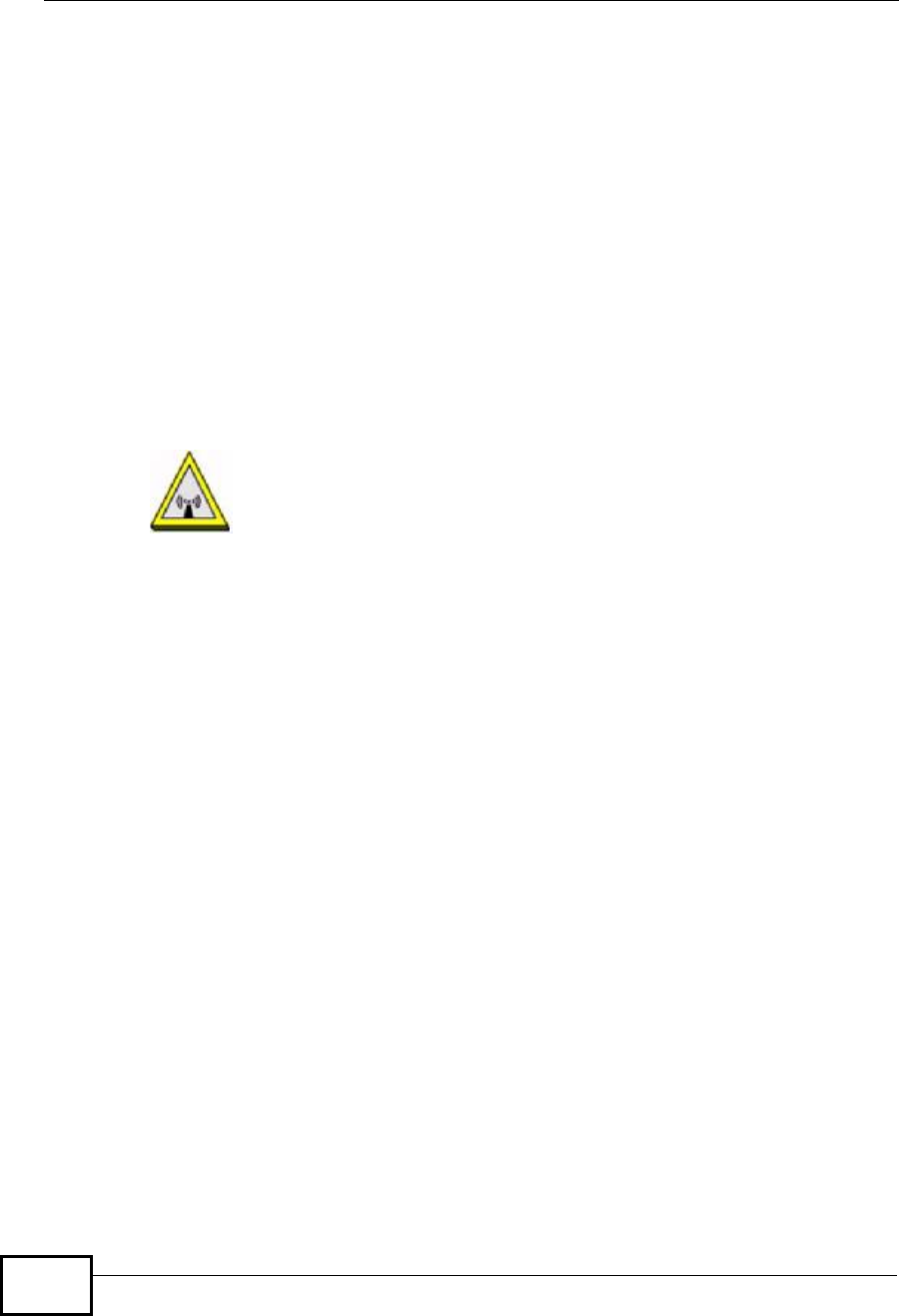
Appendix GLegal Information
NBG4604 User’s Guide
282
harmful interference to radio communications. However, there is no guarantee
that interference will not occur in a particular installation.
If this device does cause harmful interference to radio/television reception, which
can be determined by turning the device off and on, the user is encouraged to try
to correct the interference by one or more of the following measures:
1Reorient or relocate the receiving antenna.
2Increase the separation between the equipment and the receiver.
3Connect the equipment into an outlet on a circuit different from that to which the
receiver is connected.
4Consult the dealer or an experienced radio/TV technician for help.
FCC Radiation Exposure Statement
•This transmitter must not be co-located or operating in conjunction with any
other antenna or transmitter.
•IEEE 802.11b or 802.11g operation of this product in the U.S.A. is firmware-
limited to channels 1 through 11.
•To comply with FCC RF exposure compliance requirements, a separation
distance of at least 20 cm must be maintained between the antenna of this
device and all persons.
Industry Canada Statement
This device complies with RSS-210 of the Industry Canada Rules. Operation is
subject to the following two conditions:
1this device may not cause interference and
2this device must accept any interference, including interference that may cause
undesired operation of the device
This device has been designed to operate with an antenna having a maximum
gain of 2dBi.
Antenna having a higher gain is strictly prohibited per regulations of Industry
Canada. The required antenna impedance is 50 ohms.
Company Confidential
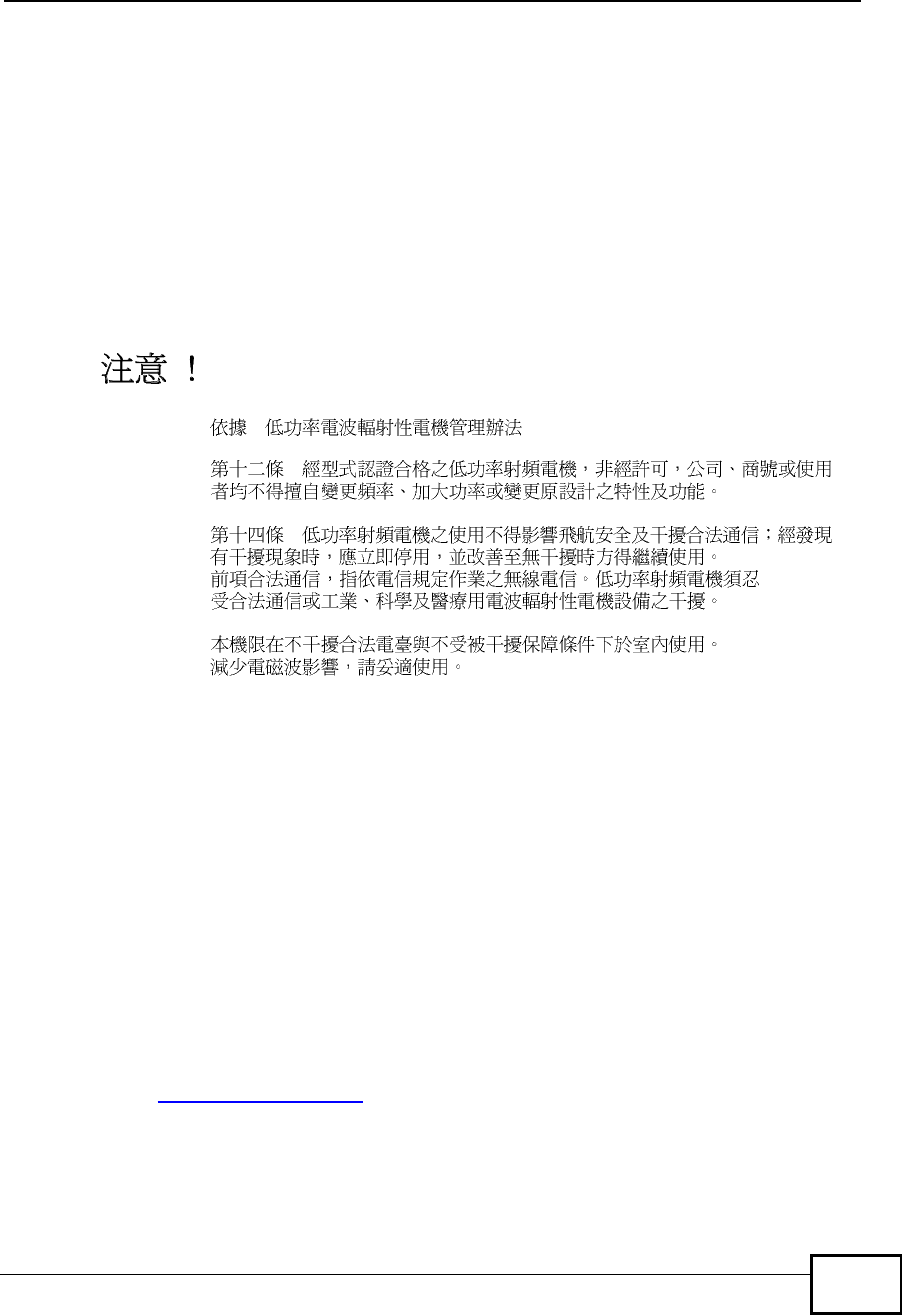
Appendix GLegal Information
NBG4604 User’s Guide 283
To reduce potential radio interference to other users, the antenna type and its gain
should be so chosen that the EIRP is not more than required for successful
communication.
IMPORTANT NOTE:
IC Radiation Exposure Statement:
This equipment complies with IC radiation exposure limits set forth for an
uncontrolled environment. This equipment should be installed and operated with
minimum distance 20cm between the radiator & your body.
Notices
Changes or modifications not expressly approved by the party responsible for
compliance could void the user's authority to operate the equipment.
This device has been designed for the WLAN 2.4 GHz network throughout the EC
region and Switzerland, with restrictions in France.
This Class B digital apparatus complies with Canadian ICES-003.
Cet appareil numérique de la classe B est conforme à la norme NMB-003 du
Canada.
Viewing Certifications
1Go to http://www.zyxel.com.
2Select your product on the ZyXEL home page to go to that product's page.
3Select the certification you wish to view from this page.
Company Confidential

Appendix GLegal Information
NBG4604 User’s Guide
284
ZyXEL Limited Warranty
ZyXEL warrants to the original end user (purchaser) that this product is free from
any defects in materials or workmanship for a period of up to two years from the
date of purchase. During the warranty period, and upon proof of purchase, should
the product have indications of failure due to faulty workmanship and/or
materials, ZyXEL will, at its discretion, repair or replace the defective products or
components without charge for either parts or labor, and to whatever extent it
shall deem necessary to restore the product or components to proper operating
condition. Any replacement will consist of a new or re-manufactured functionally
equivalent product of equal or higher value, and will be solely at the discretion of
ZyXEL. This warranty shall not apply if the product has been modified, misused,
tampered with, damaged by an act of God, or subjected to abnormal working
conditions.
Note
Repair or replacement, as provided under this warranty, is the exclusive remedy of
the purchaser. This warranty is in lieu of all other warranties, express or implied,
including any implied warranty of merchantability or fitness for a particular use or
purpose. ZyXEL shall in no event be held liable for indirect or consequential
damages of any kind to the purchaser.
To obtain the services of this warranty, contact your vendor. You may also refer to
the warranty policy for the region in which you bought the device at http://
www.zyxel.com/web/support_warranty_info.php.
Registration
Register your product online to receive e-mail notices of firmware upgrades and
information at www.zyxel.com for global products, or at www.us.zyxel.com for
North American products.
End-User License Agreement for "NBG-417N"
WARNING: ZyXEL Communications Corp. IS WILLING TO LICENSE THE
ENCLOSED SOFTWARE TO YOU ONLY UPON THE CONDITION THAT YOU ACCEPT
ALL OF THE TERMS CONTAINED IN THIS LICENSE AGREEMENT. PLEASE READ
THE TERMS CAREFULLY BEFORE COMPLETING THE INSTALLATION PROCESS AS
INSTALLING THE SOFTWARE WILL INDICATE YOUR ASSENT TO THEM. IF YOU DO
NOT AGREE TO THESE TERMS, THEN ZyXEL, INC. IS UNWILLING TO LICENSE THE
SOFTWARE TO YOU, IN WHICH EVENT YOU SHOULD RETURN THE UNINSTALLED
SOFTWARE AND PACKAGING TO THE PLACE FROM WHICH IT WAS ACQUIRED,
AND YOUR MONEY WILL BE REFUNDED.
Company Confidential

Appendix GLegal Information
NBG4604 User’s Guide 285
1Grant of License for Personal Use
ZyXEL Communications Corp. ("ZyXEL") grants you a non-exclusive, non-
sublicense, non-transferable license to use the program with which this license is
distributed (the "Software"), including any documentation files accompanying the
Software ("Documentation"), for internal business use only, for up to the number
of users specified in sales order and invoice. You have the right to make one
backup copy of the Software and Documentation solely for archival, back-up or
disaster recovery purposes. You shall not exceed the scope of the license granted
hereunder. Any rights not expressly granted by ZyXEL to you are reserved by
ZyXEL, and all implied licenses are disclaimed.
2Ownership
You have no ownership rights in the Software. Rather, you have a license to use
the Software as long as this License Agreement remains in full force and effect.
Ownership of the Software, Documentation and all intellectual property rights
therein shall remain at all times with ZyXEL. Any other use of the Software by any
other entity is strictly forbidden and is a violation of this License Agreement.
3Copyright
The Software and Documentation contain material that is protected by United
States Copyright Law and trade secret law, and by international treaty provisions.
All rights not granted to you herein are expressly reserved by ZyXEL. You may not
remove any proprietary notice of ZyXEL or any of its licensors from any copy of
the Software or Documentation.
4Restrictions
You may not publish, display, disclose, sell, rent, lease, modify, store, loan,
distribute, or create derivative works of the Software, or any part thereof. You
may not assign, sublicense, convey or otherwise transfer, pledge as security or
otherwise encumber the rights and licenses granted hereunder with respect to the
Software. Certain components of the Software, and third party open source
programs included with the Software, have been or may be made available by
ZyXEL on its Open Source web site (ftp://opensource.zyxel.com) (collectively the
"Open-Sourced Components") You may modify or replace only these Open-
Sourced Components; provided that you comply with the terms of this License and
any applicable licensing terms governing use of the Open-Sourced Components.
ZyXEL is not obligated to provide any maintenance, technical or other support for
the resultant modified Software. You may not copy, reverse engineer, decompile,
reverse compile, translate, adapt, or disassemble the Software, or any part
thereof, nor shall you attempt to create the source code from the object code for
the Software. Except as and only to the extent expressly permitted in this License,
by applicable licensing terms governing use of the Open-Sourced Components, or
by applicable law, you may not market, co-brand, private label or otherwise
Company Confidential

Appendix GLegal Information
NBG4604 User’s Guide
286
permit third parties to link to the Software, or any part thereof. You may not use
the Software, or any part thereof, in the operation of a service bureau or for the
benefit of any other person or entity. You may not cause, assist or permit any
third party to do any of the foregoing. Portions of the Software utilize or include
third party software and other copyright material. Acknowledgements, licensing
terms and disclaimers for such material are contained in the online electronic
documentation for the Software (ftp://opensource.zyxel.com), and your use of
such material is governed by their respective terms. ZyXEL has provided, as part
of the Software package, access to certain third party software as a convenience.
To the extent that the Software contains third party software, ZyXEL has no
express or implied obligation to provide any technical or other support for such
software. Please contact the appropriate software vendor or manufacturer directly
for technical support and customer service related to its software and products.
5Confidentiality
You acknowledge that the Software contains proprietary trade secrets of ZyXEL
and you hereby agree to maintain the confidentiality of the Software using at least
as great a degree of care as you use to maintain the confidentiality of your own
most confidential information. You agree to reasonably communicate the terms
and conditions of this License Agreement to those persons employed by you who
come into contact with the Software, and to use reasonable best efforts to ensure
their compliance with such terms and conditions, including, without limitation, not
knowingly permitting such persons to use any portion of the Software for the
purpose of deriving the source code of the Software.
6No Warranty
THE SOFTWARE IS PROVIDED "AS IS." TO THE MAXIMUM EXTENT PERMITTED BY
LAW, ZyXEL DISCLAIMS ALL WARRANTIES OF ANY KIND, EITHER EXPRESSED OR
IMPLIED, INCLUDING, WITHOUT LIMITATION, IMPLIED WARRANTIES OF
MERCHANTABILITY AND FITNESS FOR A PARTICULAR PURPOSE. ZyXEL DOES
NOT WARRANT THAT THE FUNCTIONS CONTAINED IN THE SOFTWARE WILL MEET
ANY REQUIREMENTS OR NEEDS YOU MAY HAVE, OR THAT THE SOFTWARE WILL
OPERATE ERROR FREE, OR IN AN UNINTERUPTED FASHION, OR THAT ANY
DEFECTS OR ERRORS IN THE SOFTWARE WILL BE CORRECTED, OR THAT THE
SOFTWARE IS COMPATIBLE WITH ANY PARTICULAR PLATFORM. SOME
JURISDICTIONS DO NOT ALLOW THE WAIVER OR EXCLUSION OF IMPLIED
WARRANTIES SO THEY MAY NOT APPLY TO YOU. IF THIS EXCLUSION IS HELD TO
BE UNENFORCEABLE BY A COURT OF COMPETENT JURISDICTION, THEN ALL
EXPRESS AND IMPLIED WARRANTIES SHALL BE LIMITED IN DURATION TO A
PERIOD OF THIRTY (30) DAYS FROM THE DATE OF PURCHASE OF THE SOFTWARE,
AND NO WARRANTIES SHALL APPLY AFTER THAT PERIOD.
7Limitation of Liability
Company Confidential

Appendix GLegal Information
NBG4604 User’s Guide 287
IN NO EVENT WILL ZyXEL BE LIABLE TO YOU OR ANY THIRD PARTY FOR ANY
INCIDENTAL OR CONSEQUENTIAL DAMAGES (INCLUDING, WITHOUT LIMITATION,
INDIRECT, SPECIAL, PUNITIVE, OR EXEMPLARY DAMAGES FOR LOSS OF
BUSINESS, LOSS OF PROFITS, BUSINESS INTERRUPTION, OR LOSS OF BUSINESS
INFORMATION) ARISING OUT OF THE USE OF OR INABILITY TO USE THE
PROGRAM, OR FOR ANY CLAIM BY ANY OTHER PARTY, EVEN IF ZyXEL HAS BEEN
ADVISED OF THE POSSIBILITY OF SUCH DAMAGES. ZyXEL's AGGREGATE
LIABILITY WITH RESPECT TO ITS OBLIGATIONS UNDER THIS AGREEMENT OR
OTHERWISE WITH RESPECT TO THE SOFTWARE AND DOCUMENTATION OR
OTHERWISE SHALL BE EQUAL TO THE PURCHASE PRICE, BUT SHALL IN NO
EVENT EXCEED THE PRODUCT°ØS PRICE. BECAUSE SOME STATES/COUNTRIES
DO NOT ALLOW THE EXCLUSION OR LIMITATION OF LIABILITY FOR
CONSEQUENTIAL OR INCIDENTAL DAMAGES, THE ABOVE LIMITATION MAY NOT
APPLY TO YOU.
8Export Restrictions
THIS LICENSE AGREEMENT IS EXPRESSLY MADE SUBJECT TO ANY APPLICABLE
LAWS, REGULATIONS, ORDERS, OR OTHER RESTRICTIONS ON THE EXPORT OF
THE SOFTWARE OR INFORMATION ABOUT SUCH SOFTWARE WHICH MAY BE
IMPOSED FROM TIME TO TIME. YOU SHALL NOT EXPORT THE SOFTWARE,
DOCUMENTATION OR INFORMATION ABOUT THE SOFTWARE AND
DOCUMENTATION WITHOUT COMPLYING WITH SUCH LAWS, REGULATIONS,
ORDERS, OR OTHER RESTRICTIONS. YOU AGREE TO INDEMNIFY ZyXEL AGAINST
ALL CLAIMS, LOSSES, DAMAGES, LIABILITIES, COSTS AND EXPENSES,
INCLUDING REASONABLE ATTORNEYS' FEES, TO THE EXTENT SUCH CLAIMS
ARISE OUT OF ANY BREACH OF THIS SECTION 8.
9Audit Rights
ZyXEL SHALL HAVE THE RIGHT, AT ITS OWN EXPENSE, UPON REASONABLE PRIOR
NOTICE, TO PERIODICALLY INSPECT AND AUDIT YOUR RECORDS TO ENSURE
YOUR COMPLIANCE WITH THE TERMS AND CONDITIONS OF THIS LICENSE
AGREEMENT.
10 Termination
This License Agreement is effective until it is terminated. You may terminate this
License Agreement at any time by destroying or returning to ZyXEL all copies of
the Software and Documentation in your possession or under your control. ZyXEL
may terminate this License Agreement for any reason, including, but not limited
to, if ZyXEL finds that you have violated any of the terms of this License
Agreement. Upon notification of termination, you agree to destroy or return to
ZyXEL all copies of the Software and Documentation and to certify in writing that
all known copies, including backup copies, have been destroyed. All provisions
relating to confidentiality, proprietary rights, and non-disclosure shall survive the
termination of this Software License Agreement.
Company Confidential

Appendix GLegal Information
NBG4604 User’s Guide
288
11 General
This License Agreement shall be construed, interpreted and governed by the laws
of Republic of China without regard to conflicts of laws provisions thereof. The
exclusive forum for any disputes arising out of or relating to this License
Agreement shall be an appropriate court or Commercial Arbitration Association
sitting in ROC, Taiwan. This License Agreement shall constitute the entire
Agreement between the parties hereto. This License Agreement, the rights
granted hereunder, the Software and Documentation shall not be assigned by you
without the prior written consent of ZyXEL. Any waiver or modification of this
License Agreement shall only be effective if it is in writing and signed by both
parties hereto. If any part of this License Agreement is found invalid or
unenforceable by a court of competent jurisdiction, the remainder of this License
Agreement shall be interpreted so as to reasonably effect the intention of the
parties.
Note: NOTE: Some components of the Vantage CNM 2.3 incorporate source code
covered under the Apache License, GPL License, LGPL License, Sun License,
and Castor License. To obtain the source code covered under those Licenses,
please check ftp://opensource.zyxel.com to get it.
Company Confidential

Index
NBG4604 User’s Guide 289
Index
A
Address Assignment 102
Alert 183
alternative subnet mask notation 214
AP 21
AP (Access Point) 249
AP Mode
menu 58
overview 55
status screen 56
AP+Bridge 21
Auto-bridge 112
B
Backup configuration 190
Bandwidth management
overview 147
priority 152
services 153
BitTorrent 154
Bridge/Repeater 21
BSS 247
C
CA 254
Certificate Authority 254
certifications 281
notices 283
viewing 283
Channel 31,57,249
Interference 249
channel 78
Configuration
backup 190
reset the factory defaults 192
restore 191
content filtering 139
by keyword (in URL) 140
by web feature 139
copyright 281
CPU usage 31,57
CTS (Clear to Send) 250
D
Daylight saving 180
DDNS 131
see also Dynamic DNS
service providers 132
DHCP 34,117
DHCP server
see also Dynamic Host Configuration Protocol
DHCP client information 120
DHCP client list 120
DHCP server 114,117
DHCP table 34,120
DHCP client information
DHCP status
Dimensions 207
disclaimer 281
DNS 50,119
DNS server
see also Domain name system
DNS Server 102
DNS server 119
Domain name 41
vs host name. see also system name
Domain Name System 119
Domain Name System. See DNS.
duplex setting 32,58
Dynamic DNS 131
Dynamic Host Configuration Protocol 117
Dynamic WEP Key Exchange 254
DynDNS 132
Company Confidential

Index
NBG4604 User’s Guide
290
DynDNS see also DDNS 132
DynDNS Wildcard 131
E
EAP Authentication 253
e-mail 92
Encryption 255
encryption 80
and local (user) database 80
key 81
WPA compatible 80
ESS 248
ESSID 204
Extended Service Set 248
Extended wireless security 44
F
Factory LAN defaults 114,117
FCC interference statement 281
File Transfer Program 153
Firewall
ICMP packets 137
ZyXEL device firewall 136
firewall
stateful inspection 135
Firmware upload 187
file extension
using HTTP
firmware version 31,57
Fragmentation Threshold 251
FTP. see also File Transfer Program 153
G
gateway 144
General wireless LAN screen 81
H
Hidden Node 249
HTTP 153
Hyper Text Transfer Protocol 153
I
IANA 220
IBSS 247
IEEE 802.11g 251
IGMP 103
see also Internet Group Multicast Protocol
version
IGMP version 103
Independent Basic Service Set 247
Internet Assigned Numbers Authority
See IANA
Internet connection
Ethernet
PPPoE. see also PPP over Ethernet
PPTP
WAN connection
Internet connection wizard 44
Internet Group Multicast Protocol 103
IP Address 115,125
IP address 50
dynamic
IP Pool 118
L
LAN 113
IP pool setup 114
LAN overview 113
LAN setup 113
LAN TCP/IP 114
Language 197
Link type 32,57
local (user) database 79
and encryption 80
Local Area Network 113
Company Confidential

Index
NBG4604 User’s Guide 291
Log 184
M
MAC 87
MAC address 79,103
cloning 52,103
MAC address filter 79
MAC address filtering 87
MAC filter 87
Management Information Base (MIB) 168
managing the device
good habits 22
using the Web Configurator. See Web
Configurator.
using the WPS. See WPS.
MBSSID 21
Media access control 87
Memory usage 31,57
Metric 145
mode 21
Multicast 103
IGMP 103
N
NAT 123,124,172,219
how it works 123
overview 123
routers 172
see also Network Address Translation
NAT traversal 159
Navigation Panel 32,58
navigation panel 32,58
NetBIOS 104
see also Network Basic Input/Output System
104
Network Address Translation 123,124
O
Operating Channel 31,57
operating mode 21
P
P2P 154
peer-to-peer 154
Point-to-Point Protocol over Ethernet 46,106
Point-to-Point Tunneling Protocol 47,108
Pool Size 118
Port forwarding 125
default server 125
local server 125
port speed 32,58
Power Specification 207
PPPoE 46,106
benefits 46
dial-up connection
see also Point-to-Point Protocol over Ethernet
46
PPTP 47,108
see also Point-to-Point Tunneling Protocol 47
Preamble Mode 251
product registration 284
Q
Quality of Service (QoS) 90
R
RADIUS 252
Shared Secret Key 253
RADIUS Message Types 253
RADIUS Messages 253
RADIUS server 79
registration
product 284
related documentation 3
Remote management 155
and NAT 156
and the firewall 155
limitations 156
Company Confidential

Index
NBG4604 User’s Guide
292
remote management session 155
system timeout 156
Reset button 29,192
Reset the device 29
Restore configuration 191
RF (Radio Frequency) 208
RFC 3489 172
Roaming 89
RTS (Request To Send) 250
RTS Threshold 249,250
RTS/CTS Threshold 78,89
S
safety warnings 8
Scheduling 95
Security Parameters 258
Service and port numbers 154
Service Set 82
Service Set IDentification 82
Service Set IDentity. See SSID.
services
and port numbers 259
and protocols 259
Session Initiated Protocol 153
Simple Network Management Protocol, see
SNMP
SIP 153
SNMP 167,168
agents 168
Get 168
GetNext 168
Manager 168
managers 168
MIB 168
network components 167
Set 168
Trap 168
versions 167
SSID 31,78,82
stateful inspection firewall 135
Static DHCP 118
Static Route 144
Status 30
subnet 211
Subnet Mask 115
subnet mask 50,212
subnetting 215
Summary
DHCP table 34
Packet statistics 35
Wireless station status 36
syntax conventions 6
Sys Op Mode 193
System General Setup 177
System Name 178
System name 40
vs computer name
System restart 192
T
TCP/IP configuration 117
Temperature 207
Time setting 179
trigger port 128
Trigger port forwarding 128
example 129
process 129
U
Universal Plug and Play 159
application 160
UPnP 159
security issues 160
URL Keyword Blocking 141
Use Authentication 256
user authentication 79
local (user) database 79
RADIUS server 79
User Name 133
Company Confidential

Index
NBG4604 User’s Guide 293
V
VoIP 153
VPN 108
W
WAN
IP address assignment 49
WAN (Wide Area Network) 101
WAN advanced 111
WAN IP address 49
WAN IP address assignment 51
WAN MAC address 103
warranty 284
note 284
Web Configurator 22
how to access 27
Overview 27
Web configurator
navigating 29
WEP Encryption 85
WEP encryption 84
WEP key 84
Wildcard 131
Wireless association list 36
wireless channel 204
wireless LAN 204
wireless LAN scheduling 95
Wireless LAN wizard 42
Wireless network
basic guidelines 78
channel 78
encryption 80
example 77
MAC address filter 79
overview 77
security 78
SSID 78
Wireless security 78
overview 78
type 78
wireless security 204
Wireless tutorial 55,63
WPS 63
Wizard setup 39
complete 53
Internet connection 44
system information 40
wireless LAN 42
WLAN
Interference 249
Security Parameters 258
World Wide Web 153
WPA compatible 80
WPA, WPA2 255
WPS 22
WWW 92,153
X
Xbox Live 154
Company Confidential

Index
NBG4604 User’s Guide
294
Company Confidential